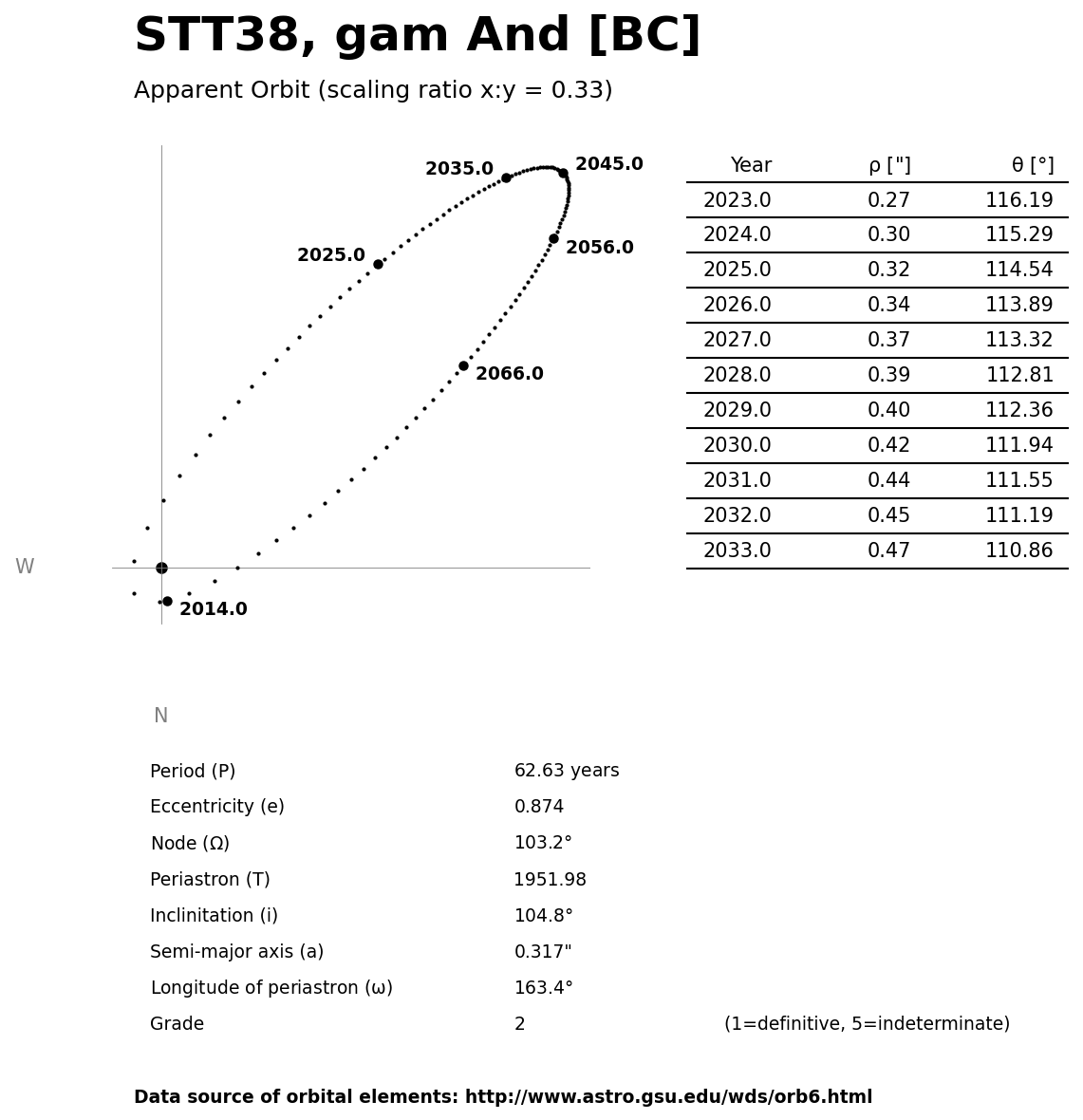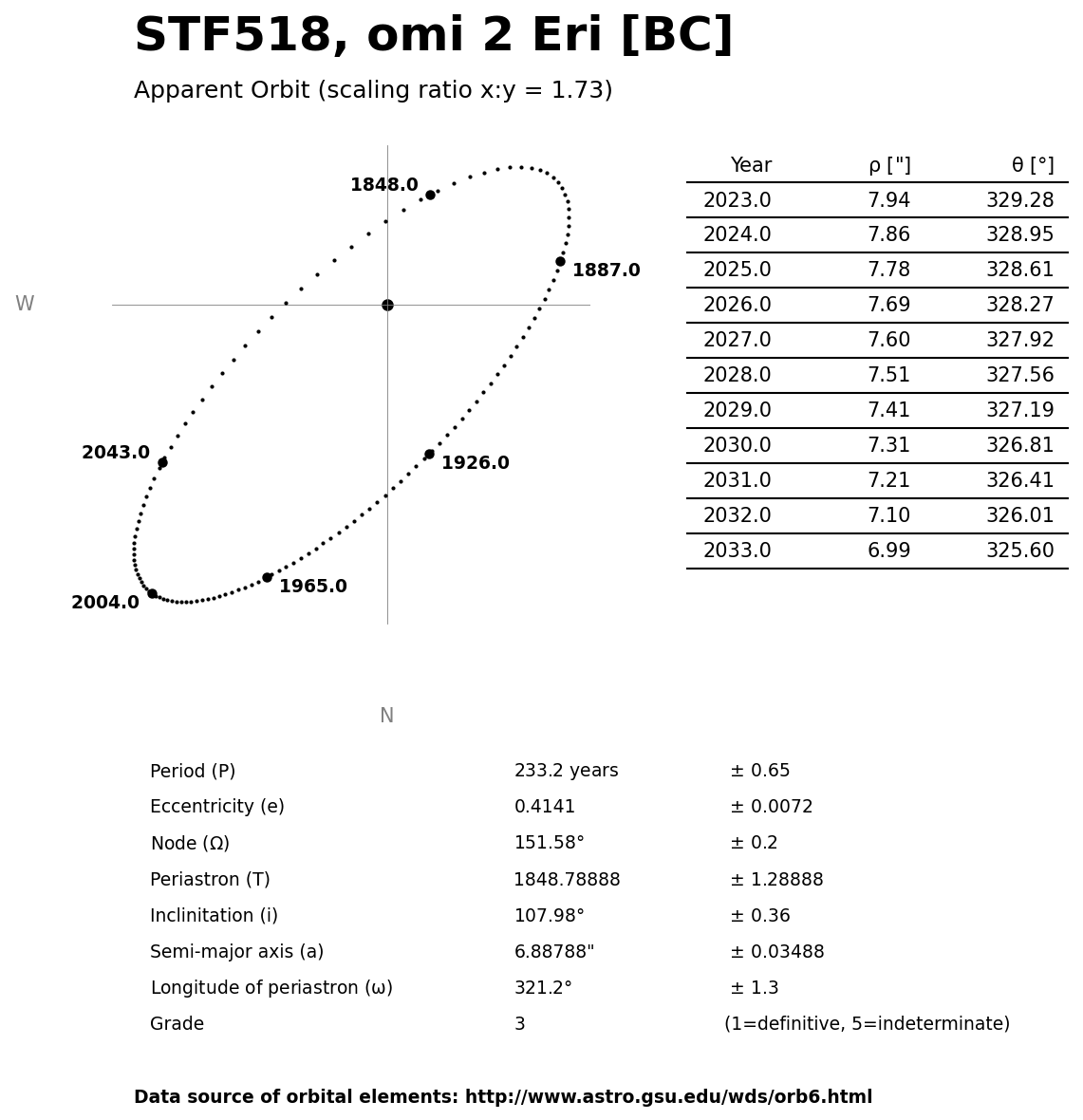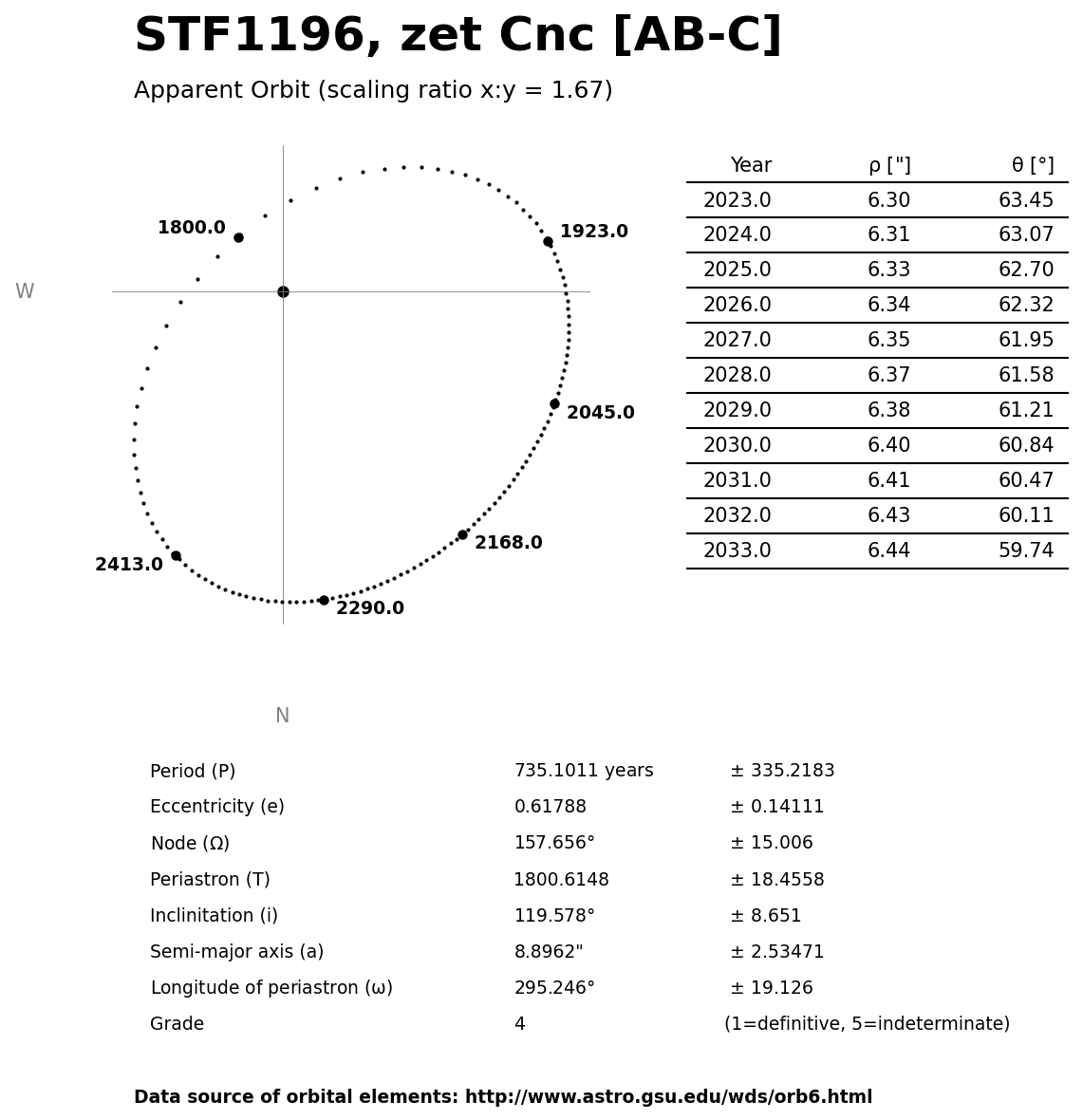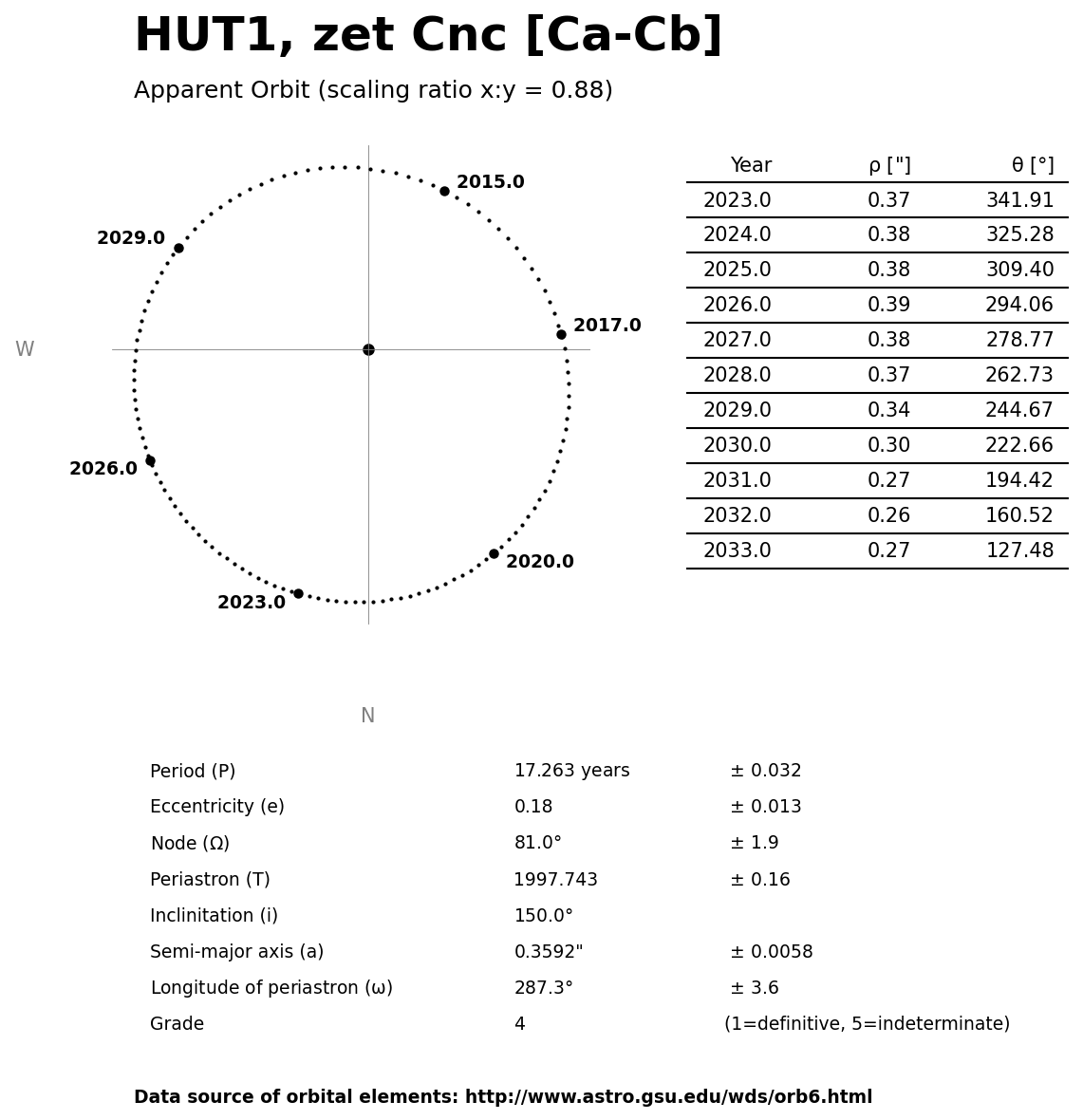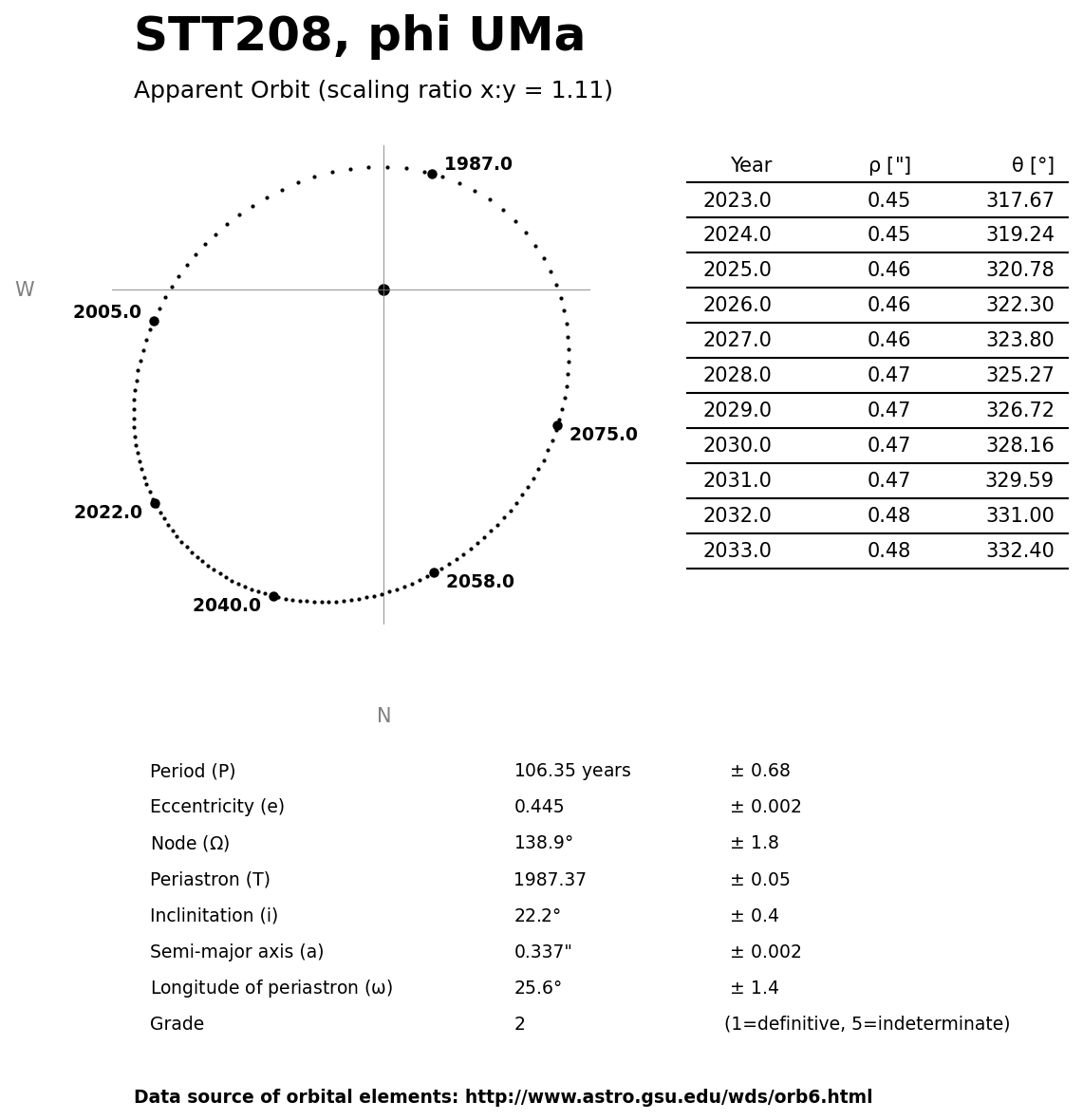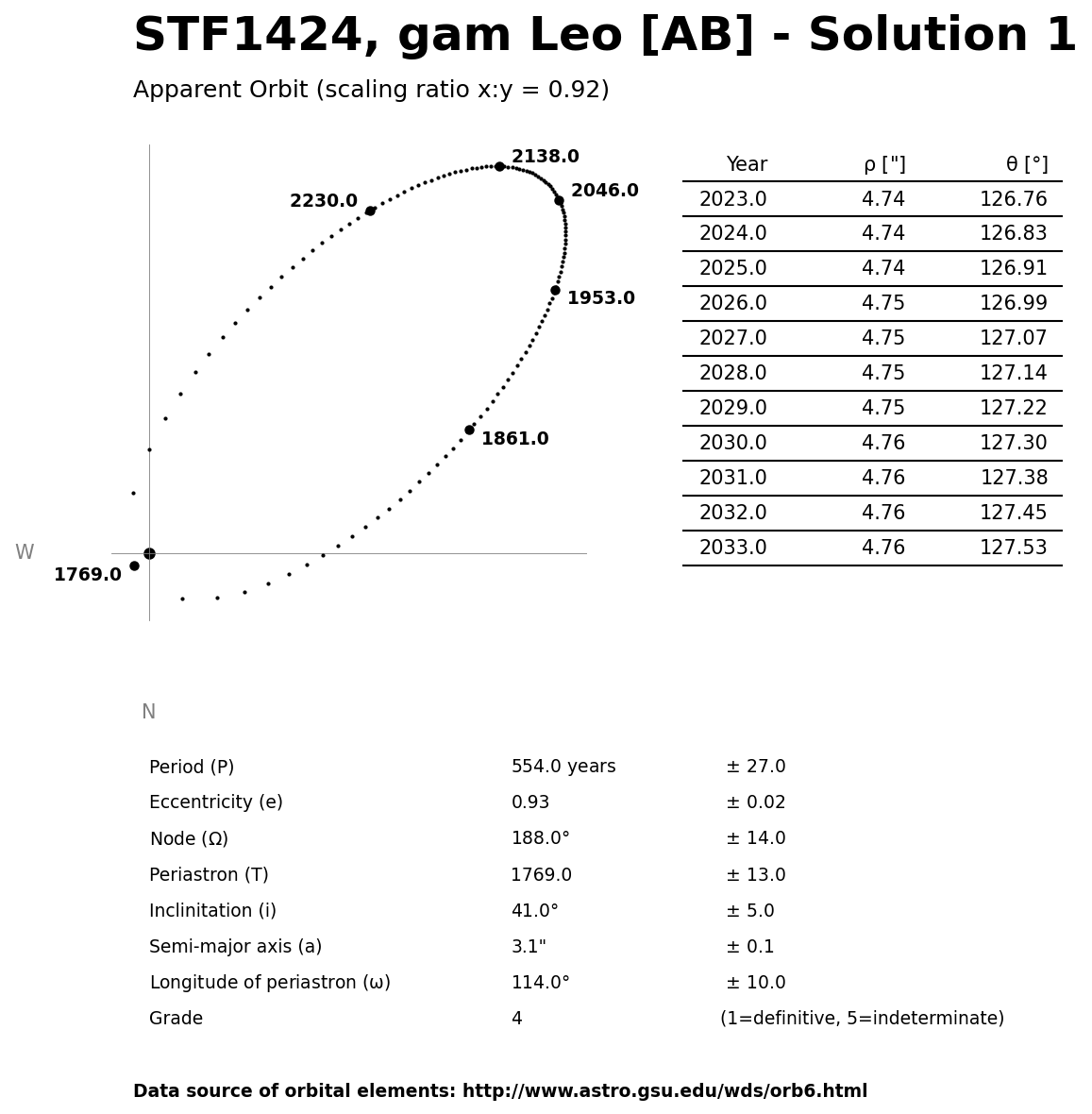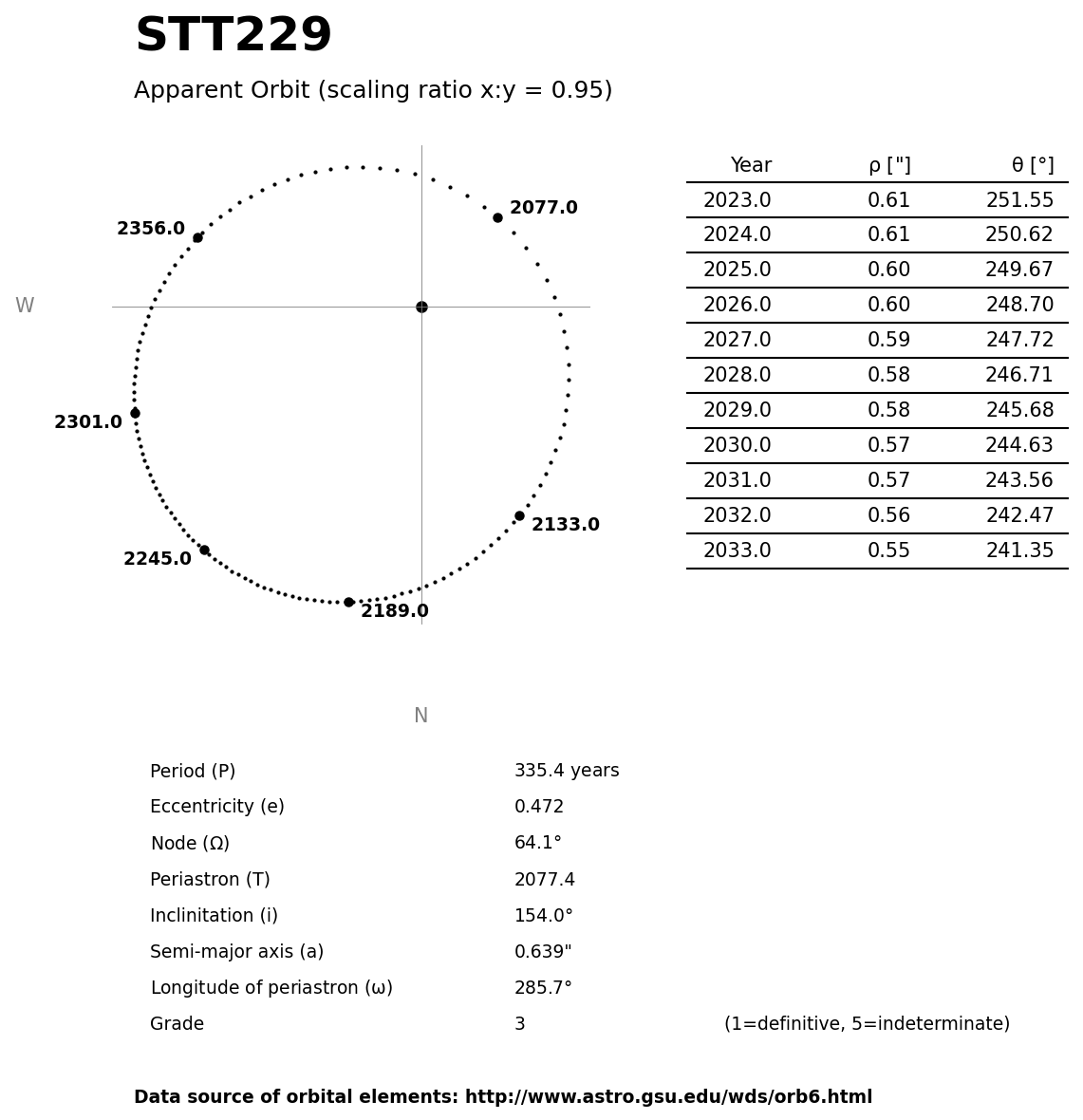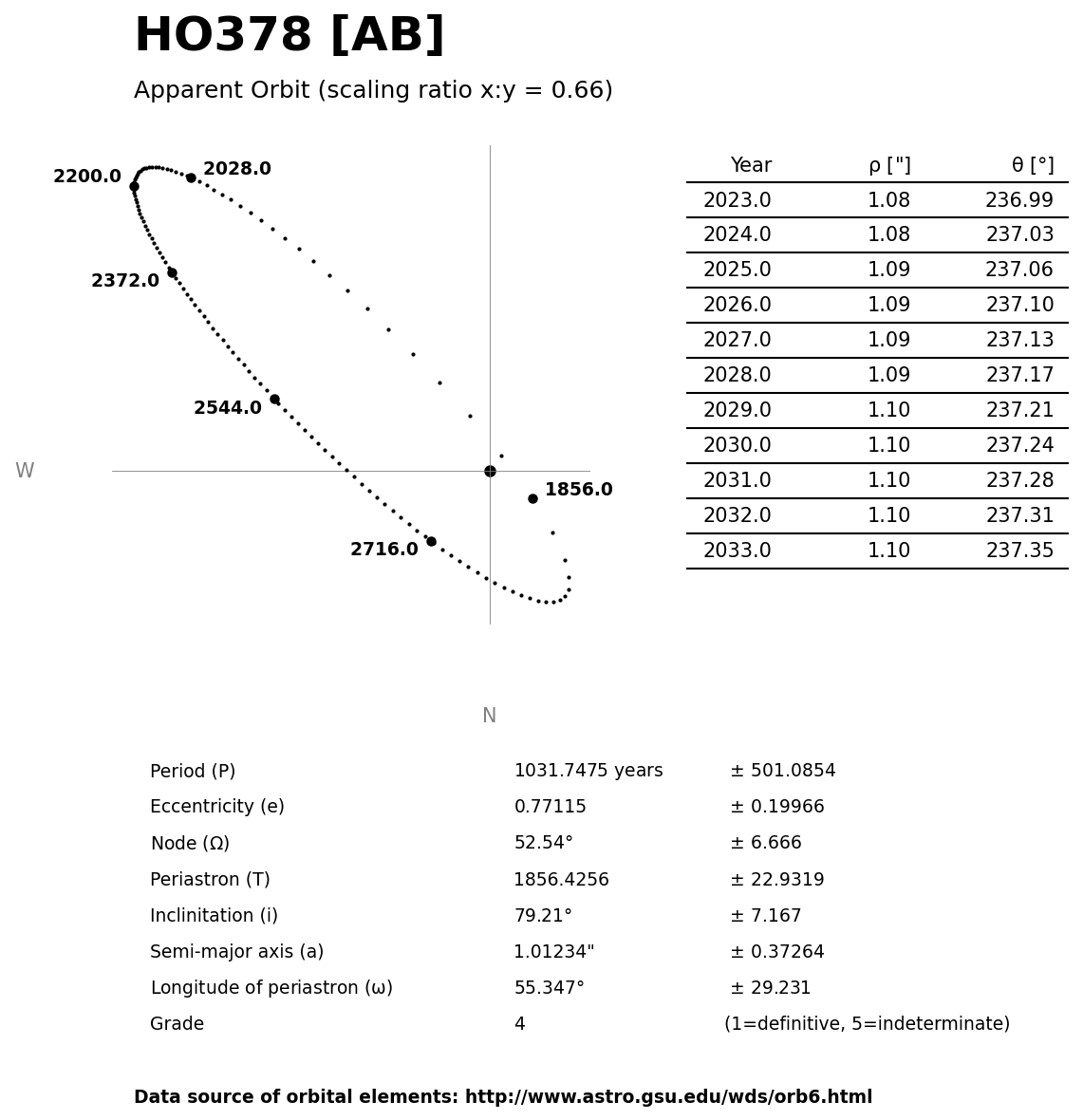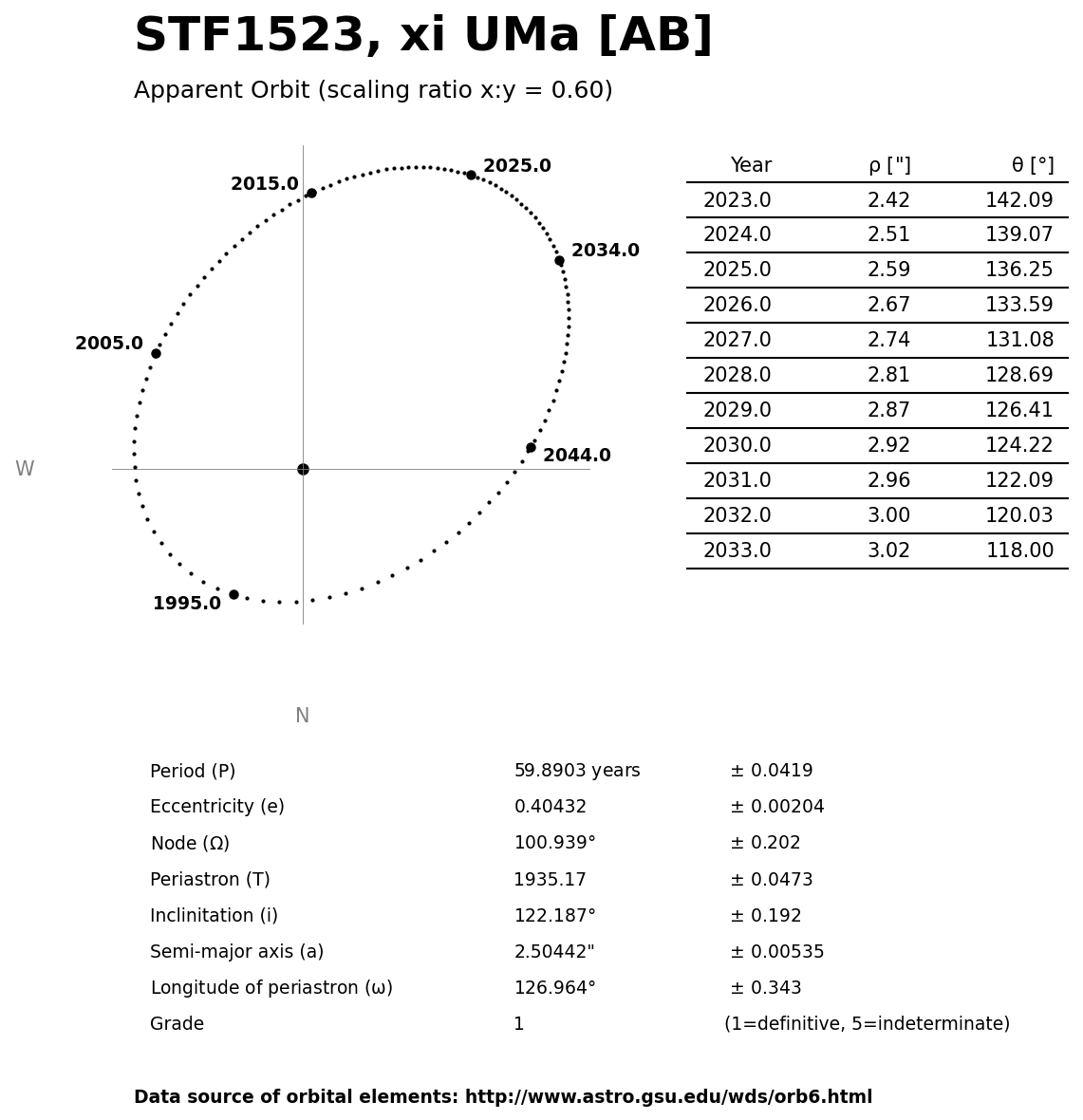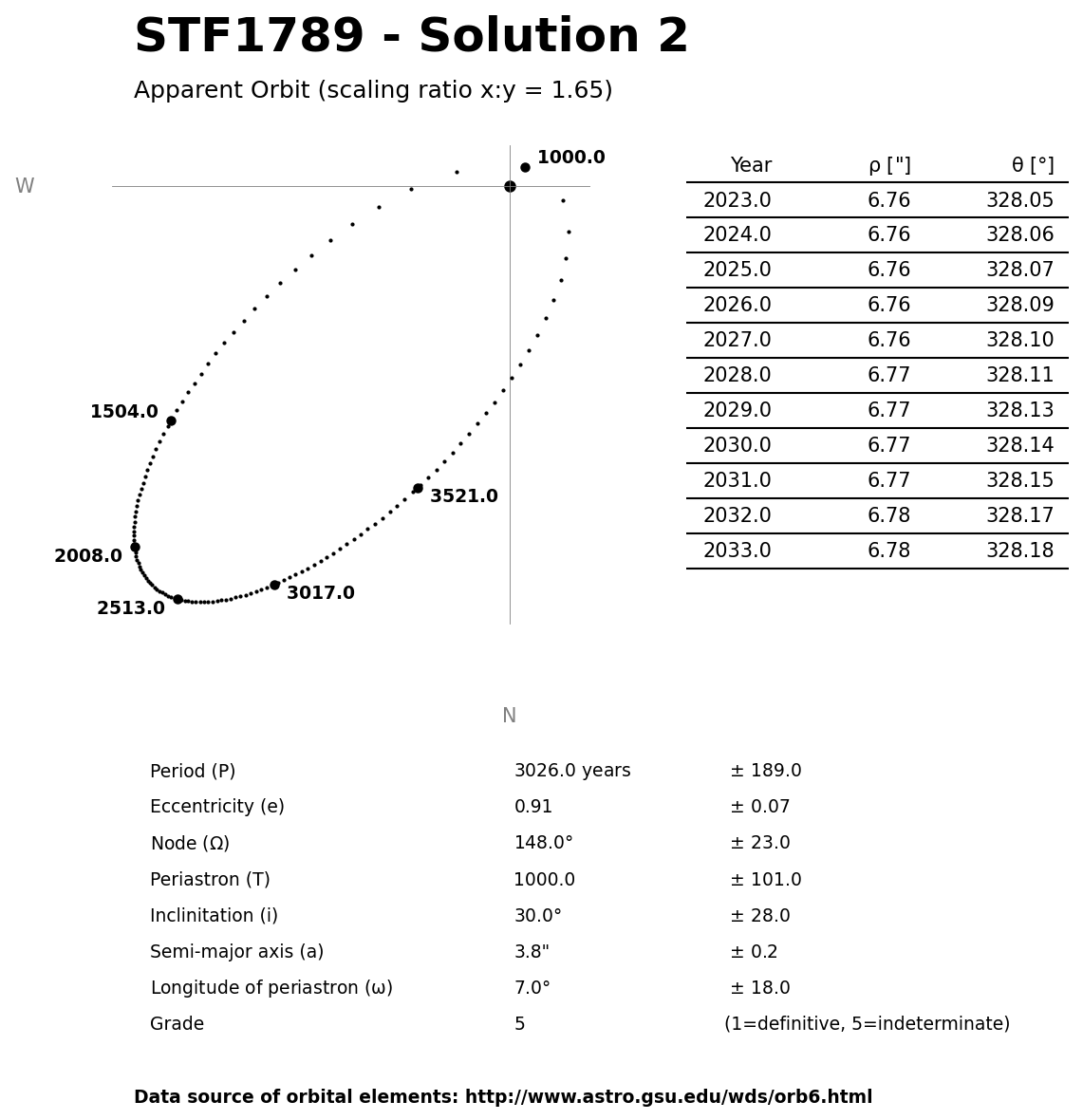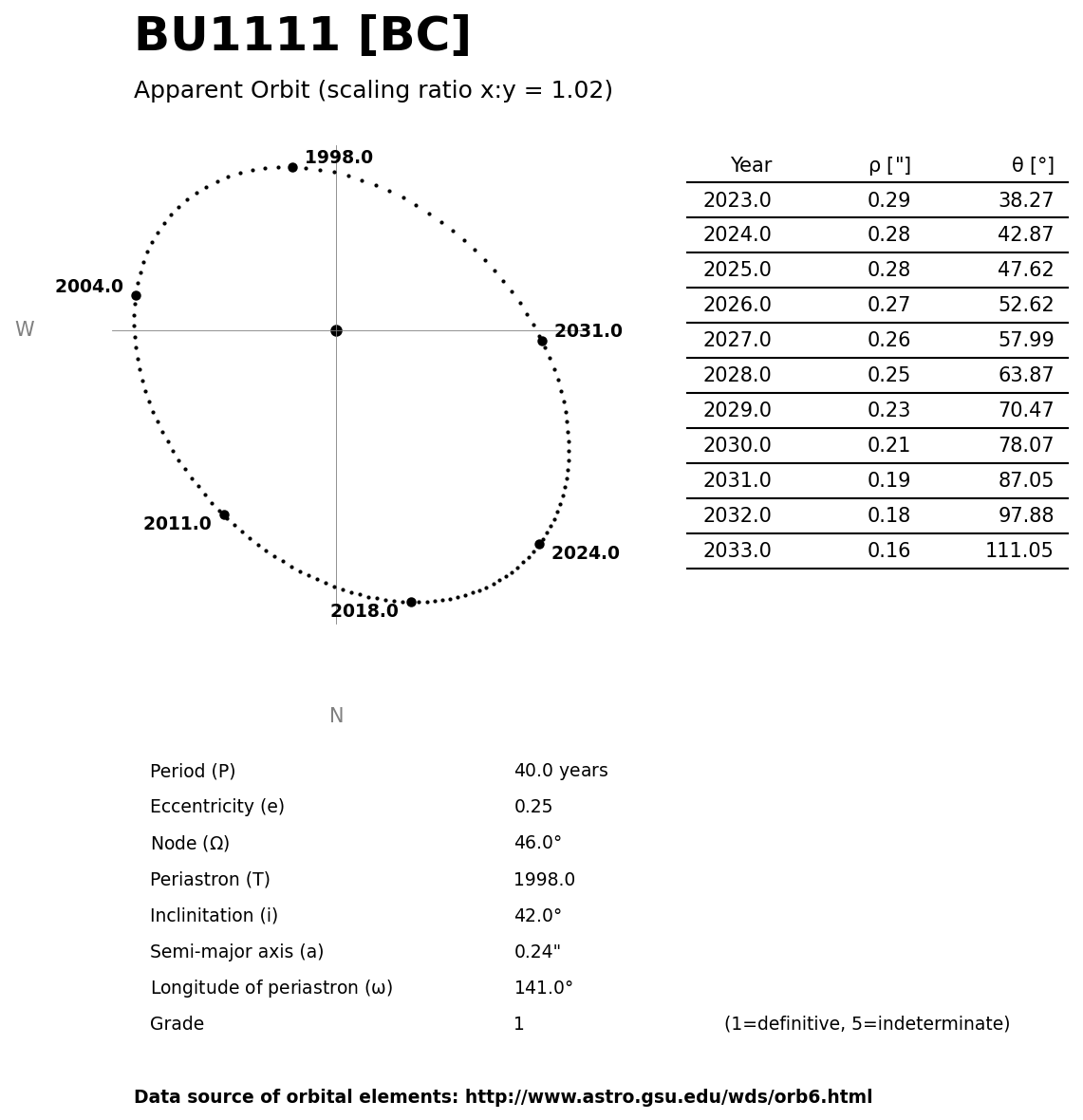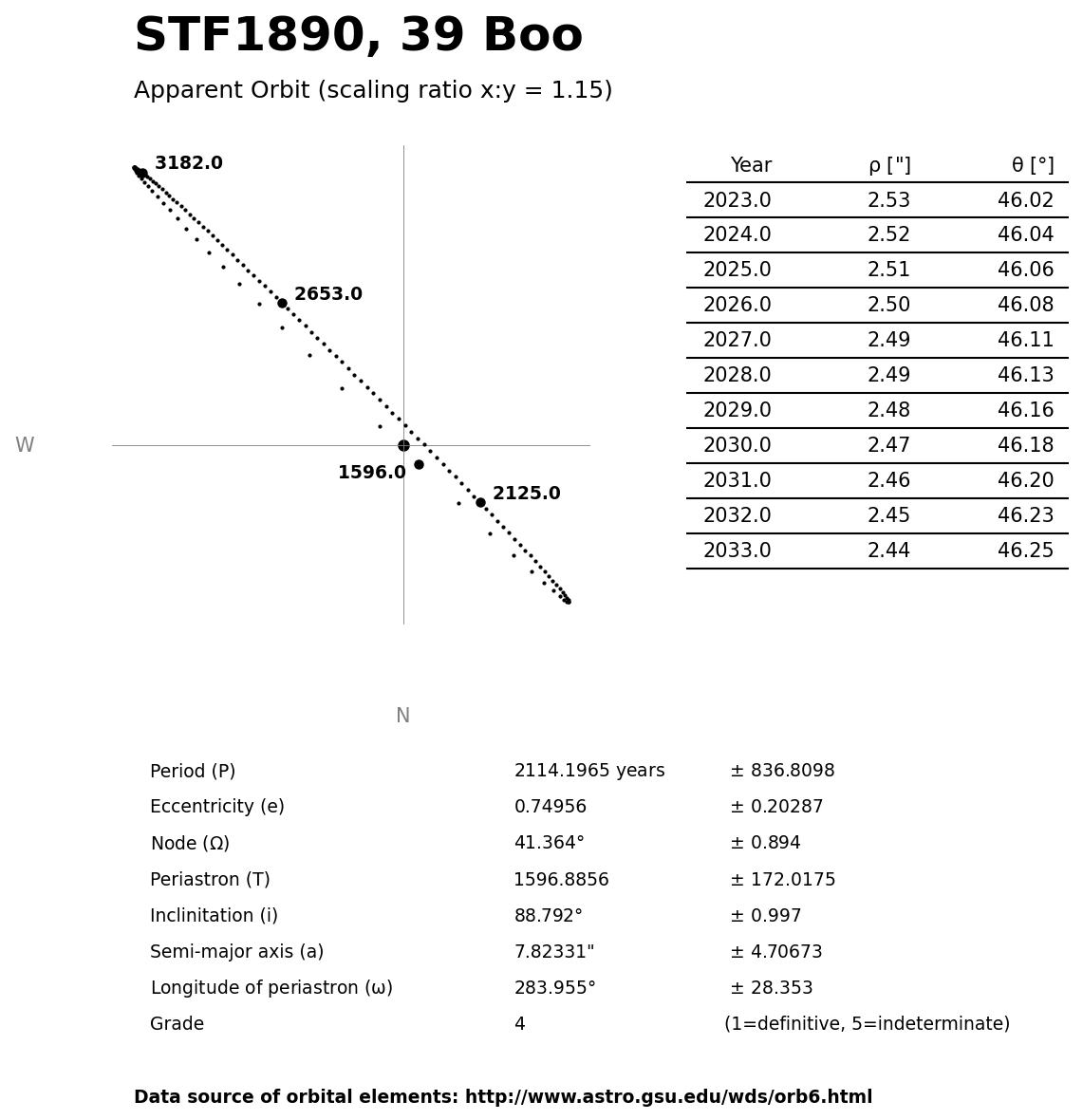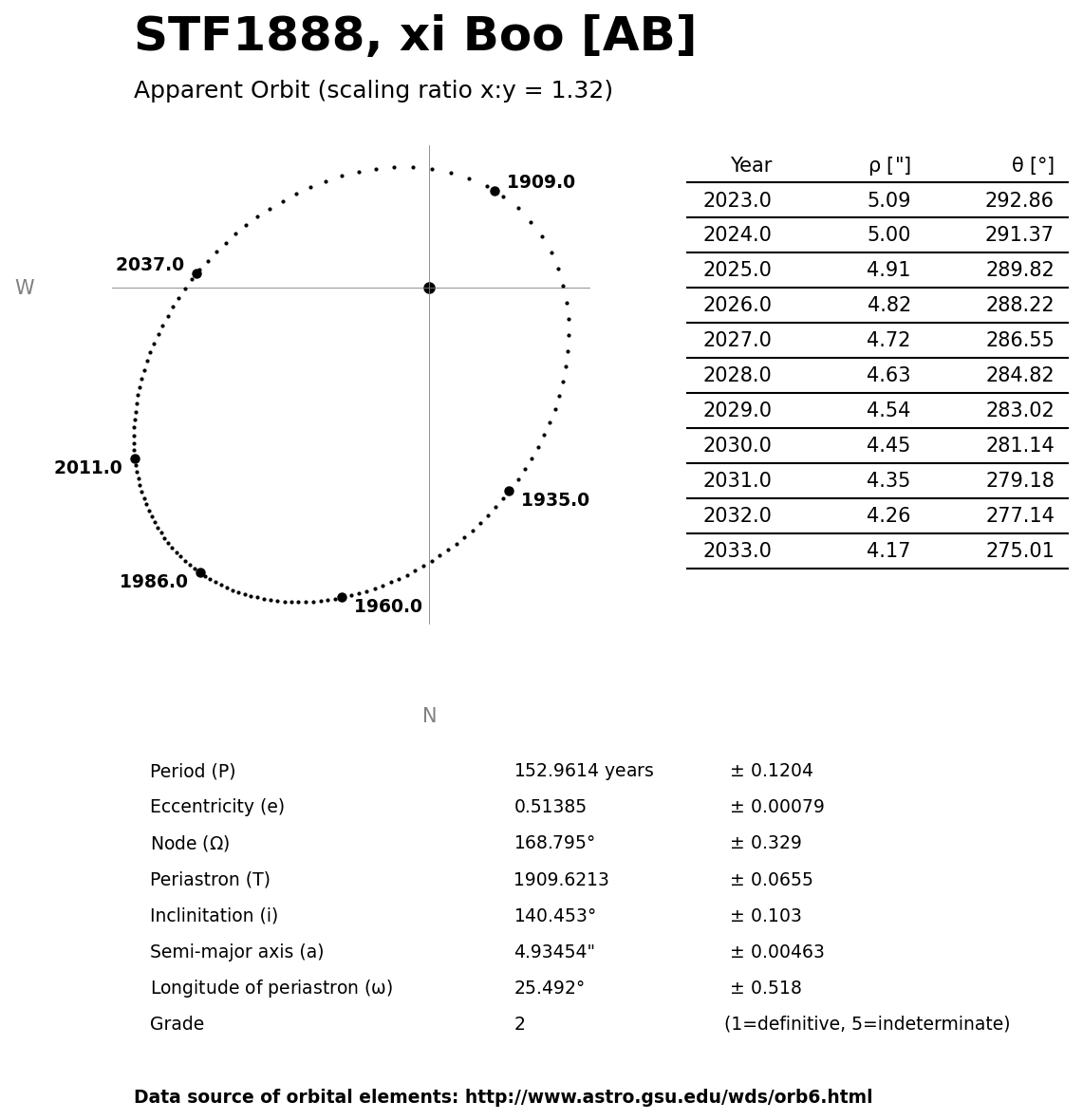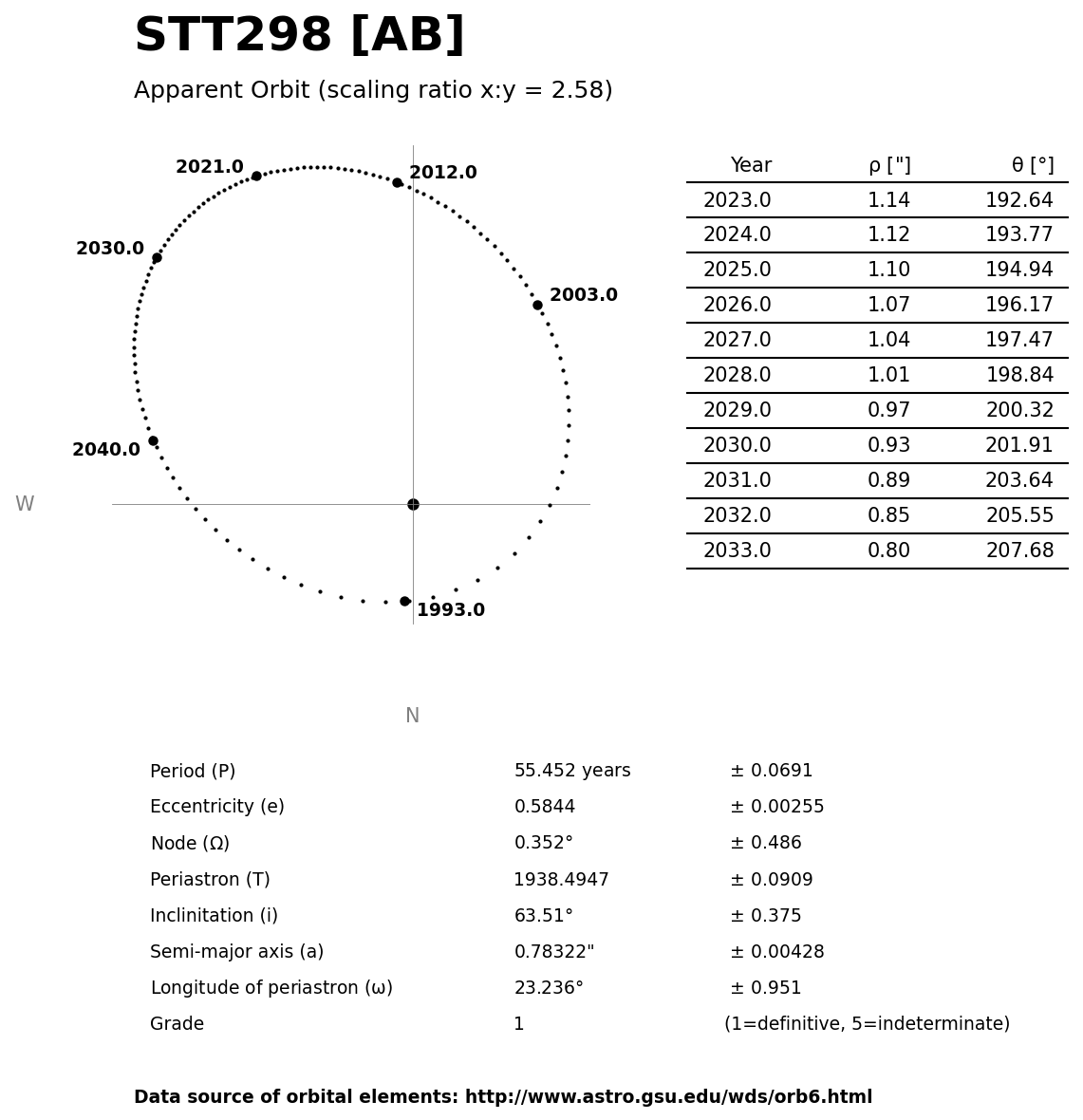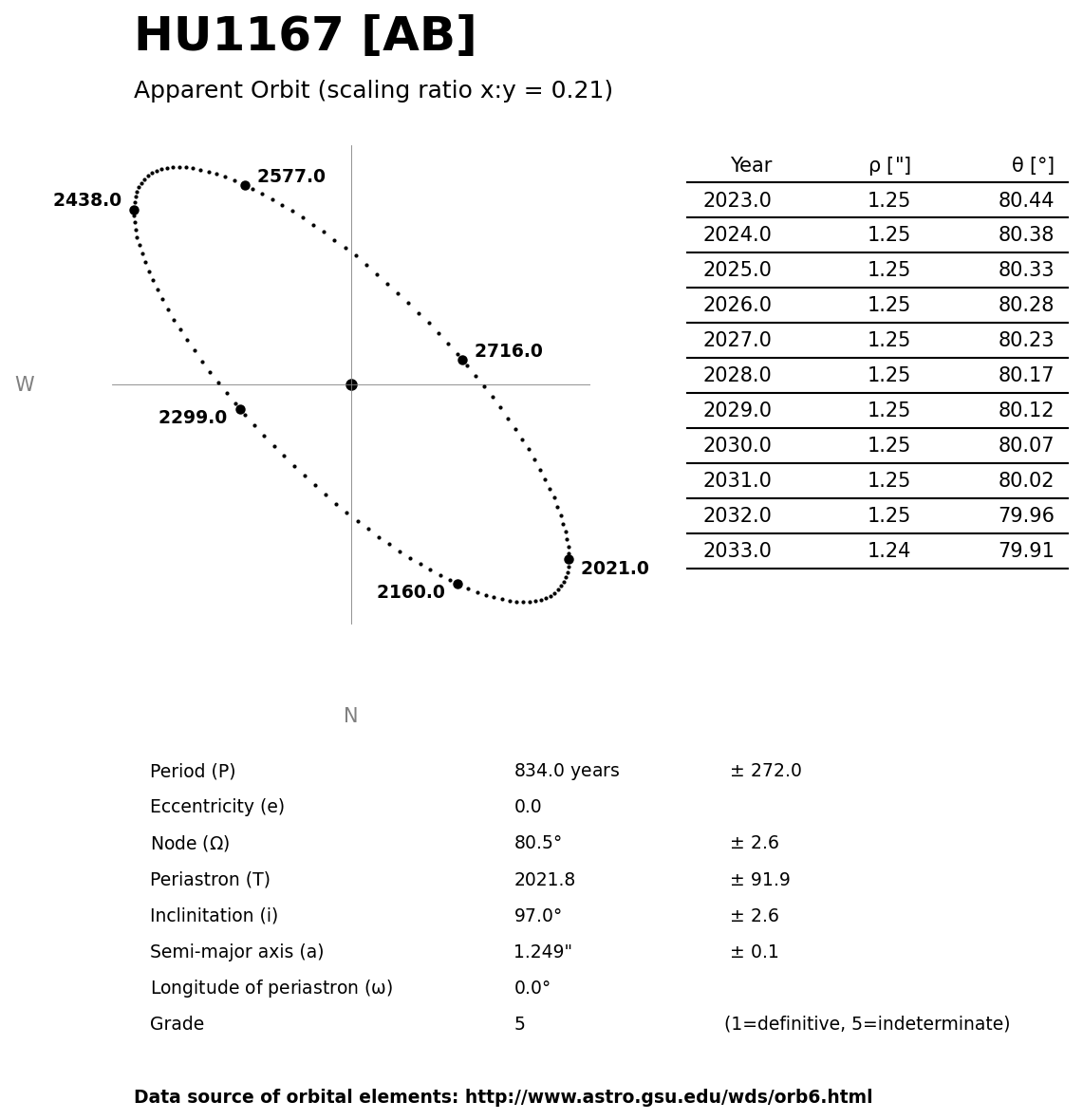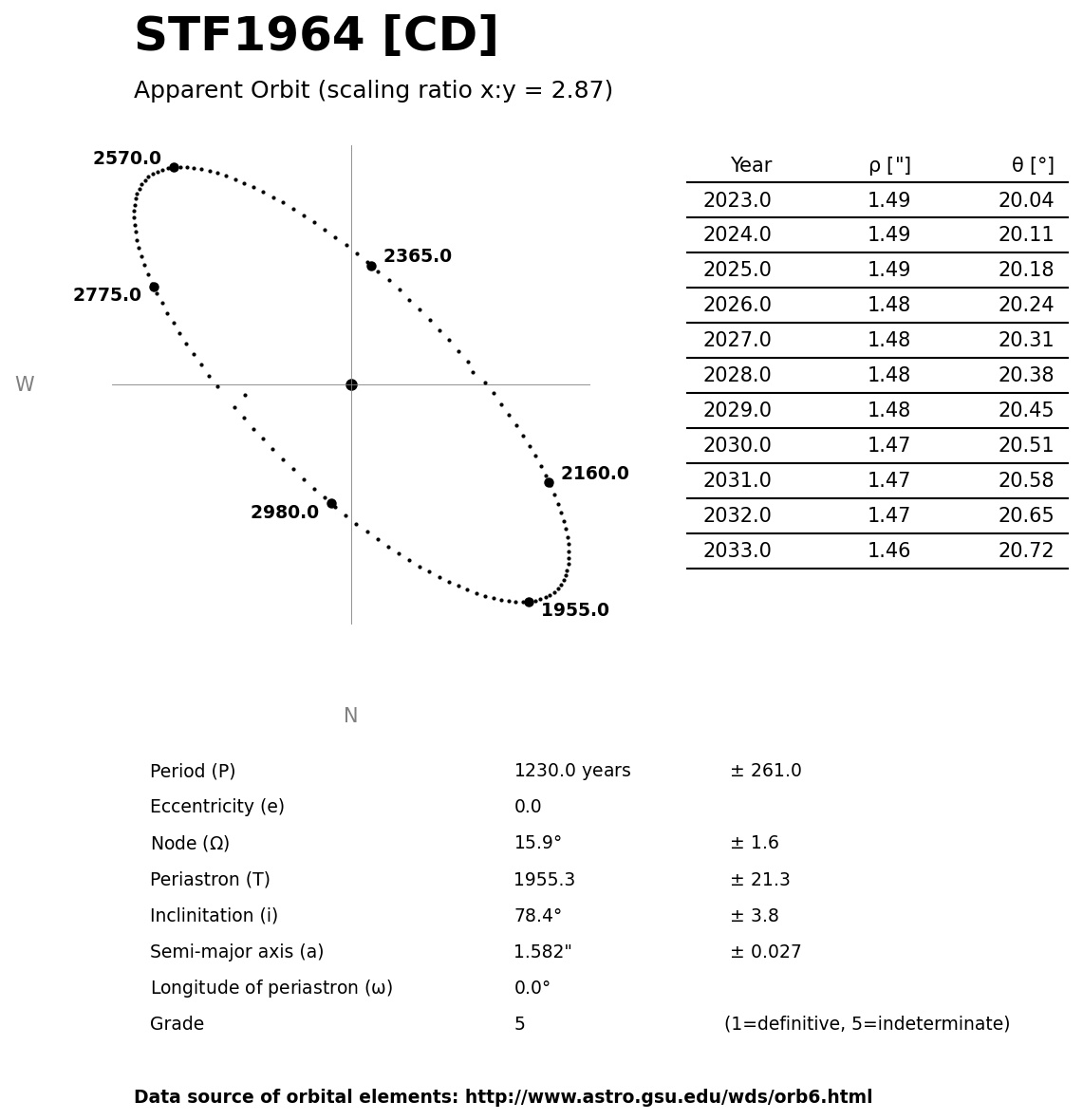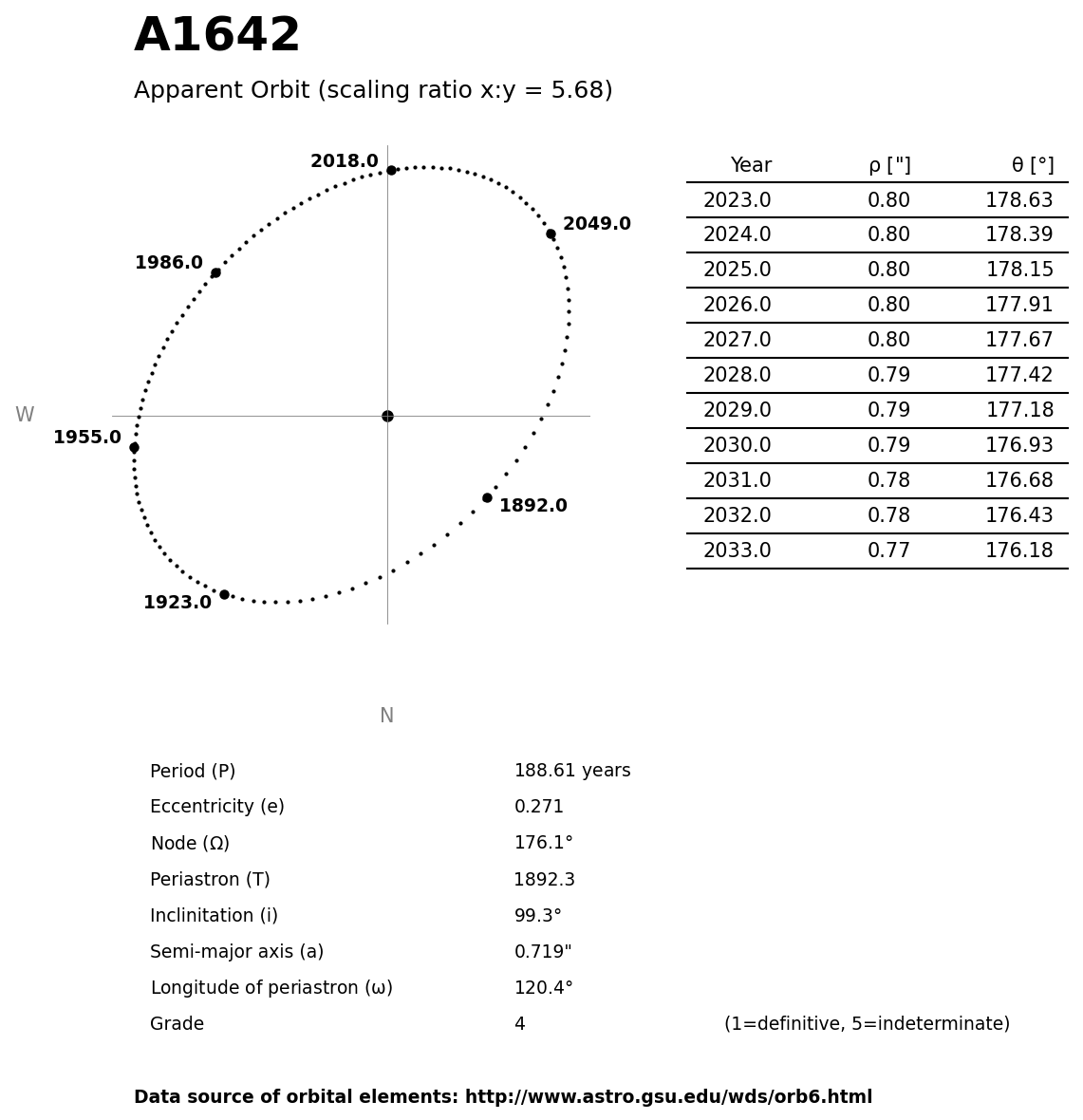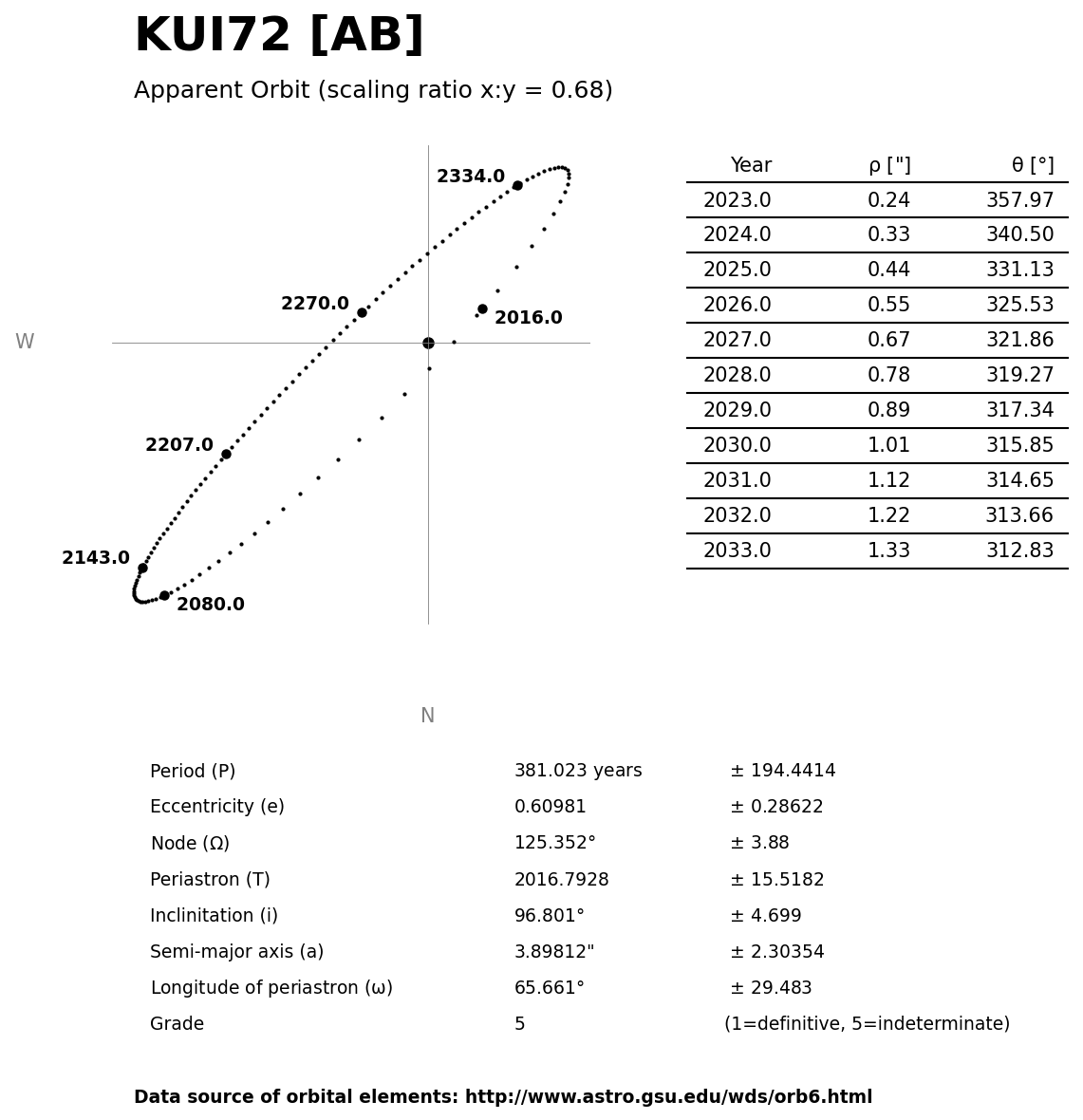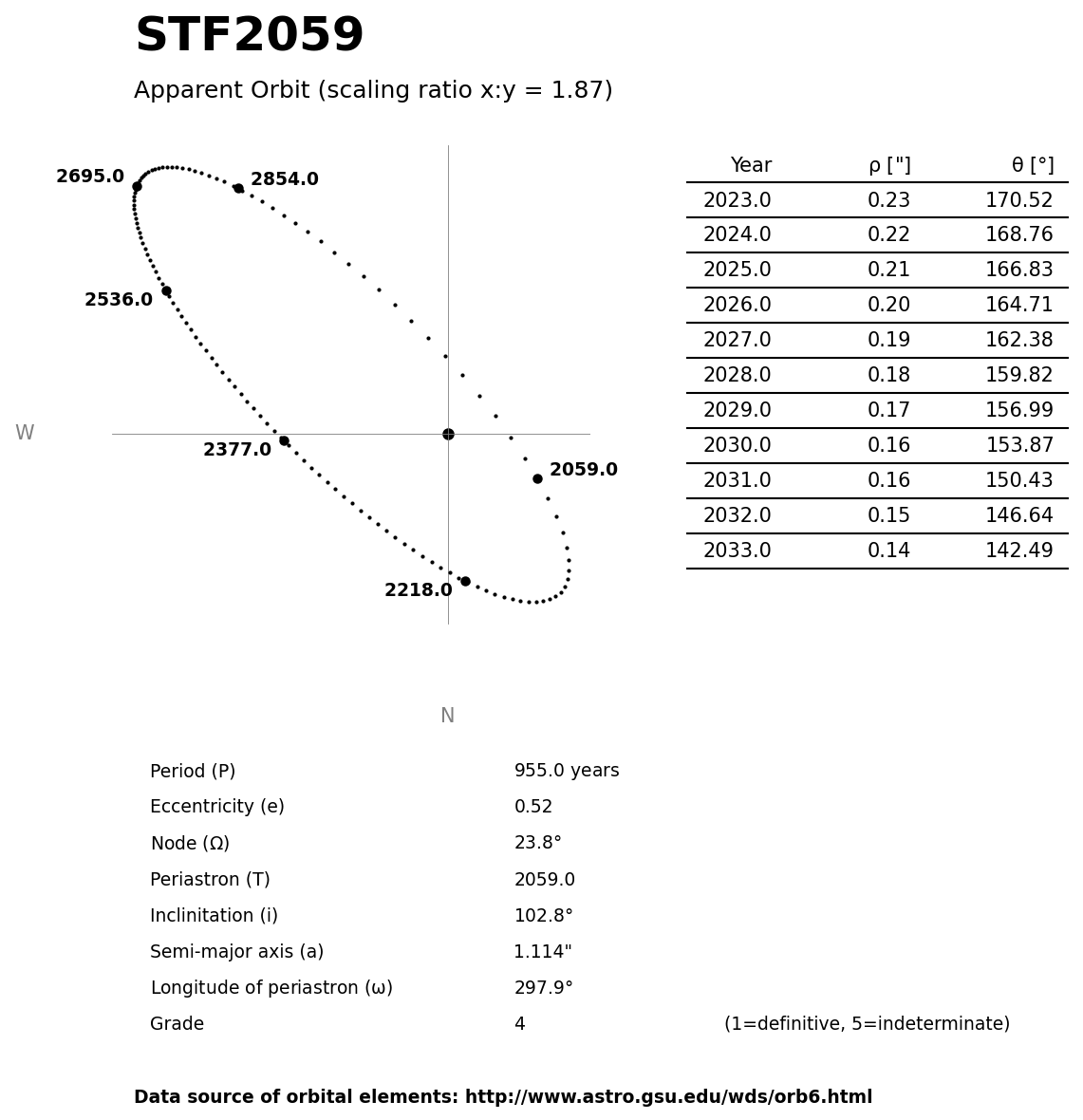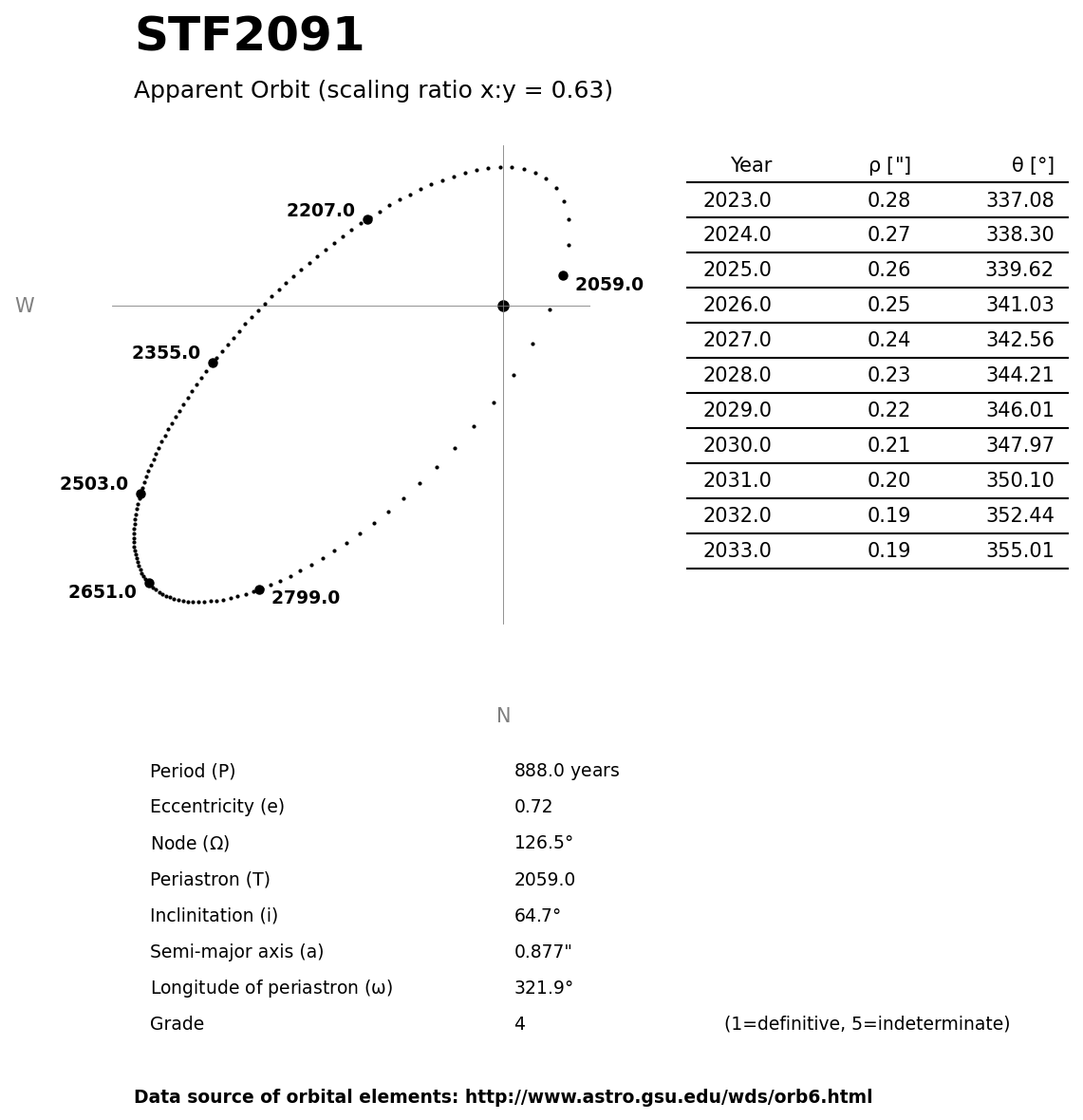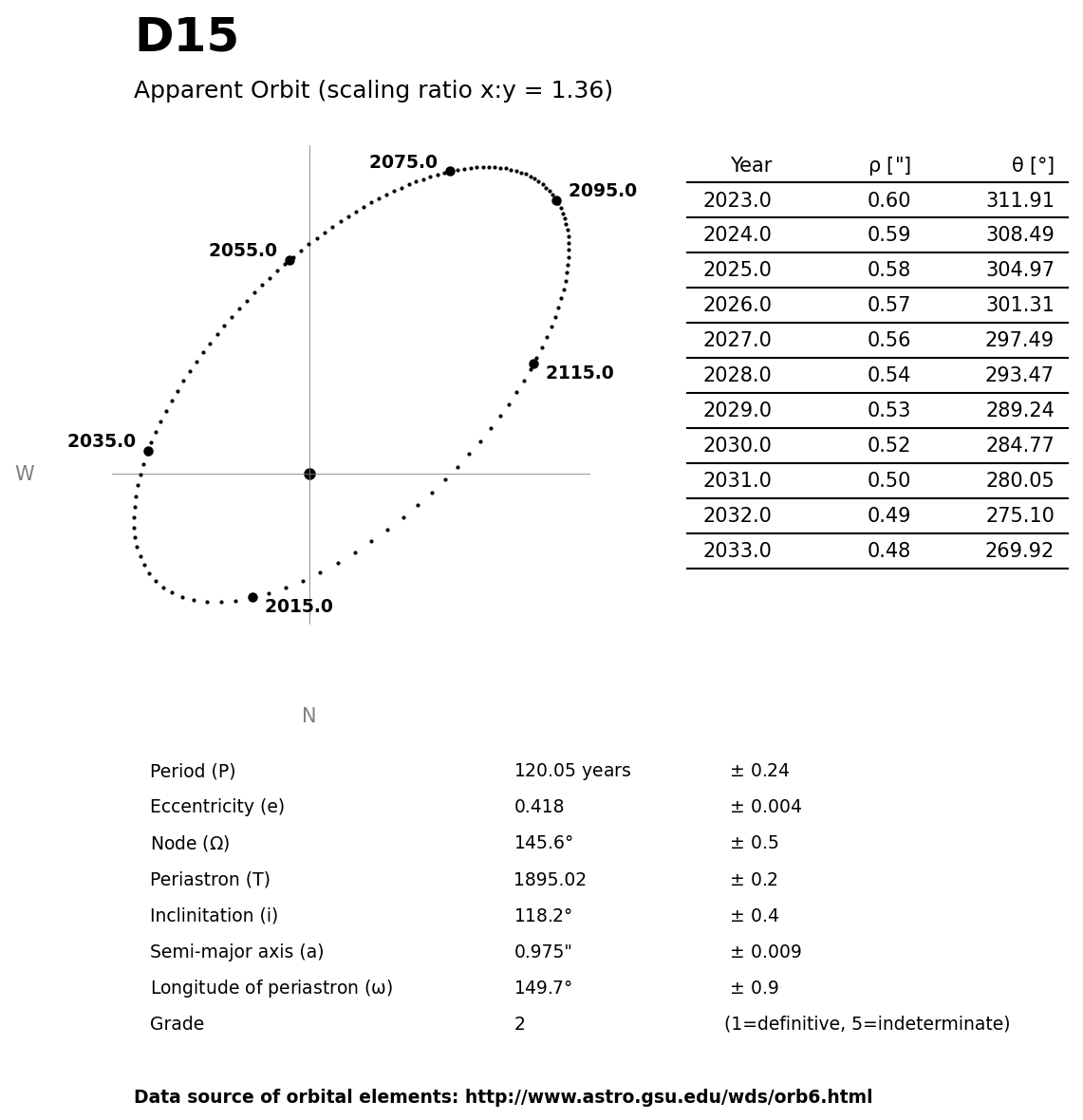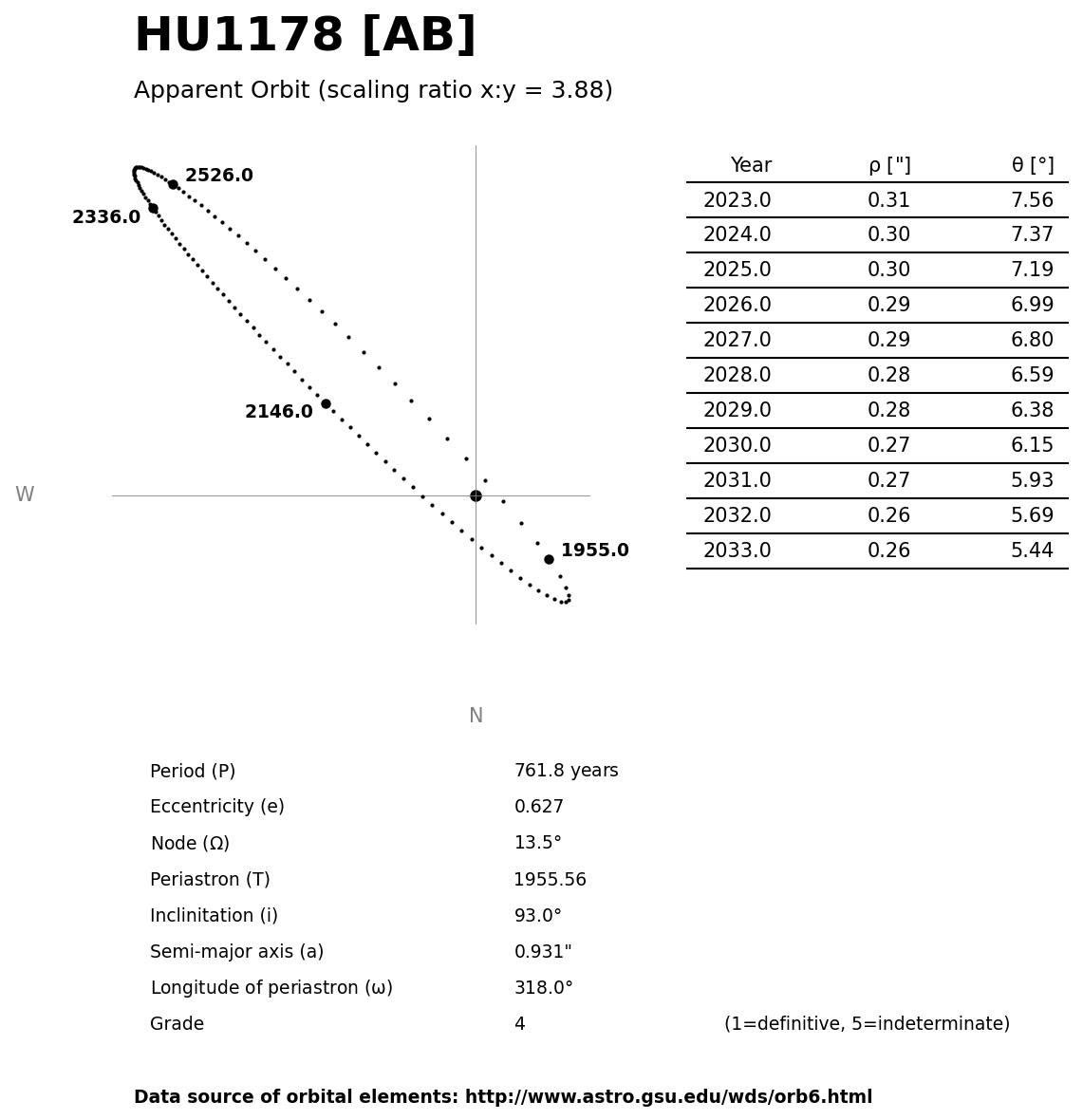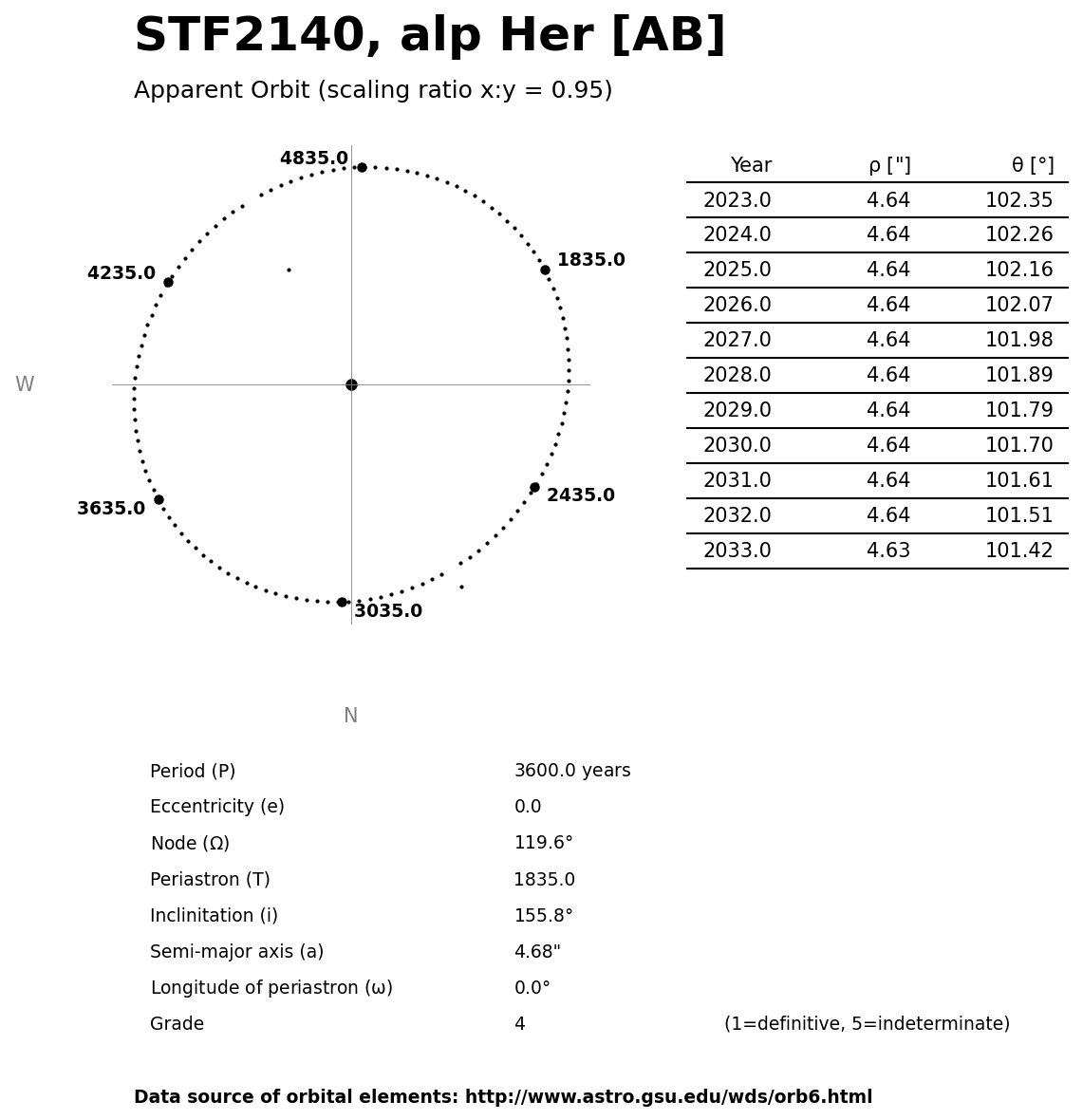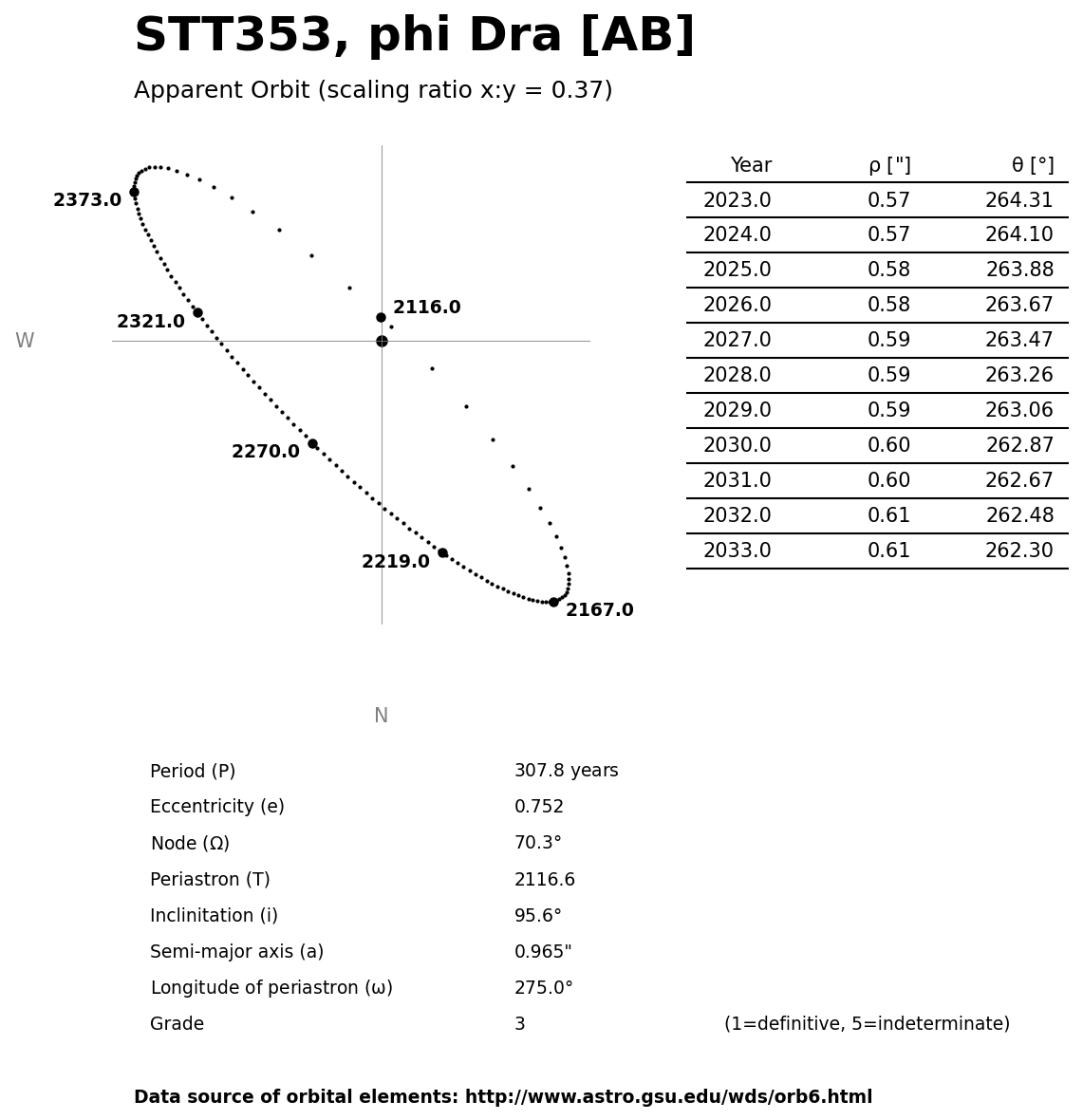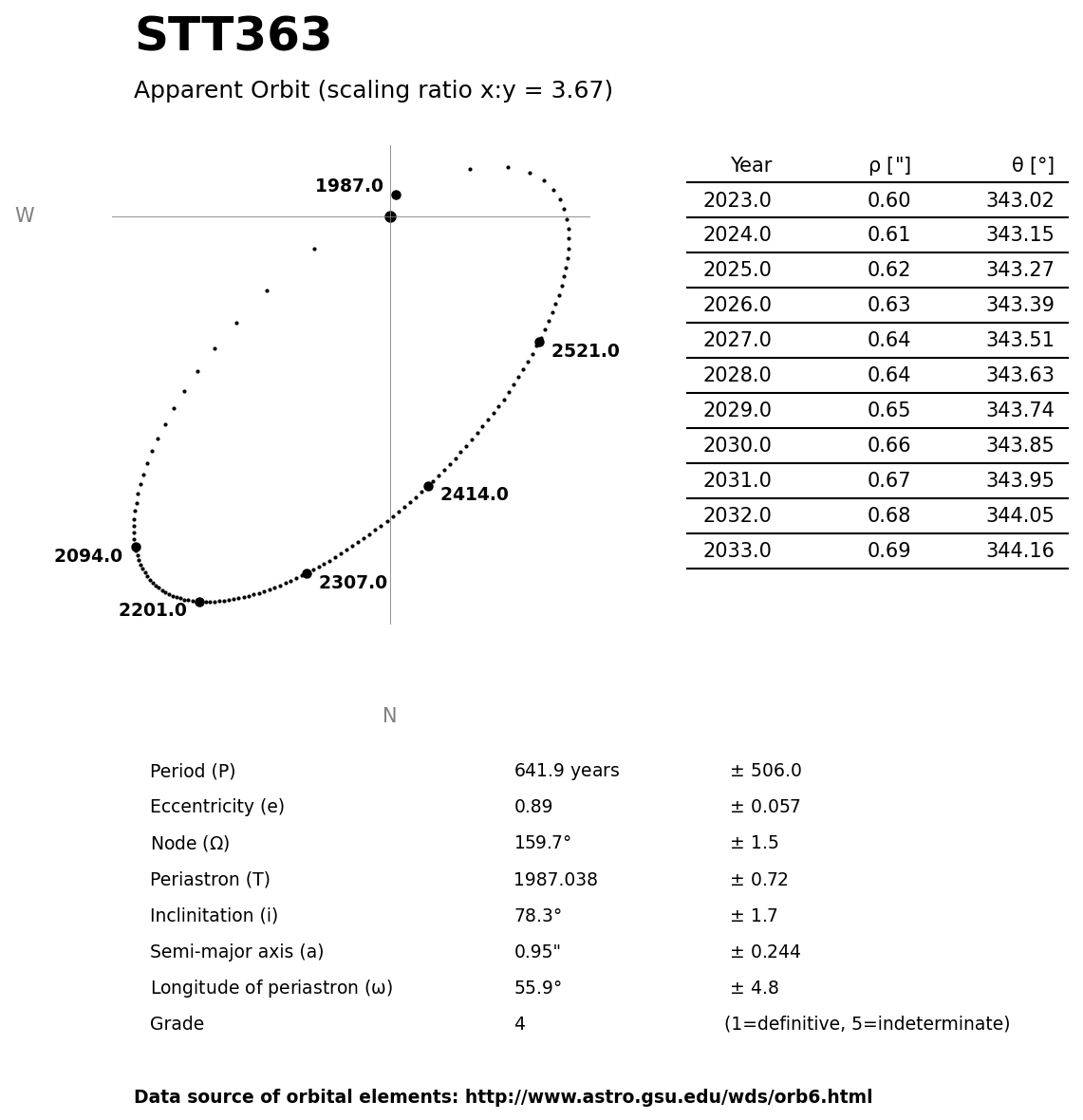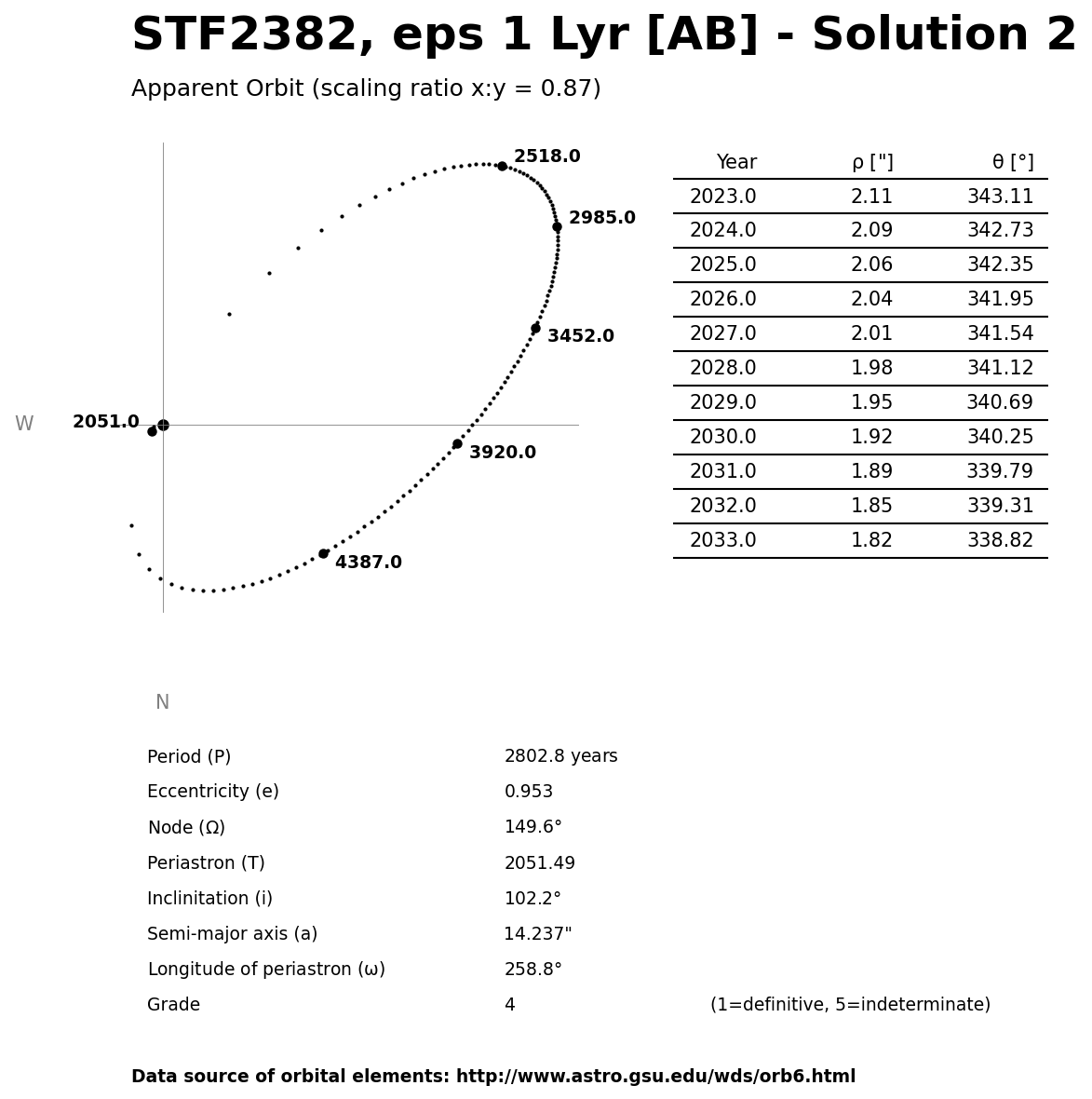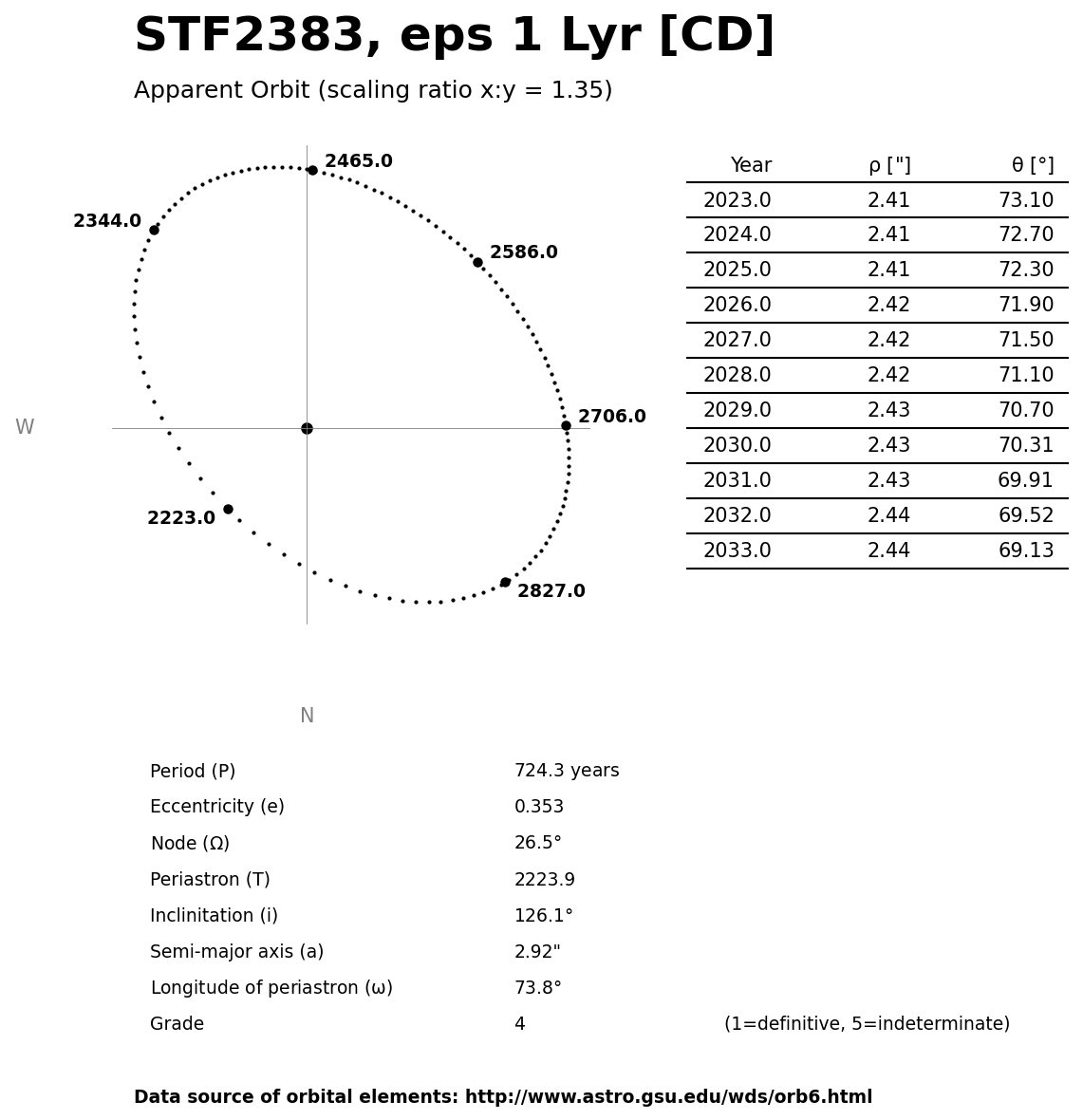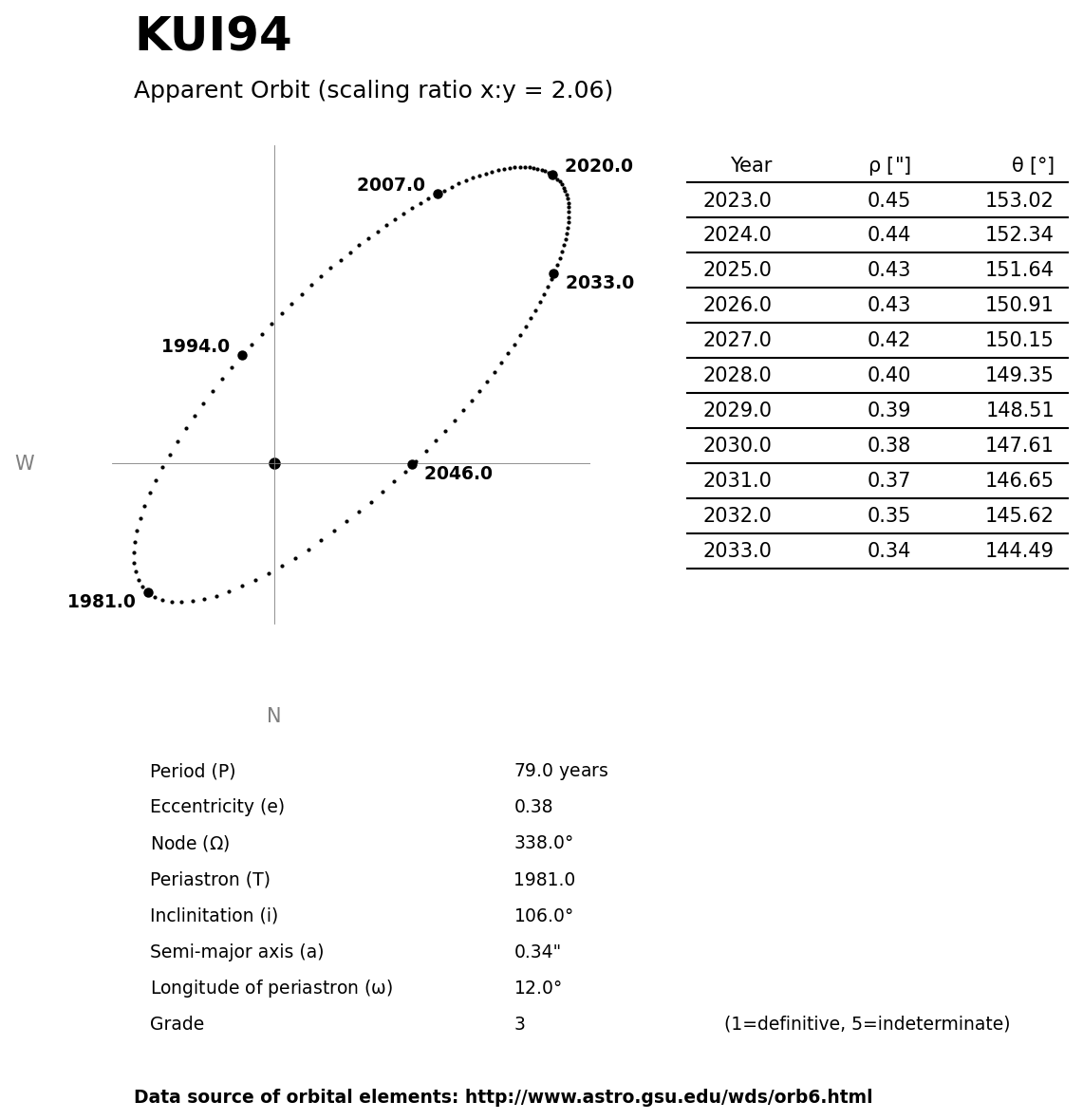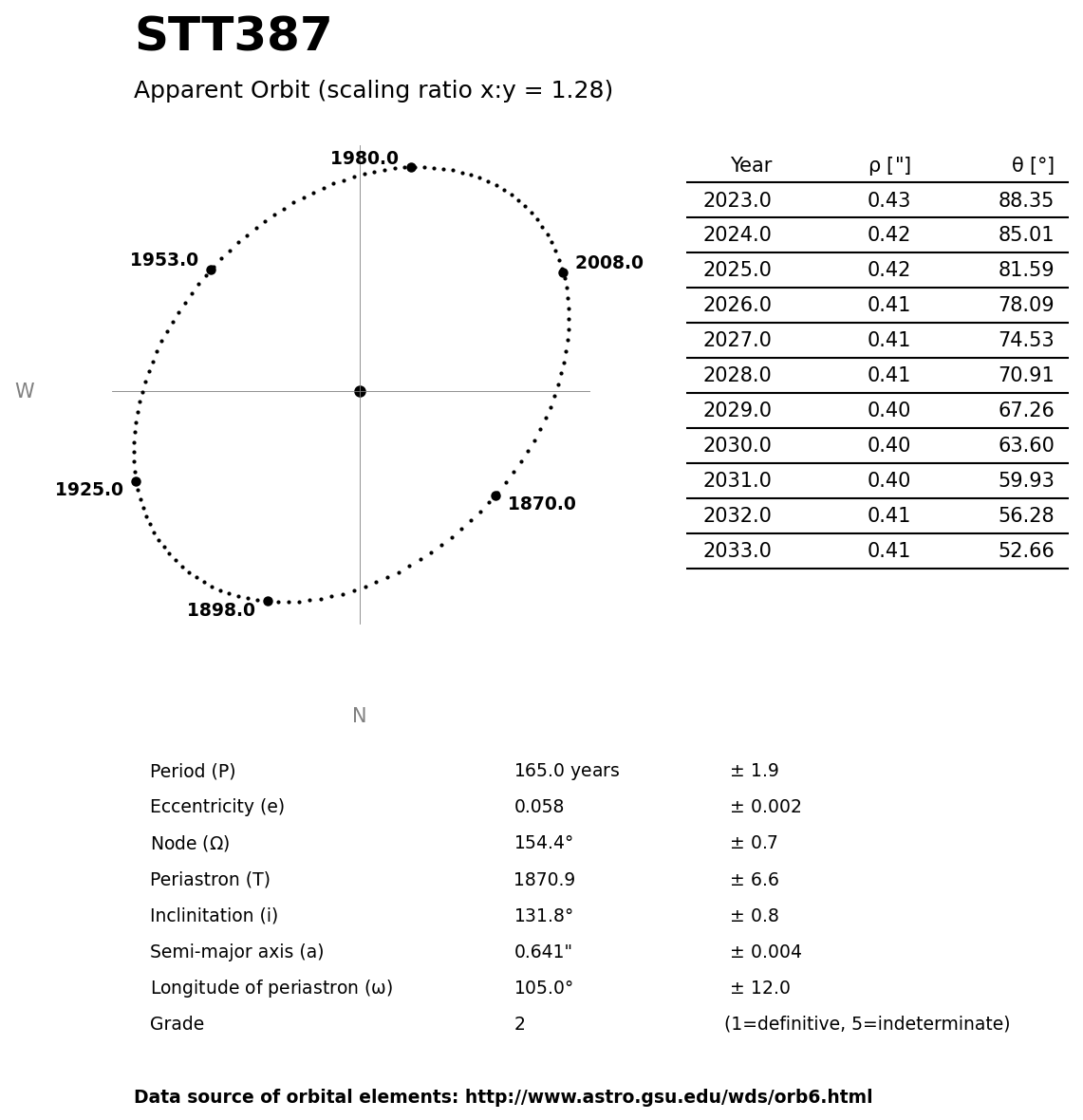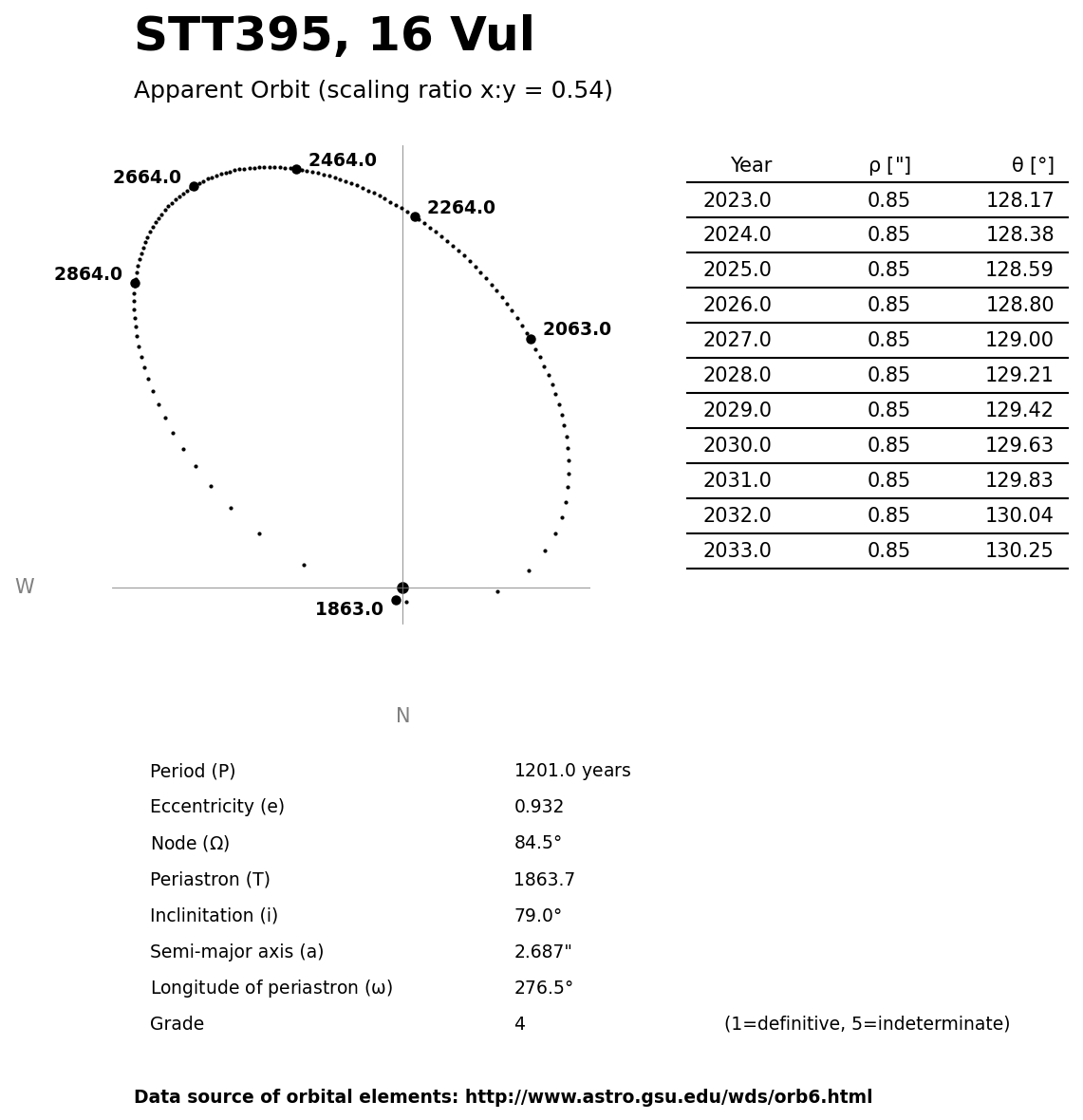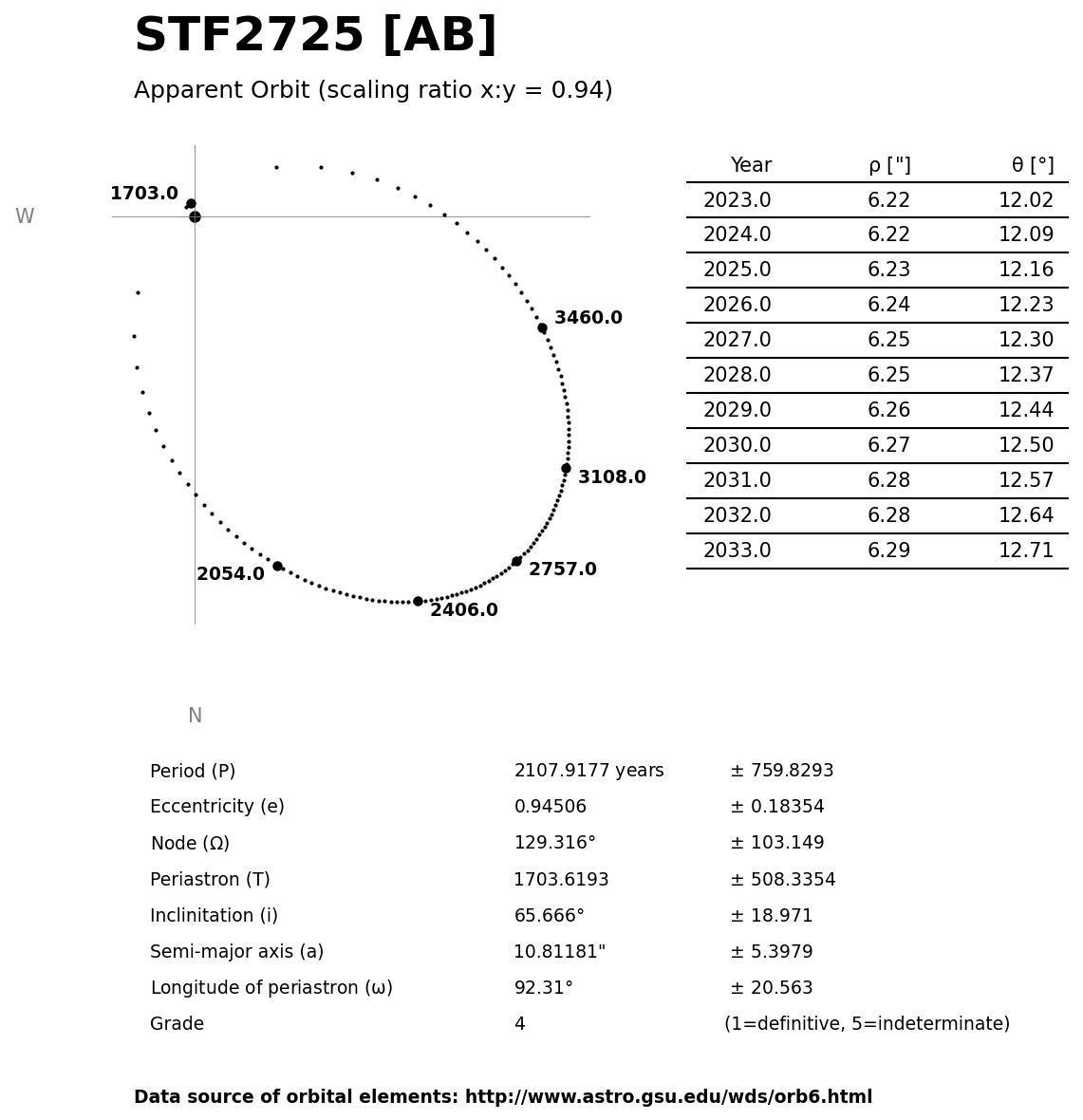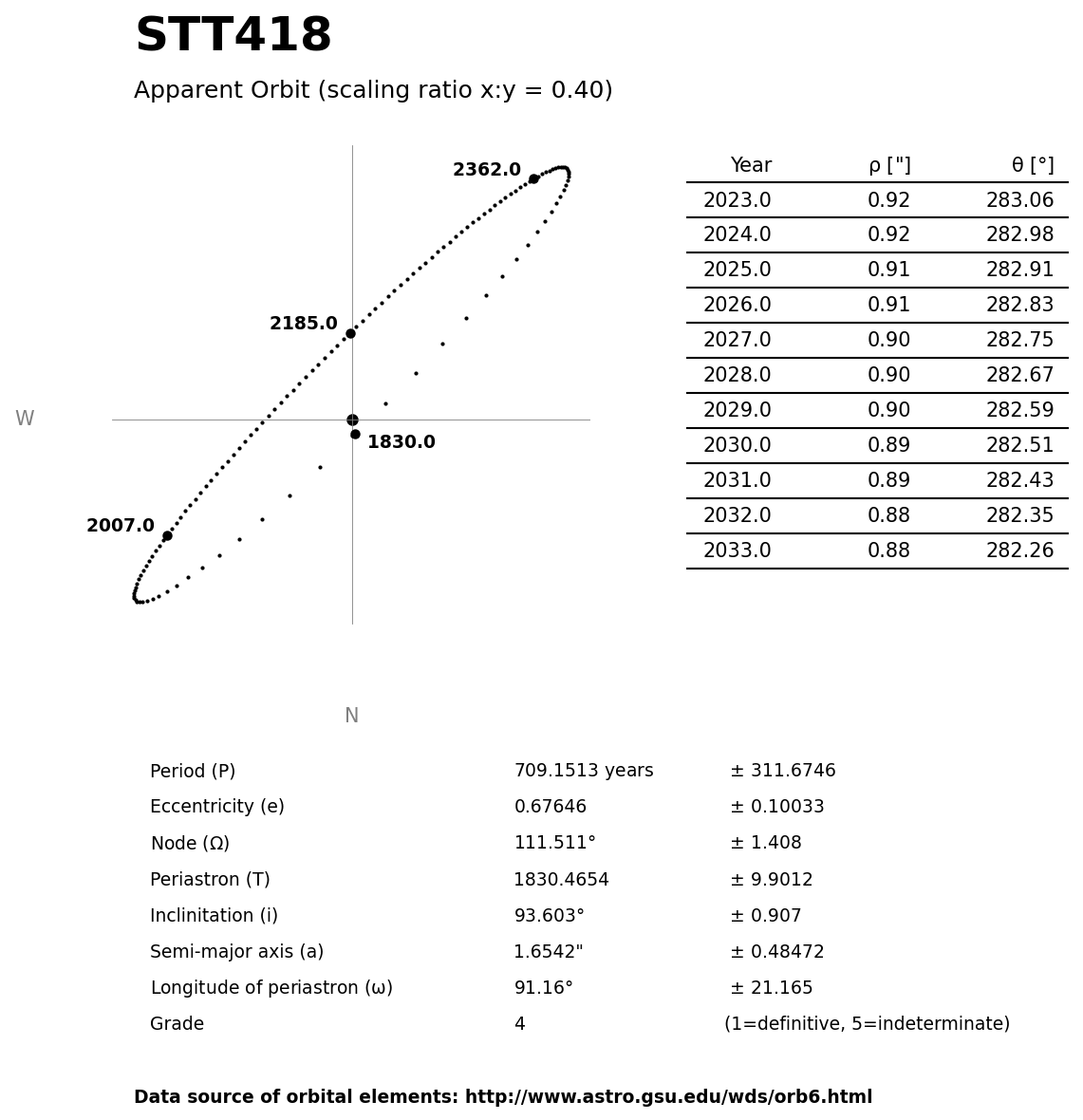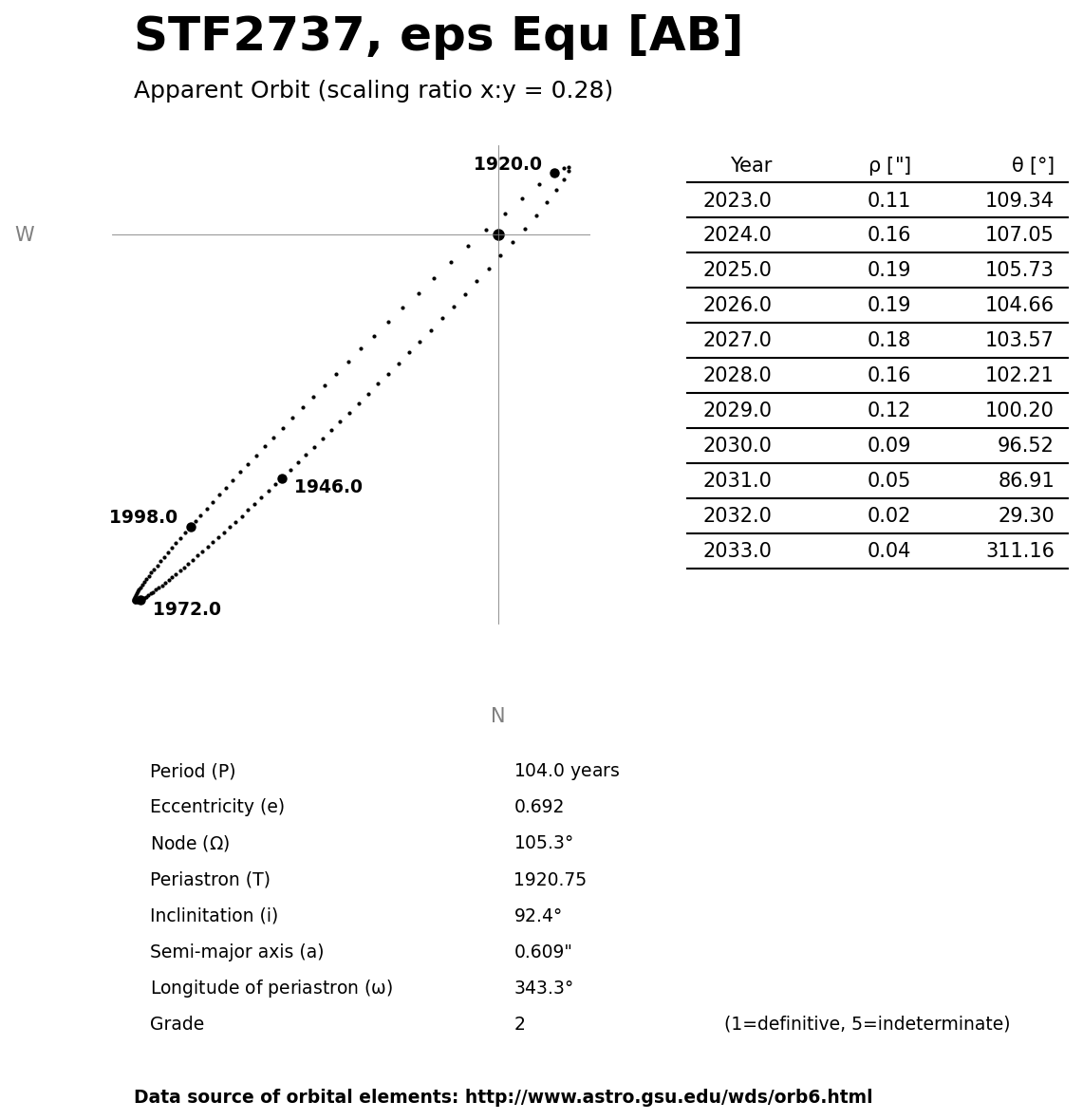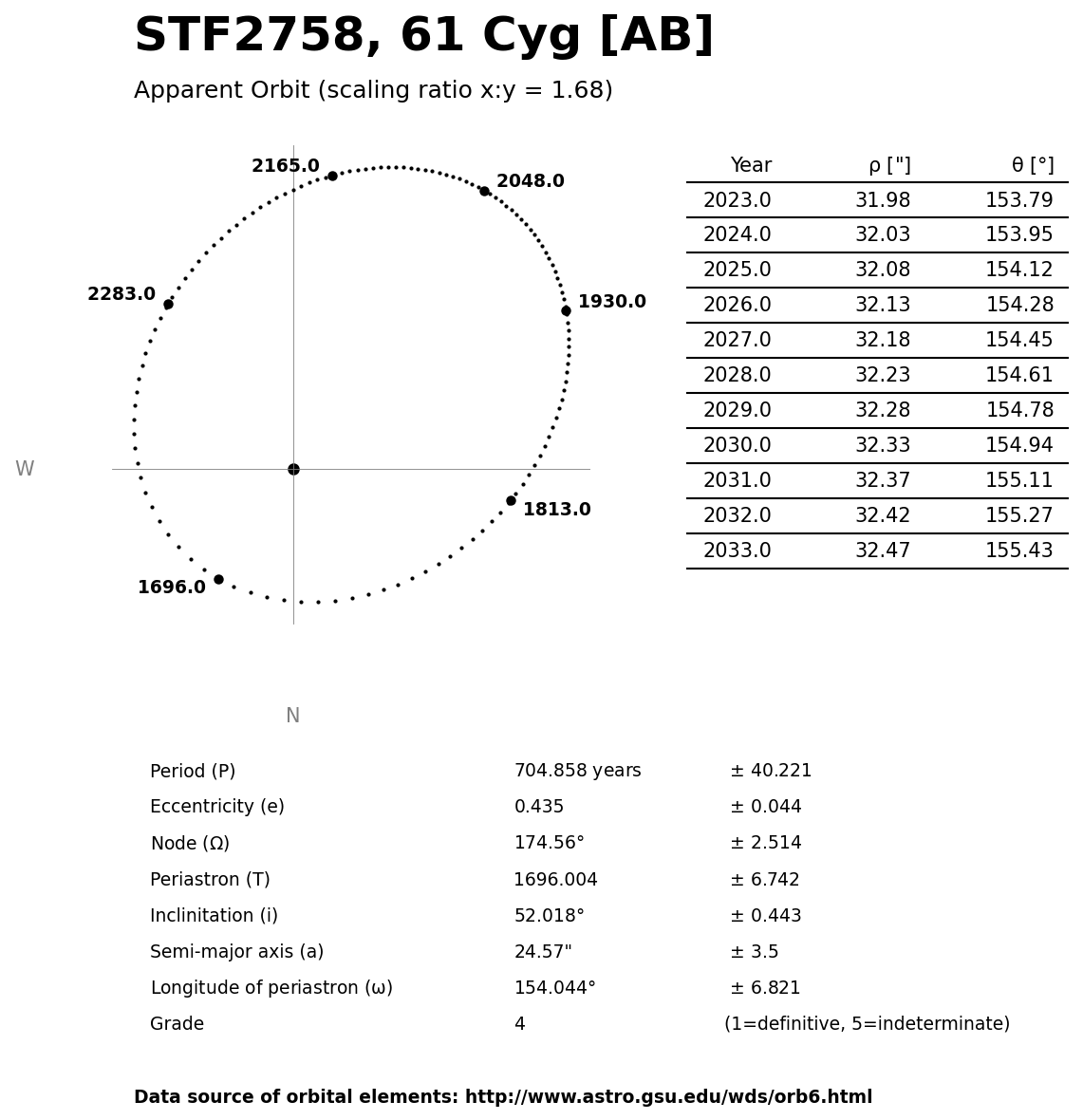|
m1 |
m2 |
ρ |
θ |
Year |
|
Coordinates (J2000.0) |
|
★★★
|
STTA254, WZ Cas |
|
AB |
7m.4 |
8m.3 |
57.8" |
89° |
2019 |
Cas |
00h01m15.85s / +60°21'19.00" |
|
|
|
|
AC |
7m.4 |
9m.6 |
155.4" |
324° |
2015 |
|
|
|
|
|
|
AD |
7m.4 |
10m.3 |
181.4" |
118° |
2016 |
|
|
Christopher Hay
Seeheim (Germany) |
6x24 |
AB: Clearly split. A definitely brighter than B. Under a NELM 5m5 sky both components appear weak in these mini-binoculars and no colour impression arises.;
WZ Cas is the variable designation of component A of STTA254. This semiregular carbon star has a mean brightness range of 6m8 to 7m7, and can reach extreme values of 6m3 at one end and 8m8 at the other. Perhaps it was too deep in a minimum at the time of observation to show colour with 1 inch of aperture? 15x45 binoculars revealed colour in this night, see observation below. |
|
Christopher Hay
Seeheim (Germany) |
15x45 |
AB: Wide split. A orange-red, B no particular colour. NELM 5m5, same night as 6x24 observation above. |
|
René Merting
Drachhausen (Germany) |
15x56 |
AB: einfach - beide Sterne zeigen sich komfortabel getrennt - Komponente A strahlt gelblich - Komponente B südöstlich wirkt dagegen grau und ist 1.5 bis 2 Größenklassen schwächer |
|
Robert Zebahl
Leipzig (Germany) |
16x70 |
AB: 2020-08-19: Intense orange & bluish. Very striking. |
|
René Merting
Drachhausen (Germany) |
16x70 |
AB: ein schöner Fernglas-Doppelstern - Komponente A im Westen präsentiert sich dunkelgelb (noch nicht orange), B im Osten ist eher weißlich |
|
René Merting
Drachhausen (Germany) |
18x70 |
AB: ein sehr auffälliger Doppelstern mit einem schönen Farbkontrast - A strahlt gelb, das kurz davor steht, ins Orange über zu gleiten - B wirkt im Kontrast aquamarin, so dezent wie eine typische PN-Farbe |
|
René Merting
Drachhausen (Germany) |
76mm (29x) |
AB: bei 29x ein wunderschönes Sternpaar mit einem auffälligen Farbkontrast, weit getrennt - Komponente B wirkt weißgrau bis weißblau gegen die gelborange strahlende A-Komponente - Helligkeitsunterschied eine Größenklasse |
|
René Merting
Drachhausen (Germany) |
76mm (29x) |
AB: Mondscheinbeobachtung - bei 29x ein weit getrenntes Pärchen, bei dem die A-Komponente nicht durch Strahlkraft, sondern durch seine auffallende Farbe besticht, ein sehr kräftiges Kupferorange - es gibt hellere Sterne im Umfeld, aber diese Komponente fällt besonders auf - die B-Komponente ist gut 1.5 mag schwächer und wirkt grau bis graublau |

|
Robert Zebahl
Leipzig (Germany) |
80mm (33x) |
AB: Nice double star. Brighter component appeared orange, the fainter more bluish. |
|
René Merting
Drachhausen (Germany) |
100mm (20x) |
AB: 20x reicht zwar schon für eine klare Trennung, aber Komponente B im Osten ist nur dumpf grau-blau und noch zu schwach für den schönen Farbkontrast, der sich bei 32x offenbart - Komponente A strahlt dann in einem satten Bernsteingelb, B im Osten gibt sich unterkühlt bläulich - Helligkeitsunterschied 1 bis 1.5 Größenklassen, schwierig abschätzbar wegen der Farben |
|
Sarah Gebauer
Germany |
100mm (49x) |
AB: sticht sofort ins Auge aufgrund des stärksten kupferroten Farbtons, den ich seit langem gesehen habe - der Begleiter strahlt bei 49-fach schon weit abgesetzt in einem graublauen, ganz kühlen Farbton |

|
Robert Zebahl
Leipzig (Germany) |
102mm (28x) |
AB: 2019-08-22: Splendid view. Primary component clearly orange, secondary blue. |
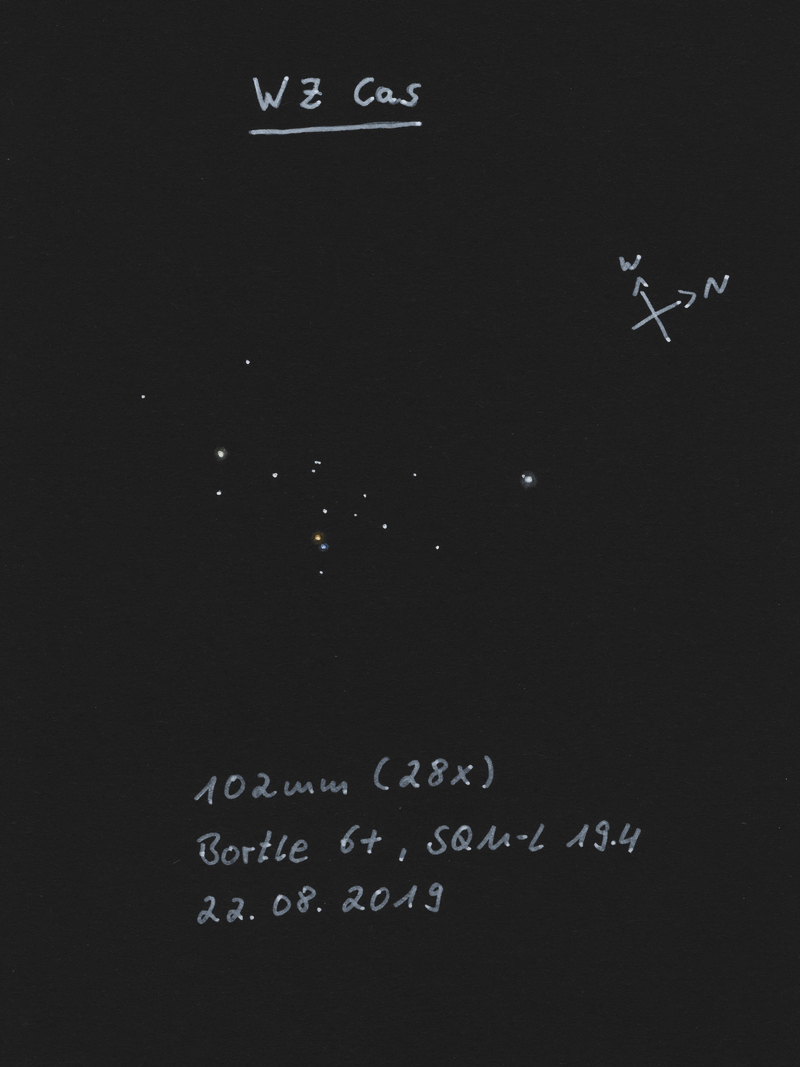
|
Jörg S. Schlimmer
Germany |
127mm (136x) |
Sehr schöner Farbkontrast |
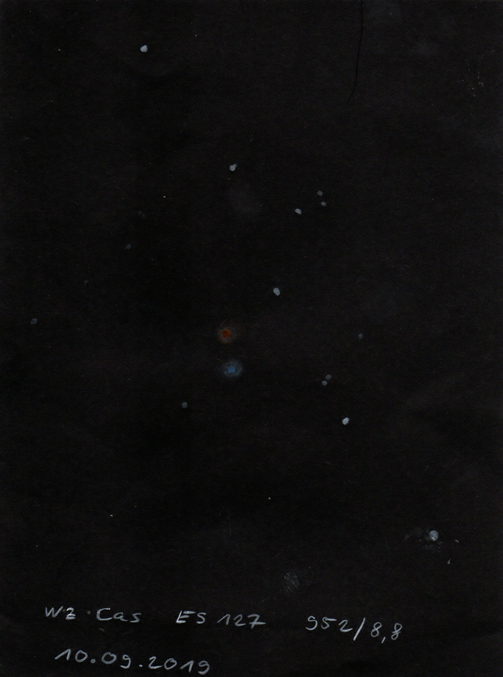
|
Mark McCarthy
Fremont (California/USA) |
317mm (553x) |
AB: WZ Cas: Pretty, deep orange A and very wide half delta mag B, white. |
|
René Merting
Drachhausen (Germany) |
320mm (45x) |
AB: bei 45x ein weit getrenntes Pärchen mit wunderschönen Farbkontrast, Komponente A im Westen ist grell-orange und die gut 1.5 Magnituden schwächere Komponente B ist aquamarin-grau |
|
|
Robert Zebahl
Leipzig (Germany) |
102mm |
|
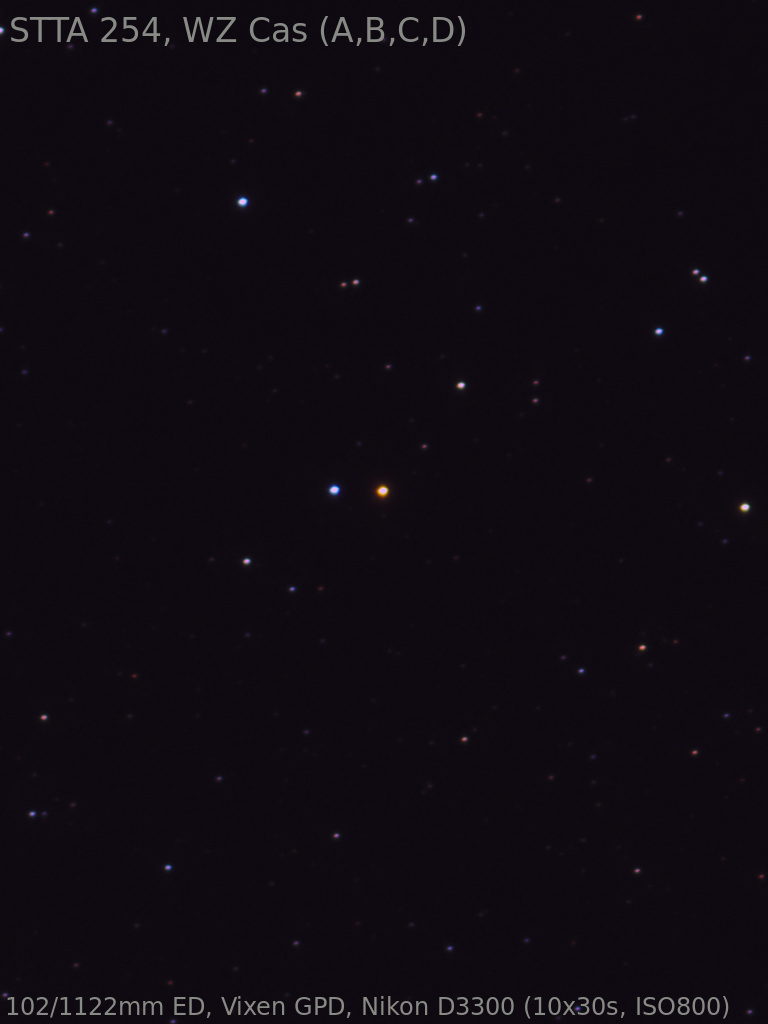
|
|
|
|
STF3061 |
|
|
8m.4 |
8m.5 |
8.0" |
149° |
2016 |
Peg |
00h05m44.45s / +17°50'25.00" |
Robert Zebahl
Leipzig (Germany) |
70mm (22x) |
At 22x tiny pair with similarly bright, close components. Easy to separate at 44x. A small color difference was visible: The brighter component appeared somewhat warmer with a hint of orange, the fainter one slightly bluish. |
|
René Merting
Drachhausen (Germany) |
100mm (32x) |
bei 32x ein knapp getrenntes Pärchen - Komponente B im SO ist nur unwesentlich schwächer - beide weiß - ein schickes enges Paar |
|
Mark McCarthy
Fremont (California/USA) |
317mm (553x) |
Faint, but not too faint, near equal brightness, white, well separated. |
|
Mark McCarthy
Fremont (California/USA) |
508mm (205x) |
Easy wide pair, near equal, very light yellow-white [spectral class F5V+F5V (yellow-white/yellow-white]. WDS calls it physical, but there is no overlap of parallax ranges (-68%), so they are not |
|
|
Berthold Fuchs
Wiesbaden (Germany) |
130mm |
easy DS |

|
|
|
★★★
|
gamma And, 57 And, Alamak |
STF205 |
A-BC |
2m.3 |
5m.0 |
9.5" |
63° |
2021 |
And |
02h03m53.92s / +42°19'47.50" |
|
|
|
BAR22 |
AD |
2m.3 |
15m.0 |
27.9" |
245° |
1898 |
|
|
|
|
|
STT38 |
BC |
5m.3 |
6m.5 |
0.3" |
120° |
2021 |
|
|
|
|
Robert Zebahl
Leipzig (Germany) |
56mm (40x) |
A-BC: 2024-10-31: Nicely separated with a clear difference in brightness. Component A appeared in a bright yellow-orange. |
|
Robert Zebahl
Leipzig (Germany) |
63mm (42x) |
A-BC: Easy to split with quite large difference in brightness. |
|
Christopher Hay
Seeheim (Germany) |
71mm (32x) |
Fine split. A is mandarine orange. BC has trouble displaying its colour due to the overpowering light of A, but in good moments is clearly blue.
A-BC is a physical double at a distance to us of 393 light years.
BC is also physical, with a relatively short period of 63 years for C to circle B and a very tight periastron. Unobservable in 2013 at periastron with 0.1". Since then the angular separation has been widening rapidly and will reach 0.4" in 2029. B-C will then become observable in large amateur telescopes for three decades, after which C will fall quickly back to B. |
|
René Merting
Drachhausen (Germany) |
76mm (29x) |
A-BC: bei 29x äußerst knapp getrennt - Komponente A strahlt buttergelb, BC schmiegt sich im Nordosten an |
|
Uwe Pilz
Leipzig (Germany) |
105mm (52x) |
A-BC: einfach |
|
Uwe Pilz
Leipzig (Germany) |
120mm (128x) |
A-BC |

|
Robert Zebahl
Leipzig (Germany) |
152mm (100x) |
A-BC: Very easy. A: orange, BC: rather white. |
|
Christopher Hay
Seeheim (Germany) |
180mm (110x) |
A very strong pair in 0.6° FOV with powerful colour contrast, A yellow, BC ice blue. |
|
Sarah Gebauer
Germany |
254mm (96x) |
A-BC: in Dänemark als Startstern für die Suche nach der Galaxie NGC 891 gewählt und ohne Vorwissen spontan als sehr schönen Doppelstern erkannt: die Hauptkomponente strahlt richtig schön goldgelb, der Begleiter nordöstlich davon ist richtiggehend reinweiß und klein, wirklich toll! |
|
René Merting
Drachhausen (Germany) |
320mm (45x) |
A-BC: bei 45x ein knapp getrenntes Pärchen - Komponente A knallgelb mit einem Anhängsel nordöstlich - Komponente BC strahlt 3 Größenklassen schwächer - bei 144x wirkt BC grün-weiß, bei 45x war der Eindruck noch leicht gelblich |
|
Mark McCarthy
Fremont (California/USA) |
508mm (667x) |
BC: Component of STF 205, of which A is a brilliant orange and BC bright blue. In BC I can only see elongation through the speckle at 667x and 1067x. Short 62.63 year period which will get "easier" to about 0.2" by 2045 |
|
Mark McCarthy
Fremont (California/USA) |
508mm (1067x) |
BC: I spent a good long while on this one, and tried hard to nail down the position angle. At 1067x, both with and without an apodising mask, but both times with a #80A light blue filter, which did seem to calm the diffraction a little, I had a clear view of the elongation with a strong sense of the weaker end being to the East or to the ESE. I also tried a 78% central obstruction mask, and while the diffraction became a grid, and the disks much smaller, I could clearly see the same elongation and weaker end, though at a much smaller scale. To my delight the current orbital solution puts the PA at 120.6-degrees, 0.179" separation, so I think I have detected it. I can't wait until 2033 when this becomes an easy pair! |
|
|
Winfried Kräling
Marburg (Germany) |
127mm |
A-BC: Aufnahme vom 11.09.2020 am 127/1200mm Refraktor mit Barlowlinse (~2.5x)
Weit getrennt, Komponente A: goldgelb bis orange, Komponente BC: weißlich blau |

|
Werner E. Celnik
Rheinberg (Germany) |
150mm |
A-BC |
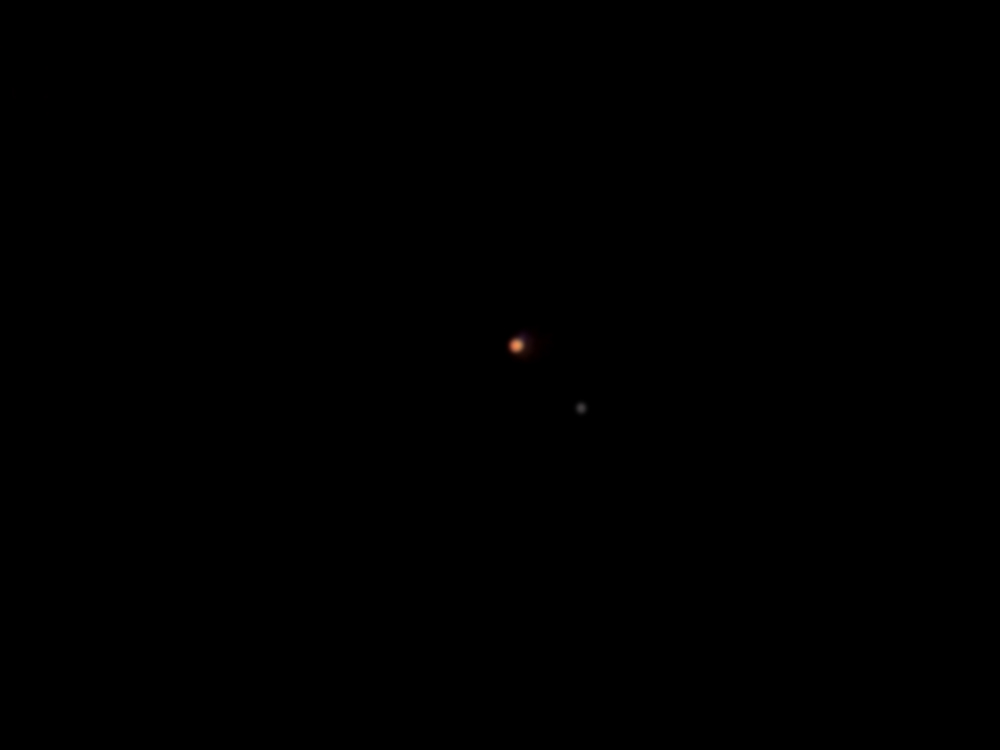
|
|
|
★
|
omicron 2 Eri, 40 Eri, STF518 |
|
A-BC |
4m.4 |
9m.3 |
82.7" |
102° |
2019 |
Eri |
04h15m16.32s / -07°39'10.30" |
|
|
|
|
BC |
9m.5 |
11m.2 |
8.2" |
330° |
2019 |
|
|
|
|
Winfried Kräling
Marburg (Germany) |
102mm (178x) |
|
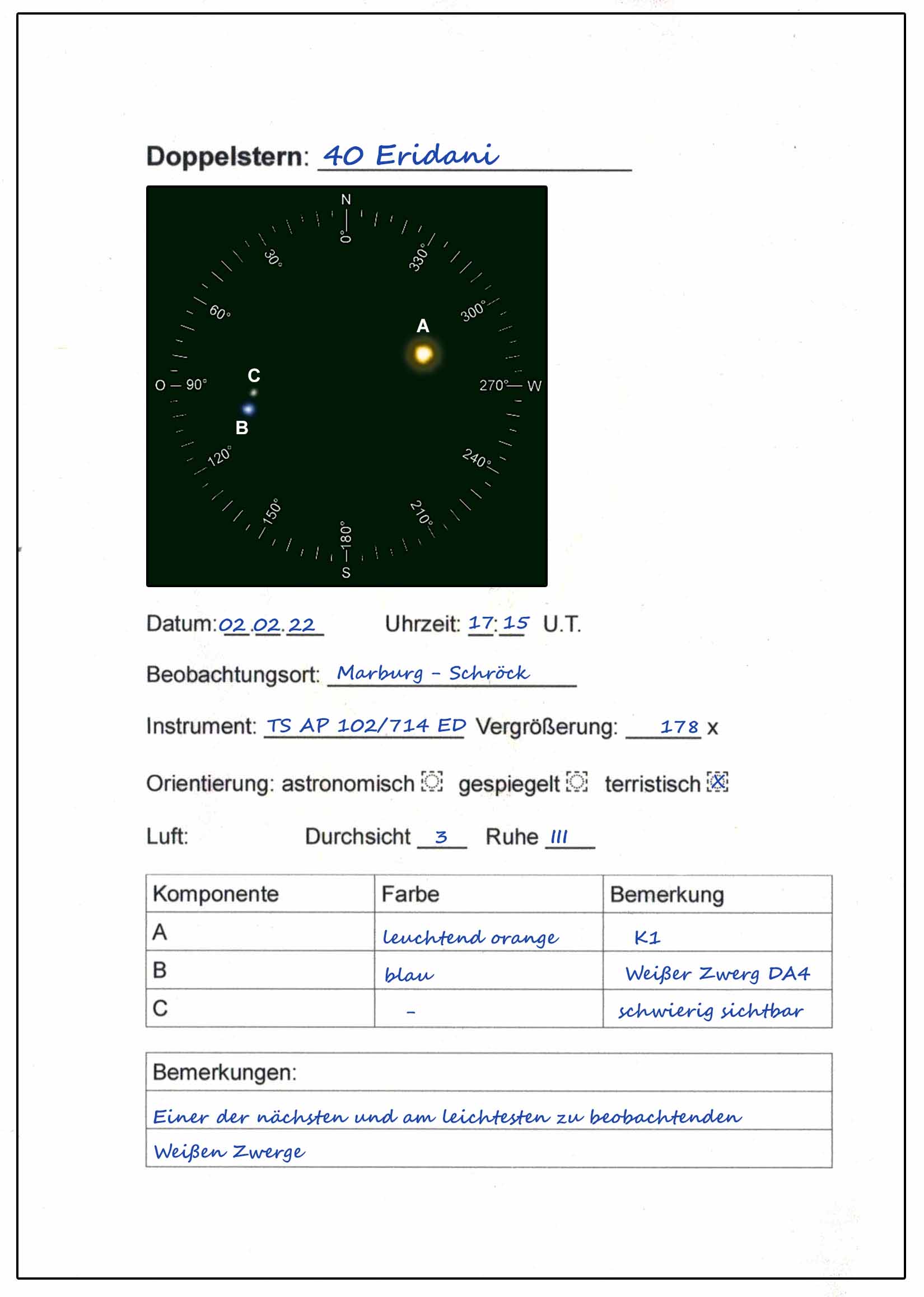
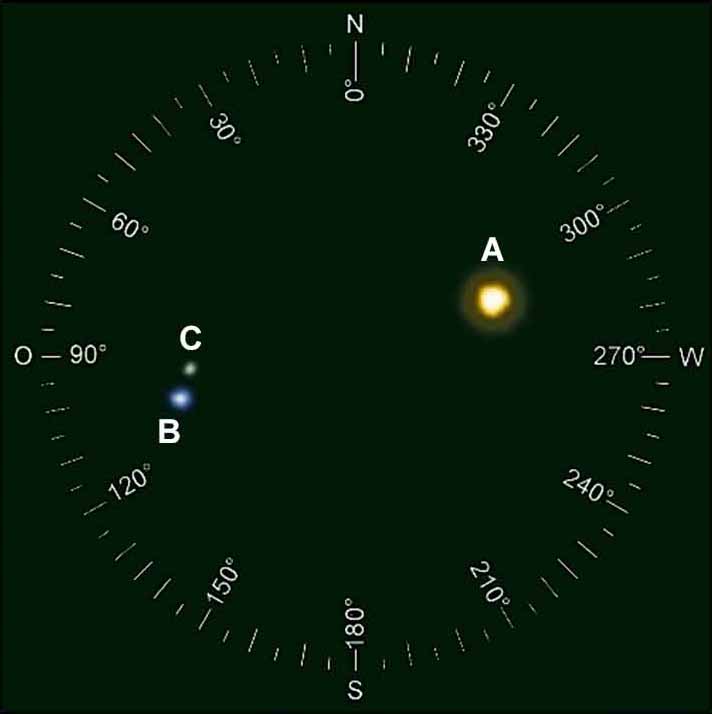
|
Uwe Pilz
Leipzig (Germany) |
105mm (244x) |
A ist gelblich. B fiel sofort ins Auge, auch bei 144x. C war extrem schwierig. A musste außerhalb des Gesichtsfeldes stehen, aber auch dann war er nur indirekt sichtbar. Dann aber überraschte der verhältnismäßig große Abstand B-C. ~ A ist ein Hauptreihenstern ähnlich der Sonne. B ist ein weißer Zwerg, einer der hellsten am Himmel. C ist ein Roter Zwerg, davon gibt es nicht viele in der Reichweite kleiner Instrumente. Insgesamt hat man drei Zwergsterne auf einen Blick: Einen gewöhnlichen (=Hauptreihen-) Zwerg, einen weißen und einen roten. |
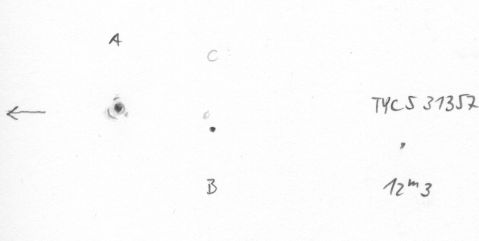
|
|
Berthold Fuchs
Wiesbaden (Germany) |
130mm |
A-BC: Triplesystem with a white Dwarf |
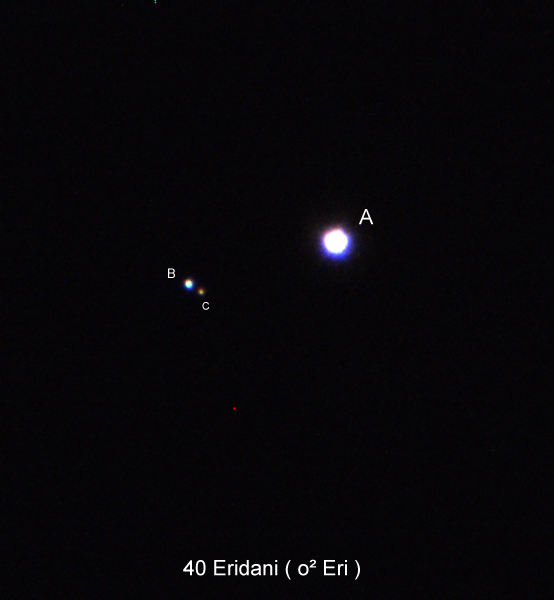
|
|
|
★★★
|
AGC1, 9 CMa, alpha CMa, Sirius |
|
AB |
-1m.5 |
8m.4 |
11.3" |
67° |
2021 |
CMa |
06h45m08.92s / -16°42'58.00" |
|
|
Robert Zebahl
Leipzig (Germany) |
102mm (86x) |
2023-02-14: In a steady phase, the companion is clearly visible within the halo of the primary component, but very faint. |
|
Uwe Pilz
Leipzig (Germany) |
105mm (198x) |
mit ADV, ohne nicht trennbar. Eindeutig |
|
Robert Zebahl
Leipzig (Germany) |
120mm (150x) |
2021-03-02: Used magnifications from 86x to 200x using a Baader yellow filter. The diffraction disk was relatively good visible, but the diffraction rings were noticeably in movement (Seeing 3/5). |
|
Jörg S. Schlimmer
Germany |
127mm (136x) |
not split |
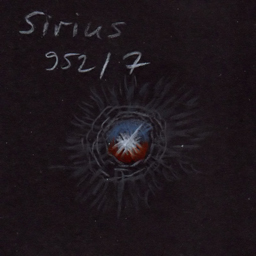
|
Mark McCarthy
Fremont (California/USA) |
203mm (368x) |
Small disk formed on diffraction spike at correct separation and PA (Feb. 2016) |
|
Mark McCarthy
Fremont (California/USA) |
317mm (443x) |
A faint yellow-orange disk, to the edge of Sirius A's diffraction and just below my spider's diffraction spike. I let Sirius pass beyond the field stop, and for an instant there was Sirius B, clearly separated, before it too passed beyond the field stop. |
|
|
Jörg S. Schlimmer
Germany |
305mm |
hard to split with CMOS Camera |

|
|
|
★★★
|
STF1110, alpha Gem, 66 Gem, Castor |
|
AB |
1m.9 |
3m.0 |
5.4" |
53° |
2020 |
Gem |
07h34m35.86s / +31°53'17.80" |
|
|
|
|
AC |
1m.9 |
9m.8 |
71.6" |
164° |
2020 |
|
|
|
|
|
|
AD |
1m.9 |
10m.1 |
179.8" |
221° |
2017 |
|
|
|
|
Christopher Hay
Seeheim (Germany) |
20x60 |
AB: Handheld in reclining chair, binoculars with internal stabilisation. 16 April 2022 (5.5" angular distance according to database): Distinctly elongated, like a rectangle at the transition to a figure-8. |
|
Christopher Hay
Seeheim (Germany) |
26x42 |
AB: 13 May 2022 (5.5" angular distance according to database). Moon four-fifths full a few degrees north of Spica in Virgo. 70mm binoculars stopped down to 42mm aperture. Directly after looking the Moon I was able to split Castor AB definitely. Could hold this for a full minute, only then did the split start to become uncertain. Repeated the observation several times, found the split to be definite each time. |
|
Christopher Hay
Seeheim (Germany) |
32x70 |
AB: 13 March 2022 (5.5" angular distance according to database): Moon only 6° away and two-thirds full in the middle of Gemini. After concentrated observation of the Moon I slewed quickly to Castor to exploit the heightened acuity provided by viewing the bright Moon. Castor clearly split with fine black between A and B. After a while the split became more difficult but could still be held.
Followed this up with the same eyepiece previously used in the achromatic 70/400 binoculars now placed in 71/400 fluorite apochromatic telescope, thus again yielding 32x. Again A and B split after observation of the Moon, but harder to hold with the mono apochromat than with the bino achromat. |
|
Christopher Hay
Seeheim (Germany) |
36mm (33x) |
AB: 16 April 2022 (5.5" angular distance according to database): With Käsemann (KSM) polarising filter at 33x two kissing Airy disks which seem to move apart in good moments, but this is uncertain. Without filter at 33x just a squat figure-8 far removed from separation.
With polarising filter at 40x definite separation, fine first diffraction ring of component A. Without filter a stretched figure-8 with no separation.
At 50x clear and stable separation with and without filter. Best view at 66x, a ghostly pair in pitch-black FOV, the first diffraction rings of A and B merging, that of B very faint.
With a Baader Neodymium filter the positive effects are similar to those of the KSM polarising filter, but the clarity of separation is not quite as great as with the polarising filter. |
|
Robert Zebahl
Leipzig (Germany) |
55mm (27x) |
AB: At 27x slight difference in brightness visible. Double star appeared as '8'. At 38x clearly split, but tight. |
|
Robert Zebahl
Leipzig (Germany) |
63mm (26x) |
AB: Experiment to determine the smallest magnification to separate Castor. I observed on 2022-05-09, 2022-05-11 & 2022-05-18.
At 26x and 30x easily seen as a double star, but not clearly separable due to outshining. At 70x of course easily separated. Stopped down to 30mm aperture, Castor appeared partially separated at 26x, but very barely. The right viewing position at the eyepiece was important. At 30x with 30mm aperture, Castor was cleanly separated, but extremely tight.
Following a hint from Christopher Hay, I also used a red filter from Baader to avoid outshining at full aperture. Now also a separation at 26x was possible, whereby the components were extremely close to each other.
For me a magnification of 26x seems to be the minimum to separate Castor cleanly, if the brightness of the components is reduced sufficiently. |
|
Robert Zebahl
Leipzig (Germany) |
70mm (44x) |
AB: At 44x the double star appeared as an '8'. At 100x clearly split with noticeable difference in brightness. Both components appeared white. |
|
Axel Tute
Küssaberg (Germany) |
70mm (146x) |
AB: 11.03.2009: Separated with the 6mm Ortho and the 4.8mm Plössl. A: bluish B: orange |

|
Axel Tute
Küssaberg (Germany) |
70mm (146x) |
AB: 23.03.2010: B with a clear gap. |
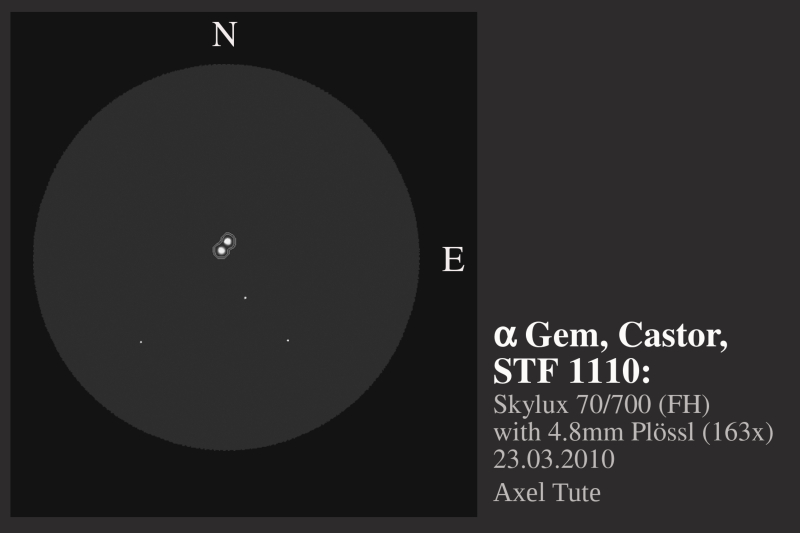
|
Christopher Hay
Seeheim (Germany) |
76mm (50x) |
AB: 18 February 2021: At 23x oval-elongated with clear position of component A. At 50x finely split. At 83x best sight with first diffraction rings slightly overlapping. At 100x nice pattern of the Airy disks and the overlapping first and second diffraction rings of both components. |
|
René Merting
Drachhausen (Germany) |
76mm (81x) |
AB: bei 57x sind zwei Murmeln erkennbar, die noch knappst aneinander kleben - bei 81x dann zeigen sich zwei helle Sterne knapp getrennt mit leichtem Farbkontrast, die A-Komponente im Süden schimmert leicht gelblich, B ist eine dreiviertel Magnitude schwächer und schön weiß |
|
René Merting
Drachhausen (Germany) |
100mm (107x) |
AB: bei 32x wirkt der Stern leicht länglich - bei 107x stehen die beiden Sterne schön eng mit überlagernden Beugungsscheibchen, die Komponenten sind dennoch getrennt erkennbar - Komponente B im Osten ist eine halbe Magnitude schwächer - ganz schwacher Farbkontrast |
|
Axel Tute
Küssaberg (Germany) |
100mm (163x) |
AB: 23.03.2010: Around A and B a diffraction ring each. Between the diffraction rings still a clear gap |
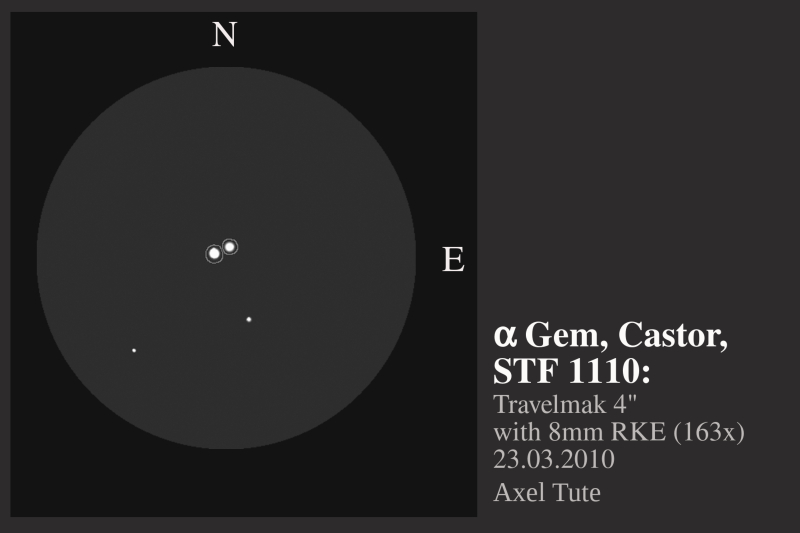
|
Uwe Pilz
Leipzig (Germany) |
105mm (144x) |
AB: blauweiß-weiß |
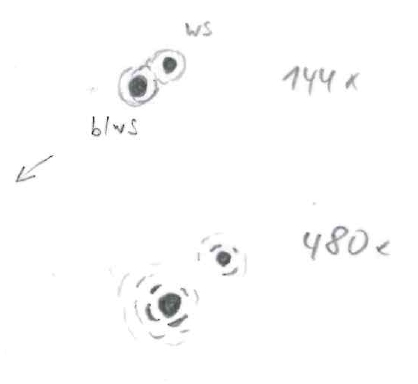
|
Winfried Kräling
Marburg (Germany) |
127mm (250x) |
AB: 13.03.2017: Beide Komponenten gelblich mit geringem Helligkeitsunterschied, bereits bei V=60x getrennt. |

|
Mark McCarthy
Fremont (California/USA) |
178mm (205x) |
AB: Castor. A is a very pale yellow and B is yellow-green, 2 delta mag, very bright, pretty wide, some fainter stars about. Physical with a 459.8-year period |
|
Christopher Hay
Seeheim (Germany) |
180mm (200x) |
AB: Two fat spotlights in space. Component B seems greenish at first sight (using a first-class reflector free of chromatic aberration), and certainly has a different hue than component A. The second diffraction rings of A and B meet. |
|
|
Frederik Wanink
Itterbeck (Germany) |
254mm |
AB |
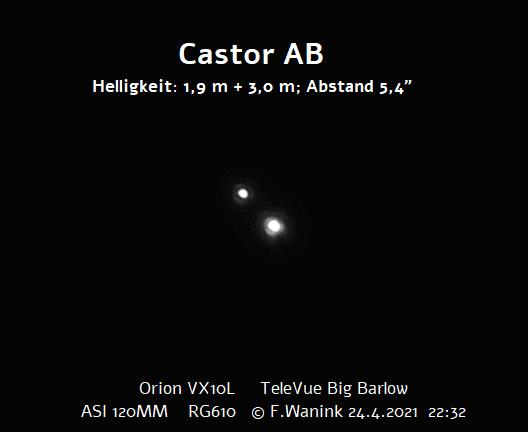
|
Frederik Wanink
Itterbeck (Germany) |
254mm |
AB |

|
|
|
★★★
|
zeta Cnc, 16 Cnc |
STF1196 |
AB |
5m.3 |
6m.2 |
1.1" |
359° |
2021 |
Cnc |
08h12m12.79s / +17°38'51.20" |
|
|
|
STF1196 |
AB-C |
4m.9 |
5m.8 |
6.0" |
64° |
2020 |
|
|
|
|
|
STF1196 |
AC |
5m.3 |
5m.8 |
6.2" |
62° |
2020 |
|
|
|
|
|
HUT1 |
Ca-Cb |
6m.2 |
7m.1 |
0.3" |
344° |
2021 |
|
|
|
|
Robert Zebahl
Leipzig (Germany) |
70mm (133x) |
The wide pair AB-C is already separable at 22x. The pair AB shows at 133x two clearly overlapping diffraction disks with small difference in brightness, but without any notch. |

|
Christopher Hay
Seeheim (Germany) |
71mm (32x) |
AB-C: Finely split. AB yellowish. Substantial delta-mag. |
|
Robert Zebahl
Leipzig (Germany) |
102mm (86x) |
AB-C: Easy to separate. A: light grey, B: pale orange. |
|
Stefan Loibl
Rosenheim (Germany) |
102mm (164x) |
AB-C clearly split, AB obviously elongated but not split |
|
Uwe Pilz
Leipzig (Germany) |
105mm (288x) |
weißblau-gelb-gelb |
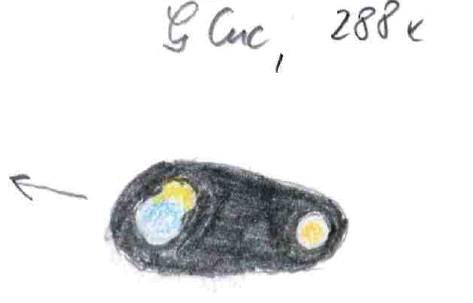
|
Robert Zebahl
Leipzig (Germany) |
120mm (67x) |
AB-C: Evident difference in brightness, easy to split. Both components of similar color. |
|
Robert Zebahl
Leipzig (Germany) |
120mm (200x) |
AB: Very tight. The Airy disks were still touching. Slight difference in brightness. Extremely beautiful triple star! |
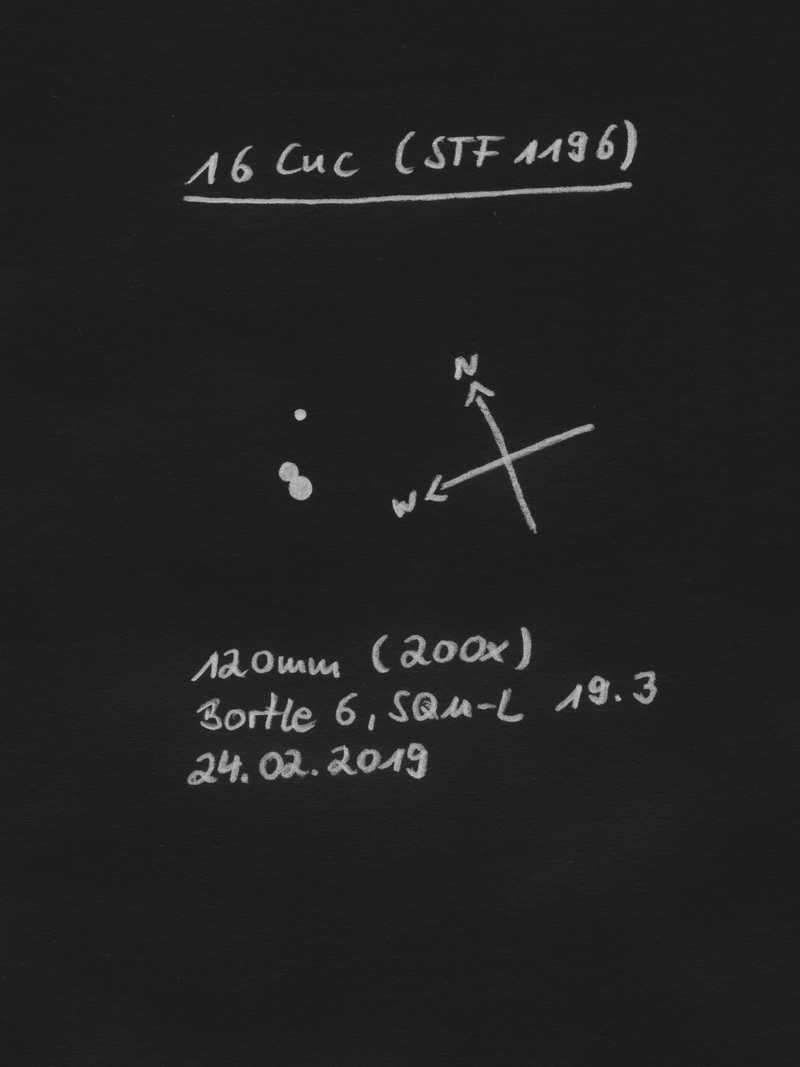
|
Winfried Kräling
Marburg (Germany) |
127mm (250x) |
08.04.2018: Sehr schön, 3-fach Stern, A = weißgelb, B = weißgelb, C = weißgelb |
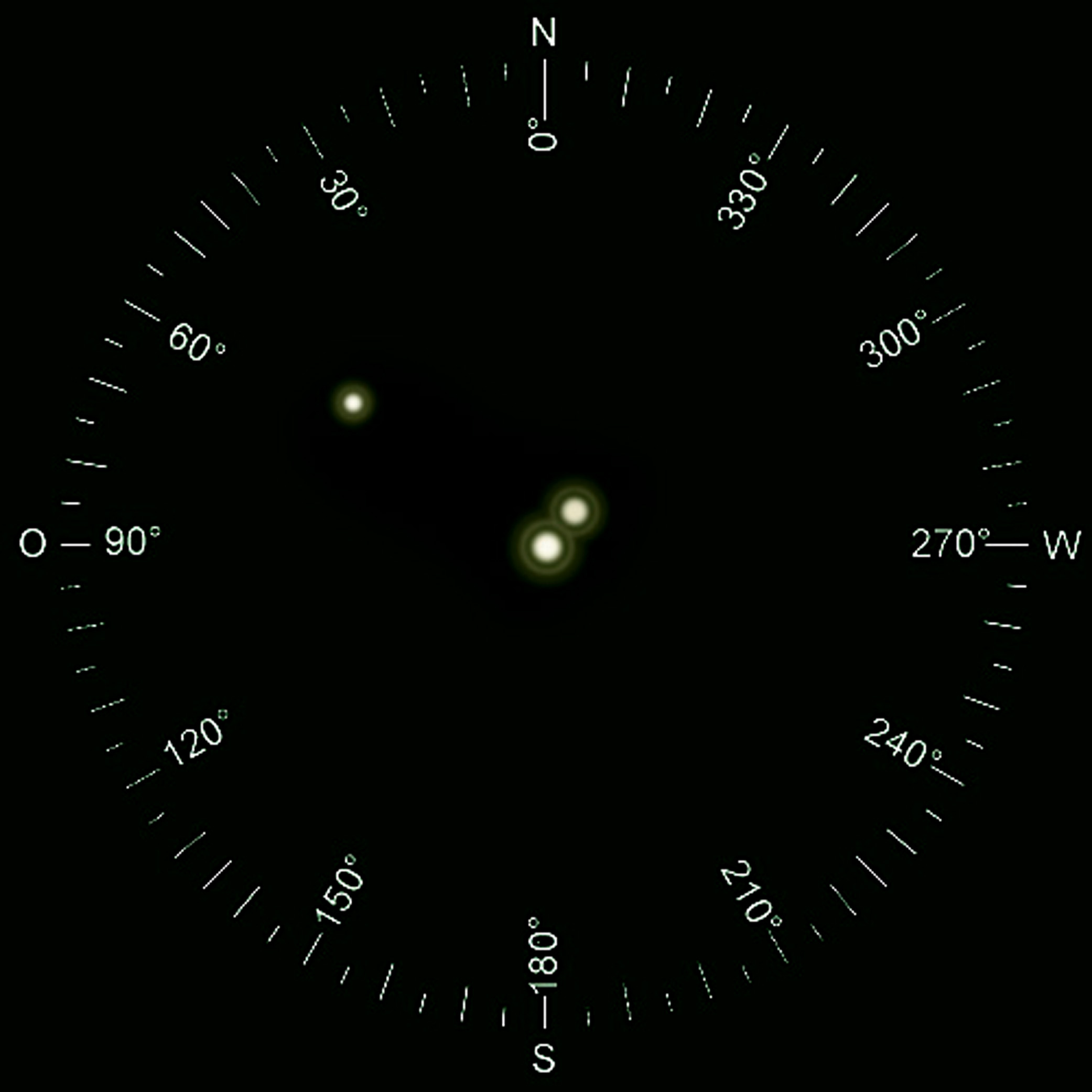
|
Sarah Gebauer
Germany |
150mm (83x) |
AB-C: bei 83x sind AB-C sauber getrennt, laut Atlas 2020 6,1'' Abstand, die Komponenten A und B mit 1,1'' lassen sich nicht trennen, viele schöne Feldsterne dabei |
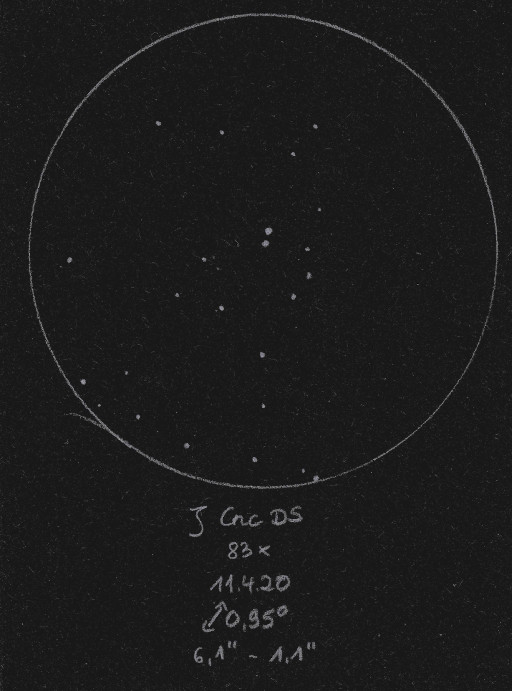
|
Christopher Hay
Seeheim (Germany) |
180mm (200x) |
AB: Hair-fine split. A and B both yellowish-white. C wide from AB, bluish-white, nice colour contrast to AB. |
|
Mark McCarthy
Fremont (California/USA) |
317mm (553x) |
Ca-Cb: not quite round, oval/olive shaped. It is the AB-C of STF 1196. |
|
Mark McCarthy
Fremont (California/USA) |
317mm (553x) |
AB: Triple, all near equal magnitude, yellow-white. AB ~0.8", hair split. |
|
Mark McCarthy
Fremont (California/USA) |
317mm (553x) |
AC: Triple, all near equal magnitude, yellow-white. AC ~6", wide split. |
|
Karsten Kopp
Köln (Germany) |
600mm (257x) |
AB: Die Komponenten AB-C bei etwas größerem Helligkeitsunterschied einfach zu trennen und auch schön anzusehen. Sterne erstrahlen weißlich gelb. Komponente AB war nicht zu trennen. |
|
|
Frederik Wanink
Itterbeck (Germany) |
254mm |
AB-C |

|
|
|
★★
|
STF1268, iota Cnc, 48 Cnc |
|
|
4m.1 |
6m.0 |
30.6" |
308° |
2021 |
Cnc |
08h46m41.82s / +28°45'35.60" |
Christopher Hay
Seeheim (Germany) |
10x42 |
Binoculars with internal stabilisation, handheld. Secondary a pinprick of light directly next to the overpowering primary. Slightly uncertain, but PA as seen confirmed afterwards in database. In stabilised 15x45 binoculars the pair is well split, primary white tending towards yellow, secondary substantially colder.
A physical double at a distance to us of 331 light years. |
|
Christopher Hay
Seeheim (Germany) |
15x60 |
On tripod. Well split. Primary very pale yellow, secondary very pale blue. A most striking pair. |
|
Robert Zebahl
Leipzig (Germany) |
70mm (22x) |
Striking, widely separated with noticeable difference in brightness. Moderate but beautiful color contrast: white-yellowish and grey-bluish. |
|
Christopher Hay
Seeheim (Germany) |
71mm (32x) |
Compact pair. Yellow, pale blue. Totally dominates 2.2° FOV. |
|
René Merting
Drachhausen (Germany) |
76mm (57x) |
bei 29x zeigt sich A strahlend gelb, bei Konzentration auf A zeigt bei einen schönen mintgrünen Farbton - B ist gut 1.5 Magnituden schwächer - bei 57x verstärkt sich der Farbeindruck bei der B-Komponente, aber eher, wenn ich den Stern flüchtig betrachte |
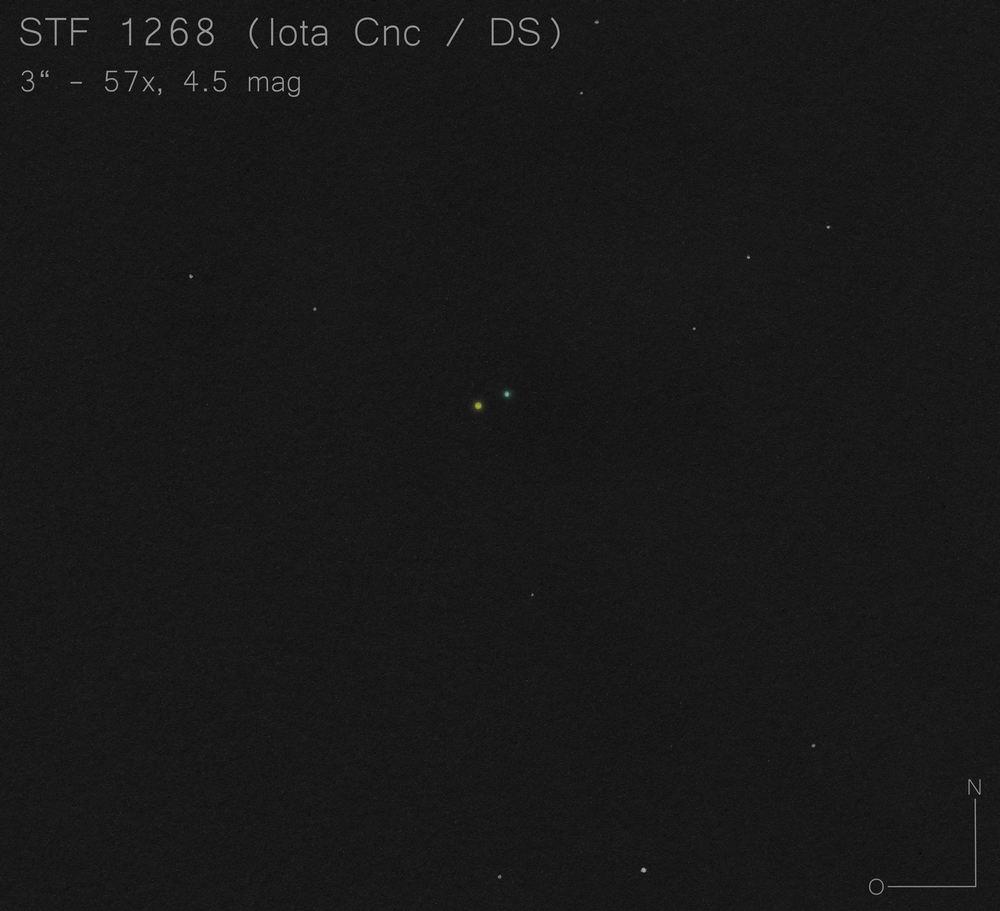
|
Axel Tute
Küssaberg (Germany) |
100mm (19x) |
13.04.2009: A: bluish, B: reddish |
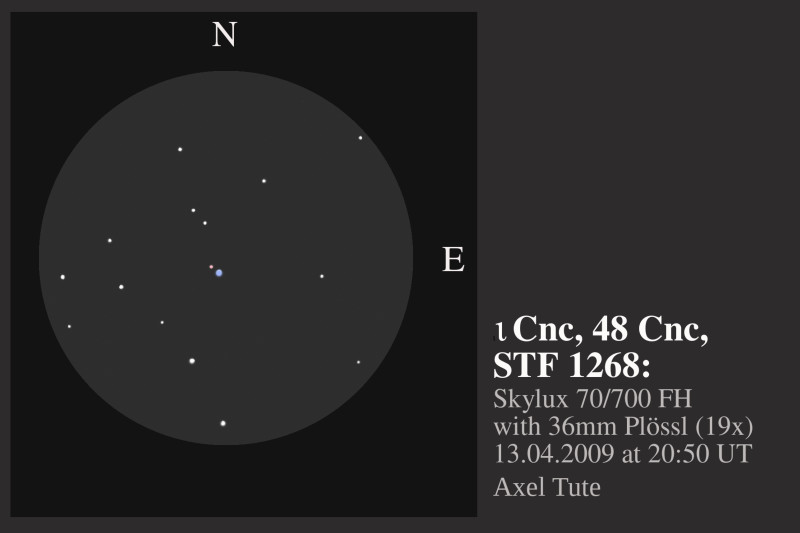
|
Sarah Gebauer
Germany |
100mm (20x) |
schon bei 20-fach schön getrennt mit einem schönen, warmen, gelben Farbton - bei 49-fach zeigt sich dann der Kontrast zu einem leicht hellgrau bis hellblauen Begleiter, während die Hauptkomponente sehr viel heller wird und warmgelb bleibt |

|
Robert Zebahl
Leipzig (Germany) |
102mm (28x) |
Grand sight! Pretty wide apart and unequal. A: mild orange, B: very nice light blue. |
|
Stefan Loibl
Rosenheim (Germany) |
102mm (164x) |
wide pair with nice colour contrast yellow/blue |
|
Uwe Pilz
Leipzig (Germany) |
105mm (28x) |
fahlblau und gelborange |

|
Uwe Pilz
Leipzig (Germany) |
105mm (144x) |
gelb-blaugrau |

|
Sarah Gebauer
Germany |
150mm (125x) |
bei 83x schon deutlich getrennt, der Farbkontrast ist gut zu sehen, er wird bei 125x noch stärker, ein zartes Blau und Gelb sind zu sehen |
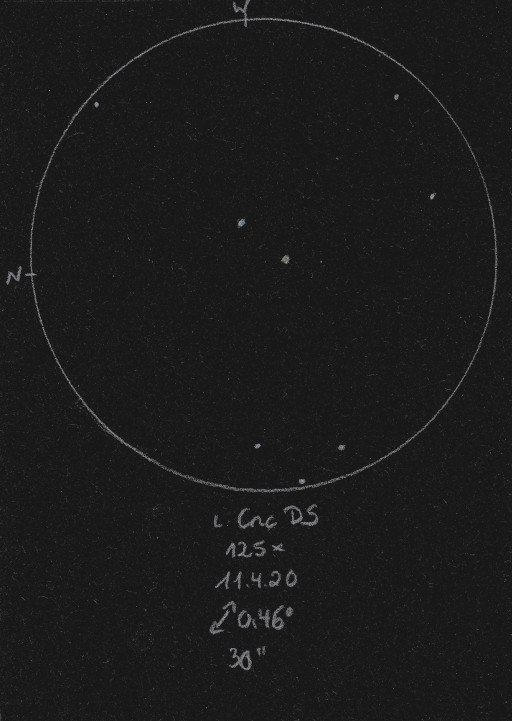
|
Mark McCarthy
Fremont (California/USA) |
317mm (553x) |
Iot Cnc: Pretty orange and pale blue, showpiece object. |
|
|
Frederik Wanink
Itterbeck (Germany) |
254mm |
|
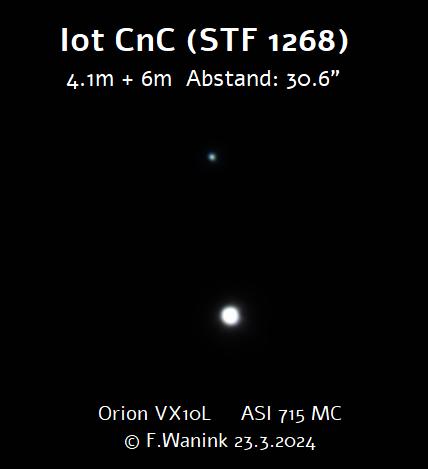
|
|
|
★★
|
STT200 |
|
|
6m.5 |
8m.6 |
1.2" |
336° |
2019 |
UMa |
09h24m55.67s / +51°34'26.10" |
Mark McCarthy
Fremont (California/USA) |
317mm (553x) |
Light orange A, B a deeper orange, maybe because it's 2-3x fainter. B resolves from within A's diffraction when seeing settles, ~1". Wow! |
|
|
Frederik Wanink
Itterbeck (Germany) |
254mm |
|

|
|
|
★
|
STT208, phi UMa |
|
|
5m.3 |
5m.4 |
0.5" |
317° |
2022 |
UMa |
09h52m06.36s / +54°03'51.40" |
|
|
Uwe Pilz
Leipzig (Germany) |
105mm (260x) |
länglich, schwierig |
|
Mark McCarthy
Fremont (California/USA) |
178mm (333x) |
Tough in poor seeing and transparency. Bright white A, significant delta magnitude, B's PA a little north of west. There are three stars in a wide triangle in the field, B points to base line. Physical with 104.6-year period, it will widen slightly and will reach apastron by 2040 |
|
Christopher Hay
Seeheim (Germany) |
180mm (290x) |
4 April 2021 (0.43" angular distance according to database at time of observation): At 200x seems oval. At 290x definite elongation and clear position angle. My personal record for double-star detection and PA perception with the seven-inch telescope. |
|
|
Frederik Wanink
Itterbeck (Germany) |
254mm |
|
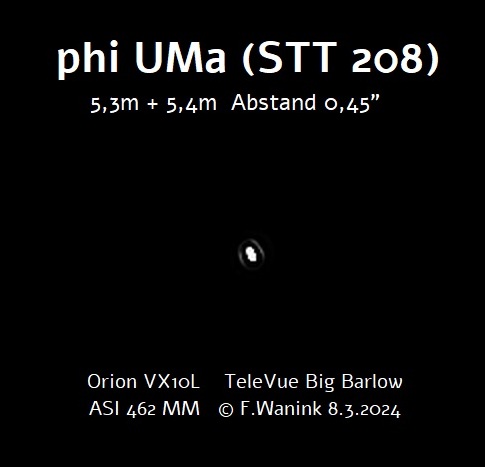
|
|
|
★
|
STF1399 |
|
|
7m.7 |
8m.4 |
30.2" |
176° |
2017 |
Leo |
09h57m02.21s / +19°45'44.60" |
Robert Zebahl
Leipzig (Germany) |
70mm (22x) |
Easy to split with nice distance and obviously unequal. A conspicuous group of fainter stars is nearby. Main component appeared in a warm-white, fainter somehow darker (partly bluish, partly slightly orange). |
|
Uwe Pilz
Leipzig (Germany) |
105mm (53x) |
wie ein Schlangenbiß |
|
Mark McCarthy
Fremont (California/USA) |
317mm (553x) |
Faint pair, tough find dense with stars. 1 delta magnitude, wide separation. |
|
|
Berthold Fuchs
Wiesbaden (Germany) |
130mm |
easy DS |

|
|
|
|
STF1419 |
|
|
8m.9 |
9m.9 |
4.5" |
225° |
2019 |
Leo |
10h17m02.94s / +10°06'51.70" |
Mark McCarthy
Fremont (California/USA) |
317mm (553x) |
Very faint pair, 1 delta mag, PA west ~4-5" |
|
Mark McCarthy
Fremont (California/USA) |
508mm (333x) |
Light yellow-white A and slightly blue B, wide ~4", ~1 delta mag |
|
|
Berthold Fuchs
Wiesbaden (Germany) |
130mm |
easy DS |
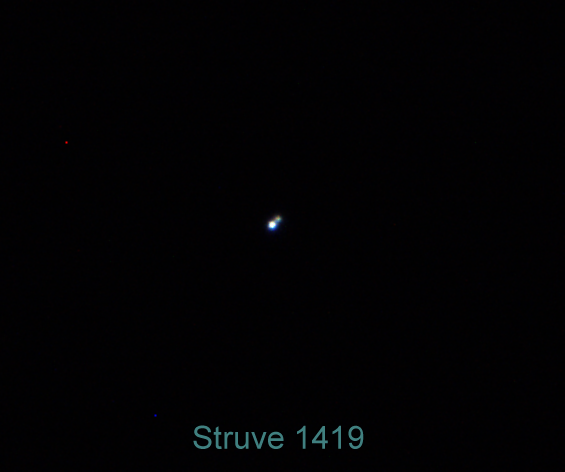
|
|
|
|
STF1421 |
|
|
8m.2 |
9m.1 |
4.5" |
331° |
2020 |
Leo |
10h18m05.54s / +27°31'27.90" |
René Merting
Drachhausen (Germany) |
100mm (64x) |
bei 64x ein schönes enges knapp getrenntes Pärchen - Komponente B im NW ist gut eine Größenklasse schwächer und wirkt dadurch dumpfer |
|
Axel Tute
Küssaberg (Germany) |
200mm (77x) |
07.04.2006: Separated at 77x magnification. |
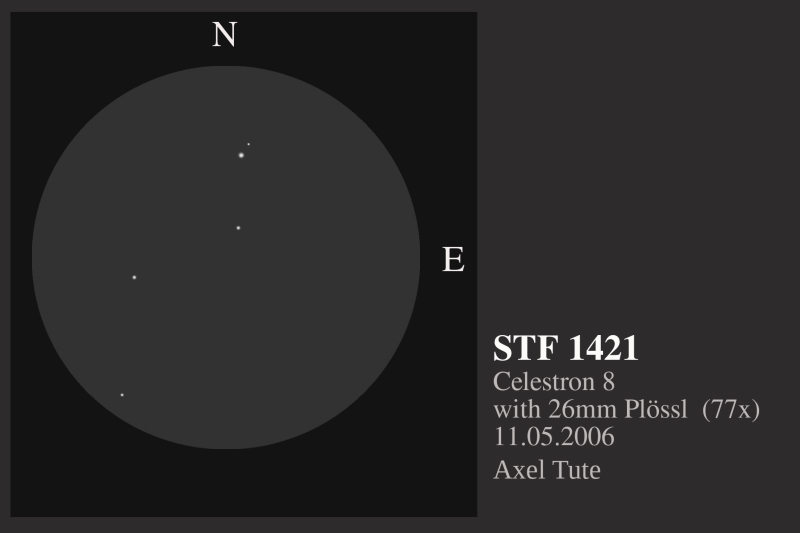
|
Mark McCarthy
Fremont (California/USA) |
317mm (553x) |
Not difficult, 1 delta mag, 5" or so. Bluish. |
|
Mark McCarthy
Fremont (California/USA) |
508mm (333x) |
Wide pair, >1 delta mag, white tinged with yellow, ~5" |
|
|
Berthold Fuchs
Wiesbaden (Germany) |
130mm |
difficult DS |

|
|
|
★★
|
STF1424, gamma Leo, 41 Leo, Algieba |
|
AB |
2m.4 |
3m.6 |
4.7" |
127° |
2020 |
Leo |
10h19m58.35s / +19°50'29.40" |
|
|
René Merting
Drachhausen (Germany) |
12x42 |
ein unheimlich schöner, rapsgelber Stern - an eine Trennung ist natürlich nicht zu denken, aber das Gelb hat mich so fasziniert |
|
Christopher Hay
Seeheim (Germany) |
20x60 |
Handheld in reclining chair, binoculars with internal stabilisation. 14 May 2022 (4.7" angular distance according to database): Pear-shaped. Strong orange-lemon yellow, a fruity affair. PA estimated 140° without prior knowledge, a good enough match, considering the low magnification, to the database figure of 127° ascertained post-observation. |
|
Christopher Hay
Seeheim (Germany) |
44x100 |
21 May 2022 (4.7" angular distance according to database): Hairfine split, slightly difficult due to bloated stars in these achromatic (not apochromatic) binoculars. Both components orange, with secondary going into yellow. Thin cloud moving through tightens up the star images and makes the split much clearer. Clearest shortly before clouds become so dense as to swallow the pair. |
|
Christopher Hay
Seeheim (Germany) |
36mm (50x) |
21 May 2022 (4.7" angular distance according to database): At 40x deeply notched, at 50x tenuously split, at 66x cleanly and clearly split. |
|
Robert Zebahl
Leipzig (Germany) |
55mm (38x) |
At 38x split, but very tight with noticeable difference in brightness. At 56x and higher beautiful view of both components, which seemed to have similar colors. |

|
Robert Zebahl
Leipzig (Germany) |
55mm (59x) |
Very nice unequal double. A appeared yellow-orange, B rather white-bluish. |
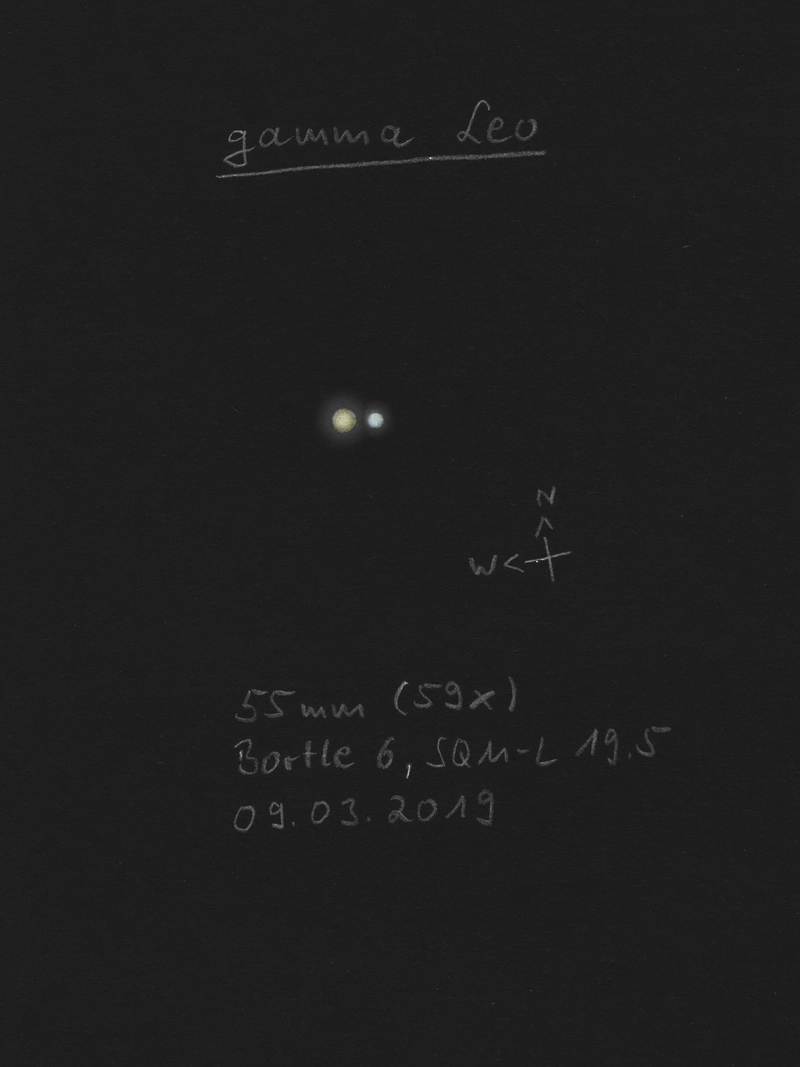
|
Christopher Hay
Seeheim (Germany) |
60mm (58x) |
At 25x Algieba is already very elongated. At 58x a sliver of dark between the components, with clear brightness difference. At 70x split becomes more stable, but view not so pleasing as at 58x. Both components display vivid orange. |
|
Axel Tute
Küssaberg (Germany) |
70mm (88x) |
07.03.2009: At 88x magnification the stars are still coherent. At 117x magnification they are clearly separated. A & B have a slightly yellow colour. |
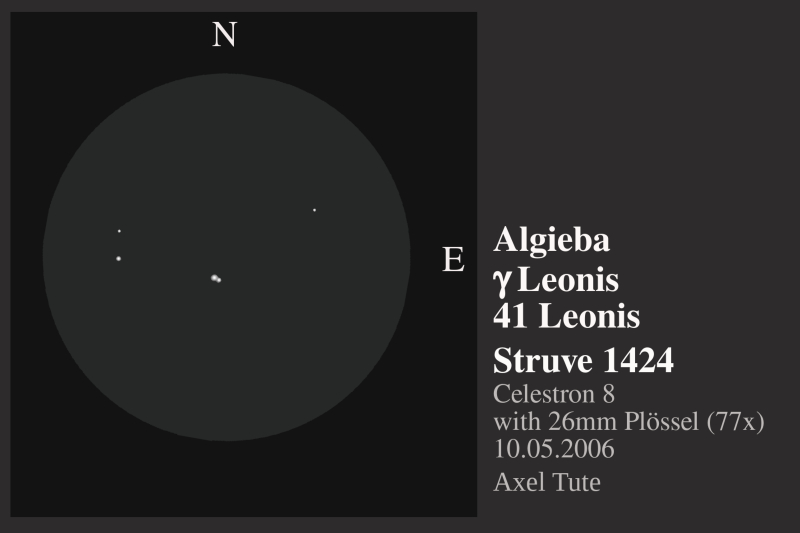
|
Robert Zebahl
Leipzig (Germany) |
70mm (100x) |
At 67x still a relatively close pair, but well separated with quite a clear difference in brightness. At 100x easy to separate and visible color difference: A yellowish to slightly orange, B white-yellowish. |
|
René Merting
Drachhausen (Germany) |
76mm (95x) |
Mondscheinnacht - bei 57x zwei goldgelbe Murmeln, die dicht aneinander kleben, die südöstliche, schwächere Murmel strahlt etwas tiefgelber - bei 95x dann zeigen sich beide Sterne mit unregelmäßig verlaufenden Beugungsringen und einem fetten gemeinsamen Halo - sie sind knapp getrennt erkennbar - B ist vielleicht eine Größenklasse schwächer - sehenswert |
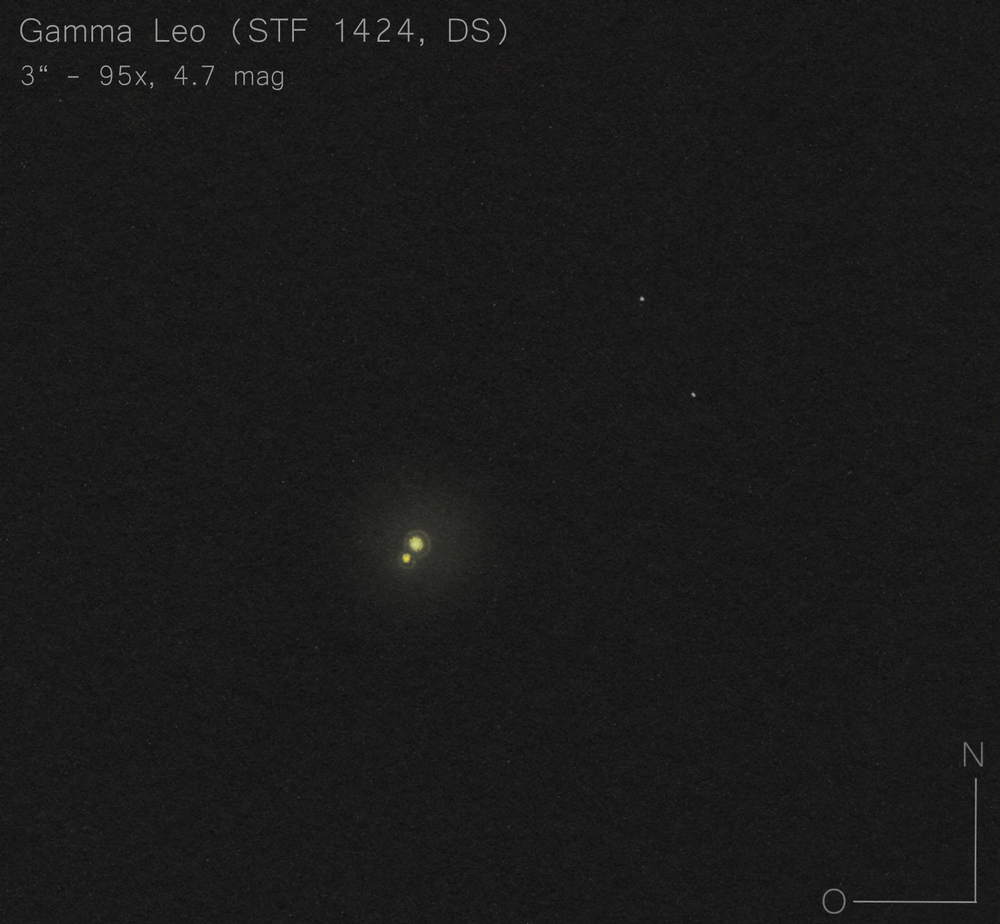
|
Sarah Gebauer
Germany |
100mm (80x) |
bei 80-fach fein, aber schön getrennt - Komponente A funkelt in einem warmen Goldgelb, die feinere und nur leicht schwächere Komponente B dicht östlich daneben zeigt einen ähnlichen Farbton, entsprechend ein bisschen weniger intensiv |
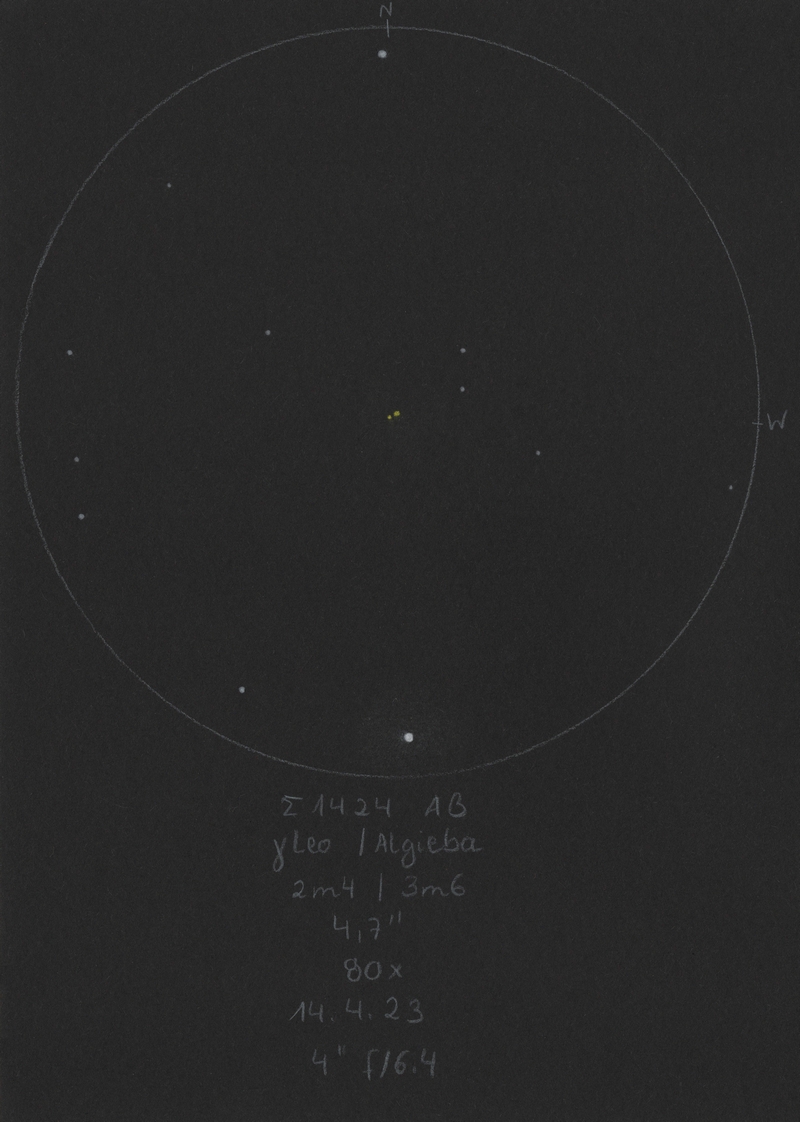
|
Robert Zebahl
Leipzig (Germany) |
102mm (125x) |
Very nicely separated with wonderful contrast in brightness and color. Primary component slightly orange, companion yellowish. |
|
Stefan Loibl
Rosenheim (Germany) |
102mm (164x) |
very bright double star, slight colour contrast |
|
Uwe Pilz
Leipzig (Germany) |
105mm (120x) |
schon bei 37x sehenswert; trennbar bei 55x; orange-blauweiß |
|
Robert Zebahl
Leipzig (Germany) |
120mm (66x) |
At 48x easily seen as double star. It appeared as '8'. At 66x pretty tight with visible difference in brightness. |
|
Winfried Kräling
Marburg (Germany) |
127mm (250x) |
08.04.2018: merklicher Helligkeitsunterschied, A = gelb-orange, B = gelb-orange |

|
Sarah Gebauer
Germany |
150mm (83x) |
bei 83x sauber getrennt, ein leichter Farbunterschied (Weiß und helles Gelb) sichtbar |

|
Axel Tute
Küssaberg (Germany) |
200mm (77x) |
11.05.2006: At 77x you can clearly see that it is a double star. An 8 but without a gap. At 167x a clear gap can be seen. A is slightly bluish. |
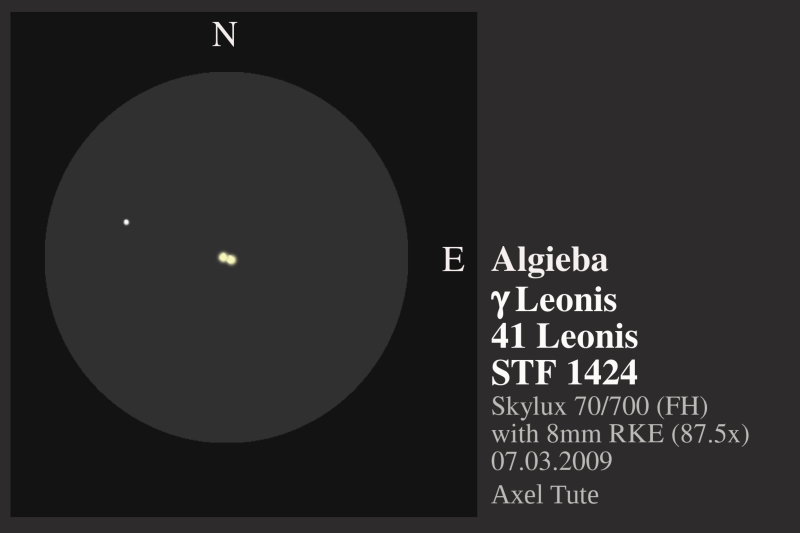
|
Mark McCarthy
Fremont (California/USA) |
317mm (277x) |
Algieba: Bright yellow and yellow-orange pair, 1 delta mag, 4-6" |
|
René Merting
Drachhausen (Germany) |
320mm (144x) |
bei 72x ist ein Stäbchen erkennbar - bei 144x zeigen sich zwei gelbe Murmeln, knapp getrennt |
|
René Merting
Drachhausen (Germany) |
320mm (240x) |
bei 240x sehe ich zwei ordentlich getrennte Sterne (naja, nicht wirklich Sterne, sondern wild zappelnde Glitzerbällchen) - Komponente A strahlt in einem zarten Gelb, B ist weiß - zurück auf 144x sehe ich nur ein Stäbchen mit leichter Einschnürung, so wild tanzen die Sterne |
|
Mark McCarthy
Fremont (California/USA) |
508mm (333x) |
Algieba. Very bright, A is yellow-orange and B is a blazing white orange, like a fire |
|
|
Frederik Wanink
Itterbeck (Germany) |
254mm |
|

|
|
|
|
STF1442 |
|
|
8m.2 |
8m.5 |
13.3" |
157° |
2017 |
Leo |
10h31m58.95s / +22°02'22.00" |
René Merting
Drachhausen (Germany) |
18x70 |
ein sehr eng stehendes, schwaches Paar, mit etwas Konzentration gelingt die Trennung - Komponente B im Süden ist minimal schwächer |
|
Robert Zebahl
Leipzig (Germany) |
70mm (22x) |
2021-04-21: At 22x outstanding with similar bright components and moderate separation, slightly different in color. Assignment of colors was difficult. At 44x improved color impression: dark orange & ice blue. |
|
René Merting
Drachhausen (Germany) |
100mm (20x) |
bei 32x schön anzusehen - ein eng stehendes Pärchen mit einem kaum spürbaren Helligkeitsunterschied - leichter Farbkontrast, der nicht wirklich greifbar ist - zurück auf 20x sind beide Sterne auch noch knapp getrennt erkennbar |
|
Axel Tute
Küssaberg (Germany) |
200mm (167x) |
07.04.2006: No separation at 77x magnification. Only at 167x does the separation succeed. |
|
Mark McCarthy
Fremont (California/USA) |
508mm (333x) |
Near equal white with a hint of yellow, wide. [not physical] |
|
|
Berthold Fuchs
Wiesbaden (Germany) |
130mm |
difficult DS |

|
|
|
|
STF1443 |
|
|
9m.9 |
10m.0 |
5.3" |
160° |
2018 |
LMi |
10h33m17.07s / +37°40'25.00" |
Robert Zebahl
Leipzig (Germany) |
120mm (50x) |
At 50x split with little distance. At 75x clearly split with small difference in brightness. |
|
Mark McCarthy
Fremont (California/USA) |
317mm (553x) |
White, near equal, 3-4" |
|
Mark McCarthy
Fremont (California/USA) |
508mm (333x) |
Wide pair, white, ~1 delta |
|
Karsten Kopp
Köln (Germany) |
600mm (180x) |
Gut zu trennender Doppelstern mit identischer Helligkeit. Beide Sterne leuchten weißlich. |
|
|
Berthold Fuchs
Wiesbaden (Germany) |
130mm |
easy DS |
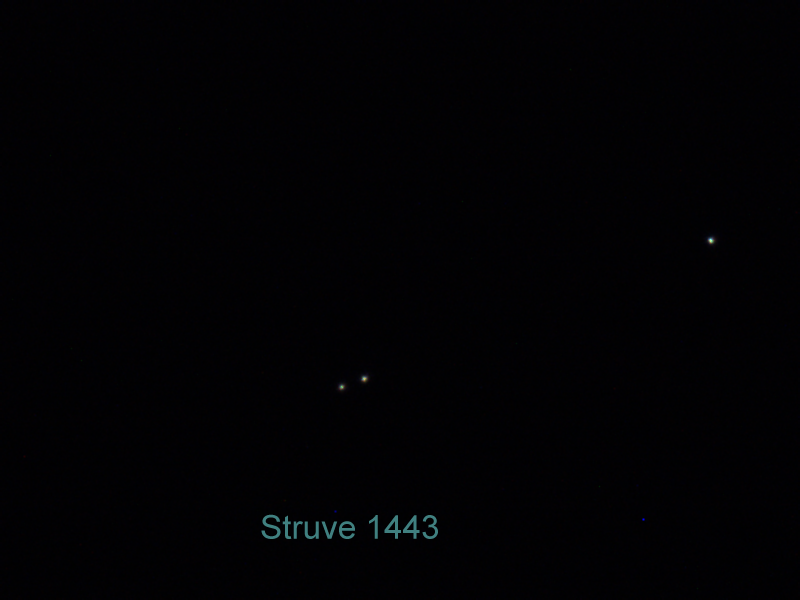
|
|
|
★★
|
STT229 |
|
|
7m.6 |
7m.9 |
0.7" |
256° |
2020 |
UMa |
10h48m02.55s / +41°06'35.80" |
|
|
Mark McCarthy
Fremont (California/USA) |
317mm (553x) |
Just wider than a thin hair split of equal white stars, ~8th mag. 0.63"! in 40 years it will be 0.2" |
|
|
Frederik Wanink
Itterbeck (Germany) |
254mm |
|

|
|
|
★
|
STF1487, 54 Leo |
|
|
4m.5 |
6m.3 |
6.6" |
112° |
2020 |
Leo |
10h55m36.80s / +24°44'59.00" |
Robert Zebahl
Leipzig (Germany) |
55mm (27x) |
At 27x split, but very tight with noticeable difference in brightness. At 71x easy to separate. No visible color difference. |
|
Robert Zebahl
Leipzig (Germany) |
70mm (67x) |
2021-04-13: At 67x beautifully separated with clearly visible difference in brightness. Very attractive is the subtle color difference: light yellow & light blue. At 133x the color of the companion is a bit more pale: grey-blue. The primary component still shines in a beautiful light yellow. |
|
Axel Tute
Küssaberg (Germany) |
70mm (88x) |
07.03.2009: Separated at 88x magnification. A is slightly bluish. B is white. |
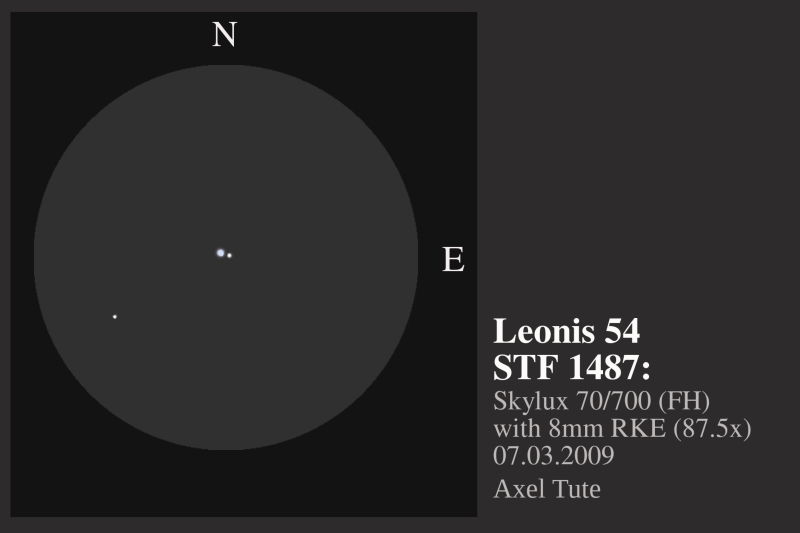
|
René Merting
Drachhausen (Germany) |
76mm (57x) |
Mondscheinnacht - bei 57x knapp getrennt - Komponente B steht im Südosten - A wirkt weißgelblich bis hellgelb, B ist mindestens 1.5 mag schwächer und wirkt stahlgrau, dadurch ein schöner Farbkontrast |
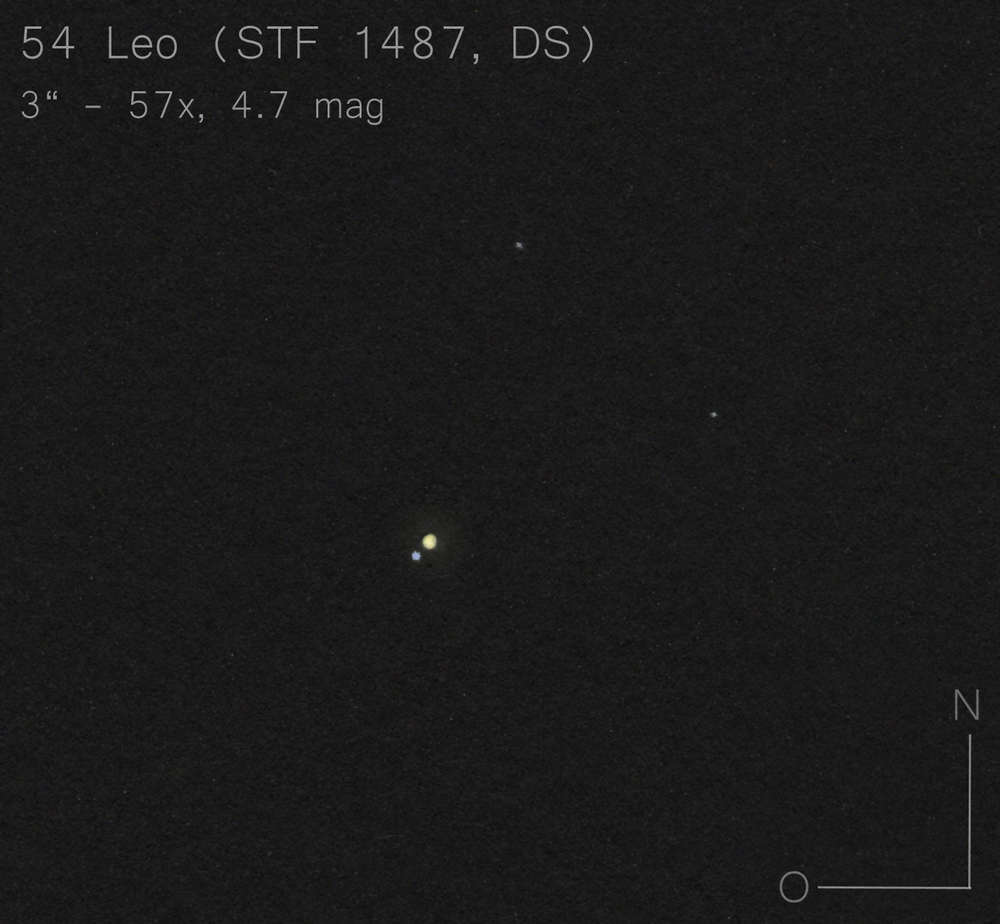
|
Sarah Gebauer
Germany |
100mm (80x) |
bei 49-fach haarscharf getrennt, die Hauptkomponente zeigt ein sehr klares, reines Weiß, der Begleiter als sehr dünner Punkt südöstlich davon wirkt etwas wärmer - bei 80-fach erscheint die Trennung geringfügig weiter, die Hauptkomponente hat nun einen schön warmgelben Farbhauch, der Begleiter wirkt dagegen kühl-weißlicher |
|
Winfried Kräling
Marburg (Germany) |
127mm (250x) |
13.03.2017: Hauptkomponente gelblich, Begleiter bläulich, deutlicher Helligkeitsunterschied. Ebenfalls bei V=60x getrennt. |
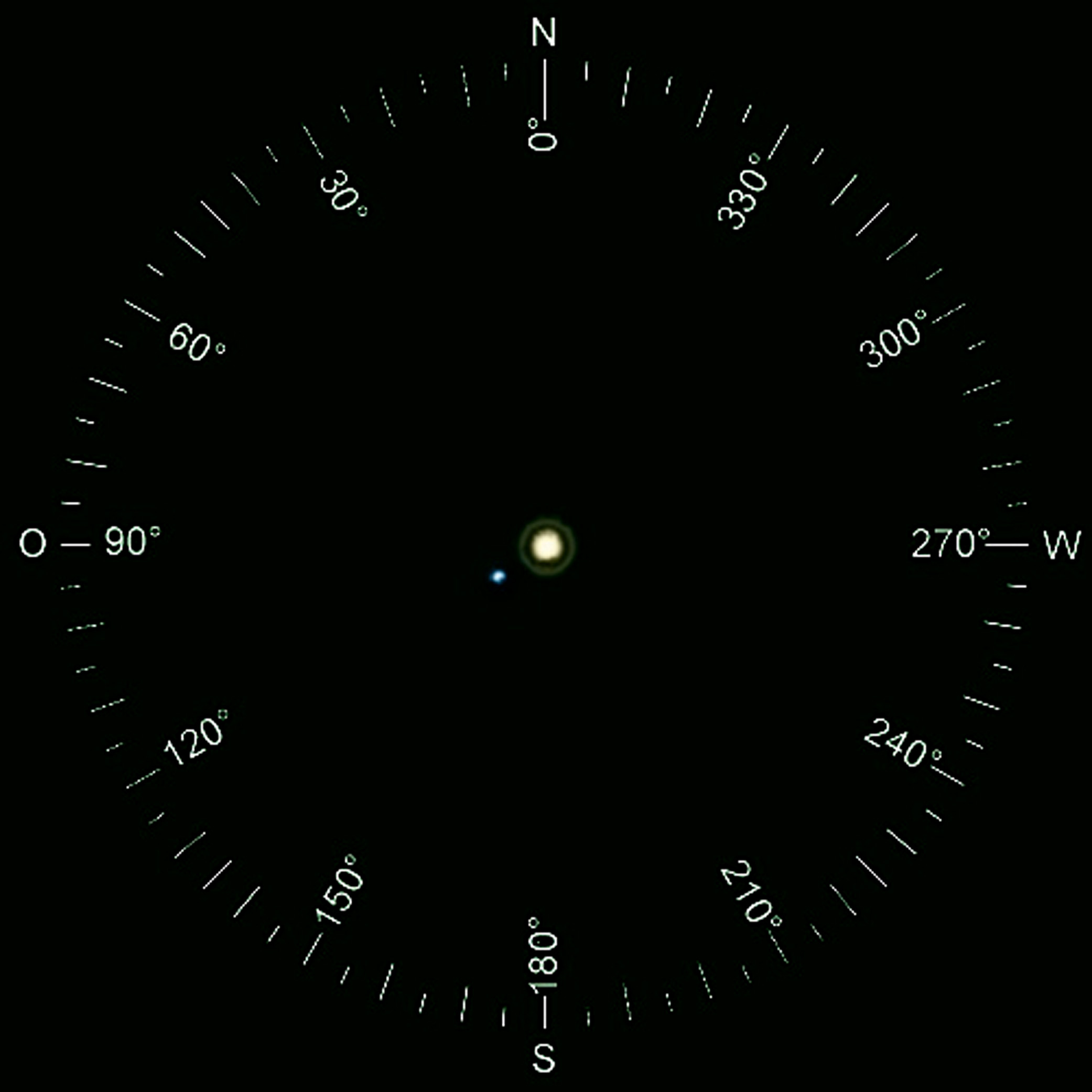
|
Axel Tute
Küssaberg (Germany) |
200mm (77x) |
07.04.2006: Separated at 77x magnification. But better at 167x. |
|
Mark McCarthy
Fremont (California/USA) |
317mm (277x) |
Bright white pair (4.5, 6.3) wide sep (6") |
|
Mark McCarthy
Fremont (California/USA) |
508mm (333x) |
54 Leo. Brilliant pair, light white-yellow stars, ~2 delta mag, wide |
|
|
Frederik Wanink
Itterbeck (Germany) |
254mm |
|
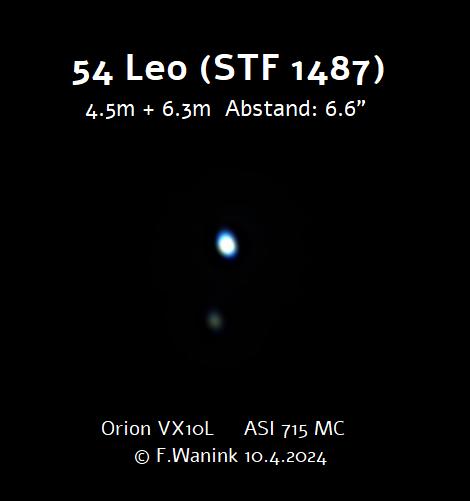
|
|
|
★★
|
HO378 |
|
AB |
8m.2 |
9m.1 |
1.1" |
234° |
2020 |
UMa |
11h04m57.29s / +38°24'38.20" |
|
|
Mark McCarthy
Fremont (California/USA) |
317mm (553x) |
In a pretty cluster in the finder (~ 12 stars loose and poor, wide magnitude range, triangle shape). Pair is a fine split 1 delta mag 1", ice blue A and slightly yellow B. |
|
|
Frederik Wanink
Itterbeck (Germany) |
254mm |
|
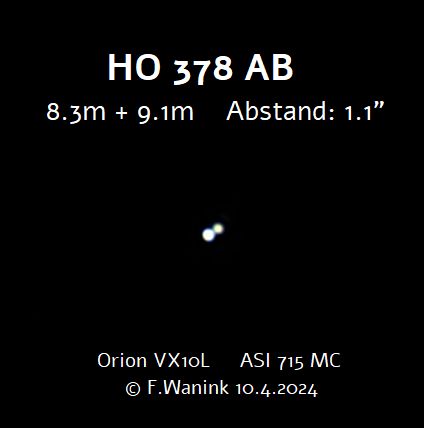
|
|
|
|
STF1521 |
|
|
7m.7 |
8m.1 |
3.7" |
97° |
2019 |
Leo |
11h15m20.95s / +27°34'15.60" |
Robert Zebahl
Leipzig (Germany) |
70mm (67x) |
At 44x still very close, finely separated pair with visible difference in brightness, rather faint. At 67x nicely separated, at 100x very easy. Colors were not clearly visible. |
|
René Merting
Drachhausen (Germany) |
100mm (107x) |
bei 64x sehe ich eine Ameise, die Komponenten A und B etwas gleich hell, noch nicht getrennt - bei 107x sind beide etwas mehr als knapp getrennt zu erkennen, B im Osten ist etwas schwächer |
|
Mark McCarthy
Fremont (California/USA) |
178mm (205x) |
White stars, 1 delta, well split |
|
|
Berthold Fuchs
Wiesbaden (Germany) |
130mm |
close DS |

|
|
|
★★
|
STF1523, xi UMa, 53 UMa, Alula Australis |
|
AB |
4m.3 |
4m.8 |
2.3" |
152° |
2020 |
UMa |
11h18m10.90s / +31°31'45.00" |
|
|
Robert Zebahl
Leipzig (Germany) |
55mm (83x) |
2019-02-09: Already seen as '8' at 83x. At 125x the overlapping of both Airy disks was visible, but also a slight difference in brightness. |

|
Robert Zebahl
Leipzig (Germany) |
70mm (100x) |
2018-02-18: Very close together with similar brightness. At first glance seen as an '8', looking closer I partly split both components. Similar view also at 128x. |
|
Robert Zebahl
Leipzig (Germany) |
70mm (133x) |
2020-03-15: Splendid sight! Beautifully separated with almost touching diffraction disks. The rather small difference in brightness was well visible. The diffraction rings of both components coalesced. |
|
Mark McCarthy
Fremont (California/USA) |
80mm (150x) |
Alula australis. Slight magnitude difference, hairline split, light yellow A and darker yellow B. |
|
Sarah Gebauer
Germany |
100mm (136x) |
zwei gleich helle Murmelchen ganz dicht aneinander, sehr unruhiges Bild, beide Sterne strahlen warmweiß, ins Hellgoldene gehend, ohne Farbkontrast |
|
Robert Zebahl
Leipzig (Germany) |
102mm (160x) |
2020-03-16: Awesome! Bright with lovely, subtle diffraction rings. The distance between both components is a smaller than the diameter of the diffraction disk of the fainter component. |
|
Uwe Pilz
Leipzig (Germany) |
105mm (288x) |
Gemessen: 162° |
|
Robert Zebahl
Leipzig (Germany) |
120mm (168x) |
2018-02-14: Well split with slight difference in brightness. |
|
Robert Zebahl
Leipzig (Germany) |
152mm (129x) |
2019-02-06: Well split with visible difference in brightness. The colors of both components appeared equal. |
|
Mark McCarthy
Fremont (California/USA) |
508mm (333x) |
Alula Australis. Short period. Pretty orange-yellow stars, ~half delta mag, ~2" separation |
|
|
Frederik Wanink
Itterbeck (Germany) |
254mm |
|
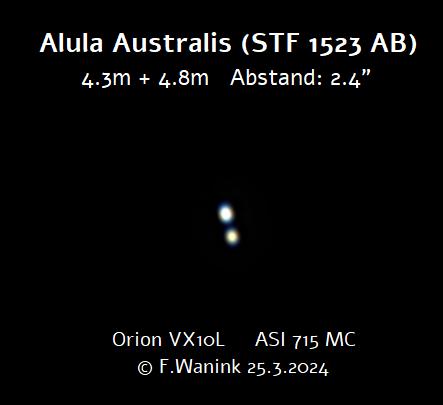
|
|
|
|
STF1568 |
|
AB |
10m.4 |
10m.5 |
9.2" |
43° |
2016 |
Vir |
11h43m16.61s / +00°45'40.10" |
Mark McCarthy
Fremont (California/USA) |
178mm (205x) |
White, very slight magnitude difference, wide. Physical |
|
|
Berthold Fuchs
Wiesbaden (Germany) |
130mm |
easy DS |
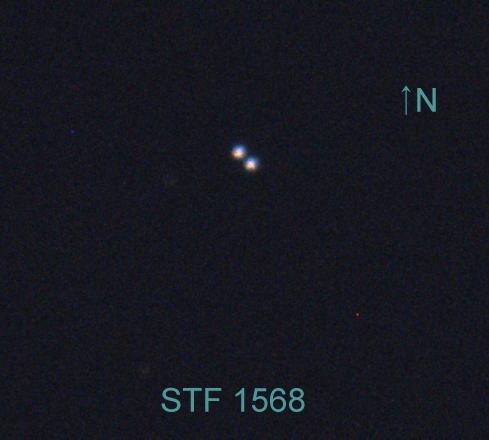
|
|
|
★
|
STF1575 |
|
|
7m.4 |
7m.9 |
30.5" |
210° |
2021 |
Vir |
11h51m57.57s / +08°49'48.00" |
Robert Zebahl
Leipzig (Germany) |
16x70 |
2021-03-02: Very nice view! Very striking in the field together with xi Vir, 4 & 6 Vir. Fairly bright with moderate separation. Slightly orange & grey-bluish. |
|
René Merting
Drachhausen (Germany) |
18x70 |
ein sehr komfortabel getrenntes Sternpaar - B im Südwesten ist eine halbe Größenklasse schwächer - A weißorange, B weißbläulich - ein ansehnlicher FG-Stern |
|
René Merting
Drachhausen (Germany) |
100mm (32x) |
bei 32x ein schön getrenntes Sternpaar mit zwei ähnlich hellen Sternen - Komponente B im SW ist maximal eine halbe Größenklasse schwächer - deutlich wahrnehmbarer Farbkontrast, A ist weißgelb, B dagegen wirkt blaugrau |
|
Sarah Gebauer
Germany |
100mm (49x) |
schon bei 20-fach getrennt als zwei dünne Lichtpünktchen zu sehen - die nordöstliche A-Komponente hat einen warmorange Farbton, der südwestliche wirkt etwas farbloser, schwächer und matter - bei 49-fach ordentlich getrennt, A strahlt nun etwas intensiver orangegold, B wirkt nun bräunlich |
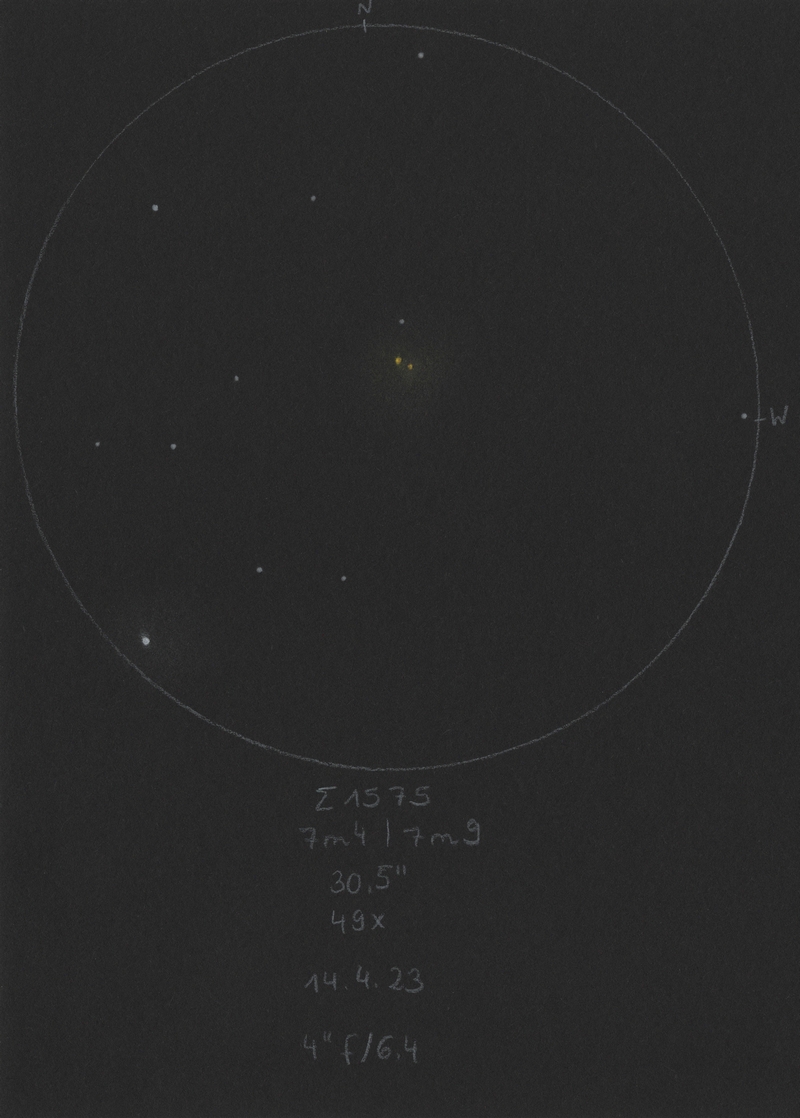
|
René Merting
Drachhausen (Germany) |
320mm (72x) |
bei 72x zwei gleichhelle Sterne, die weit getrennt auseinander stehen - A im NO ist leicht gelblich, B mit einem leichten Schlag ins Blaue, sprich weißblau - dadurch zarter Farbkontrast - beide Sterne sind schön hell und auffällig im Umfeld |
|
|
Berthold Fuchs
Wiesbaden (Germany) |
130mm |
easy DS |

|
|
|
★
|
STF1579, 65 UMa |
|
AB-C |
6m.7 |
8m.3 |
3.7" |
44° |
2021 |
UMa |
11h55m05.74s / +46°28'36.60" |
|
|
|
|
AB-D |
6m.7 |
7m.0 |
62.9" |
114° |
2021 |
|
|
Christopher Hay
Seeheim (Germany) |
7x45 |
AB-D: Handheld. A bit difficult due to hand tremor, but clearly split with definite delta-mag. Nice in 8.6° FOV together with 67 UMa (Forgeren), which for its part has a bluish companion at a separation of about 300".
With 15x45 stabilised binoculars AB-D is an easy wide split, AB warmer, D colder in hue.
A physical pair at a distance to us of 691 light years. |
|
Robert Zebahl
Leipzig (Germany) |
8x40 |
AB-D: 2020-04-05: Immediately conspicuous in the field. Medium bright double star with slightly uneven components. Western component AB appeared slightly orange, component D tended to be bluish. |
|
Robert Zebahl
Leipzig (Germany) |
55mm (27x) |
AB-D: Easy to separate with large distance and very small difference in brightness. The D component showed a bluish tint, the lighter one (AB) a slightly yellowish tint. At higher magnification also the faint C component is visible. |
|
Robert Zebahl
Leipzig (Germany) |
55mm (83x) |
2019-02-09: AB, C & D easy to split, but the faint C component only appeared as a tiny star. To the south there is the brighter D component. |
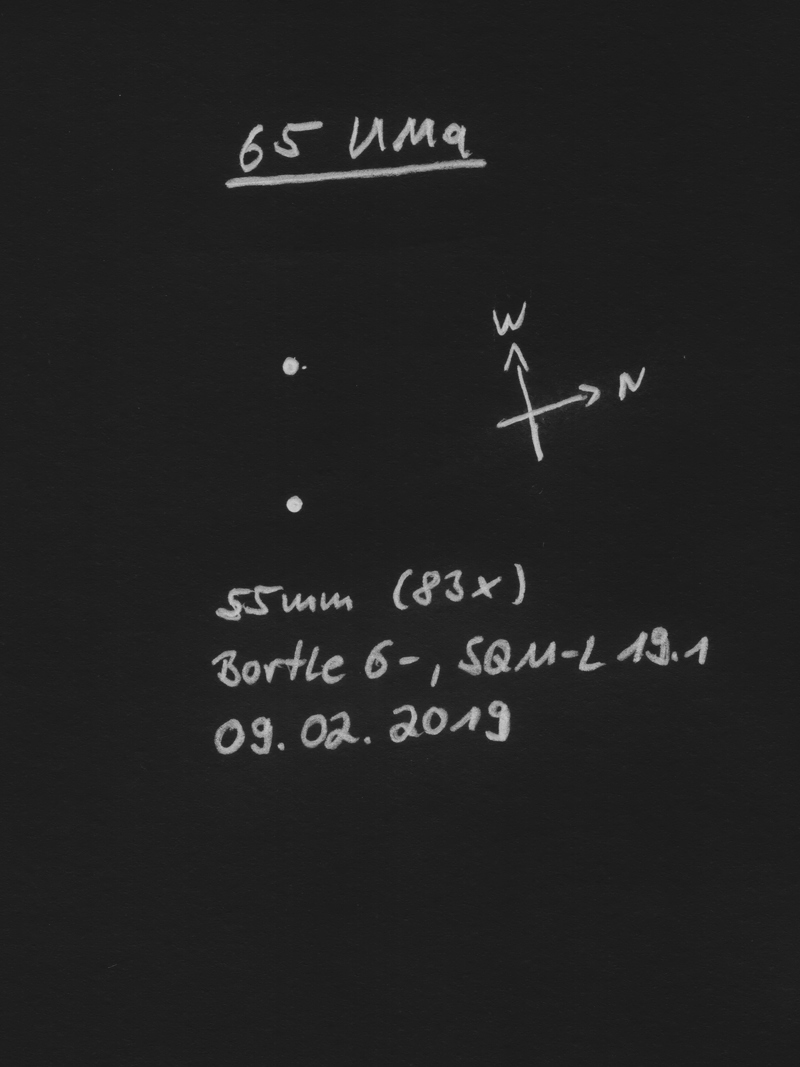
|
|
Robert Zebahl
Leipzig (Germany) |
|
|
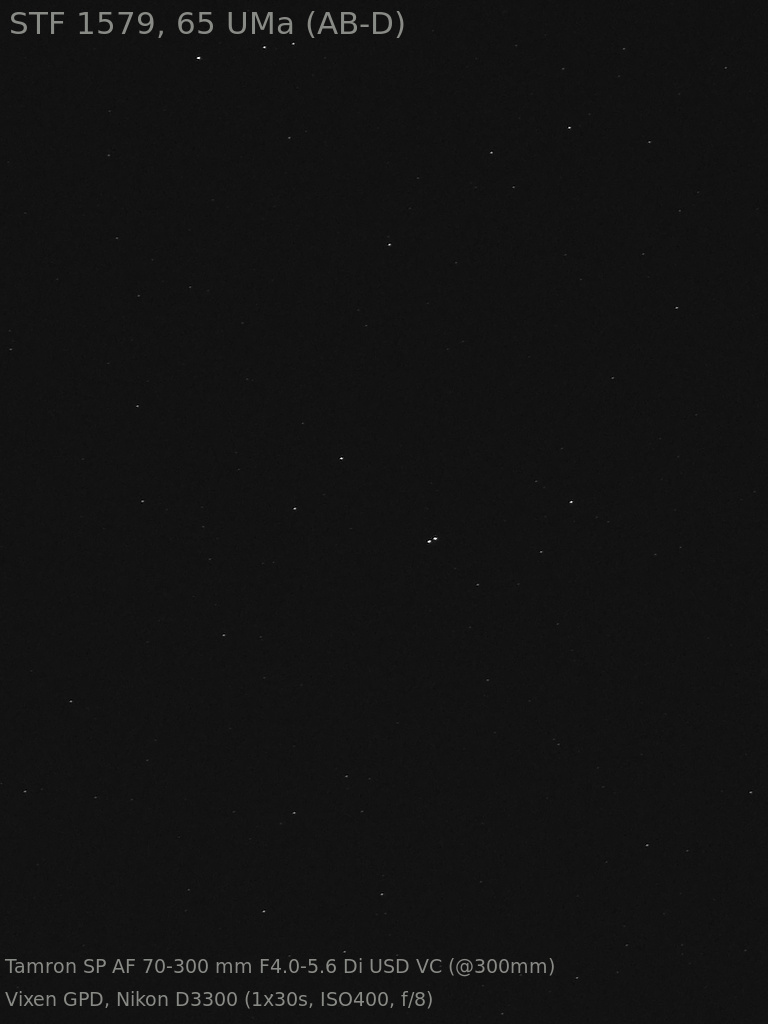
|
|
|
|
67 UMa |
FOR1 |
AB |
5m.2 |
6m.7 |
274.4" |
62° |
2015 |
UMa |
12h02m06.80s / +43°02'44.30" |
|
|
|
ARN5 |
AC |
5m.2 |
8m.5 |
375.9" |
25° |
2015 |
|
|
|
|
|
FOR1 |
AD |
5m.2 |
8m.9 |
363.2" |
268° |
2015 |
|
|
Robert Zebahl
Leipzig (Germany) |
8x40 |
2020-04-05: The pair AB stands out immediately and shows itself in beautiful colors: A white-yellowish, B slightly orange. Almost at right angles to pair AB component C is visible as a faint star at a slightly smaller distance. I did not pay attention to the even fainter component D. |
|
Robert Zebahl
Leipzig (Germany) |
55mm (27x) |
2020-04-05: Components A, B and C easily visible with decreasing brightness. I did not consider component D. A: white-yellowish, B: pale orange. I liked the view in the 8x40 binoculars better. |
|
|
Robert Zebahl
Leipzig (Germany) |
|
|

|
|
|
★
|
STF1603 |
|
AB |
7m.8 |
8m.3 |
22.2" |
83° |
2021 |
UMa |
12h08m07.07s / +55°27'50.70" |
Robert Zebahl
Leipzig (Germany) |
16x70 |
2022-03-27: Medium bright at moderate separation and slight difference in brightness. Slight color difference: yellowish & slightly bluish. |
|
René Merting
Drachhausen (Germany) |
18x70 |
ein Sternpaar, das zu gefallen weiß, etwas mehr als knapp getrennt - B im Nordosten wirkt eine viertel Größenklasse schwächer - leichter Farbunterschied, wobei B Zartorange, Braunweiß, Ockergrau oder so wirkt, naja |
|
Robert Zebahl
Leipzig (Germany) |
70mm (22x) |
2020-04-07: At 22x quite apparent double star in rather poor surrounding. Nice separation with little difference in brightness. Primary component appeared slightly orange, companion grey-bluish. At 44x similar view in color appearance. |
|
Sarah Gebauer
Germany |
100mm (45x) |
schwach, sauber getrennt, nahezu gleich hell, die westliche Komponente ist minimal heller |
|
René Merting
Drachhausen (Germany) |
320mm (45x) |
bei 45x gut getrennt - Komponente B im Osten wirkt grauorange gegen die weiß strahlende Komponente A - Helligkeitsunterschied eine halbe Größenklasse - ein schön isoliert stehendes Sternpaar |
|
|
Frederik Wanink
Itterbeck (Germany) |
254mm |
|

|
|
|
|
STF1618 |
|
|
9m.5 |
9m.5 |
26.0" |
245° |
2016 |
Vir |
12h15m03.46s / +09°59'27.10" |
Berthold Fuchs
Wiesbaden (Germany) |
130mm |
easy DS |
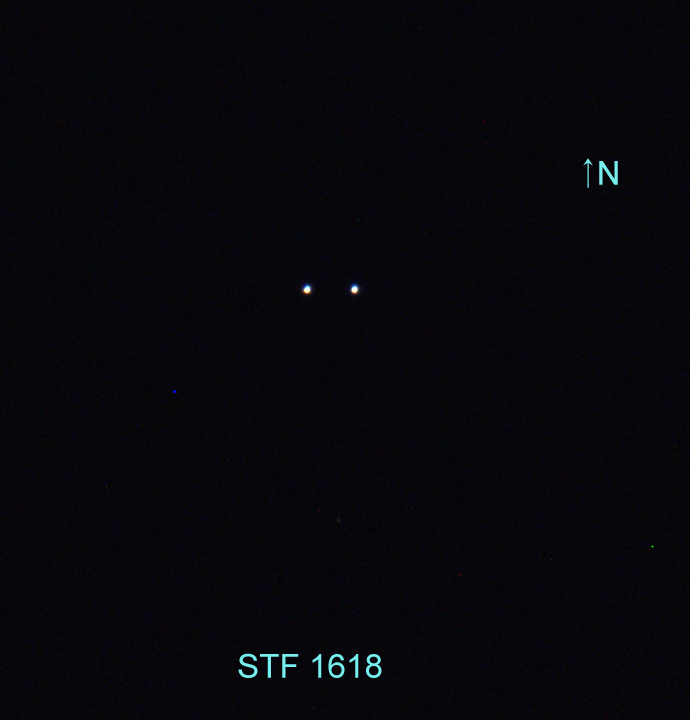
|
|
|
|
STF1628 |
|
AB |
9m.5 |
10m.1 |
9.5" |
239° |
2015 |
Vir |
12h18m42.90s / +11°47'46.30" |
|
|
|
|
AC |
9m.5 |
11m.8 |
45.2" |
344° |
2015 |
|
|
Berthold Fuchs
Wiesbaden (Germany) |
130mm |
easy DS |

|
|
|
★★
|
STF1636, 17 Vir |
|
|
6m.5 |
9m.3 |
21.0" |
338° |
2017 |
Vir |
12h22m32.14s / +05°18'20.10" |
René Merting
Drachhausen (Germany) |
15x56 |
meist klebt B noch nordwestlich an A, in ruhigen Momenten kann ich beide Komponenten knapp getrennt erkennen - B ist eine Miniperle ggü. A |
|
René Merting
Drachhausen (Germany) |
18x70 |
A und B sind knapp getrennt erkennbar - B sitzt im NW von A - großer, nicht abschätzbarer Helligkeitsunterschied - nett anzusehen, wenn man B erst einmal entdeckt hat |
|
Sarah Gebauer
Germany |
100mm (21x) |
bei 20-fach ganz knapp getrennt mit einem deutlichen Helligkeitsunterschied - für einen Farbeindruck reicht die Vergrößerung nicht aus - bei 49-fach färbt sich die Hauptkomponente sehr schön roségold - der deutlich schwächere Begleiter wirkt nun grau-bräunlich - das Sternumfeld ist dank lose verstreuter Sterne in einem großen Bogen von Norden über Osten nach Süden um den Doppelstern herum besonders schön |
|
Mark McCarthy
Fremont (California/USA) |
317mm (340x) |
17 Virginis, widely separated, large magnitude difference, with a yellow-white A and a ruddy / brownish B |
|
|
Berthold Fuchs
Wiesbaden (Germany) |
130mm |
easy DS |
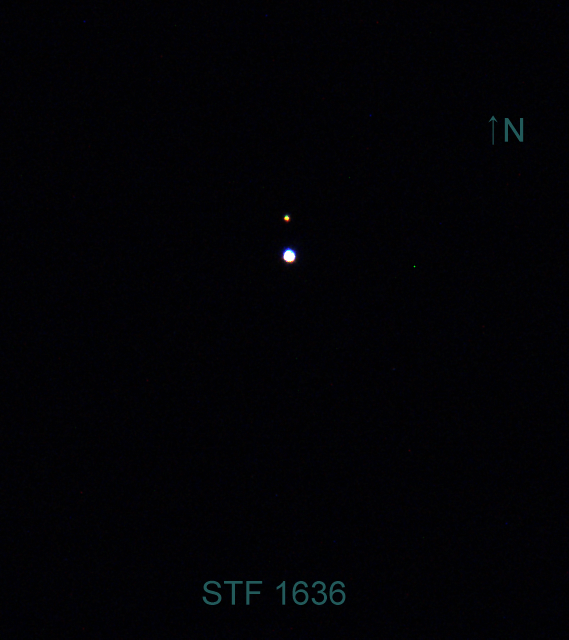
|
|
|
|
STF1645 |
|
AB |
7m.5 |
8m.1 |
9.8" |
156° |
2017 |
CVn |
12h28m04.45s / +44°47'39.50" |
|
|
Mark McCarthy
Fremont (California/USA) |
178mm (205x) |
Slight delta, wide, pretty light yellow-white stars. WDS lists as physical, and I agree |
|
Gerd Kohler
Langenzenn (Germany) |
254mm (76x) |
Der Doppelstern ist getrennt. Bläulich-weiß - bläulich-weiß. Gleiche Helligkeit. |
|
Mark McCarthy
Fremont (California/USA) |
317mm (277x) |
Wide, bright yellowish-white pair, ~1 delta mag |
|
|
Berthold Fuchs
Wiesbaden (Germany) |
130mm |
easy DS |
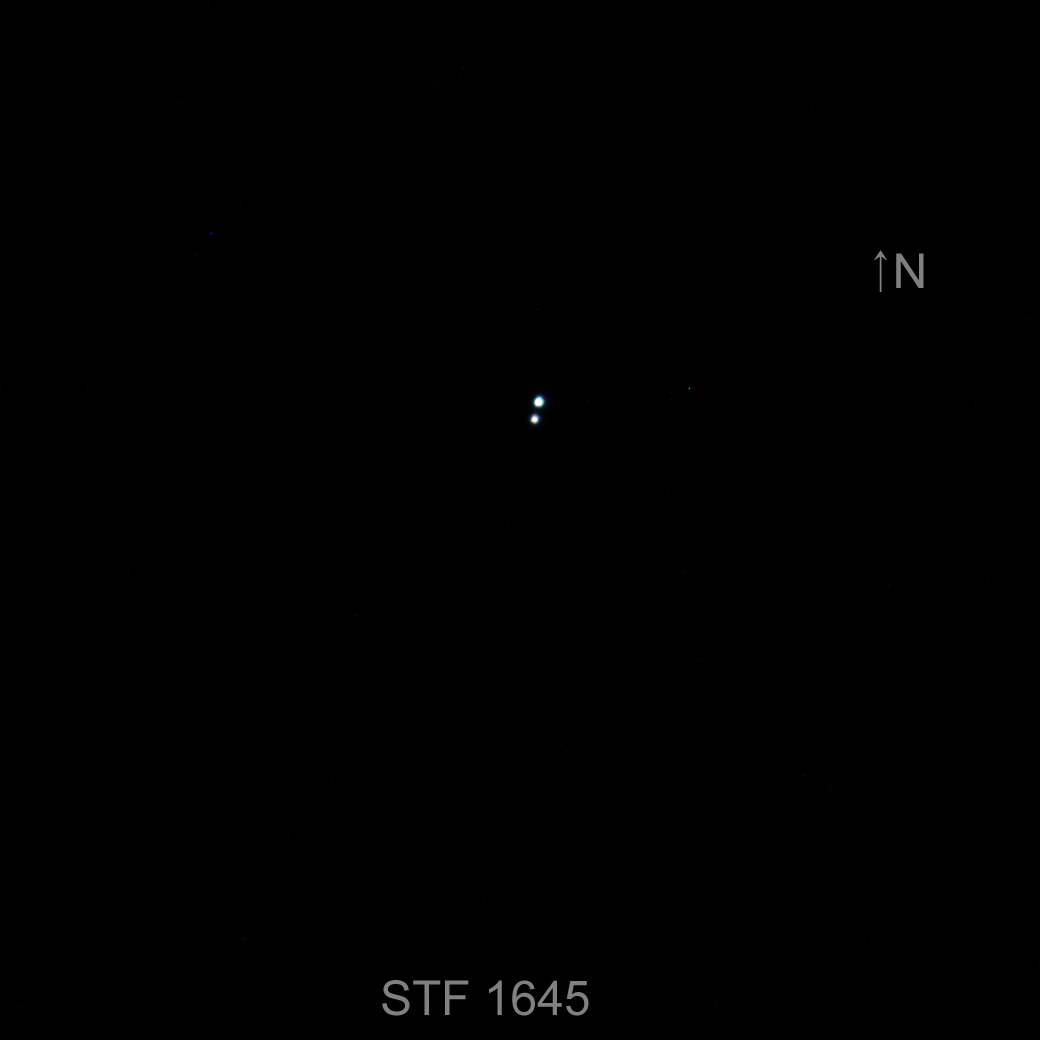
|
|
|
|
STF1679 |
|
AB |
9m.6 |
10m.0 |
5.9" |
208° |
2017 |
CVn |
12h46m00.83s / +49°49'23.00" |
|
|
|
|
AC |
9m.6 |
13m.7 |
69.1" |
37° |
2015 |
|
|
Mark McCarthy
Fremont (California/USA) |
178mm (205x) |
AB: White 1 delta, wide. WDS is uncertain but there is good parallax overlap and 1183 AU separation, so likely physical |
|
Mark McCarthy
Fremont (California/USA) |
317mm (277x) |
AB: Fairly faint equal magnitude, 3" |
|
|
Berthold Fuchs
Wiesbaden (Germany) |
130mm |
easy DS |

|
|
|
|
STF1681 |
|
|
8m.9 |
8m.9 |
9.2" |
17° |
2016 |
Vir |
12h49m34.82s / +03°49'05.60" |
Berthold Fuchs
Wiesbaden (Germany) |
130mm |
easy DS |

|
|
|
★★
|
STF1692, 12 CVn, alpha CVn, Cor Caroli |
|
AB |
2m.9 |
5m.5 |
19.3" |
230° |
2020 |
CVn |
12h56m01.67s / +38°19'06.20" |
Christopher Hay
Seeheim (Germany) |
11x80 |
Difficult, but definitely split. Interesting to compare directly with Zeta UMa (Alcor): the latter very close to separation, but not quite there. |
|
Robert Zebahl
Leipzig (Germany) |
70mm (22x) |
Beautiful view. Clearly unequal with nice angular distance. Primary component appeared in pale yellow, companion silvery-white. |
|
Christopher Hay
Seeheim (Germany) |
76mm (17x) |
Clearly split. Primary slightly yellowish. Secondary too close to get a clear colour impression, but seems grey-blue in good moments. |
|
Mark McCarthy
Fremont (California/USA) |
80mm (92x) |
Cor Caroli, showpiece, almost three detla mag and nicely split. Nice round star images |
|
René Merting
Drachhausen (Germany) |
100mm (32x) |
bei 64x ein auffälliger Doppelstern - A ist gleißend weiß, B im Südwesten ist 1.5 Größenklassen schwächer (2.67 mag lt. Stelle Doppie, schon zum zweiten Mal vertan hier) |
|
Sarah Gebauer
Germany |
100mm (49x) |
02.10.23: horizontnahe Beobachtung - bei 21-fach schon knapp getrennt, ein Schneemann-Doppelstern in Warmweiß mit einem Hauch Hellgold - bei 49-fach zeigen die beiden gut getrennten Komponenten einen ähnlich warmweißen, hellgoldenen Farbeindruck, A bekommt ein weißes Sternzentrum, die B-Komponente wirkt lediglich feiner und schwächer |
|
Uwe Pilz
Leipzig (Germany) |
105mm (66x) |
blauweiß-orange, trennbar bei 16x |
|
Uwe Pilz
Leipzig (Germany) |
105mm (200x) |
schon bei 26x getrennt |

|
René Merting
Drachhausen (Germany) |
107mm (30x) |
bei 30x ein ordentlich getrenntes Sternpaar - während A weiß strahlt, zeigt sich B im Südwesten Goldweiß mit einer größeren Tendenz zum Gold |
|
Robert Zebahl
Leipzig (Germany) |
114mm (28x) |
Well split with big difference in brightness. |
|
Sarah Gebauer
Germany |
150mm (83x) |
deutlicher Helligkeitsunterschied, sehr einfach zu trennen |
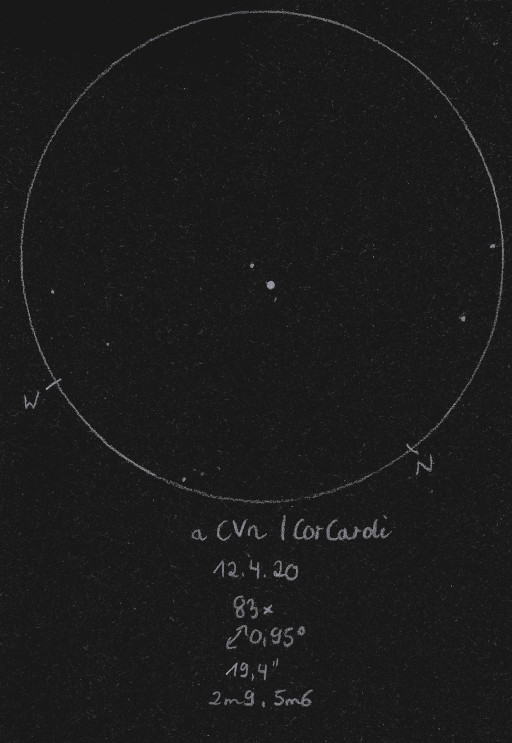
|
Mark McCarthy
Fremont (California/USA) |
203mm (205x) |
Cream white and light canary yellow. Well separated, 2 delta mag. |
|
Mark McCarthy
Fremont (California/USA) |
203mm (205x) |
Cor Caroli: Cream white and light canary yellow. Well separated, 2 delta mag. |
|
Gerd Kohler
Langenzenn (Germany) |
254mm (76x) |
Weiß-leicht bläulich - leicht orange rötlich. Kleiner Helligkeitsunterschied. |
|
Mark McCarthy
Fremont (California/USA) |
317mm (71x) |
Cor Caroli. Cream and bluish, use low power to fit STF 1688 & STF 1702 in the same field |
|
René Merting
Drachhausen (Germany) |
320mm (72x) |
bei 72x ein schönes Pärchen - A ist weiß - B zeigt sich gut getrennt südwestlich von A, ist gut 1.5 Größenklassen schwächer (2.67 mag laut Stelle Doppie) und mit einem leichten Stich ins gelbliche (warmweiß) - zurück auf 20x eine ungleiche 8, bei 32x knapp getrennt |
|
|
Berthold Fuchs
Wiesbaden (Germany) |
130mm |
easy DS |
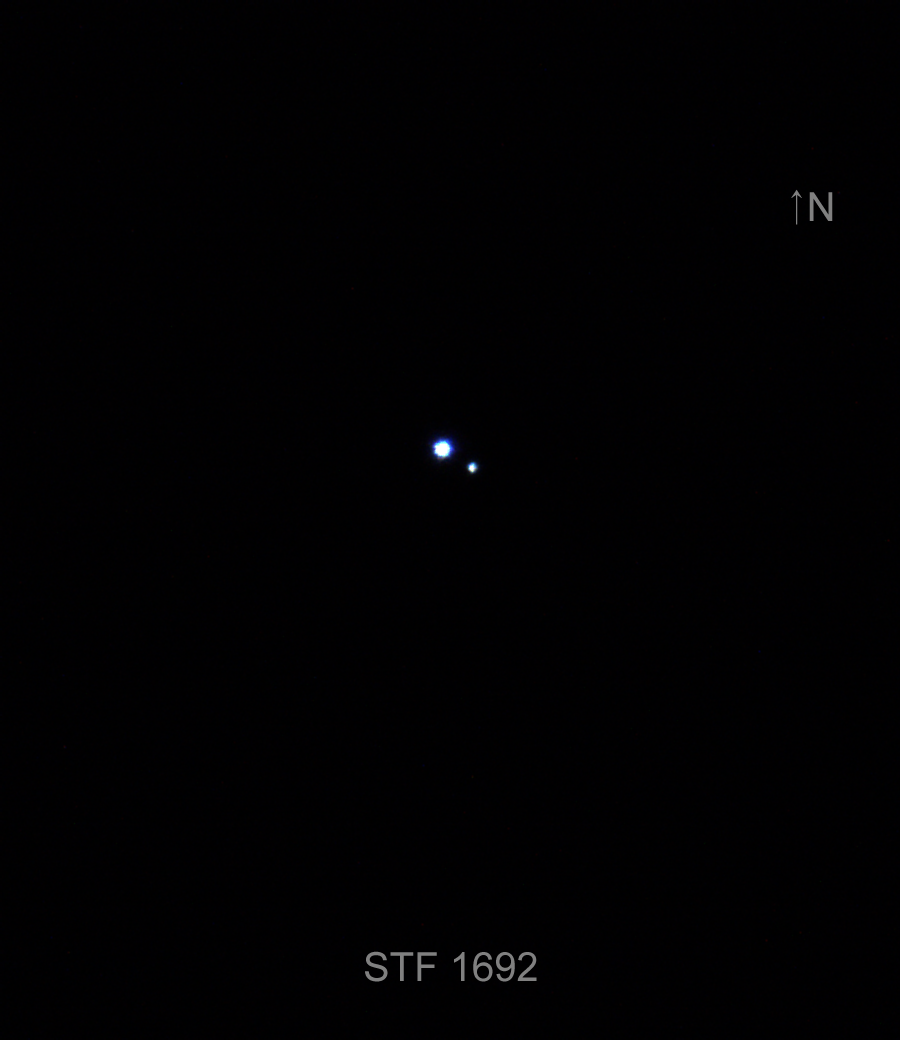
|
Frederik Wanink
Itterbeck (Germany) |
254mm |
|

|
|
|
|
STF1701 |
|
|
7m.6 |
9m.9 |
21.5" |
306° |
2015 |
Vir |
12h59m20.16s / +06°30'21.10" |
Berthold Fuchs
Wiesbaden (Germany) |
130mm |
easy DS |
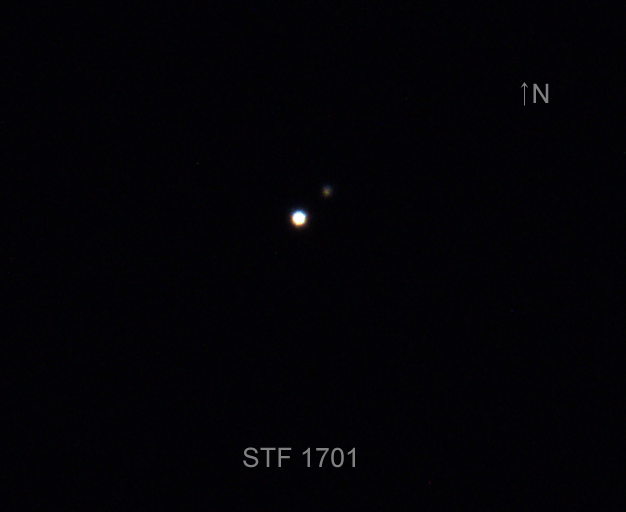
|
|
|
|
STF1712 |
|
|
10m.2 |
10m.6 |
9.1" |
332° |
2016 |
Vir |
13h03m32.39s / +09°28'08.00" |
Berthold Fuchs
Wiesbaden (Germany) |
130mm |
easy DS |

|
|
|
|
STF1719 |
|
AB |
7m.6 |
8m.2 |
6.9" |
359° |
2019 |
Vir |
13h07m19.75s / +00°35'06.70" |
Berthold Fuchs
Wiesbaden (Germany) |
130mm |
easy DS |
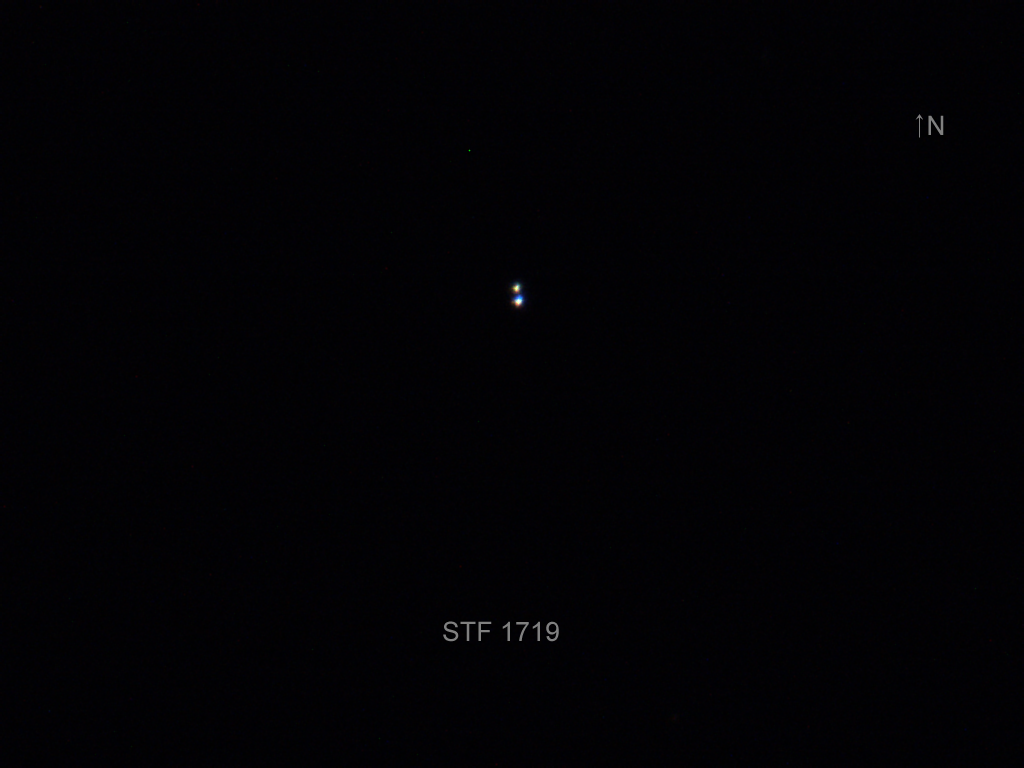
|
|
|
|
STF1723 |
|
|
8m.7 |
10m.1 |
6.1" |
12° |
2019 |
CVn |
13h08m13.49s / +38°44'20.20" |
Mark McCarthy
Fremont (California/USA) |
508mm (205x) |
Light yellow and light orange, 1.5 delta mag, well split |
|
|
Berthold Fuchs
Wiesbaden (Germany) |
130mm |
easy DS |
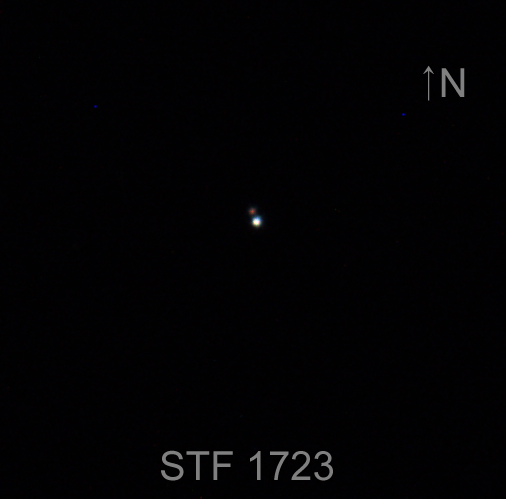
|
|
|
|
STF1740 |
|
|
7m.1 |
7m.4 |
25.6" |
75° |
2018 |
Vir |
13h23m39.16s / +02°43'24.00" |
Stefan Loibl
Rosenheim (Germany) |
10x50 |
close double star for binoculars, clearly split, component A slightly reddish |
|
René Merting
Drachhausen (Germany) |
15x56 |
sehr schön anzusehen, ein helles Sternpaar, mehr als knapp getrennt - Komponente B im Osten ist eine viertel Magnitude schwächer |
|
René Merting
Drachhausen (Germany) |
18x70 |
ein auffälliges, schön eng zusammen stehendes Sternpaar - Komponente B im Osten ist nur knapp schwächer |
|
Robert Zebahl
Leipzig (Germany) |
70mm (33x) |
Easy to separate, slightly unequal with moderate angular distance. A: pale orange, B: color not clearly perceptible. |
|
Uwe Pilz
Leipzig (Germany) |
105mm (88x) |
gelb und orange, der westliche ist einen Hauch heller. Schon auffallend bei 2x, sehr schön bei 88x |

|
Mark McCarthy
Fremont (California/USA) |
203mm (333x) |
hair split equal white pair. Suspected elongation at 205x but needed 333x to split. 667x too much power given the conditions. |
|
|
Berthold Fuchs
Wiesbaden (Germany) |
130mm |
easy DS |
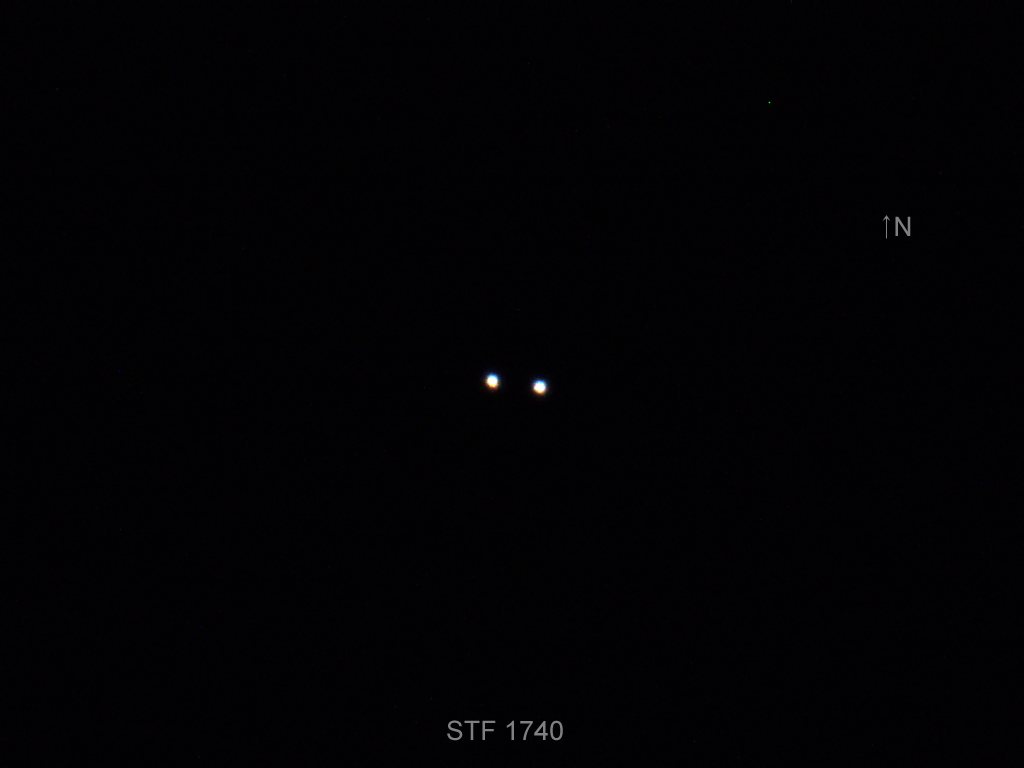
|
|
|
★★
|
STF1744 & SMR4, zeta UMa |
STF1744, 79 UMa, Mizar |
AB |
2m.2 |
3m.9 |
14.7" |
154° |
2020 |
UMa |
13h23m55.42s / +54°55'31.50" |
|
|
|
STF1744, Mizar & Alcor |
AC |
2m.2 |
4m.0 |
715.5" |
73° |
2020 |
|
|
|
|
|
SMR4 |
AD |
2m.2 |
7m.6 |
498.1" |
103° |
2020 |
|
|
René Merting
Drachhausen (Germany) |
naked eye |
AC: perfekte Bedingungen: der Doppelstern steht im Zenit, gute Transparenz … und siehe da, das kleine Reiterlein Komponente C ist zu erkennen, ach was sage ich, leicht zu erkennen - C ist deutlich schwächer, Trennung mehr als knapp - heute so einfach, wie oft bin ich im Vorfeld gescheitert mit bloßem Auge |
|
Christopher Hay
Seeheim (Germany) |
naked eye |
AC: Mizar/Alcor: After seeing the two stars separated for the first time under clear corona skies in spring 2020, this became a regular and easy sighting. Naked-eye star splitting is a skill that develops rapidly with practice. Mizar and Alcor are wide apart with my 60-year-old eyes, and occasionally Alcor appears slightly bluish. |
|
Christopher Hay
Seeheim (Germany) |
7x50 |
On tripod. Mizar (AB) is an uneven figure-8, the smaller circle of the 8 pointing to an estimated PA of 150°. Without knowing that this is a double star one might think the binoculars have collimation issues, but Epsilon UMa displays a perfect little Airy disk.
Alcor (C) appears bluish, Mizar creamy-white.
D seems reddish. |
|
René Merting
Drachhausen (Germany) |
8x25 |
AC: ein weit getrenntes Pärchen - Helligkeitsunterschied 1.5 Magnituden\AD: Komponente D kann ich auch erkennen, diese steht näher an C und ist nochmal um einiges schwächer als diese |
|
René Merting
Drachhausen (Germany) |
8x30 |
AC: ein ultraweit getrenntes Pärchen - Komponente C im NO schätze ich eine Größenklasse schwächer ein (1.78 mag laut stelle Doppie)\AD: Komponente D (SMR4) ist östlich der beiden Sterne ganz schwach erkennbar, D steht dabei näher zu C |
|
Robert Zebahl
Leipzig (Germany) |
8x40 |
AB: 2020-04-05: Even with tripod not separable. |
|
Christopher Hay
Seeheim (Germany) |
10x56 |
AB: On tripod. Touching stars with a sliver of black in-between in good moments. Very aesthetic 6.3° field of view together with a little star group around 82 UMa. |
|
Christopher Hay
Seeheim (Germany) |
12x24 |
AB: On tripod. Very finely split, but stable. |
|
Christopher Hay
Seeheim (Germany) |
15x45 |
AB: Binoculars with internal stabilisation, handheld. AB nicely split with strong difference in magnitudes between A and B, very pretty. |
|
René Merting
Drachhausen (Germany) |
15x56 |
AB: bei guten Bedingungen ist Komponente B südöstlich von A erkennbar, der Stern klebt noch an A, deutliche Einschnürung, aber noch keine Trennung - in einer anderen Nacht mit schlechteren Bedingungen (heller, mäßige Durchsicht) gelingt mir die Trennung\AC: ja, was soll ich sagen, klar sehe ich die beiden Sterne getrennt ;-), manche schaffen das mit bloßem Auge, ich nicht\AD: D ist leicht nach Süden versetzt zwischen A und C erkennbar, die mit Abstand schwächste der vier sichtbaren Komponenten |
|
Christopher Hay
Seeheim (Germany) |
42mm (12x) |
AB: At 6.3x substantially elongated with clear positions of the brighter/darker components. At 10.7x a very stretched figure-eight tantalisingly close to popping apart. At 12x cleanly split with a stable sliver of black between A and B. |
|
Robert Zebahl
Leipzig (Germany) |
70mm (10x) |
AB: 2020-04-12: Observation from city with a 70/400mm ED refractor, for which I made aperture masks from 10mm to 60mm. Goal was to find the minimum magnification for a successful split.
70mm: At 12.5x no separation of the components possible due to outshining. Grey filters brought a slight improvement, but again no separation or elongation was visible.
60mm: At 12.5x slight outshining of the companion, clearly elongated and almost separated.
50mm: At 12.5x the companion was almost outshined. A separation was just possible.
40mm: At 12.5x both components appear finely separated from each other.
30mm: At 10x not clearly separable due to outshining, but clearly elongated. At 12.5x then quite easy to separate with a fine star rendition.
20mm: At 10x the companion is still clearly visible, but quite close to the primary component. At 12.5x best view under the used apertures with a very fine rendition!
10mm: At 10x the companion appears very faint. Separation possible, but extremely tight. At 12.5x reasonably well separated. |
|
Robert Zebahl
Leipzig (Germany) |
70mm (22x) |
AB: 2020-04-11: At 12x no separation possible, because the bright primary component outshines the companion. At 22x clearly separated, but still quite close together. |
|
René Merting
Drachhausen (Germany) |
76mm (29x) |
bei 29x sind alle vier Komponenten gut erkennbar - im Süden die östlich von Komponente A strahlende B-Komponente strahlt etwas schwächer als A und leicht gelblich, Trennung ordentlich - C weit im Norden ist der dritthellste Stern - Komponente D im Osten bildet ein Flaches Dreieck mit den anderen Komponente und ist dabei näher an C als an AB |
|
Robert Zebahl
Leipzig (Germany) |
102mm (28x) |
First pastel sketch (Pitt pastel by Faber-Castell) of a double star on black paper, where also the halos were sketched around the stars. The stars themselves were redrawn with an Edding (Edding 1500, Soft Pastel white). The sketch shows the components A to D. |
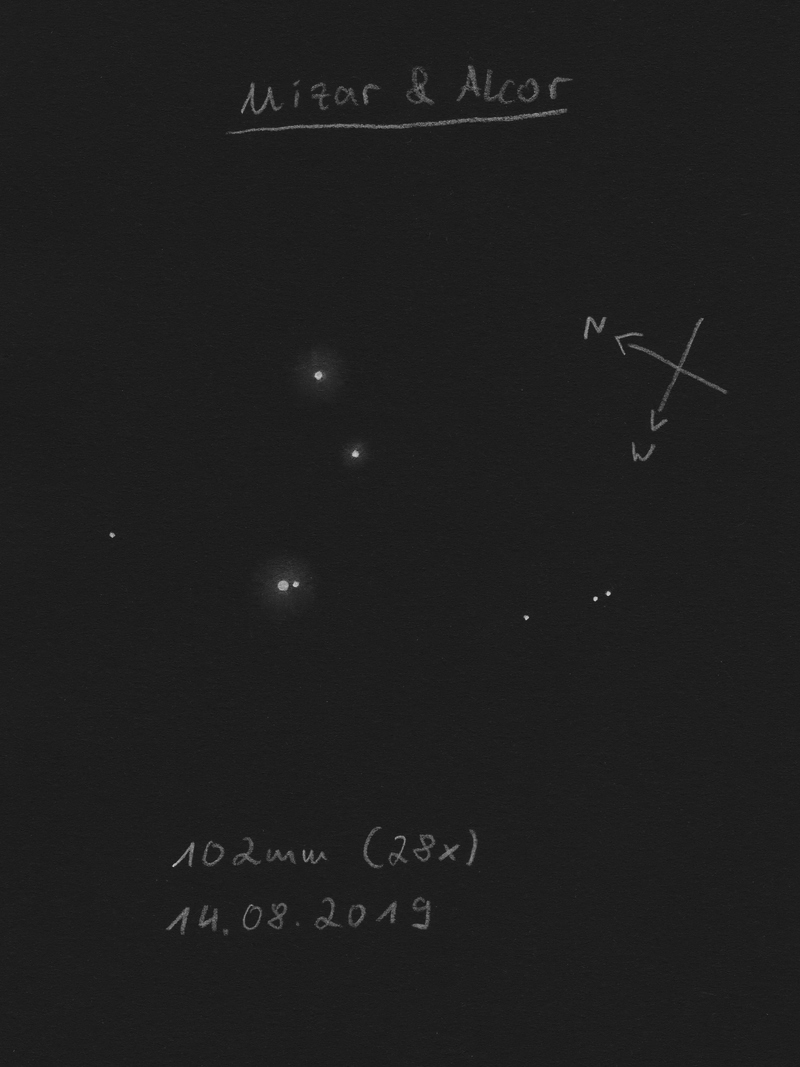
|
Uwe Pilz
Leipzig (Germany) |
105mm (288x) |
AB: mit viel Schwarz zwischen den Beugungsscheiben (1“9) |
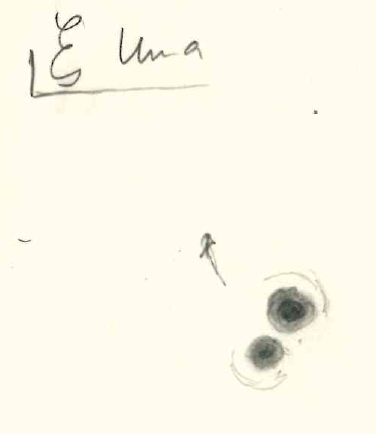
|
Jörg S. Schlimmer
Germany |
127mm (87x) |
easy to split |
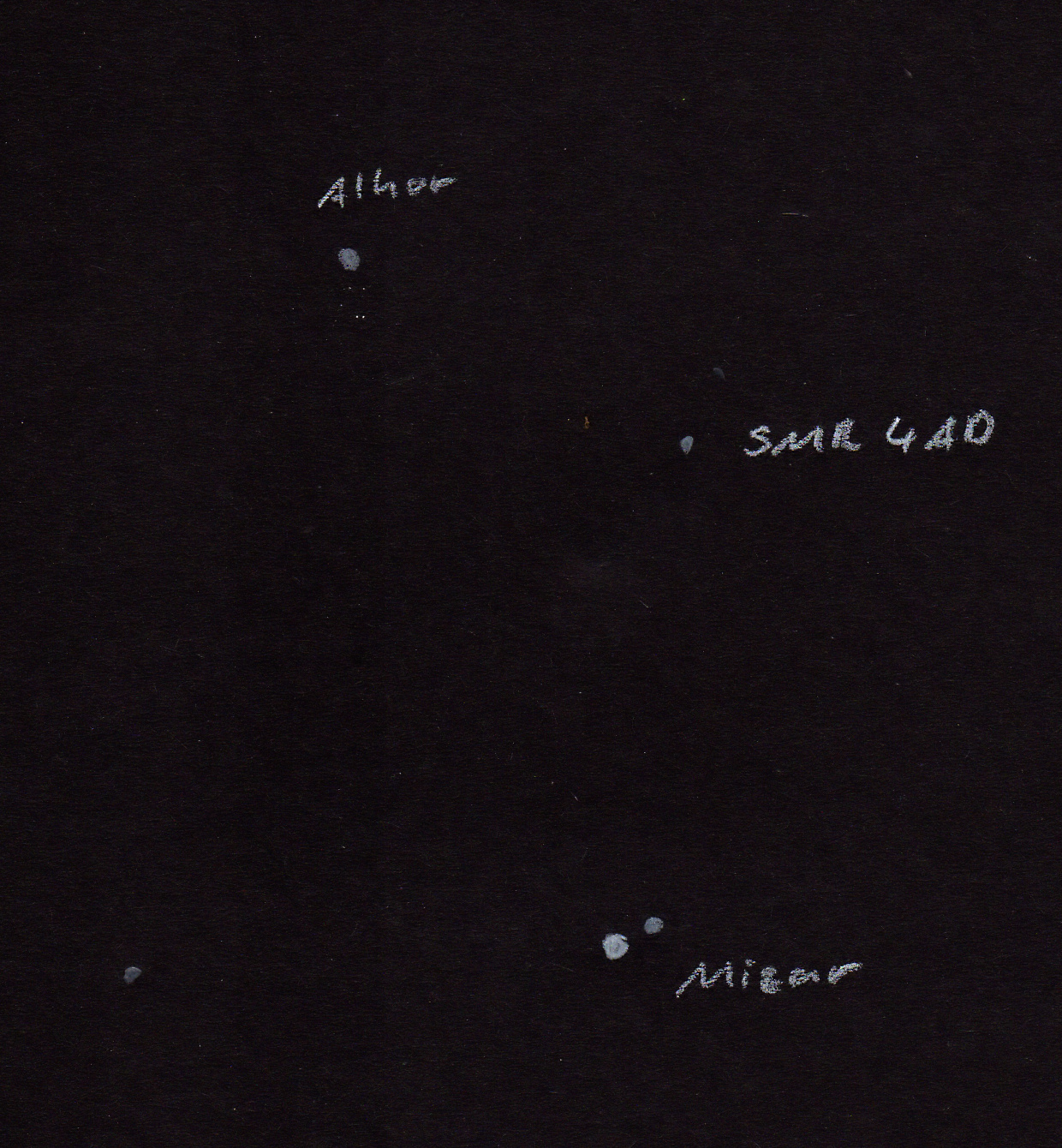
|
Sarah Gebauer
Germany |
150mm (83x) |
AB: einfacher, aber sehr schöner Doppelstern, Komponenten A und B mit 14,4'' Abstand stehen mit schönen Feldsternen zusammen im Bild |

|
René Merting
Drachhausen (Germany) |
320mm (45x) |
drei wunderschöne Juwelen strahlen mich an, A und B knapp getrennt, C weit entfernt im Nordosten von den beiden - Komponente B wirkt weißgelblich gegen die kühlweiß strahlende A-Komponente - Komponente D, die zwischen AB und C steht, wirkt eher grauweiß |
|
|
Robert Zebahl
Leipzig (Germany) |
|
|
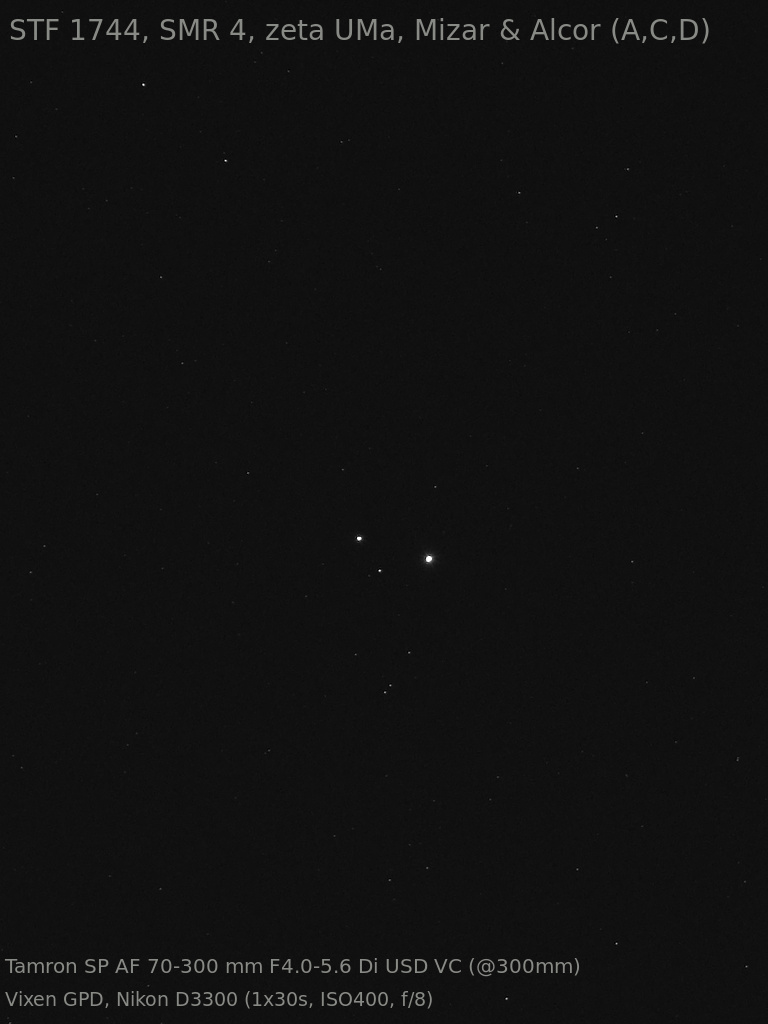
|
Werner E. Celnik
Rheinberg (Germany) |
120mm |
|
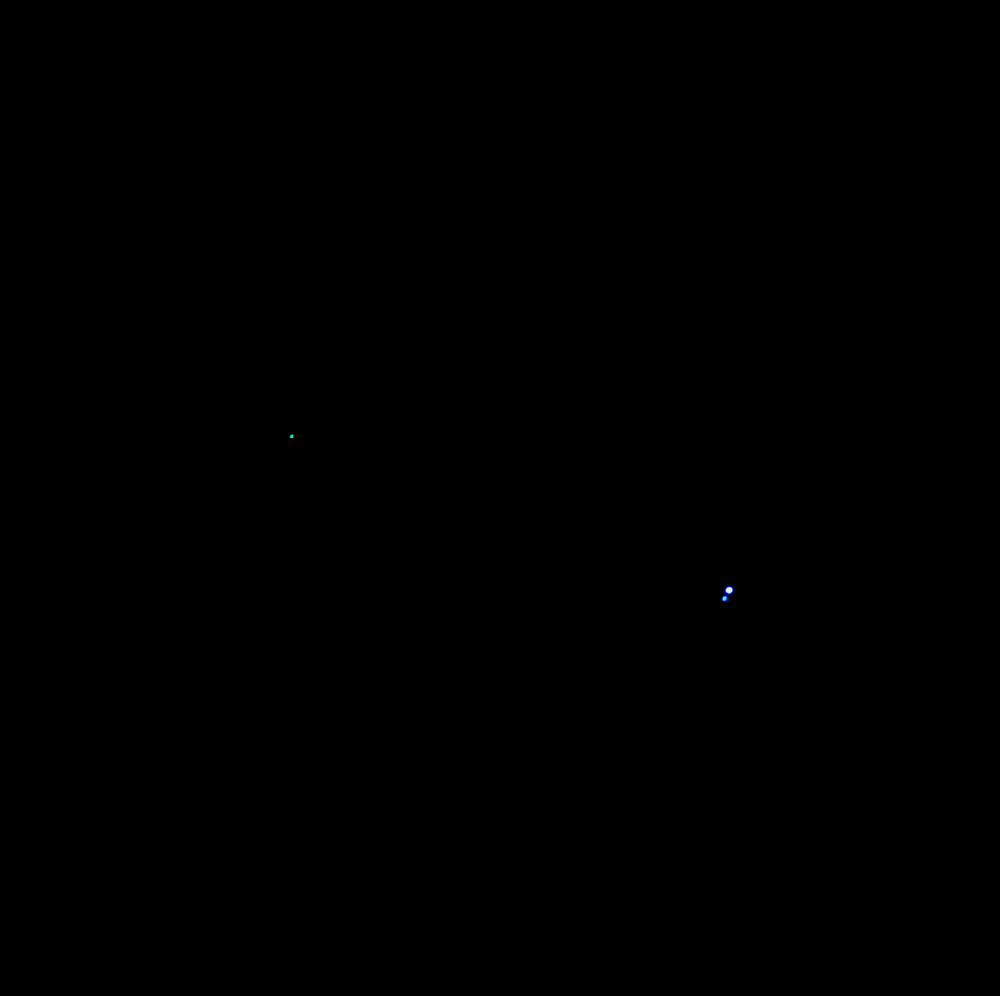
|
|
|
|
STF1746 |
|
|
7m.7 |
10m.7 |
22.8" |
246° |
2015 |
Vir |
13h28m09.72s / +09°27'40.10" |
Berthold Fuchs
Wiesbaden (Germany) |
130mm |
easy DS |
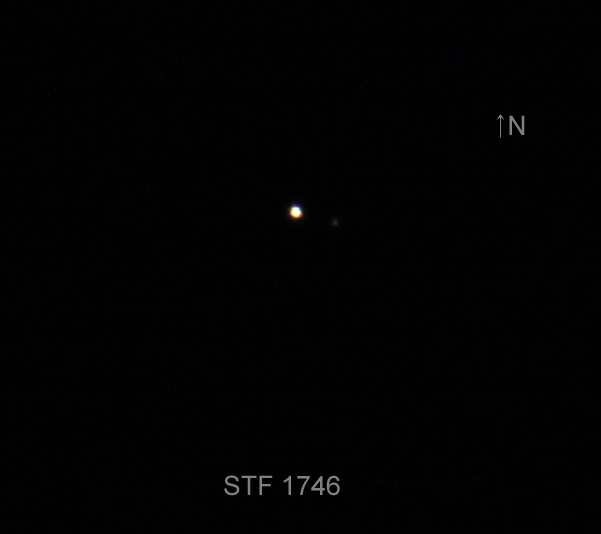
|
|
|
|
STF1756 |
|
AB |
9m.9 |
10m.4 |
14.7" |
177° |
2016 |
Com |
13h33m19.04s / +23°00'51.00" |
Mark McCarthy
Fremont (California/USA) |
203mm (333x) |
Blue-white stars, half delta mag, very wide |
|
Mark McCarthy
Fremont (California/USA) |
317mm (553x) |
Wide white pair, 0.5 delta mag. |
|
|
Berthold Fuchs
Wiesbaden (Germany) |
130mm |
easy DS |

|
|
|
★★
|
STF1772, 1 Boo |
|
AB |
5m.8 |
9m.6 |
4.4" |
133° |
2019 |
Boo |
13h40m40.50s / +19°57'20.40" |
|
|
|
|
AC |
5m.8 |
12m.2 |
86.7" |
26° |
2020 |
|
|
|
|
|
|
AD |
5m.8 |
7m.4 |
208.7" |
1° |
2020 |
|
|
Christopher Hay
Seeheim (Germany) |
7x50 |
AD: On tripod. Wide split. Component D blueish. Fine in 7.3° field together with S 656.
A physical double at a distance to us of 328 light years. |
|
Christopher Hay
Seeheim (Germany) |
15x60 |
AD: On tripod. Very wide split. Component A cream-white, D pale blue. |
|
Robert Zebahl
Leipzig (Germany) |
70mm (22x) |
AD: 2020-04-24: Very widely split with clearly visible difference in brightness. The primary component appeared white-yellowish, the companion pale orange. |
|
Christopher Hay
Seeheim (Germany) |
80mm (63x) |
AB: B pops in and out of view as a very fine pinprick of light reasonably well set off from A. No success at 50x. |
|
Christopher Hay
Seeheim (Germany) |
150mm (96x) |
AB: Well split. Remarkably easy considering the 4-mag difference in brightness. A seems dusky yellow. B perhaps bluish, but hard to determine. 9-mag star a few arcminutes to the north makes the view even more pleasing. According to Stelledoppie AB is a physical double. |
|
Mark McCarthy
Fremont (California/USA) |
203mm (333x) |
AB: 1 Boo. Odd colors. Blue-white to greenish stars, wide, about 3 delta mag. AC is the very faint star well separated at nearly a right angle PA from the AB pair |
|
Karsten Kopp
Köln (Germany) |
600mm (180x) |
AB: Im CLT bei 180 x kein Problem. Der Reiz hier macht den größeren Helligkeitsunterschied von knapp 4 mag aus. Auch die Farben, der hellere erstrahlt eher weiß und der schwächere schwach rotbraun, sind schön anzusehen. |
|
|
Berthold Fuchs
Wiesbaden (Germany) |
130mm |
AB: difficult DS |
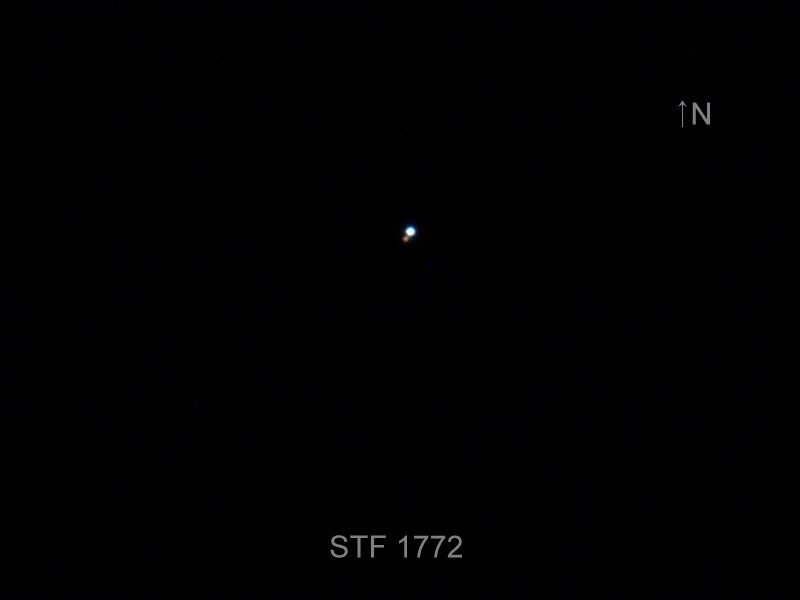
|
|
|
|
STF1789 |
|
|
8m.6 |
9m.0 |
6.7" |
328° |
2021 |
CVn |
13h54m05.19s / +32°49'35.20" |
|
|
Robert Zebahl
Leipzig (Germany) |
70mm (31x) |
2020-04-20: At 22x clearly visible as figure '8' and almost separated. At 31x fine separation of the still close pair. A slight difference in brightness and color is visible: white-yellowish, yellowish-orange. |
|
Mark McCarthy
Fremont (California/USA) |
317mm (277x) |
Pretty equal magnitude white, well separated. |
|
|
Berthold Fuchs
Wiesbaden (Germany) |
130mm |
difficult DS |

|
|
|
|
STF1793 |
|
|
7m.5 |
8m.4 |
4.8" |
243° |
2019 |
Boo |
13h59m05.25s / +25°48'57.60" |
René Merting
Drachhausen (Germany) |
100mm (64x) |
bei 32x kleben beide Komponenten noch aneinander - bei 64x knapp und bei 107x dann gut getrennt - die B-Komponente westlich ist gut eine Größenklasse schwächer |
|
Mark McCarthy
Fremont (California/USA) |
203mm (333x) |
White stars, widely separated, ~1.5 delta mag. Nice pair |
|
Karsten Kopp
Köln (Germany) |
600mm (180x) |
Im CLT bei 180 x kein Problem. Der schwächere Stern leuchtet bläulich und der hellere eher gelblich weiß. |
|
|
Berthold Fuchs
Wiesbaden (Germany) |
130mm |
close DS |
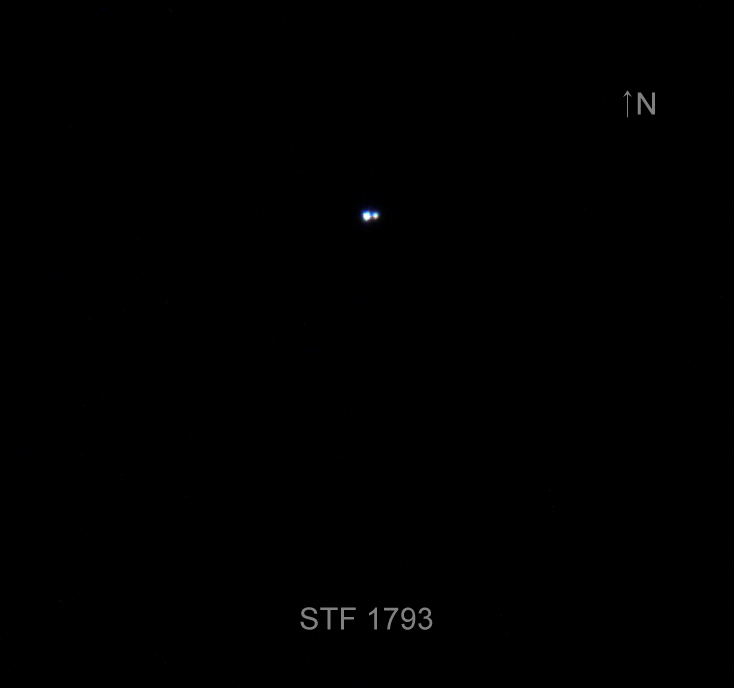
|
|
|
|
STF1805 |
|
|
9m.0 |
9m.2 |
4.9" |
34° |
2018 |
Vir |
14h09m57.24s / +04°00'56.40" |
Berthold Fuchs
Wiesbaden (Germany) |
130mm |
close DS |
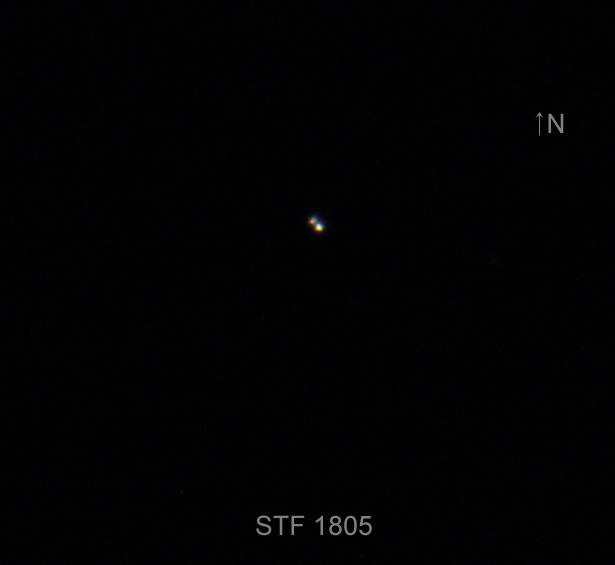
|
|
|
|
STF1813 |
|
|
8m.4 |
8m.6 |
4.6" |
193° |
2019 |
Vir |
14h13m24.23s / +05°24'03.20" |
Berthold Fuchs
Wiesbaden (Germany) |
130mm |
close DS |

|
|
|
★
|
STF1816 |
|
|
7m.4 |
7m.8 |
0.4" |
100° |
2019 |
Boo |
14h13m54.63s / +29°06'19.50" |
|
|
Uwe Pilz
Leipzig (Germany) |
105mm (88x) |
gelb |

|
Mark McCarthy
Fremont (California/USA) |
178mm (533x) |
Notched elongation, unequal pair, seeing won't support higher magnification. Physical with 1340-year period, it is near periastron now and will remain there the rest of my lifetime |
|
Mark McCarthy
Fremont (California/USA) |
317mm (553x) |
Rod-shaped equal white. July 2017 |
|
|
Frederik Wanink
Itterbeck (Germany) |
254mm |
|

|
|
|
★★
|
STF1835 & BU1111 |
STF1835 |
A-BC |
5m.0 |
6m.8 |
6.4" |
197° |
2020 |
Boo |
14h23m22.74s / +08°26'47.90" |
|
|
|
BU1111 |
BC |
7m.4 |
7m.7 |
0.3" |
25° |
2020 |
|
|
|
|
René Merting
Drachhausen (Germany) |
100mm (64x) |
STF1835 (A-BC): bei 32x erscheint der Stern leicht unrund, verschmiert - bei 107x präsentiert sich BC gut getrennt im Süden von A - Helligkeitsunterschied eine Größenklasse (1.75 mag laut Stelle Doppie) - bei 64x sind beide Sterne auch getrennt erkennbar, BC strahlt warmweiß |
|
Robert Zebahl
Leipzig (Germany) |
102mm (62x) |
STF1835 (A-BC): At 28x barely split with visible difference in brightness. At 62x easy to separate. The colors seemed similar. |
|
Mark McCarthy
Fremont (California/USA) |
317mm (277x) |
STF1835 (A-BC): In a line of three stars, white and slightly red B. Wide, ~6", 2 delta mag. Did not detect BC 0.3" |
|
Mark McCarthy
Fremont (California/USA) |
508mm (1067x) |
BU1111 (BC): Short period pair, it is a component of STF 1835. I get a nothed near equal elongation with a clear direction in relation to the A star. Very cool |
|
Karsten Kopp
Köln (Germany) |
600mm (180x) |
STF1835 (A-BC): Doppelstern konnte im CLT gut getrennt werden. Helligkeitsunterschied ist merklich, aber nicht extrem. Der hellere erscheint eher weißlich und der kleinere eher bläulich. Der Farbunterschied ist aber minimal. |
|
|
Berthold Fuchs
Wiesbaden (Germany) |
130mm |
STF1835 (A-BC): close DS |
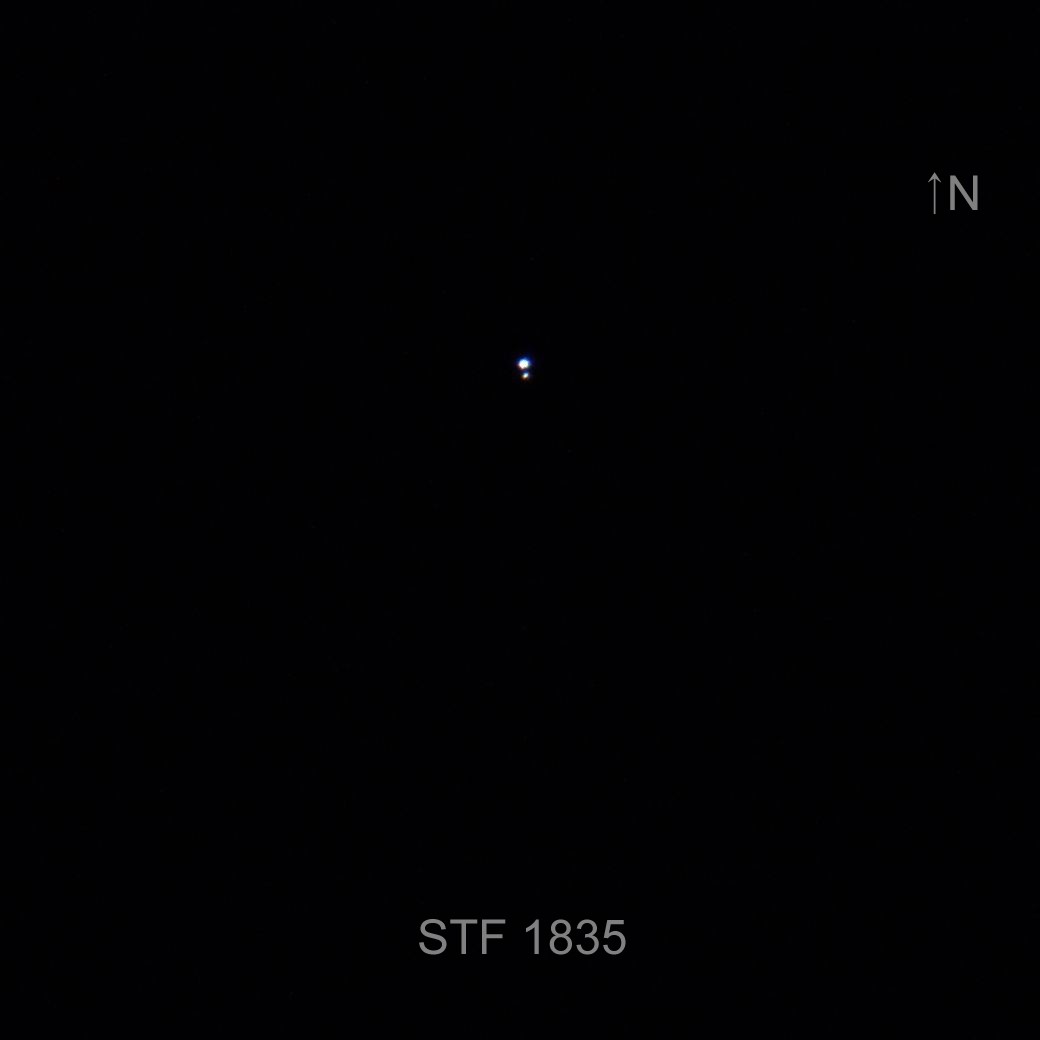
|
|
|
|
STF1838 |
|
|
7m.5 |
7m.7 |
9.4" |
335° |
2020 |
Boo |
14h24m05.76s / +11°14'49.10" |
Robert Zebahl
Leipzig (Germany) |
70mm (44x) |
2020-04-24: At 22x small, fine and remarkable double star with small difference in brightness, at 44x with visible color difference: orange & white-bluish. |
|
René Merting
Drachhausen (Germany) |
100mm (32x) |
bei 32x sind flüchtig zwei kleine sich berührende Perlchen zu erkennen - etwas genauer betrachtet, können beide Sterne getrennt gesehen werden - B im NW ist nur knapp schwächer - ein schönes Pärchen ohne Konkurrenz im Umfeld |
|
Mark McCarthy
Fremont (California/USA) |
203mm (205x) |
White stars, very slight mag difference, wide |
|
|
Berthold Fuchs
Wiesbaden (Germany) |
130mm |
easy DS |

|
|
|
★
|
STF1850 |
|
|
7m.1 |
7m.6 |
25.2" |
263° |
2018 |
Boo |
14h28m33.29s / +28°17'25.90" |
Robert Zebahl
Leipzig (Germany) |
8x40 |
2020-04-05: Separated, but still quite close together with a moderate difference in brightness. |
|
Christopher Hay
Seeheim (Germany) |
15x45 |
Handheld, binoculars with internal stabilisation. A tight pair, indirect vision helps to see black in-between. Eastern component clearly brighter. Nice in 4.5° FOV with Rho and Sigma Boo.
A physical double at a distance to us of 1140 light years. |
|
René Merting
Drachhausen (Germany) |
16x70 |
ein gut getrenntes Paar zweier gleich heller Sterne - beide weiß |
|
Robert Zebahl
Leipzig (Germany) |
70mm (22x) |
2020-04-24: Easily separated, medium bright with rather small difference in brightness and moderate distance. Fairly conspicuous. The components appeared white-yellowish and white-bluish. Beautiful double star. |
|
René Merting
Drachhausen (Germany) |
100mm (20x) |
bei 20x locker getrennt - Komponente B ist vielleicht eine halbe Magnitude schwächer als A und strahlt ein wenig dumpfer bzw. weniger weiß |
|
Sarah Gebauer
Germany |
100mm (49x) |
bei 49-fach ein gleich helles, unscheinbares, feines und weit getrenntes Pärchen |
|
Uwe Pilz
Leipzig (Germany) |
120mm (72x) |
recht weit, schöner Farbkontrast |
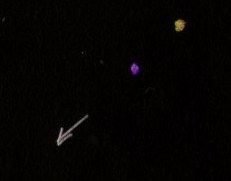
|
Mark McCarthy
Fremont (California/USA) |
178mm (205x) |
Near equal white wide. WDS claims physical, and their parallax do overlap, however they are separated by 7168 AU, too far than the known 5000 AU limit of known orbital pairs |
|
|
Berthold Fuchs
Wiesbaden (Germany) |
130mm |
easy DS |
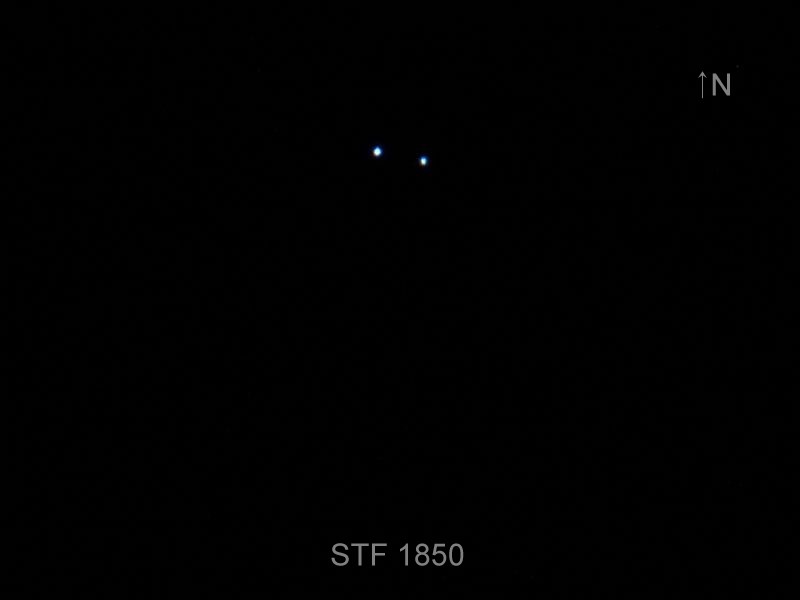
|
|
|
|
STF1864, pi 1 Boo |
|
AB |
4m.9 |
5m.8 |
5.4" |
114° |
2020 |
Boo |
14h40m43.56s / +16°25'05.90" |
Robert Zebahl
Leipzig (Germany) |
70mm (31x) |
2020-04-24: At 22x immediately visible as figure '8' with visible difference in brightness. Beside omicron Boo there are no other brighter stars in the nearer surroundings. At 31x cleanly split, but still close together with noticeable difference in brightness. Both components appear white. Beautiful sight. At 57x very nice with a slightly different color impression: white & dark yellow. |
|
Mark McCarthy
Fremont (California/USA) |
80mm (94x) |
White stars, 1 delta mag, nicely split |
|
René Merting
Drachhausen (Germany) |
100mm (64x) |
bei 32x eine 8, bei 64x dann knappe Trennung des Doppelsterns - Komponente B östlich ist nur leicht schwächer und erscheint mit einem zarten Stich ins Gelbe |
|
Mark McCarthy
Fremont (California/USA) |
203mm (333x) |
Pi 1 Boo. Very bright, ~1 delta mag, off white stars |
|
|
Berthold Fuchs
Wiesbaden (Germany) |
130mm |
close DS |
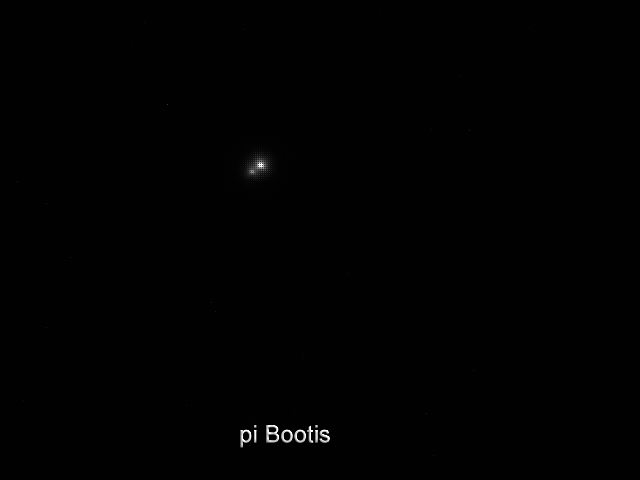
|
Frederik Wanink
Itterbeck (Germany) |
254mm |
|
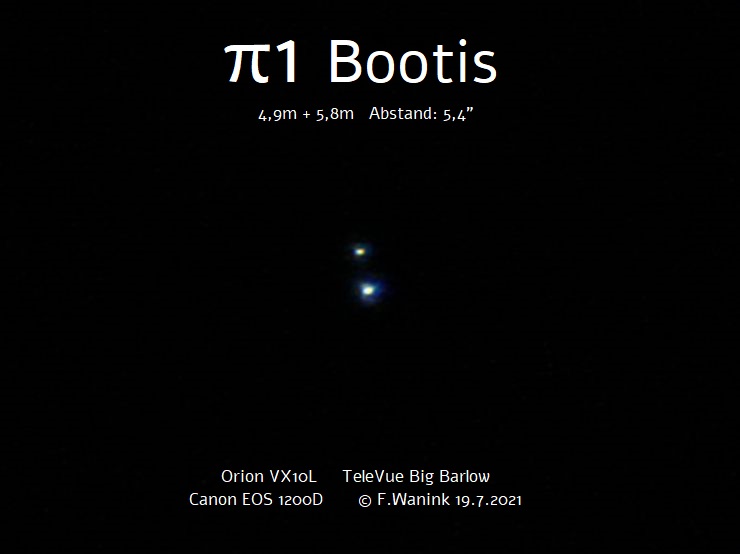
|
|
|
|
STF1871 |
|
|
8m.0 |
8m.1 |
1.8" |
313° |
2019 |
Boo |
14h41m35.50s / +51°23'51.30" |
|
|
Robert Zebahl
Leipzig (Germany) |
102mm (187x) |
2021-05-16: Clearly separated, but still pretty tight with similarly bright components. |
|
|
Frederik Wanink
Itterbeck (Germany) |
254mm |
|
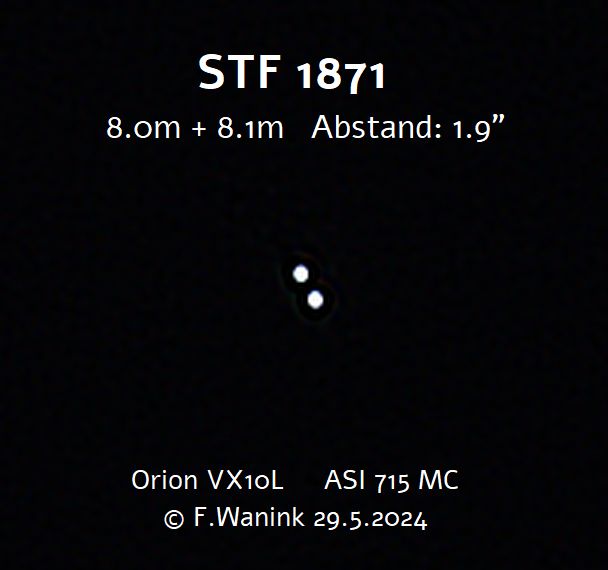
|
|
|
★★
|
STF1877, epsilon Boo, Izar |
|
AB |
2m.6 |
4m.8 |
2.9" |
347° |
2020 |
Boo |
14h44m59.14s / +27°04'29.90" |
Robert Zebahl
Leipzig (Germany) |
55mm (125x) |
The fainter component was seen as permanent brightening on the first diffraction ring of the primary component. |
|
Robert Zebahl
Leipzig (Germany) |
60mm (192x) |
Easy to split, whereby the much fainter component lies on the first diffraction ring of the primary component. The primary component itself appeared slightly yellowish. |

|
Robert Zebahl
Leipzig (Germany) |
70mm (133x) |
Easy to split, very unequal. A appeared in pale orange, B was visible as a very tiny, grey star on the first diffraction ring of component A. |
|
Christopher Hay
Seeheim (Germany) |
76mm (100x) |
AB: Secondary sits on the first diffraction ring of the primary, and appears there as a fine blue point. Further magnification not useful, merely darkens the image. |
|
Mark McCarthy
Fremont (California/USA) |
80mm (150x) |
Izar: Dull yellow-orange A and dull orange B, nice round images so split easily. No parallax for the B star, so it's uncertain if physical |
|
René Merting
Drachhausen (Germany) |
100mm (142x) |
bei 107x erscheint die B-Komponente nordwestlich leicht angesetzt an der gelblich strahlenden Komponente A - bei 142x dann ist die Trennung komplett, B liegt schön auf einem abgesetzten Beugungskranz von Komponente A |
|
Stefan Loibl
Rosenheim (Germany) |
102mm (205x) |
nice contrast yellow-orange/blue |
|
Robert Zebahl
Leipzig (Germany) |
102mm (224x) |
2021-05-12: Primary component appears in bright orange, the well separated, much fainter companion at 187x grey-bluish, at 224x and higher in a very nice, pale blue. |
|
René Merting
Drachhausen (Germany) |
107mm (120x) |
bei 120x gelingt die Trennung - die B-Komponente im Norden ist mindestens 2 Magnituden schwächer - A strahlt schön Gelbweiß, B ist Aschegrau |
|
Uwe Pilz
Leipzig (Germany) |
120mm (150x) |
Orange und blau, sehr lohnend |
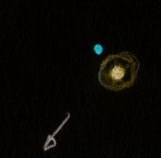
|
Robert Zebahl
Leipzig (Germany) |
120mm (192x) |
At 85x the fainter component was easily visible but not separated. At 192x well split. The fainter component was almost on the first diffraction ring of the primary component. Quite big difference in brightness. I did not looked at the color of the components. |
|
Sarah Gebauer
Germany |
150mm (166x) |
weder mit 166x noch mit 250x im April 2020 getrennt |
|
Gerd Kohler
Langenzenn (Germany) |
254mm (346x) |
Gelblich - leicht bläulich. Enges Paar. Deutlicher Helligkeitsunterschied. |
|
Frederik Wanink
Itterbeck (Germany) |
254mm (640x) |
deutl. Farbkontrast blau gelb |
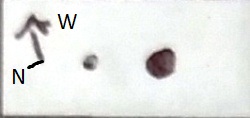
|
Christopher Hay
Seeheim (Germany) |
280mm (180x) |
Clearly split despite poor seeing. Slightly bluish impression of secondary at 180x becomes much clearer at 240x, indeed transforms into a charming, very light ultramarine blue or lapis lazuli. |
|
Sarah Gebauer
Germany |
280mm (250x) |
waberndes Seeing, aber eindeutig und zum ersten Mal getrennt - A erscheint leicht gelblich, B steht abgesetzt in weißlichem Ton daneben |

|
Mark McCarthy
Fremont (California/USA) |
317mm (553x) |
Izar: Yellow-orange and blue, very pretty, as always |
|
Karsten Kopp
Köln (Germany) |
600mm (257x) |
Sehr einfaches und auffälliges Objekt. Dieser Doppelstern war für mich an diesem Abend das Highlight. Vor allem, weil der schwächere hellblaue Stern gerade knapp neben den Spikes des helleren gelben Sterns steht. |

|
|
Berthold Fuchs
Wiesbaden (Germany) |
130mm |
magnificent DS |
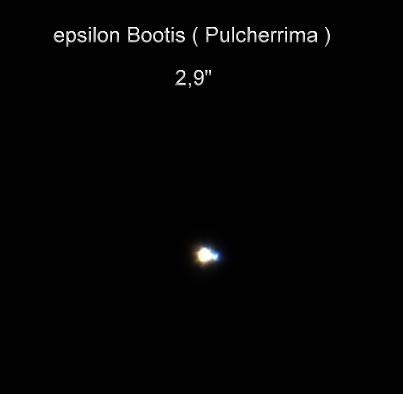
|
Frederik Wanink
Itterbeck (Germany) |
254mm |
|

|
|
|
★
|
STF1890, 39 Boo |
|
|
6m.3 |
6m.7 |
2.6" |
46° |
2020 |
Boo |
14h49m41.37s / +48°43'15.60" |
|
|
Robert Zebahl
Leipzig (Germany) |
70mm (67x) |
2020-04-01: At 44x elongated, partly notched. At 67x split, but very tight. A difference in brightness was not seen. At 133x clearly separated with little difference in brightness. A appeared pale yellow, B rather warm-white. |
|
Robert Zebahl
Leipzig (Germany) |
70mm (100x) |
2020-04-18: At 57x very finely separated with extremely tightly spaced components that appeared equally bright. At 100x a very nice pair with little difference in brightness. Fantastic sight! The color of the components was slightly different: creamy-white & a touch of yellow-orange. |
|
Sarah Gebauer
Germany |
100mm (49x) |
02.10.23: das dünnste und feinste Sternpaar, das ich bei 80-fach bisher gesehen habe, zwei hauchfein getrennte Ameisenpünktchen - die südwestliche Komponente erscheint minimal heller und größer, beide wirken hellgold mit einem weißen Tupfen |
|
Robert Zebahl
Leipzig (Germany) |
102mm (187x) |
2021-05-16: Easy. Beautiful double star with slight difference in brightness. Yellowish & rather white. I estimated the position angle to 40°. |
|
Frederik Wanink
Itterbeck (Germany) |
254mm (640x) |
gleich hell |

|
Mark McCarthy
Fremont (California/USA) |
317mm (553x) |
Bright white pair, well split |
|
|
Frederik Wanink
Itterbeck (Germany) |
254mm |
|

|
|
|
★
|
STF1886 |
|
AB |
7m.6 |
9m.7 |
7.9" |
224° |
2018 |
Boo |
14h51m02.31s / +09°43'25.20" |
Robert Zebahl
Leipzig (Germany) |
102mm (28x) |
At 28x, the B component appeared rather faint and pretty close to the primary component. At 62x both components were clearly visible and unequal. A: slightly orange, B: greyish. |
|
Mark McCarthy
Fremont (California/USA) |
317mm (553x) |
Yellow-orange and orange, pretty wide ~10" 2 delta mag |
|
Karsten Kopp
Köln (Germany) |
600mm (180x) |
Einfach zu trennen, aber der Helligkeitsunterschied mit 2,1 mag ist auffällig. Der hellere Stern erscheint gelblich weiß und der schwächere rotbraun. Sehr schön. |
|
|
Berthold Fuchs
Wiesbaden (Germany) |
130mm |
close DS |
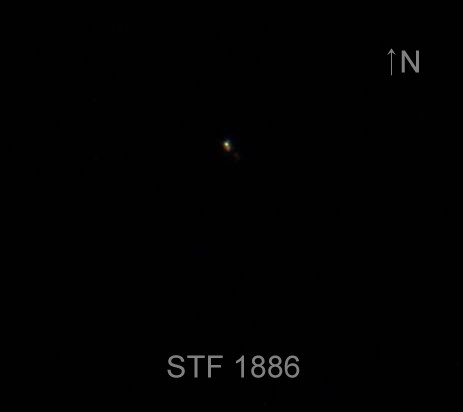
|
|
|
★
|
xi Boo, 37 Boo |
STF1888 |
AB |
4m.8 |
7m.0 |
5.0" |
296° |
2021 |
Boo |
14h51m23.38s / +19°06'01.70" |
|
|
|
STF1888 |
AC |
4m.8 |
13m.8 |
71.3" |
340° |
2015 |
|
|
|
|
|
STF1888 |
AD |
4m.8 |
11m.7 |
160.8" |
286° |
2015 |
|
|
|
|
|
ARN11 |
AE |
4m.8 |
8m.7 |
271.5" |
98° |
2015 |
|
|
|
|
|
ARN11 |
AF |
4m.8 |
9m.2 |
335.4" |
39° |
2020 |
|
|
|
|
|
STF1888 |
BC |
7m.0 |
13m.8 |
67.0" |
343° |
2016 |
|
|
|
|
|
STF1888 |
BE |
7m.0 |
8m.7 |
273.1" |
99° |
2016 |
|
|
|
|
Robert Zebahl
Leipzig (Germany) |
70mm (44x) |
AB: 2020-04-24: Beautifully separated with quite a large difference in brightness in a lovely star field. The primary component shines yellowish with a faint companion. |
|
Mark McCarthy
Fremont (California/USA) |
80mm (94x) |
AB: Yellow A and orange B, 2 delta mag, nice. Only 22 light years distant, it is physical with a 298-year period, and will tighten the next 30 years |
|
Sarah Gebauer
Germany |
150mm (83x) |
AB: die 6'' entfernten Komponenten A und B konnten mühelos bei 83x getrennt werden, Komponente E war zu sehen, C, D und F waren nicht sichtbar |

|
Mark McCarthy
Fremont (California/USA) |
508mm (333x) |
AB: Xi Boo. Short period. Richly colored yellow and orange stars, ~1 delta mag, ~5" separation, with several other stars in view. Very pretty |
|
Karsten Kopp
Köln (Germany) |
600mm (180x) |
AB: Ein recht schöner Doppelstern, wobei neben dem Helligkeitsunterschied von 2,2 mag auch die Sternfarben ein schönes Gesamtbild geben. Der hellere Stern erstrahlt gelblich weiß und der schwächere orangegelb.
Hier handelt es sich auch um ein recht nahes System mit 21,9 Lichtjahren Entfernung. |
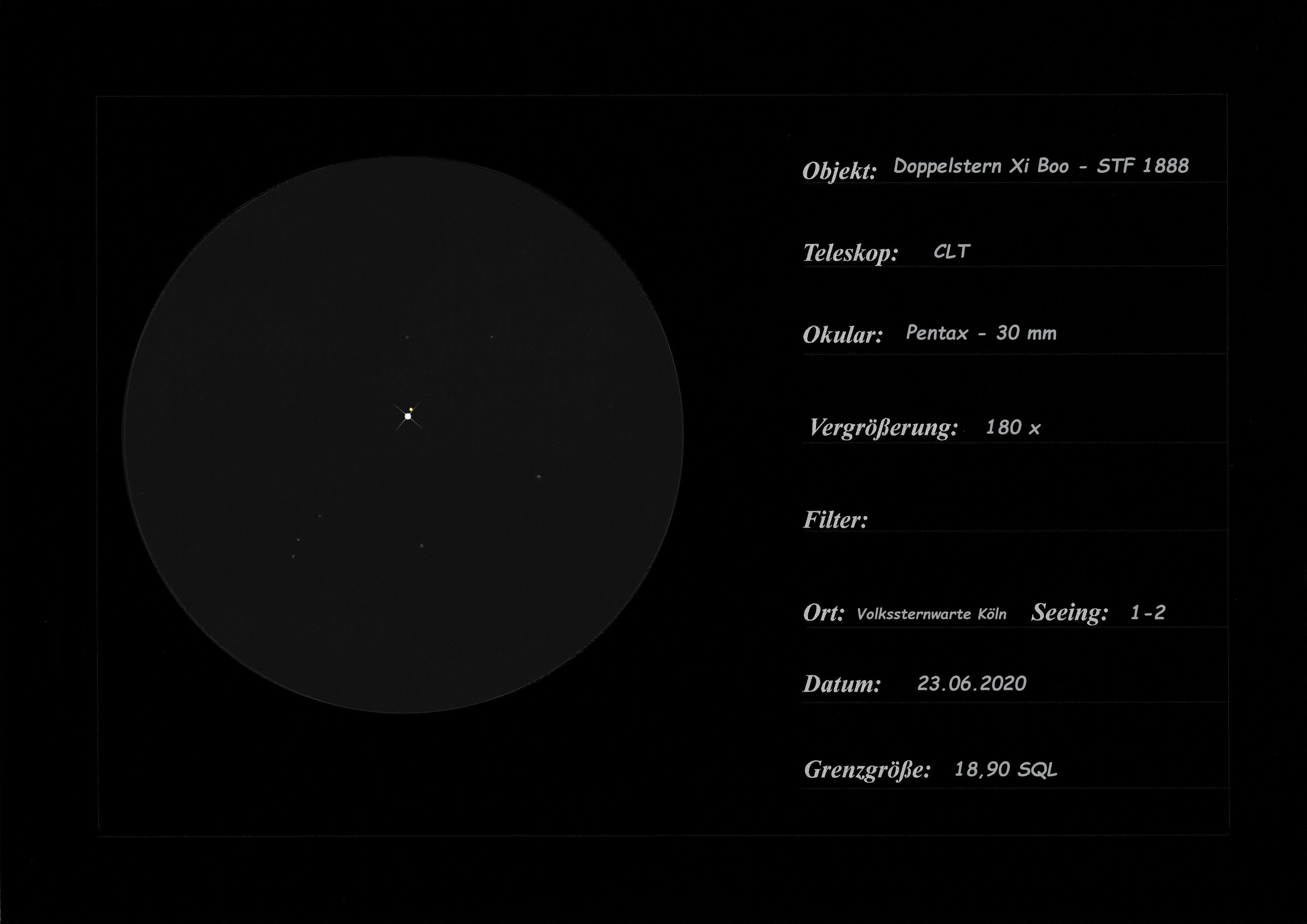
|
|
Frederik Wanink
Itterbeck (Germany) |
254mm |
AB |
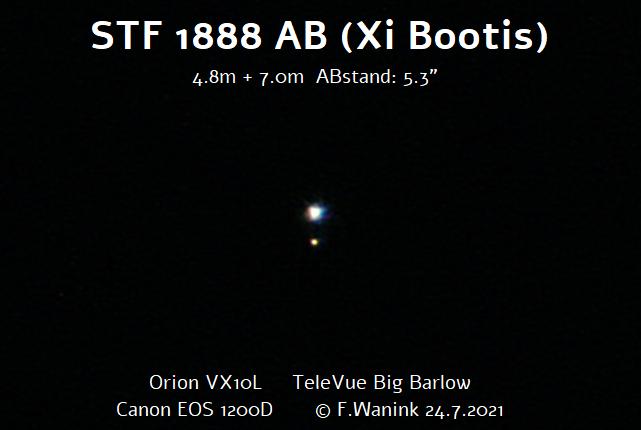
|
|
|
|
HJ2752 |
|
|
8m.3 |
9m.8 |
6.1" |
122° |
2015 |
Boo |
14h51m24.99s / +44°36'34.30" |
Frederik Wanink
Itterbeck (Germany) |
254mm |
Anstatt des gesuchten STT 287 fand ich diesen Stern ganz in der Nähe |
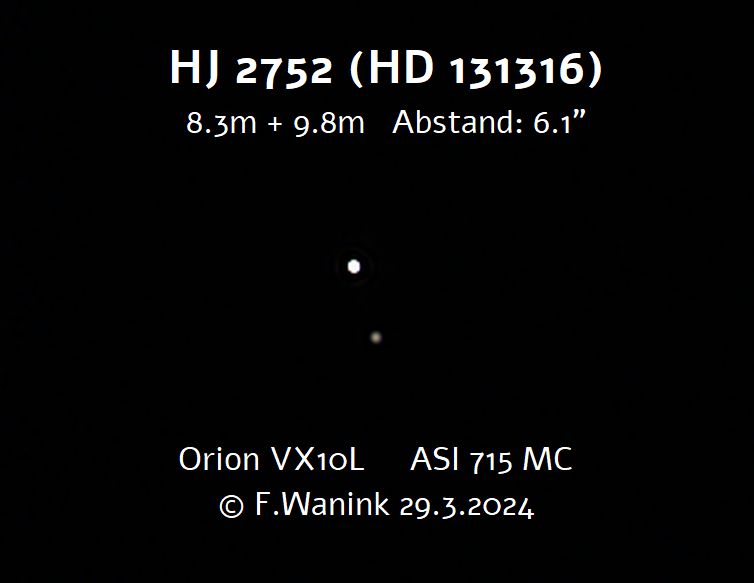
|
|
|
|
STT288 |
|
|
6m.9 |
7m.5 |
1.0" |
154° |
2021 |
Boo |
14h53m23.35s / +15°42'18.30" |
|
|
Mark McCarthy
Fremont (California/USA) |
203mm (333x) |
Consistent split, better with seeing, ~1 delta mag, ~1" separation, blue-white stars |
|
Frederik Wanink
Itterbeck (Germany) |
254mm (640x) |
rel. einfach |

|
Mark McCarthy
Fremont (California/USA) |
317mm (553x) |
Notched / figure 8 with 277x, split with 553x. |
|
Mark McCarthy
Fremont (California/USA) |
317mm (553x) |
Needed 553x to separate, resolved with the seeing. Near equal yellow-white, ~1" or less. |
|
|
Frederik Wanink
Itterbeck (Germany) |
254mm |
|
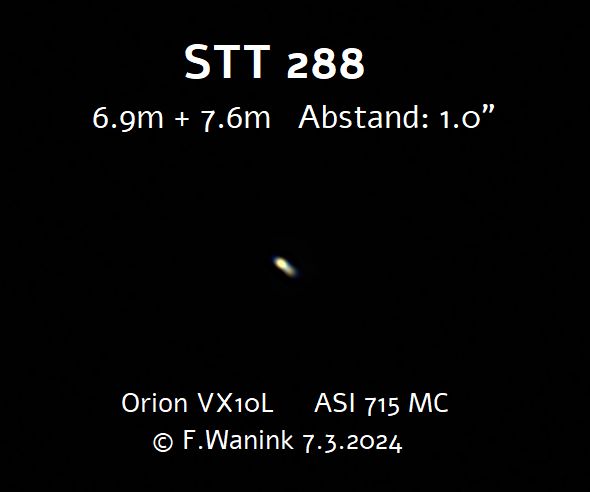
|
|
|
|
STF1910 |
|
|
7m.3 |
7m.5 |
3.9" |
211° |
2019 |
Boo |
15h07m32.95s / +09°13'33.80" |
Robert Zebahl
Leipzig (Germany) |
70mm (44x) |
2020-04-24: At 31x clearly visible as figure '8' and almost separated with similarly bright components. At 44x still very tight, but separated pair. Overall rather faint with little difference in brightness. The primary component appeared slightly yellowish-orange. |
|
René Merting
Drachhausen (Germany) |
100mm (64x) |
bei 32x ist noch nichts auffälliges zu erkennen - bei 64x zeigt sich ein eng stehendes Pärchen zweier gleich heller weißer Sterne, knapp getrennt - ein ziemlicher Sprung von "nichts zu sehen" zu "getrennt zu sehen" |
|
|
Berthold Fuchs
Wiesbaden (Germany) |
130mm |
close DS |
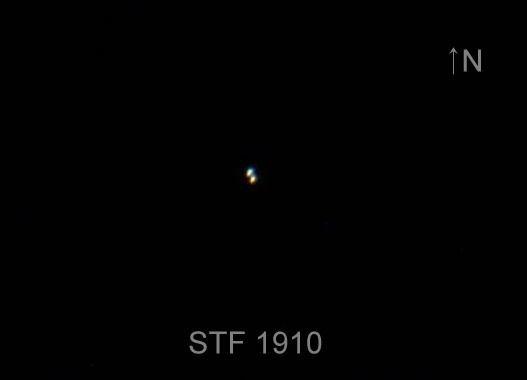
|
|
|
★★
|
STFA27, delta Boo, 49 Boo |
|
AB |
3m.6 |
7m.9 |
105.0" |
78° |
2021 |
Boo |
15h15m30.16s / +33°18'53.40" |
Christopher Hay
Seeheim (Germany) |
15x45 |
Handheld, binoculars with internal stabilisation. Very wide. Component A is of a slight yellow-orange hue, its companion too weak (NELM in target area: 5m0) for colour impression.
Nice in 4.5° FOV with Mu Boo AB, which is visibly slightly wider than Delta Boo and whose component B is slightly brighter than that of Delta Boo.
Delta Boo is a physical double at a distance to us of 122 light years. |
|
René Merting
Drachhausen (Germany) |
18x70 |
ein sehr ungleiches, weit auseinander stehendes Sternpaar - Komponente A im Westen strahlt gleißend cremegelb, die wesentlich schwächere Komponente B im Osten ist weißgrau bis bräunlich |
|
Robert Zebahl
Leipzig (Germany) |
70mm (22x) |
2020-04-24: Widely separated pair with large difference in brightness. Less striking. The bright primary component shines in a bright yellow. |
|
Mark McCarthy
Fremont (California/USA) |
80mm (13x) |
Split in 80mm finder. Very wide pair, very bright A, 3 delta mag B. Orange-yellow and blue-white B |
|
Mark McCarthy
Fremont (California/USA) |
80mm (94x) |
Delta Boo. Wide, large delta mag B, a 76,000-period pair! |
|
Sarah Gebauer
Germany |
100mm (49x) |
bei 49-fach zeigt A ein schönes, zartes Gelb, der weit entfernte Begleiter ist sehr fein, wesentlich schwächer und schafft es nicht über einen grauen Farbeindruck hinaus |
|
René Merting
Drachhausen (Germany) |
107mm (30x) |
bei 30x deutlich getrennt - Komponente A strahlt ein einem seidenen Gelb, B ist mehr als zwei Größenklassen schwächer und wirkt weißlich |
|
Mark McCarthy
Fremont (California/USA) |
203mm (205x) |
Bright star with many nearby faint stars. Didn't bother trying to figure out which are which. |
|
|
Frederik Wanink
Itterbeck (Germany) |
254mm |
|

|
|
|
★
|
STF1937, eta CrB |
|
AB |
5m.6 |
6m.0 |
0.4" |
287° |
2020 |
CrB |
15h23m12.23s / +30°17'17.70" |
Uwe Pilz
Leipzig (Germany) |
120mm (250x) |
Schwierig |

|
Mark McCarthy
Fremont (California/USA) |
203mm (667x) |
8" 333x Suspect elongation. 8" 667x definite egg shape. 20" 667x Can't get a good focus. |
|
Frederik Wanink
Itterbeck (Germany) |
254mm (640x) |
deutlich als 8 zu sehen, 2015 0,6" |
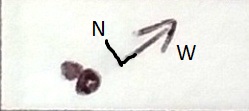
|
Mark McCarthy
Fremont (California/USA) |
317mm (277x) |
Close orange pair, equal mag, snowman shape |
|
Mark McCarthy
Fremont (California/USA) |
317mm (553x) |
Overlapping / notched orange-yellow stars. Used apodising mask. |
|
|
Frederik Wanink
Itterbeck (Germany) |
254mm |
scheint enger als 0.5" |

|
|
|
|
COU610, 4 CrB, theta CrB |
|
|
4m.3 |
6m.3 |
0.8" |
198° |
2016 |
CrB |
15h32m55.78s / +31°21'32.90" |
|
|
Uwe Pilz
Leipzig (Germany) |
120mm (250x) |
blau; gerade eben länglich, PW richtig. Richtung des schwächeren Sterns war erkennbar. |
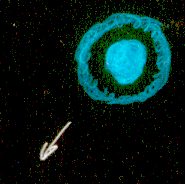
|
Robert Zebahl
Leipzig (Germany) |
152mm (300x) |
2021-07-23: Theta CrB was only a few degrees above the house roof and the refractor was insufficiently cooled down. In no way visible as a double star. I used magnifications from 200x to 400x. |
|
Mark McCarthy
Fremont (California/USA) |
203mm (667x) |
Notched/snowman at best moments. B definitely fainter and almost blue. Very faintly split, looks like a blue appendage. |
|
Frederik Wanink
Itterbeck (Germany) |
254mm (640x) |
nicht als DS gesehen |
|
Mark McCarthy
Fremont (California/USA) |
317mm (738x) |
Tried pretty hard at 553x with apodizing screen, but dances too much. Used 6mm ortho with barlow, 738x, and at best moment it is olive shaped, but marginal. Observation August 2018 |
|
Mark McCarthy
Fremont (California/USA) |
762mm (915x) |
The CrB: Fractured and dancing seeing. 915x, at full aperture and with 8-inch aperture mask, I see a slight out of roundness. |
|
|
Frederik Wanink
Itterbeck (Germany) |
254mm |
|

|
|
|
★
|
STT298 |
|
AB |
7m.2 |
8m.4 |
1.2" |
191° |
2021 |
Boo |
15h36m02.22s / +39°48'08.90" |
|
|
|
|
AB-C |
6m.9 |
7m.8 |
120.4" |
328° |
2017 |
|
|
|
|
|
|
AB-D |
6m.9 |
13m.9 |
167.4" |
224° |
2002 |
|
|
|
|
|
|
AB-E |
6m.9 |
12m.1 |
456.0" |
335° |
2002 |
|
|
|
|
Robert Zebahl
Leipzig (Germany) |
102mm (28x) |
AB-C: Wide, moderately unequal pair. Little difference in color: Primary components appeared a bit more orange colored. |
|
Robert Zebahl
Leipzig (Germany) |
120mm (23x) |
AB-C: Easy to split with large angular distance and noticeable difference in brightness. |
|
Mark McCarthy
Fremont (California/USA) |
203mm (205x) |
AB: At zenith, but worth the effort to slew to. Another great 2+1. The tight pair [AB] is near equal and split a little more than a hairline |
|
Mark McCarthy
Fremont (California/USA) |
317mm (553x) |
AB: One component of compicated 6 star system, some of which is split in 80mm finter. This is a close equal pair, ~2". |
|
|
Frederik Wanink
Itterbeck (Germany) |
254mm |
AB-C |

|
|
|
★★
|
STF1964 & HU1167 |
HU1167 |
AB |
8m.1 |
9m.9 |
1.4" |
80° |
2016 |
CrB |
15h38m12.91s / +36°14'48.60" |
|
|
|
STF1964 |
AC |
8m.1 |
8m.1 |
14.5" |
90° |
2017 |
|
|
|
|
|
STF1964 |
AD |
8m.1 |
9m.0 |
15.1" |
83° |
2018 |
|
|
|
|
|
STF1964 |
CD |
8m.1 |
9m.0 |
1.5" |
21° |
2019 |
|
|
|
|
Robert Zebahl
Leipzig (Germany) |
16x70 |
STF1964 (AC): 2021-06-13: Beautiful double star with components of almost equal brightness and subtle color difference: white-bluish & slightly orange. |
|
René Merting
Drachhausen (Germany) |
18x70 |
STF1964 (AC): zu erkennen sind zwei gleich helle, sehr dicht stehende Sterne - Trennung ein wenig mehr als knapp |
|
René Merting
Drachhausen (Germany) |
100mm (20x) |
STF1964 (AC): bei 20x ein gut getrenntes Pärchen gleich heller Sterne, auffallend im Sternumfeld |
|
Sarah Gebauer
Germany |
100mm (49x) |
STF1964 (AC): zusammen mit STF 1965 im Gesichtsfeld, zwei recht unterschiedliche Doppelsterne - bei 49-fach getrennt, recht hell und besonders eng - der Farbeindruck ist zunächst strahlend weiß, bei 80-fach zeigt A dann einen Gelbtupfer |
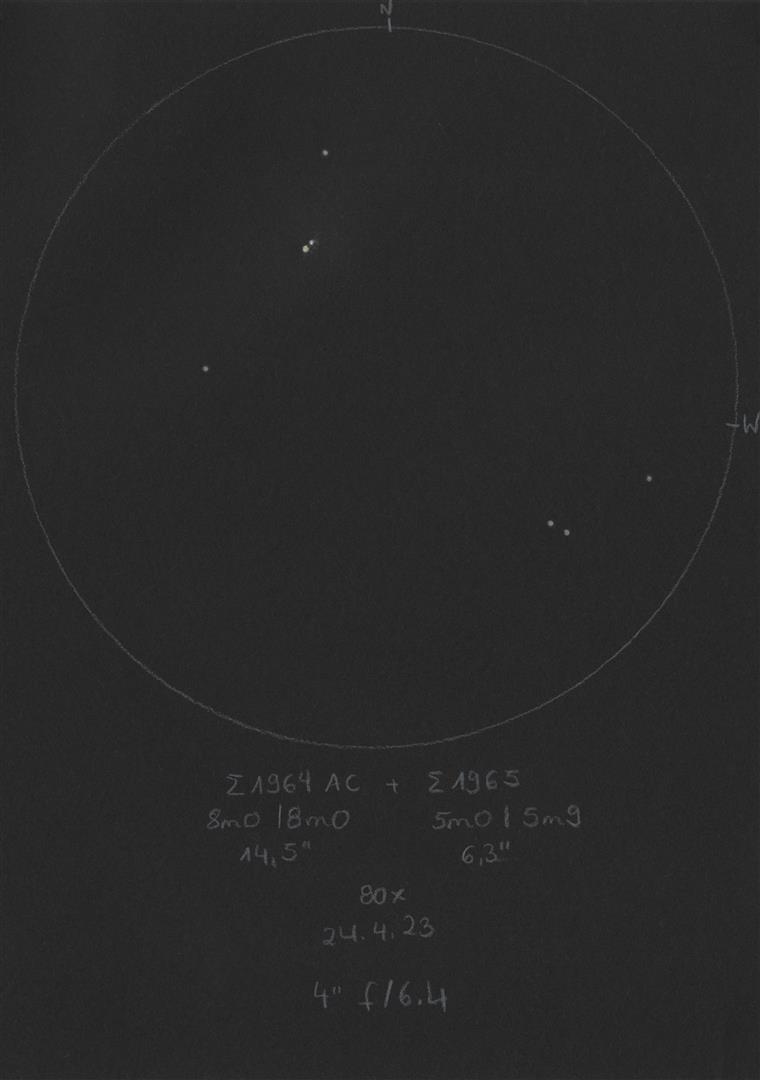
|
Robert Zebahl
Leipzig (Germany) |
102mm (62x) |
STF1964 (AC): Rather wide pair, equal without visible difference in color. |
|
Uwe Pilz
Leipzig (Germany) |
105mm (16x) |
Dreifachstern nicht trennbar |
|
René Merting
Drachhausen (Germany) |
107mm (30x) |
STF1964 (AC): bei 30x ein kleines, feines Paar zweier gleich heller Sterne - gleiche Farbe - schöner Anblick zusammen mit STF 1965 |
|
Robert Zebahl
Leipzig (Germany) |
120mm (23x) |
STF1964 (AC): Nice double star, well split with equally bright components. |
|
Mark McCarthy
Fremont (California/USA) |
317mm (277x) |
STF1964 (AC): Well split equal pair. I suspect B is pair as it is an elongated orange smear at 277x -- it is STF 1964CD. |
|
Mark McCarthy
Fremont (California/USA) |
317mm (553x) |
STF1964 (CD): Faint near equal pair about 3" separation. In the same field with HU 1167. Magnificent |
|
Mark McCarthy
Fremont (California/USA) |
317mm (553x) |
HU1167 (AB): Bright star with much fainter pair, about 1" separation, 3-4 delta mag. In same field with STF 1964. Magnificent |
|
|
Frederik Wanink
Itterbeck (Germany) |
254mm |
STF1964 (CD) |

|
|
|
★
|
STF1965, zeta CrB, zeta 1/2 CrB, 7 CrB |
|
|
5m.0 |
5m.9 |
6.4" |
306° |
2021 |
CrB |
15h39m22.68s / +36°38'09.00" |
Robert Zebahl
Leipzig (Germany) |
16x70 |
2021-06-14: A slight elongation can be guessed at best. |
|
Axel Tute
Küssaberg (Germany) |
70mm (58x) |
30.05.2009: A light blue, B greenish |
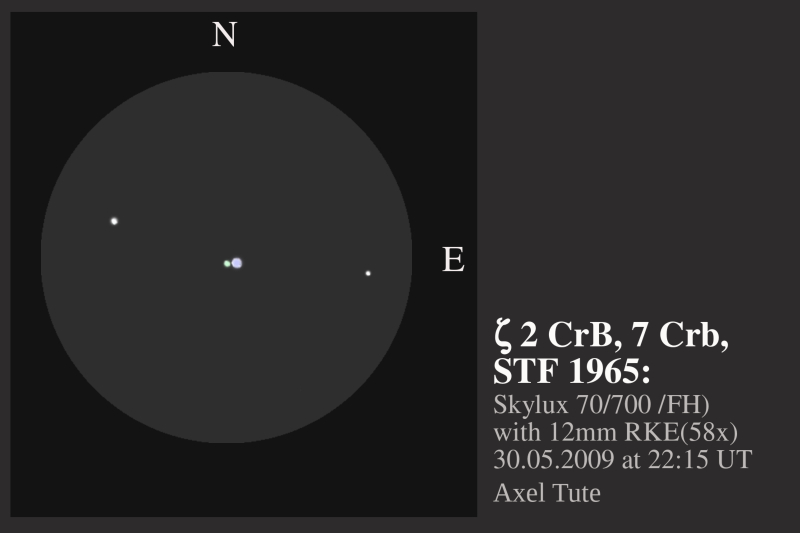
|
René Merting
Drachhausen (Germany) |
100mm (32x) |
bei 32x ein knapp getrenntes deutlich helleres Pärchen als der 27' südwestlich stehende Doppelstern STF1964 - Komponente B ist gut eine Größenklasse schwächer als A - beide Komponenten schmiegen sich meist noch aneinander, aber in guten Momenten sind beide getrennt sichtbar - zurück auf 20x ist ein länglicher Stern erkennbar |
|
Sarah Gebauer
Germany |
100mm (49x) |
zusammen mit STF 1964 im Gesichtsfeld, zwei recht unterschiedliche Doppelsterne - bei 49-fach getrennt, ein eher schwächeres Paar und etwas weiter getrennt |

|
Robert Zebahl
Leipzig (Germany) |
102mm (28x) |
At 28x very tight and barely split, unequal. At 86x very nice view. No difference in color: both components appeared white. |
|
Stefan Loibl
Rosenheim (Germany) |
102mm (68x) |
Elongated at 28x, split with 68x. Component A blue, B reddish. At 68x double star STF1964 in the same FOV |
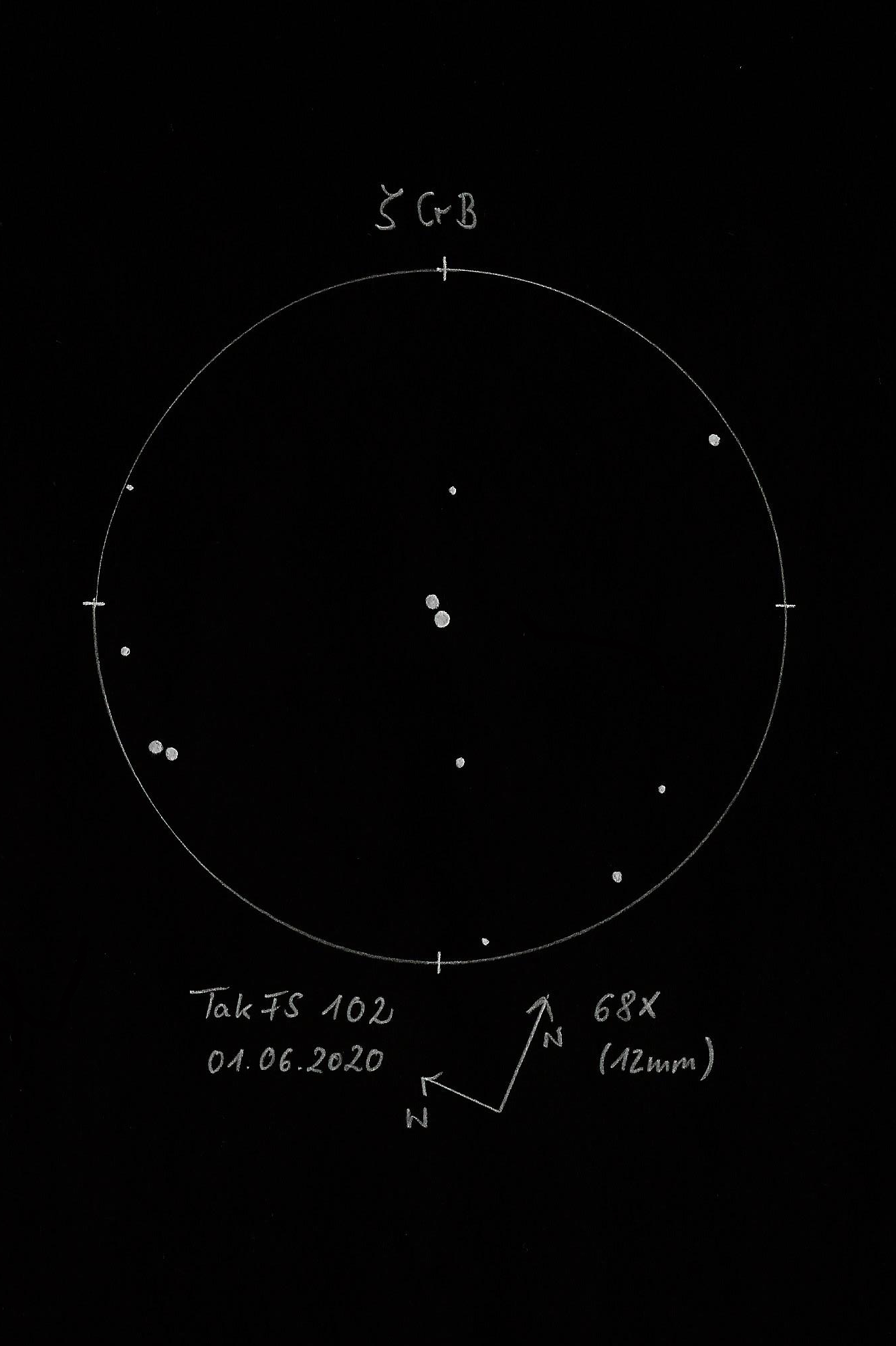
|
René Merting
Drachhausen (Germany) |
107mm (43x) |
bei 30x sehe ich zwei ungleiche Sterne mit Einschnürung kurz vor der Trennung - bei 43x zeigt sich ein knapp getrenntes Sternpaar - A schimmert Gelblichweiß, B ist eine Größenklasse schwächer und richtig schön weiß |
|
Robert Zebahl
Leipzig (Germany) |
120mm (48x) |
Very nice double star, well split with noticeable difference in brightness. |
|
Mark McCarthy
Fremont (California/USA) |
317mm (277x) |
Bright white, well separated, ~1 delta mag. |
|
Karsten Kopp
Köln (Germany) |
600mm (180x) |
Doppelstern konnte gut getrennt werden. Der Helligkeitsunterschied ist nicht sehr groß und der etwas hellere Stern erscheint weißlich und der schwächere geht eher ins bläulich weiße. |
|
|
Frederik Wanink
Itterbeck (Germany) |
254mm |
|
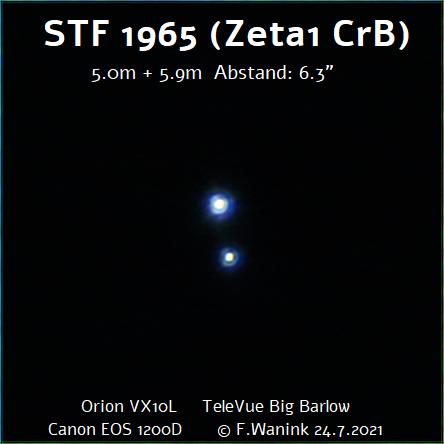
|
Frederik Wanink
Itterbeck (Germany) |
254mm |
|

|
|
|
★
|
BU810 |
|
|
9m.1 |
10m.8 |
1.6" |
84° |
2016 |
Her |
15h51m00.24s / +42°27'59.50" |
Mark McCarthy
Fremont (California/USA) |
508mm (667x) |
Very cool, light orange and blue, close but very good split. 2 delta mag. |
|
|
Frederik Wanink
Itterbeck (Germany) |
254mm |
|

|
|
|
|
STF1991 |
|
AB |
9m.4 |
10m.4 |
3.0" |
195° |
2019 |
Her |
15h57m26.92s / +41°39'42.90" |
|
|
|
|
AC |
9m.4 |
8m.8 |
95.0" |
87° |
2015 |
|
|
Robert Zebahl
Leipzig (Germany) |
102mm (86x) |
2021-08-20: The pair AB-C is easily visible already at 28x, with C being the brightest component and standing apart quite far from AB. At 86x the much closer pair AB is then also easily visible. The separation is easy, but the companion B is quite faint. Component C appeared slightly yellowish, A a bit darker. A nice triple system, which reminds me of mu Bootis. |
|
|
Frederik Wanink
Itterbeck (Germany) |
254mm |
|

|
|
|
|
BU355 |
|
AB |
7m.5 |
8m.8 |
0.2" |
287° |
2001 |
Her |
16h07m59.39s / +45°22'49.10" |
Mark McCarthy
Fremont (California/USA) |
508mm (1334x) |
Subtle notch / peanut shape only at all powers, PA on EW line though difficult to tell which is the primary, light orange stars (spectral class K0, yellow-orange). Burnham discovered with his 6-inch at 0.3" in 1876. WDS uncertain of binarity, and unfortunately Gaia only has data for the primary |
|
|
Frederik Wanink
Itterbeck (Germany) |
254mm |
Doppelsternnatur hier nicht zu sehen |

|
|
|
★
|
STF2015 |
|
AB |
8m.2 |
9m.5 |
3.0" |
159° |
2019 |
Her |
16h08m54.75s / +45°21'11.80" |
|
|
|
|
AC |
8m.2 |
13m.8 |
8.9" |
102° |
2015 |
|
|
|
|
|
|
BC |
9m.5 |
13m.8 |
9.0" |
102° |
2007 |
|
|
René Merting
Drachhausen (Germany) |
100mm (107x) |
AB: bei 107x ist Komponente B südlich von A knapp getrennt erkennbar - Helligkeitsunterschied eine knappe Größenklasse, dadurch wirkt B nicht ganz so reinweiß wie A |
|
Mark McCarthy
Fremont (California/USA) |
203mm (205x) |
AB: ! Blue-white A and white-blue B (which is to say A is white with a tinge of blue, and B is blue with a tinge of white) ~3", ~2 delta mag |
|
Karsten Kopp
Köln (Germany) |
600mm (180x) |
AB: Doppelstern ist gut zu trennen. Der Helligkeitsunterschied ist merklich, aber nicht markant. Der hellere leuchtet weißlich und der schwächere eher gelblich. |
|
|
Frederik Wanink
Itterbeck (Germany) |
254mm |
|

|
|
|
|
STF2028 |
|
|
9m.9 |
9m.1 |
0.5" |
147° |
2016 |
CrB |
16h12m48.11s / +39°21'35.60" |
|
|
Mark McCarthy
Fremont (California/USA) |
508mm (533x) |
Nice delicate split with 445x, well split clean with 533x, white stars, ~1 delta, PA to SE. Grade 3 orbit, 105.34-year period, 0.519" now it's at apastron now and will sit there until 2050 when it will start close again in its nearly edge-on orbit |
|
|
Frederik Wanink
Itterbeck (Germany) |
254mm |
|

|
Frederik Wanink
Itterbeck (Germany) |
254mm |
|

|
|
|
|
A1642 |
|
|
8m.9 |
9m.4 |
0.8" |
181° |
2016 |
Her |
16h13m43.62s / +46°38'23.10" |
|
|
Mark McCarthy
Fremont (California/USA) |
508mm (333x) |
Momentarily split with seeing, ~2 delta mag, <1". 188 year period |
|
|
Frederik Wanink
Itterbeck (Germany) |
254mm |
|

|
|
|
|
KUI72 |
|
AB |
5m.5 |
10m.0 |
3.2" |
125° |
2016 |
Her |
16h19m55.24s / +39°42'30.90" |
|
|
Mark McCarthy
Fremont (California/USA) |
317mm (553x) |
Distinct faint point appears with perfect seeing ~2-3". Much smaller and fainter than A. |
|
|
Frederik Wanink
Itterbeck (Germany) |
254mm |
Komponente B nur schwach zu sehen |

|
|
|
|
STF2047 |
|
|
8m.5 |
8m.7 |
1.8" |
325° |
2019 |
Her |
16h23m08.85s / +47°37'48.40" |
Mark McCarthy
Fremont (California/USA) |
508mm (333x) |
Bright light yellow-white stars, wide ~2" |
|
|
Frederik Wanink
Itterbeck (Germany) |
254mm |
|

|
|
|
★
|
STF2059 |
|
|
8m.8 |
8m.8 |
0.3" |
179° |
2016 |
Her |
16h30m55.71s / +38°03'52.60" |
|
|
Frederik Wanink
Itterbeck (Germany) |
254mm (640x) |
nicht als DS gesehen |
|
Mark McCarthy
Fremont (California/USA) |
317mm (553x) |
Overlapping disks, notched. Need perfect seeing. This was 1.2" at Struve's discovery, so easier for him to see -- I doubt he would have found it now, near its closest separation. August 2017 |
|
|
Frederik Wanink
Itterbeck (Germany) |
254mm |
Doppelsternnatur nicht zu sehen |

|
|
|
★
|
STT313 |
|
|
8m.0 |
8m.3 |
0.9" |
128° |
2018 |
Her |
16h32m33.19s / +40°06'47.70" |
Frederik Wanink
Itterbeck (Germany) |
254mm (640x) |
mit Zwischenraum zu sehen |

|
Mark McCarthy
Fremont (California/USA) |
317mm (553x) |
Clean split, near equal pair. Nice |
|
|
Frederik Wanink
Itterbeck (Germany) |
254mm |
|

|
|
|
★★★
|
STF2078 & STFA30, 16/17 Dra |
STF2078, 17 Dra |
AB |
5m.4 |
6m.4 |
2.9" |
104° |
2021 |
Dra |
16h36m13.72s / +52°55'27.80" |
|
|
|
STFA30, 16/17 Dra |
AC |
5m.4 |
5m.5 |
90.2" |
193° |
2018 |
|
|
Christopher Hay
Seeheim (Germany) |
3x63 |
Clean split. Separation is much clearer than that of Nu1/2 Dra (STFA35), which is also in 14° FOV and is hair-fine split.
A physical double at a distance to us of 412 light years. |
|
Christopher Hay
Seeheim (Germany) |
7x45 |
A well split and nicely compact pair. When 16/17 Dra is put at the edge of the 8.6° field of view, Nu1/2 Dra stands at the opposite edge. Their comparison thus suggests itself. 16/17 is somewhat wider than Nu1/2. While the components of Nu1/2 are of equal brightness and whiteness, those of 16/17 display a slight difference in both brightness and colour. 17 (A) first seems bluer than 16 (C), but after 20 seconds this impression flips to C and from then on goes back and forth. |
|
Robert Zebahl
Leipzig (Germany) |
55mm (27x) |
STFA30 (AC): Rather wide pair with almost equal components. C component appeared slightly yellowish-orange. |
|
Robert Zebahl
Leipzig (Germany) |
55mm (71x) |
Grand sight! |

|
Christopher Hay
Seeheim (Germany) |
80mm (30x) |
16 Dra seems more bluish than 17 Dra, the latter seems slightly yellow in comparison and is distinctly elongated. At 84x 17 Dra is cleanly split and such a delightful view together with 16 Dra that I had no desire to ramp up the magnification. All three stars belong to a physical system. |
|
Sarah Gebauer
Germany |
100mm (80x) |
01.10.23: das Doppel 16/17 Dra zeigt bei 80-fach zum ersten Mal eine feine, warmweiße B-Komponente extrem knapp östlich neben der warmweißen, leicht gelblichen A-Komponente - Komponente C im Süden strahlt reinweiß und wirft einen ebenso großen Halo wie AB zusammen, sodass sich beide Halos überlagern - die D-Komponente ist als grauer, schwacher Stern südöstlich versetzt zu sehen |

|
René Merting
Drachhausen (Germany) |
100mm (107x) |
AB: bei 64x noch ein Stäbchen, bei 107x ist B dann knapp getrennt östlich von A erkennbar - B ist auch noch relativ hell bzw. maximal eine Magnitude schwächer
AC: bei 32x weit auseinander stehend - Komponente C im Süden ist maximal eine viertel Magnitude schwächer - leichter Farbkontrast, A weißgelb und C kühlweiß |
|
Frederik Wanink
Itterbeck (Germany) |
254mm (640x) |
STF2078 (AB): sehr schönes Dreiersystem |
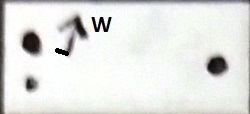
|
|
Frederik Wanink
Itterbeck (Germany) |
254mm |
STF2078 (AB) |

|
|
|
|
STF2091 |
|
|
8m.4 |
9m.3 |
0.4" |
328° |
2012 |
Her |
16h42m09.74s / +41°11'42.90" |
|
|
Frederik Wanink
Itterbeck (Germany) |
254mm (640x) |
nicht als DS gesehen |
|
Mark McCarthy
Fremont (California/USA) |
317mm (553x) |
I "see" rod shape once I know it is 0.4" separation. Marginal. (This one 1.3" at Struve's discovery, so easy for him! August 2017) |
|
|
Frederik Wanink
Itterbeck (Germany) |
254mm |
Doppelsternnatur nicht zu sehen |

|
|
|
|
D15 |
|
|
9m.0 |
9m.3 |
0.6" |
335° |
2016 |
Her |
16h43m56.29s / +43°28'31.20" |
|
|
Mark McCarthy
Fremont (California/USA) |
317mm (553x) |
Light orange elongated, with notch, near equal. (0.9" at discovery). |
|
Mark McCarthy
Fremont (California/USA) |
508mm (333x) |
Close split with seeing, slight mag difference, ivory white stars |
|
|
Frederik Wanink
Itterbeck (Germany) |
254mm |
|

|
|
|
|
STF2098 |
|
AB |
8m.8 |
9m.6 |
14.2" |
145° |
2017 |
Her |
16h45m43.47s / +30°00'17.20" |
|
|
|
|
AC |
8m.8 |
8m.8 |
65.6" |
128° |
2017 |
|
|
|
|
|
|
AD |
8m.8 |
11m.0 |
67.6" |
18° |
2015 |
|
|
|
|
|
|
DE |
11m.0 |
13m.7 |
5.8" |
268° |
2015 |
|
|
Robert Zebahl
Leipzig (Germany) |
102mm (86x) |
Already at 28x the components A, B and C were noticeable at first view. At 86x, component D could also be observed very well. The components are all comparatively far apart. |

|
Mark McCarthy
Fremont (California/USA) |
317mm (553x) |
AB: 4 stars in an arc. Assume AB is the closer pair ~1 delta mag. All wide. (5 stars in 5 pairings) |
|
Mark McCarthy
Fremont (California/USA) |
508mm (333x) |
AB: AB, AC, AD, four star system all within a mag of each other, forming a gentle arc. (Actually 5 stars, I missed DE which is 13th mag. Says it's physical -- all 5 are?) |
|
|
John Raymond
Richmond (Virginia/USA) |
|
Taken in 2017 with 18” Dobsonian. Single images with Canon M3 camera, <30s |
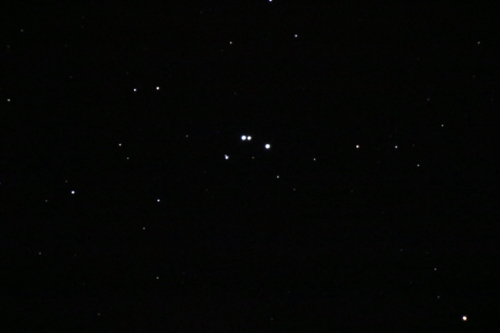
|
|
|
|
HU1178 & STF2136 & WAL78 |
HU1178 |
AB |
9m.2 |
9m.3 |
0.3" |
8° |
2016 |
Her |
17h11m34.85s / +39°15'31.40" |
|
|
|
STF2136 |
AB-C |
8m.5 |
10m.5 |
15.3" |
112° |
2020 |
|
|
|
|
|
WAL78 |
AB-E |
8m.5 |
12m.8 |
57.4" |
311° |
2020 |
|
|
|
|
|
HU1178 |
CD |
10m.5 |
13m.5 |
1.4" |
77° |
2016 |
|
|
|
|
René Merting
Drachhausen (Germany) |
107mm (60x) |
STF2136 (AB-C): bei 60x strahlt AB schon eher schwach, C ist lediglich ein etwas mehr als knapp abgesetzter Schatten von AB |
|
|
Frederik Wanink
Itterbeck (Germany) |
254mm |
Bildaufhellung nötig, um die Komponenten D und E darzustellen |

|
|
|
★★
|
STF2140, alpha Her, 64 Her, Ras Algethi |
|
AB |
3m.5 |
5m.4 |
4.7" |
103° |
2020 |
Her |
17h14m38.86s / +14°23'24.90" |
|
|
Christopher Hay
Seeheim (Germany) |
36mm (50x) |
At 50x secondary detaches momentarily from first diffraction ring of primary as the tiniest pinprick of light, delta-mag seems massive.
At 66x separation becomes much clearer. Can hold secondary 80% of the time as a fine point on the outer rim of the first diffraction ring. Primary is orange-yellow, secondary far too faint in this aperture for any kind of colour impression. Rather charming in a strange sort of way. See for comparison simultaneous observation with 210mm at 68x. |
|
Robert Zebahl
Leipzig (Germany) |
55mm (41x) |
Well split with noticeable difference in brightness. |
|
René Merting
Drachhausen (Germany) |
100mm (64x) |
bei 32x ist noch nichts erkennbar - bei 64x wird östlich von Rasalgethi der schwache Begleiter B knapp getrennt sichtbar - A ist strahlend gelb, B mit einer Tendenz zum gelb, eher ein warmes weiß |
|
Uwe Pilz
Leipzig (Germany) |
105mm (88x) |
himmelblau und hellgelb, getrennt bei 53x |
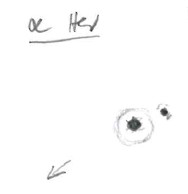
|
Uwe Pilz
Leipzig (Germany) |
105mm (288x) |
gelb-lachsfarben |
|
René Merting
Drachhausen (Germany) |
107mm (86x) |
bei 30x zeigt sich das Paar noch zusammen und zeigt ein auffallendes Gelb - bei 86x präsentiert sich A in Zitronenschalengelb, im Südosten zeigt sich knapp getrennt die B-Komponente, zwar deutlich schwächer, aber immernoch hell und auch farblich ein schwächerer Abklatsch von A in Hellgelb |
|
Robert Zebahl
Leipzig (Germany) |
120mm (100x) |
Easily split with noticeable difference in brightness. A: intensively orange colored, B: slightly orange. |
|
Christopher Hay
Seeheim (Germany) |
125mm (133x) |
At 133x split well and showing a fine colour contrast, orange / grey-blue. Each step to 160x, 200x and finally 266x benefits the aesthetic experience, drawing the pair apart and making the colour contrast clearer. At 266x primary is yellowish orange and secondary exhibits a fine grey-blue. Fine diffraction pattern at 266x with first ring around secondary and hint of a second ring around primary. |
|
Karsten Kopp
Köln (Germany) |
140mm (94x) |
Konnte erst mit 94-facher Vergrößerung gut getrennt wahrgenommen werden. |
|
Sarah Gebauer
Germany |
150mm (85x) |
bei Halbmond auf der Schwäbischen Alb: sehr eng, aber sauber getrennt, eine Komponente ist viel heller und größer, mein Farbeindruck ist allerdings unerwartet eher gelb |
|
Sarah Gebauer
Germany |
150mm (160x) |
richtig gold, es strahlt mich richtiggehend an, auch sehr schön getrennt, ein toller Doppelstern! |
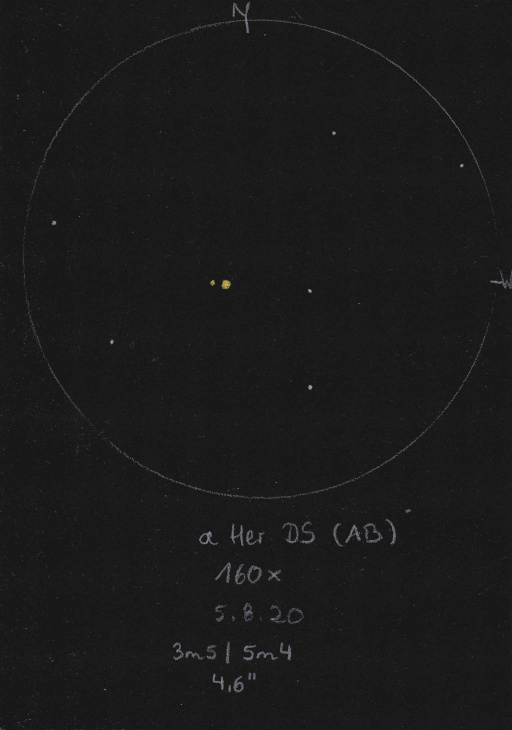
|
Mark McCarthy
Fremont (California/USA) |
152mm (175x) |
Rasalgethi. Wow best ever view, perfect disks with no flaring. Light orange A and 2 delta mag light aqua B. Physical with a 3600-year period |
|
Mark McCarthy
Fremont (California/USA) |
203mm (667x) |
Rasalgethi. 8" inch mask due to seeing. AB orange and blue 4 delta mag. Faint AD seen very wide separation. pretty star. |
|
Christopher Hay
Seeheim (Germany) |
210mm (68x) |
Despite the primary being a little bloated in mediocre seeing, the secondary is set off clearly as a fine pinprick of light. Both are orangish-yellow. A very charming sight. See for comparison simultaneous observation with 36mm at 66x. |
|
Sarah Gebauer
Germany |
254mm (96x) |
bei 96-fach ein sehr enges Pärchen mit einem weiten Lichthof, das hübsch umkreist wird von etwa einem halben Dutzend schwacher Sterne – beide Komponenten leuchten in einem warmen Gold, die Hauptkomponente deutlich heller und stärker |
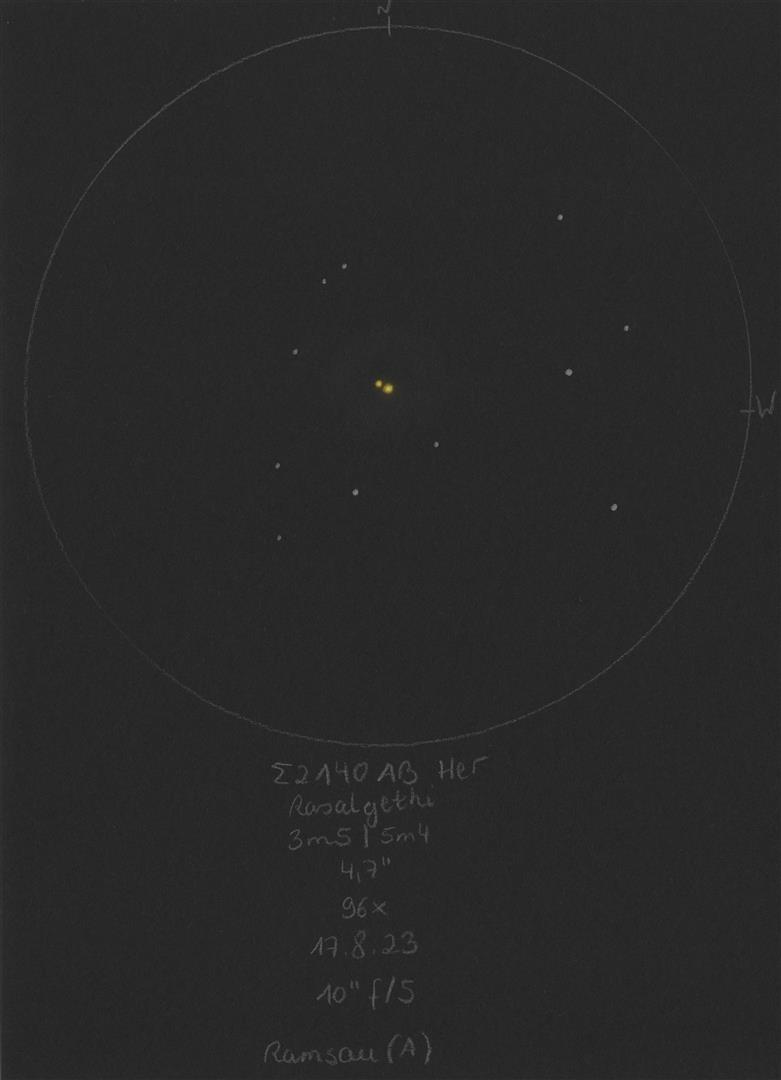
|
Christopher Hay
Seeheim (Germany) |
254mm (170x) |
At this power the components are drawn far enough apart, and there is enough exit pupil with this aperture, to clearly see a charming contrast of two different types of yellow. The primary is distinctly orangish, while the secondary is lemon yellow. The FOV of a little under 0.5° frames the pair well. At lower powers the primary swamps the secondary and both appear similarly orange-yellow. |
|
Frederik Wanink
Itterbeck (Germany) |
254mm (640x) |
gelblich und bläulicher Stern |

|
Mark McCarthy
Fremont (California/USA) |
317mm (277x) |
Rasalgethi, Bright orange A & pale green much fainter B. Very nice! |
|
Karsten Kopp
Köln (Germany) |
600mm (135x) |
Leicht zu trennen. Komponente A erscheint orange, Komponente B gelblich. |
|
Karsten Kopp
Köln (Germany) |
600mm (180x) |
Doppelstern ist gut zu trennen. Komponente A erstrahlt orange und Komponente B gelblich. |

|
|
Frederik Wanink
Itterbeck (Germany) |
254mm |
|
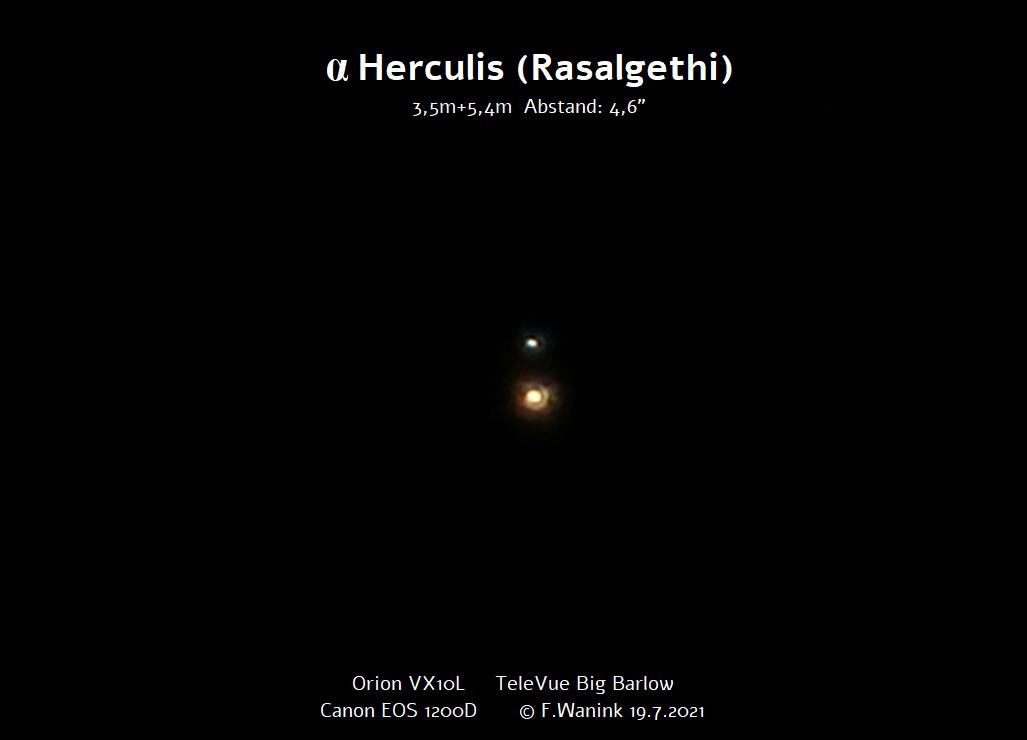
|
Jens Leich
Germany |
130mm |
|

|
|
|
★
|
STF2161, 75 Her, rho Her |
|
AB |
4m.5 |
5m.4 |
4.0" |
321° |
2021 |
Her |
17h23m40.97s / +37°08'45.30" |
Robert Zebahl
Leipzig (Germany) |
55mm (38x) |
Very nice view. Easily split with visible difference in brightness. Pretty tight. Component A appeared rather white, B slightly yellowish. The double star forms with two other, fainter field stars a conspicuous, acute-angled triangle, whereby the double star marks the tip. |
|
Axel Tute
Küssaberg (Germany) |
70mm (117x) |
01:07.2009: Simple. A light blue. B light green. |
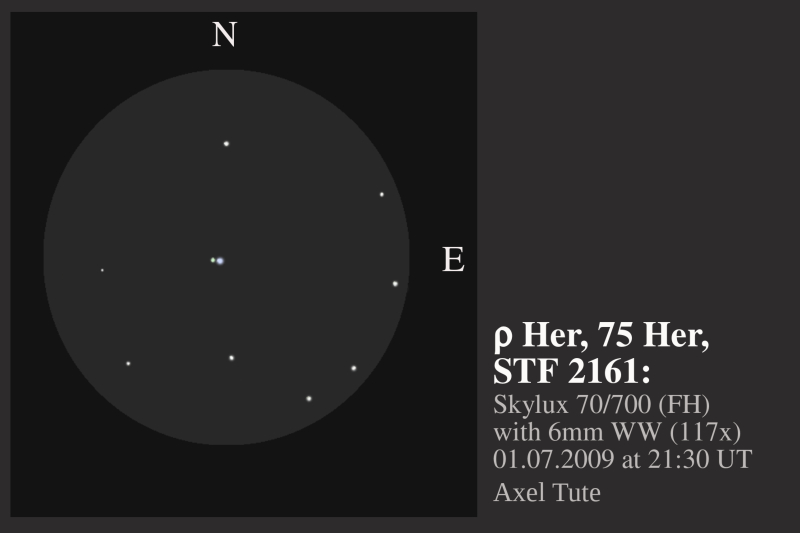
|
Sarah Gebauer
Germany |
100mm (49x) |
bei 50-fach vermutlich das engste bisher getrennte Doppel-Doppel, das ich kenne, zusammen mit STT 329 - der STF-Doppelstern ist der deutlich hellere und engere der beiden und zeigt zudem warmweiße Komponenten mit Gelbhauch mit deutlichem Helligkeitsunterschied |
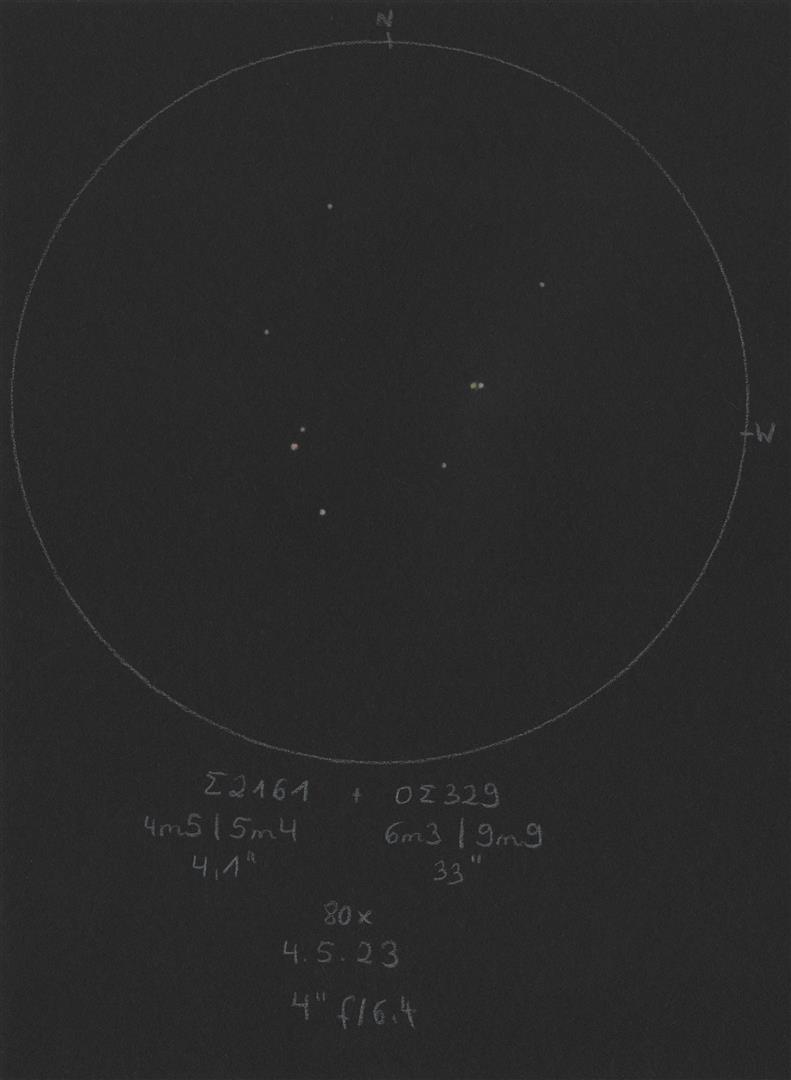
|
René Merting
Drachhausen (Germany) |
100mm (64x) |
bei 107x sind beide Komponenten klar getrennt erkennbar - Komponente B im NW ist eine knappe Größenklasse schwächer - A creme-weiß, B kühler weiß-bläulich - zurück auf 64x kann ich den Doppelstern auch schon ganz knapp getrennt erkennen, da war ich wohl nicht mutig genug, dass ich mit 107x begonnen habe |
|
René Merting
Drachhausen (Germany) |
107mm (86x) |
bei 86x wunderbar anzusehen, etwas mehr als knapp getrennt, B im Westen ist eine knappe Größenklasse schwächer - bei längerem Hinsehen zeigt sich ein dezenter Farbkontrast von der warmweißen A-Komponente mit einem Hauch Hellgelb zu der kühlweißen B-Komponente |
|
Sarah Gebauer
Germany |
150mm (170x) |
der typische Doppelstern für mich, er bildet mit zwei ählich hellen Sternen ein schönes, langes und spitzes Dreieck |

|
Mark McCarthy
Fremont (California/USA) |
152mm (175x) |
Rho Her. Lovely cream-white stars, half delta mag, nice split |
|
Mark McCarthy
Fremont (California/USA) |
203mm (667x) |
Rho Her. Light yellow white stars 1 delta mag well separated. |
|
|
Frederik Wanink
Itterbeck (Germany) |
254mm |
|

|
|
|
★★★
|
STF2202, 61 Oph |
|
AB |
6m.1 |
6m.5 |
20.8" |
92° |
2019 |
Oph |
17h44m34.09s / +02°34'45.90" |
René Merting
Drachhausen (Germany) |
8x30 |
die B-Komponente ist östlich von A erkennbar, lässt sich aber noch nicht trennen - eine klassische Ameise |
|
René Merting
Drachhausen (Germany) |
10x35 |
ein richtig schöner Doppelstern für 10-fache Vergrößerung - zwei gleich helle Sterne, knapp getrennt |
|
René Merting
Drachhausen (Germany) |
10x50 |
ein ausgesprochen schönes knapp getrenntes Sternpaar - beide Sterne sind in etwas gleich hell - Komponente B im Osten ist nicht ganz so weiß wie A |
|
René Merting
Drachhausen (Germany) |
15x56 |
wunderschön - ein sauber getrenntes Sternpaar, wobei B im Osten nur minimal schwächer wirkt - beide Sterne zeigen sich strahlend weiß |
|
René Merting
Drachhausen (Germany) |
16x70 |
ein schön eng stehendes Pärchen, knapp getrennt - Komponente A im Westen ist nur leicht heller als B - beide Komponenten wirken weiß |
|
Uwe Pilz
Leipzig (Germany) |
16x70 |
beide gelb |
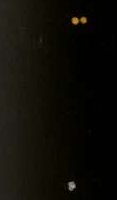
|
René Merting
Drachhausen (Germany) |
100mm (20x) |
bei 20x leicht zu trennen - Komponente B im Osten ist nur minimal schwächer (keine halbe Größenklasse, denke ich) - Komponente A stahlt ein wenig wärmer als B |
|
Sarah Gebauer
Germany |
150mm (30x) |
bei geringer Vergrößerung (30x) schon sauber getrennt, beide Sterne wirken gleich groß und gleich hell, ein nettes Pärchen |
|
Sarah Gebauer
Germany |
150mm (54x) |
zwei nicht ganz enge Glanzpünktchen in einer eher uninteressanten Umgebung |
|
Mark McCarthy
Fremont (California/USA) |
203mm (667x) |
Half delta mag wide separation white. |
|
|
Berthold Fuchs
Wiesbaden (Germany) |
130mm |
easy DS |
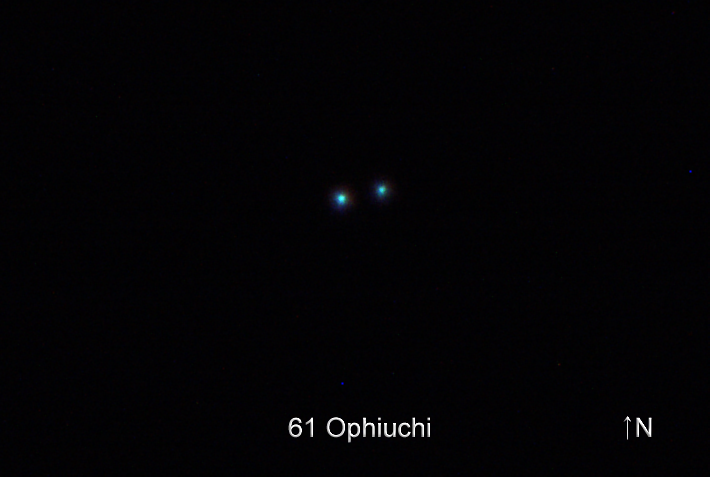
|
|
|
★
|
STF2264, 95 Her |
|
|
4m.8 |
5m.2 |
6.4" |
255° |
2020 |
Her |
18h01m30.41s / +21°35'44.80" |
Axel Tute
Küssaberg (Germany) |
70mm (117x) |
16.07.2009: Both light yellow. |

|
René Merting
Drachhausen (Germany) |
100mm (32x) |
bei 32x mein erster Eindruck ist, dass zwei annähernd gleichhelle sehr eng stehende Sterne mich wie zwei Augen anschauen, das unmittelbare Sternumfeld passt schön und verleiht dem Doppel eine hervorgehobene Stellung - Komponente B im Westen ist nur minimal schwächer als A - in guten Momenten ist die Trennung sehr eindeutig erkennbar |
|
René Merting
Drachhausen (Germany) |
100mm (64x) |
bei 64x zwei helle, knapp getrennte Sterne - die schwächere westliche Komponente zeigt ein schönes, helles Gelb und wirkt dadurch leicht schwächer - zurück auf 32x ist eine 8 mit deutlicher Einschnürung erkennbar - der Farbunterschied ist ebenfalls deutlich |
|
Sarah Gebauer
Germany |
100mm (80x) |
24.09.23: bei 49x ein enger, getrennter DS, bestehend aus zwei sehr hellen, dominanten Murmelchen, die buttergelb strahlen - bei 80x wird der Anblick schöner, der Farbton intensiviert sich ins Dunklere, die beiden ganz engen Lichtpünktchen sind das Highlight im Gesichtsfeld, das Umfeld hält sich sehr zurück - durch den geringen Abstand der Komponenten etwas Besonderes |
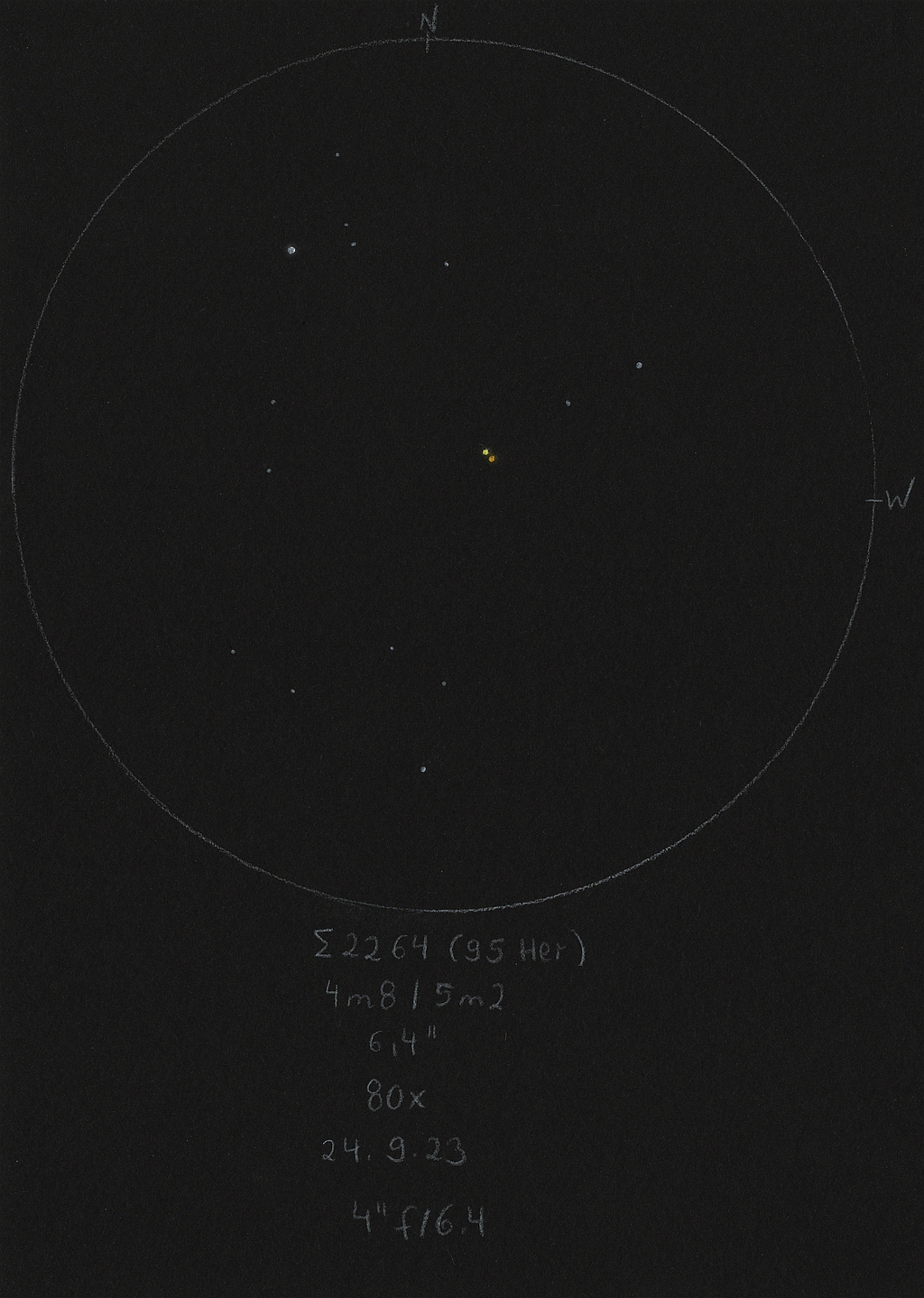
|
Uwe Pilz
Leipzig (Germany) |
105mm (288x) |
|
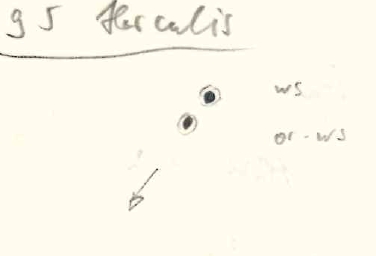
|
Karsten Kopp
Köln (Germany) |
140mm (94x) |
Konnte erst mit 94-facher Vergrößerung gut getrennt wahrgenommen werden. |
|
Sarah Gebauer
Germany |
150mm (54x) |
zwei enge, hübsche Glanzpünktchen, die ich zuvor ziemlich lange in dem hellen Sterntrapez gesucht habe |
|
Robert Zebahl
Leipzig (Germany) |
152mm (49x) |
2020-06-23: At 49x eye catching double star, relatively tight with rather small difference in brightness. Beautiful color impression, which was even better visible at 69x: yellowish and yellowish-orange. |
|
Mark McCarthy
Fremont (California/USA) |
508mm (667x) |
95 Her. Orange and blue, wide, bright. |
|
Karsten Kopp
Köln (Germany) |
600mm (135x) |
Sehr einfaches und auffälliges Objekt. Kein Helligkeitsunterschied erkennbar. |
|
|
Berthold Fuchs
Wiesbaden (Germany) |
130mm |
close DS |
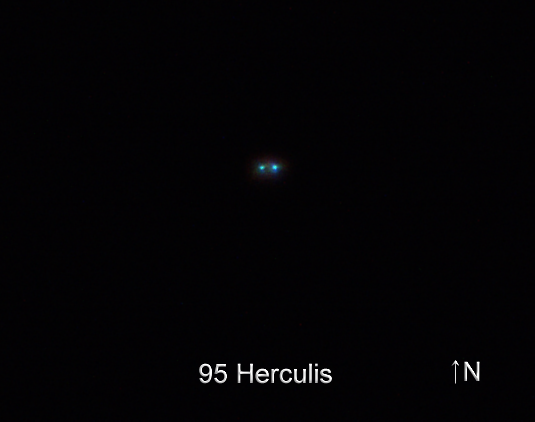
|
Frederik Wanink
Itterbeck (Germany) |
254mm |
|

|
|
|
|
70 Oph, P Oph, STF2272 |
|
AB |
4m.2 |
6m.2 |
6.9" |
121° |
2021 |
Oph |
18h05m27.37s / +02°29'59.30" |
|
|
Uwe Pilz
Leipzig (Germany) |
16x70 |
nicht einfach; der helle ist gelb |

|
Christopher Hay
Seeheim (Germany) |
25x80 |
Clean split, component A appears yellowish.
70 Oph is the left nostril of the bull in the old constellation Taurus Poniatowski (Poniatowski’s Bull). On the connections to 67, 68 and 73 Oph see the entry on 67 Oph. |
|
René Merting
Drachhausen (Germany) |
100mm (64x) |
bei 32x wirkt der Stern nicht rund, sondern ein wenig nach SO verschmiert - bei 64x dann eindeutig ein knapp getrenntes schön anzusehendes Pärchen - Komponente A hell-gelb, B orange-gelb |
|
Jörg S. Schlimmer
Germany |
127mm (136x) |
easy to split |

|
Sarah Gebauer
Germany |
150mm (85x) |
ein ganz leicht goldener Farbeindruck des Sternpaares, die Sterne stehen recht dicht beisammen und sind dennoch schön getrennt |

|
Robert Zebahl
Leipzig (Germany) |
200mm (80x) |
Conditions in the target region: SQM-L 20.1
Well split at 80x. Brighter component appeared white, fainter one slightly orange. |
|
|
Berthold Fuchs
Wiesbaden (Germany) |
130mm |
difficult DS |

|
|
|
★
|
STF2280, 100 Her |
|
AB |
5m.8 |
5m.8 |
14.3" |
182° |
2019 |
Her |
18h07m49.56s / +26°06'04.40" |
René Merting
Drachhausen (Germany) |
10x35 |
ein 8, eine Einschnürung ist ab und an erkennbar - Trennung nicht möglich |
|
René Merting
Drachhausen (Germany) |
10x50 |
zwei extrem dicht stehende helle Sterne - noch nicht getrennt, aber schön als 8 erkennbar |
|
Robert Zebahl
Leipzig (Germany) |
16x70 |
2020-07-05: Very nice, rather isolated double star. Striking. Similar bright component, both white. |
|
René Merting
Drachhausen (Germany) |
18x70 |
perfekt für 18-fache Vergrößerung - zwei gleich helle, dicht zusammen stehende Sterne - reinweiß und sehr auffällig, weil keine ähnlich hellen Sterne im Umfeld zu sehen sind |
|
Axel Tute
Küssaberg (Germany) |
70mm (117x) |
16.07.2009: Both light yellow. |

|
René Merting
Drachhausen (Germany) |
100mm (32x) |
bei 32x ein schönes, enges Pärchen zweier gleichheller Sterne - beide gleich hell und reinweiß - zurück auf 20x zeigen sich beide Protagonisten weiterhin ganz knapp getrennt - Komponente B im Süden wirkt leicht gelblich und schwächer |
|
Uwe Pilz
Leipzig (Germany) |
105mm (26x) |
Weiß-orangeweiß |
|
Robert Zebahl
Leipzig (Germany) |
120mm (40x) |
Conditions in the target region: SQM-L 20.5
Very nice, evident double star with equally bright components. |
|
Karsten Kopp
Köln (Germany) |
140mm (94x) |
Doppelstern ist einfach zu trennen. Das besondere ist hier, dass die beiden Sterne recht alleine zu stehen scheinen. Beide erscheinen weiß. |
|
Sarah Gebauer
Germany |
150mm (54x) |
zwei hübsche Glanzpünktchen, die mich an ein Knöpflein mit zwei Löchern erinnern, der "typische" DS für mich: nicht zu eng, nicht zu weit, gleich hell, sehr nett |
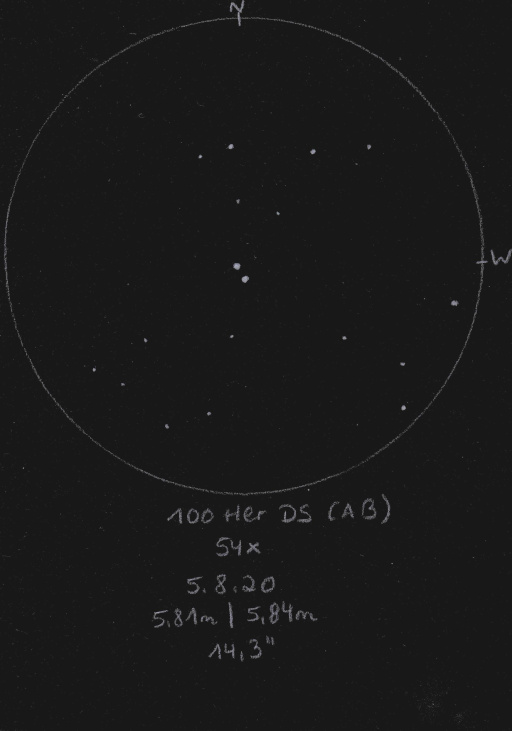
|
Robert Zebahl
Leipzig (Germany) |
152mm (22x) |
Beautiful view. Easy to separate with components of the same brightness. It is noticeable that there are no brighter stars in the immediate vicinity, so that the double star stands out very well. |
|
Mark McCarthy
Fremont (California/USA) |
203mm (205x) |
100 Her. Bright equal wide yellow-white stars. [not physical] |
|
|
Berthold Fuchs
Wiesbaden (Germany) |
130mm |
easy DS |
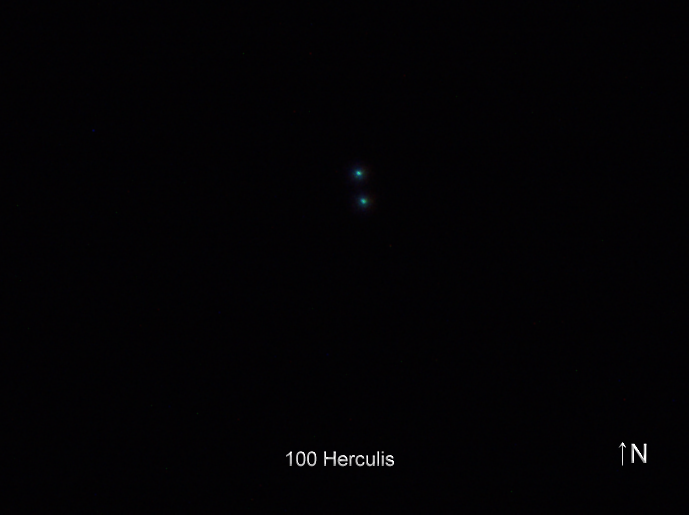
|
|
|
|
STT353, phi Dra |
|
AB |
4m.5 |
5m.9 |
0.5" |
262° |
2021 |
Dra |
18h20m45.44s / +71°20'15.80" |
|
|
Frederik Wanink
Itterbeck (Germany) |
254mm (640x) |
nicht als DS gesehen |
|
|
Frederik Wanink
Itterbeck (Germany) |
254mm |
|
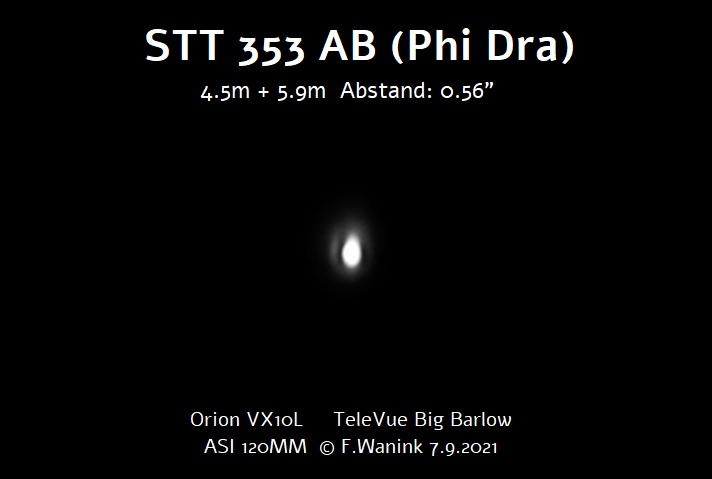
|
|
|
★
|
STF2320 |
|
|
7m.1 |
8m.9 |
0.9" |
1° |
2015 |
Her |
18h27m45.89s / +24°41'50.80" |
Mark McCarthy
Fremont (California/USA) |
203mm (667x) |
V994 Her. Seen with the 20", but used the 8" mask to clean up the images. Two delta mag, ~1" very nice pair. [eclipsing binary of Algol type--surely not seeing the eclipsing star? In fact, both A & B each are eclipsing binaries, the first such system to be discovered in the whole sky!] |
|
Frederik Wanink
Itterbeck (Germany) |
254mm (640x) |
|
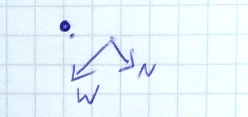
|
Mark McCarthy
Fremont (California/USA) |
317mm (553x) |
Nice! Blue-white stars, 1", 2 delta mag. |
|
|
Frederik Wanink
Itterbeck (Germany) |
254mm |
|

|
|
|
★★
|
STT359 |
|
|
6m.3 |
6m.6 |
0.8" |
5° |
2021 |
Her |
18h35m30.40s / +23°36'19.90" |
|
|
Robert Zebahl
Leipzig (Germany) |
102mm (160x) |
2020-11-10: Clearly elongated with slight notching and little difference in brightness. I estimated the position angle to 0°. |
|
Uwe Pilz
Leipzig (Germany) |
105mm (198x) |
leicht eingekerbt, Abstand 0“75 |
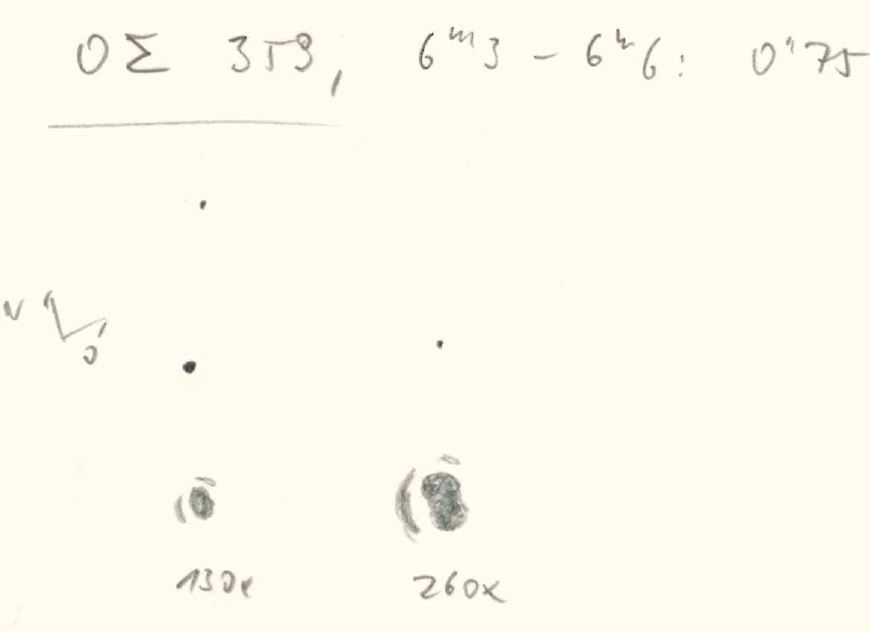
|
Uwe Pilz
Leipzig (Germany) |
120mm (250x) |
|
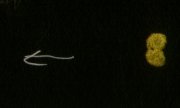
|
Mark McCarthy
Fremont (California/USA) |
152mm (175x) |
Light orange near equal stars, notched elongation, overlapping disks. Physical with a 219-year period, at apastron now |
|
Mark McCarthy
Fremont (California/USA) |
203mm (667x) |
Kissing 8" 333x, hairline split 667x. Near equal white A and bluish white B. |
|
Frederik Wanink
Itterbeck (Germany) |
254mm (640x) |
getrennt |

|
Mark McCarthy
Fremont (California/USA) |
317mm (553x) |
Nice! ~0.8" equal yellow-orange stars. |
|
Uwe Pilz
Leipzig (Germany) |
320mm (388x) |
ein sehr ruhiger Abend gestattete die Nutzung von 12 Zoll |
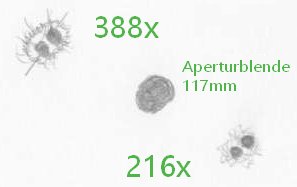
|
Mark McCarthy
Fremont (California/USA) |
508mm (333x) |
Light yellow near equal split, very close. 219 year period |
|
|
Frederik Wanink
Itterbeck (Germany) |
254mm |
|

|
|
|
|
STT363 |
|
|
7m.5 |
8m.1 |
0.6" |
335° |
2018 |
Dra |
18h37m23.92s / +77°41'12.40" |
|
|
Frederik Wanink
Itterbeck (Germany) |
254mm (640x) |
als 8 zu sehen |
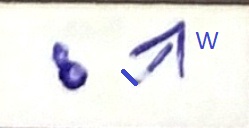
|
|
Frederik Wanink
Itterbeck (Germany) |
254mm |
|

|
|
|
★★★
|
epsilon Lyr |
STF2382, 4 Lyr, epsilon 1 Lyr |
AB |
5m.2 |
6m.1 |
2.2" |
345° |
2021 |
Lyr |
18h44m20.34s / +39°40'12.40" |
|
|
|
STFA37 |
AB-CD |
4m.7 |
4m.6 |
209.4" |
172° |
2021 |
|
|
|
|
|
STFA37 |
AI |
5m.2 |
10m.1 |
150.4" |
137° |
2021 |
|
|
|
|
|
STF2383, 5 Lyr, epsilon 2 Lyr |
CD |
5m.2 |
5m.4 |
2.3" |
75° |
2021 |
|
|
|
|
Christopher Hay
Seeheim (Germany) |
naked eye |
STFA37 (AB-CD): While waiting for Comet Neowise at 3 in the morning in July 2020 surprised myself with my first naked-eye separation of Alpha1 und Alpha2 Capricornis (observing site at 50° northern latitude, Alpha1/2 passing through meridian). Encouraged by this, I lay down and had a close look at Epsilon Lyrae, without really expecting to be able to split it naked-eye, having never succeeded previously. At first Epsilon Lyrae appeared as a very short dash of light. Then the dash resolved into two pinpoints. After 15 years in the hobby and at age 60, at last got Eps Lyr split! No precise prior PA knowledge. After memorising PA as seen naked-eye carefully, confirmed it with binoculars. Eps Lyr is the third-easiest physical double in the (northern hemisphere) summer sky for the naked eye, after Zeta UMa (much easier) und Alpha Lib (marginally easier). |
|
Christopher Hay
Seeheim (Germany) |
2x54 |
STFA37 (AB-CD): Clean split. Actually more pleasant than in 4x10 binoculars, presumably due to more steady handheld view. |
|
Robert Zebahl
Leipzig (Germany) |
55mm (59x) |
STF2382 (AB): At 42x slightly elongated, at 59x elongated and obviously notched. |
|
Robert Zebahl
Leipzig (Germany) |
55mm (59x) |
STF2383 (CD): At 42x clearly elongated, but without any visible notch. At 59x split with touching diffraction disks. |
|
Robert Zebahl
Leipzig (Germany) |
70mm (57x) |
STF2382 (AB): Obviously seen as figure '8'. |
|
Robert Zebahl
Leipzig (Germany) |
70mm (57x) |
STF2383 (CD): Split, but extremely tight with almost touching diffraction disks. |
|
René Merting
Drachhausen (Germany) |
76mm (95x) |
AB-CD: bei 29x schön getrennt erkennbar, ohne dass sich AB und CD schon trennen lassen
AB: bei 57x leicht länglich mit kleiner Einschnürung - bei 95x schön eng getrennt, B nördlich wirkt etwas schwächer- bei 127x wunderschön, das Sternpaar hat zwei Beugungsscheibchen, die wie ein Heiligenschein um die beiden Sterne stehen
CD: bei 57x eine 8 - bei 95x ein schön eng getrenntes Pärchen gleichheller Sterne - bei 127x wunderschön, das Sternpaar hat zwei Beugungsscheibchen, die wie ein Heiligenschein um die beiden Sterne stehen
EF und I: bei 127x sind alle drei Sterne (I 10.1 mag / E 12.3 mag / F 12.7 mag) erkennbar |
|
René Merting
Drachhausen (Germany) |
100mm (107x) |
AB: bei 64x ist das Sternpaar mit leichter Einschnürung und Nord-Süd-Ausdehnung erkennbar - beide Sterne stehen minimal enger zusammen als das südlichere Paar CD - bei 107x knappe Trennung, Komponente B nördlich ist mindestens eine halbe Größenklasse schwächer als A
CD: bei 64x als 8 mit Ost-West-Ausdehnung erkennbar - bei 107x knapp getrennt, beide Komponenten sind etwa gleich hell |
|
Sarah Gebauer
Germany |
100mm (136x) |
ein Test mit dem neuen Refraktor, um einen Vergleich zum 6''-Newton zu ziehen: bei 136x schon astrein getrennt, natürlich ziemlich eng und ganz fein getrennt, aber dennoch ein überraschend positives Ergebnis |
|
Robert Zebahl
Leipzig (Germany) |
102mm (125x) |
Stunning view of the components A-D and I! |
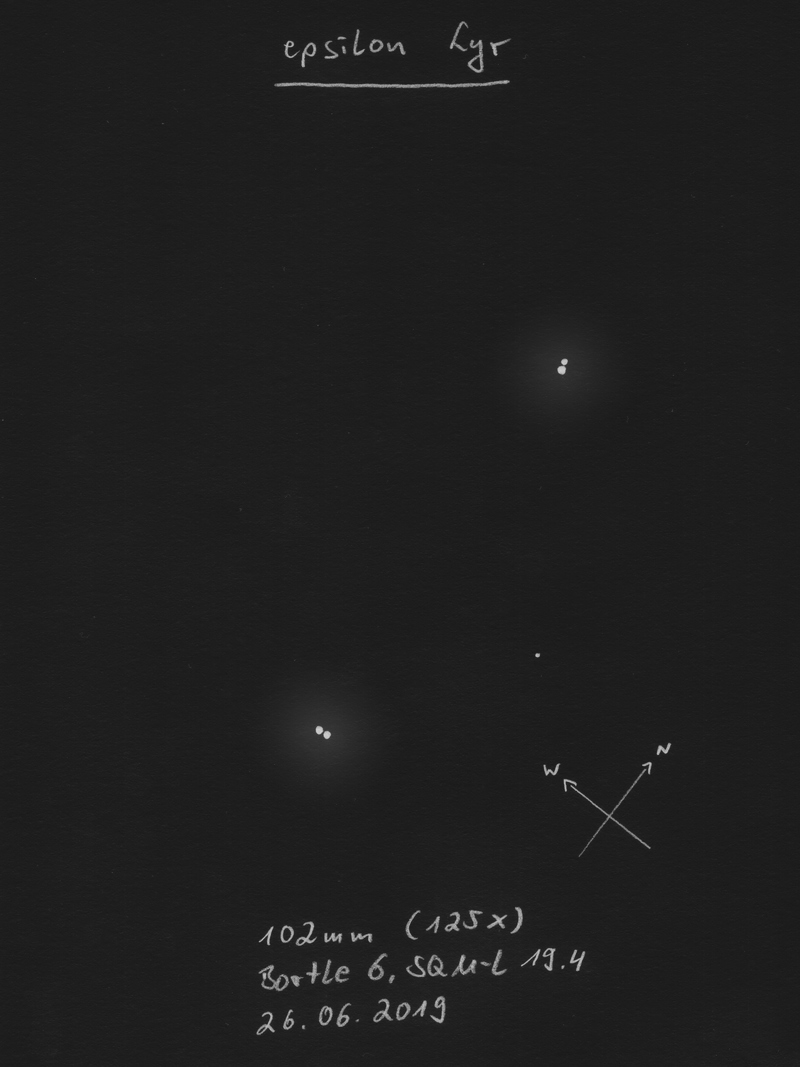
|
Uwe Pilz
Leipzig (Germany) |
105mm (26x) |
bei 22x nicht trennbar |
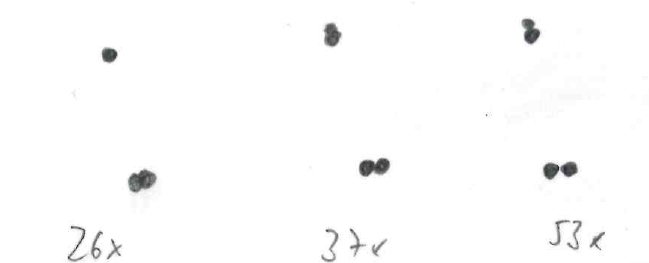
|
Jörg S. Schlimmer
Germany |
127mm (203x) |
easy to split |
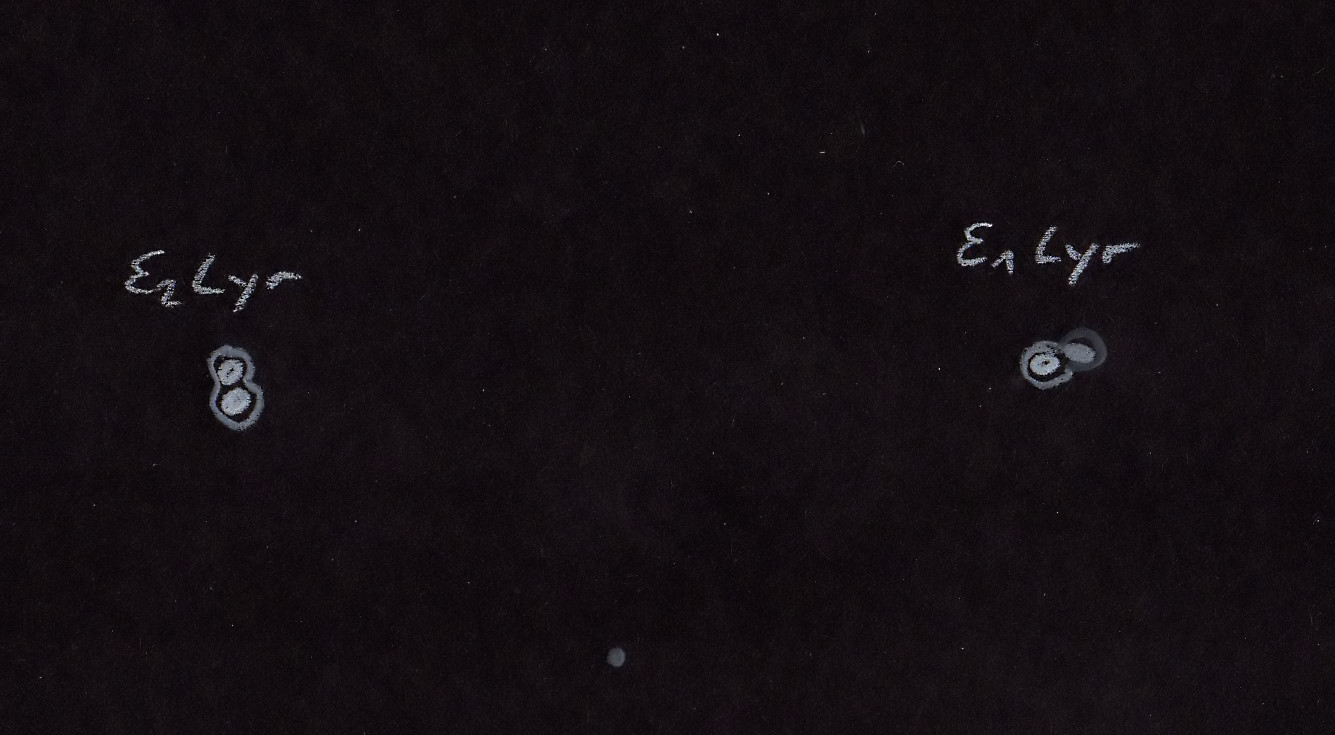
|
Sarah Gebauer
Germany |
150mm (250x) |
August 2019 zum ersten Mal die nah beieinanderstehenden Komponenten sauber getrennt, ein grandioser Doppel-Doppel-Anblick |
|
Winfried Kräling
Marburg (Germany) |
152mm (175x) |
|
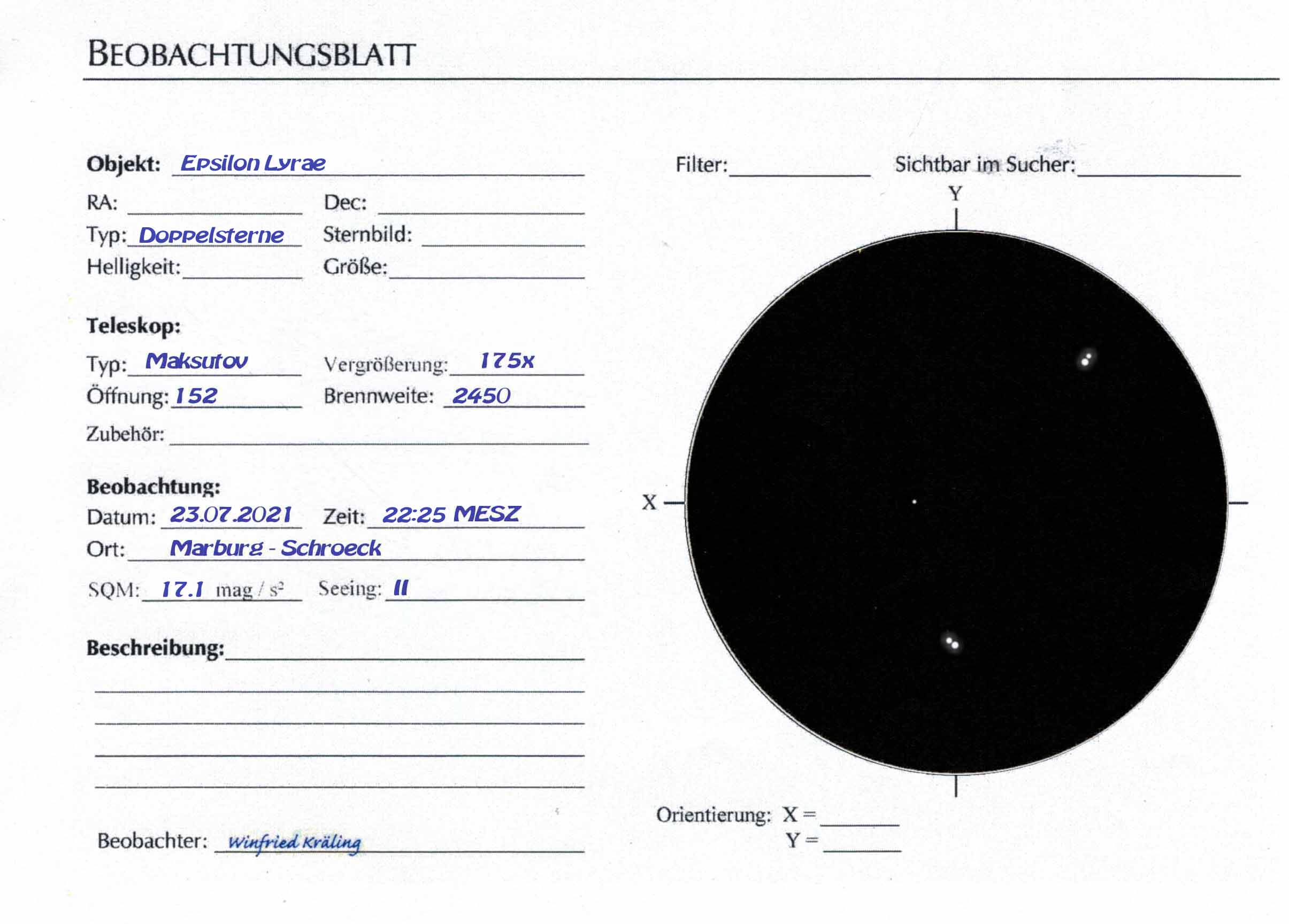
|
René Merting
Drachhausen (Germany) |
320mm (144x) |
AB: bei 72x ist erkennbar, in welche Richtung die Sterne elongieren, bei 43x dann ist eine deutliche 8 sichtbar - erst bei 206x lassen sich A und B zweifelsfrei trennen, zeigen sich aber auch schon ordentlich aufgebläht
CD: bei 103x ist die südliche Komponente als 8 erkennbar - bei 144x kann ich C und D trennen |
|
René Merting
Drachhausen (Germany) |
320mm (144x) |
bei 144x sind die Komponenten von AB und CD gerade so getrennt voneinander erkennbar, sie tanzen wie wild miteinander - mit Arperturmaske und Abblendung auf 120 mm zeigen die vier nun deutlich schwächeren Sterne schöne Beugungsscheibchen und sind besser getrennt voneinander sichtbar |
|
Uwe Pilz
Leipzig (Germany) |
320mm (200x) |
7 Komponenten!! A-B-C-D-E-F-I |

|
|
Berthold Fuchs
Wiesbaden (Germany) |
130mm |
Double-Double |
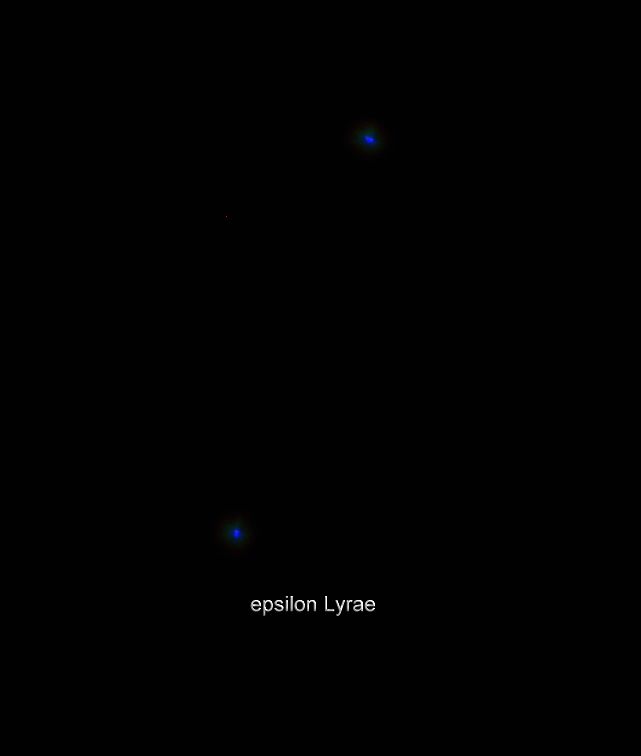
|
Frederik Wanink
Itterbeck (Germany) |
254mm |
|

|
|
|
★★
|
STFA38, zeta Lyr, zeta 1/2 Lyr, 6/7 Lyr |
|
AD |
4m.3 |
5m.6 |
43.7" |
150° |
2018 |
Lyr |
18h44m46.36s / +37°36'18.40" |
Christopher Hay
Seeheim (Germany) |
7x45 |
Handheld. Clearly split, almost wide. Primary bluish-white. Fantastic 8.6° FOV together with Eps1/2 and Delta1/2 Lyrae. One of the best doubles for 7x. |
|
Christopher Hay
Seeheim (Germany) |
10x42 |
Clearly separated. Colour contrast between bluish A and orangish D is there if one knows it, but not as striking as in 15x45 binoculars. |
|
Sarah Gebauer
Germany |
12x42 |
gut getrennt, mit schönem Helligkeitsunterschied und weißem Farbeindruck - zusammen mit Vega, ihrem weiten Halo und dem einfachen Epsilon-Lyrae-Doppel ein wundervoller Anblick |
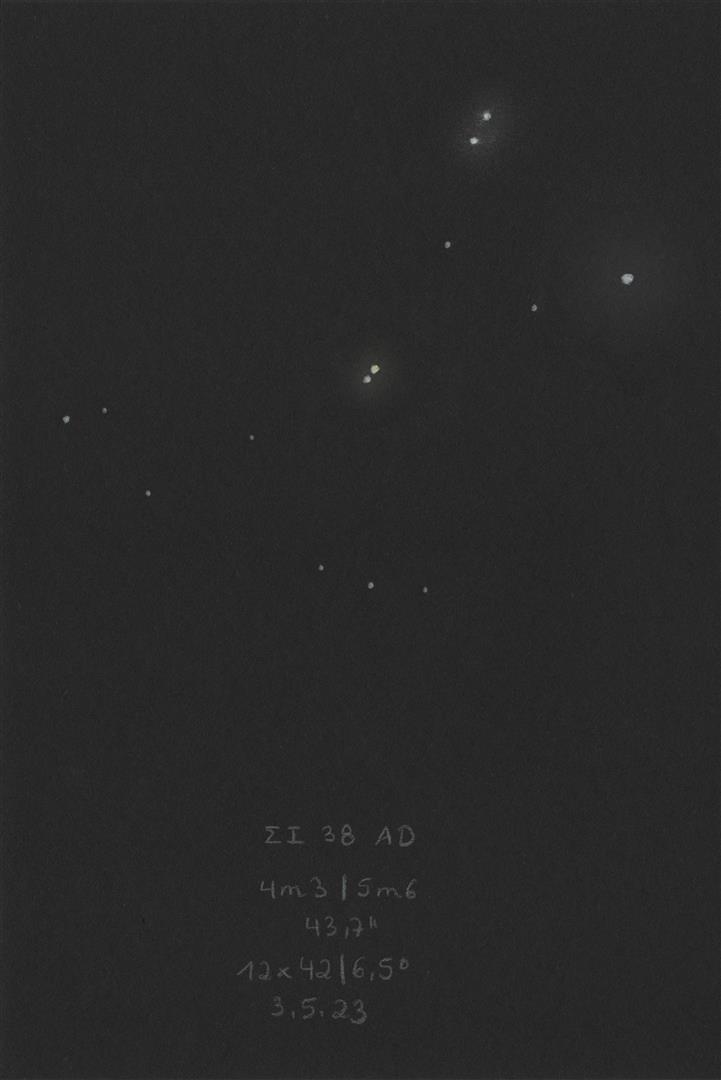
|
Christopher Hay
Seeheim (Germany) |
15x45 |
Component A clear blue-white, component D very pale tangerine orange. Wide split. Colour contrast seems even greater than that of nearby Delta 1/2 Lyrae. Physical double. |
|
René Merting
Drachhausen (Germany) |
76mm (29x) |
bei 29x ein sehr auffälliges Sternpaar, ordentlich getrennt - ein extrem schöner, dezenter Farbkontrast, A ist hellst gelb, D strahlt hell mintfarben, aber nur, wenn man nicht genau drauf schaut, sondern nur beiläufig - bei 57x verstärkt sich der Farbeindruck, vor allem, wenn man die Sterne leicht unscharf stellt, A ist dann samtgelb, B wirkt nicht mehr mintgrün sondern zart braunorange |
|
René Merting
Drachhausen (Germany) |
76mm (29x) |
bei 29x ein schön getrenntes Pärchen - D im Südosten ist 1.5 Magnituden schwächer und wirkt blaugrau gegen die weißgelbe A-Komponente |
|
Mark McCarthy
Fremont (California/USA) |
80mm (13x) |
Zeta 2 Lyr. Slightly greenish-white stars. Best view in finder, cleaner. Wide, 1 delta mag. |
|
René Merting
Drachhausen (Germany) |
100mm (20x) |
bei 20x weit getrennt, Komponente A weißlich, D leicht gelblich |
|
Sarah Gebauer
Germany |
100mm (21x) |
bei 20-fach auf den ersten Blick farblos bzw. warmweiß - ein sehr dominantes Pärchen in der Sternumgebung durch seine Helligkeit - mit etwas Geduld beim Beobachten zeigt sich ein gelber Farbhauch |
|
Sarah Gebauer
Germany |
100mm (80x) |
ein typisches Augenpaar, der nördliche Stern leuchtet leicht heller als der südliche |
|
Axel Tute
Küssaberg (Germany) |
100mm (217x) |
11.10.2023: Simple. No colours noted. |
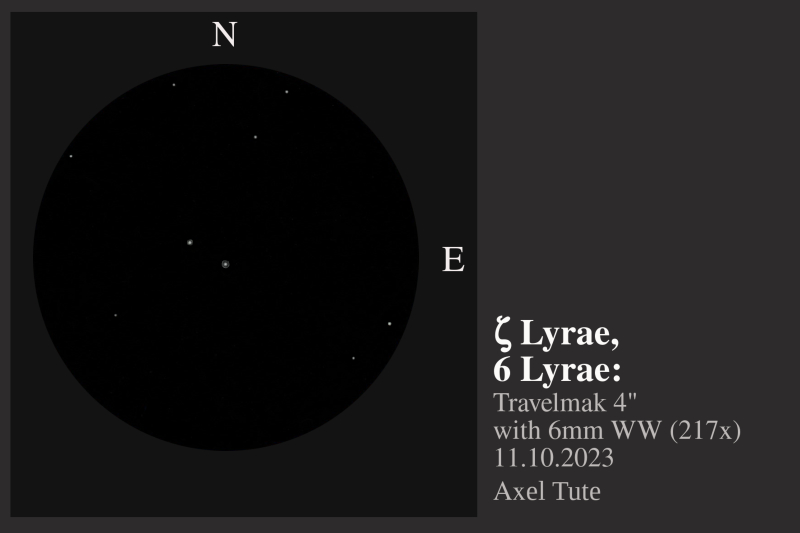
|
Uwe Pilz
Leipzig (Germany) |
105mm (88x) |
weiß-orange |

|
Sarah Gebauer
Germany |
150mm (85x) |
weit getrennt, unspektakulär |
|
Winfried Kräling
Marburg (Germany) |
152mm (175x) |
|
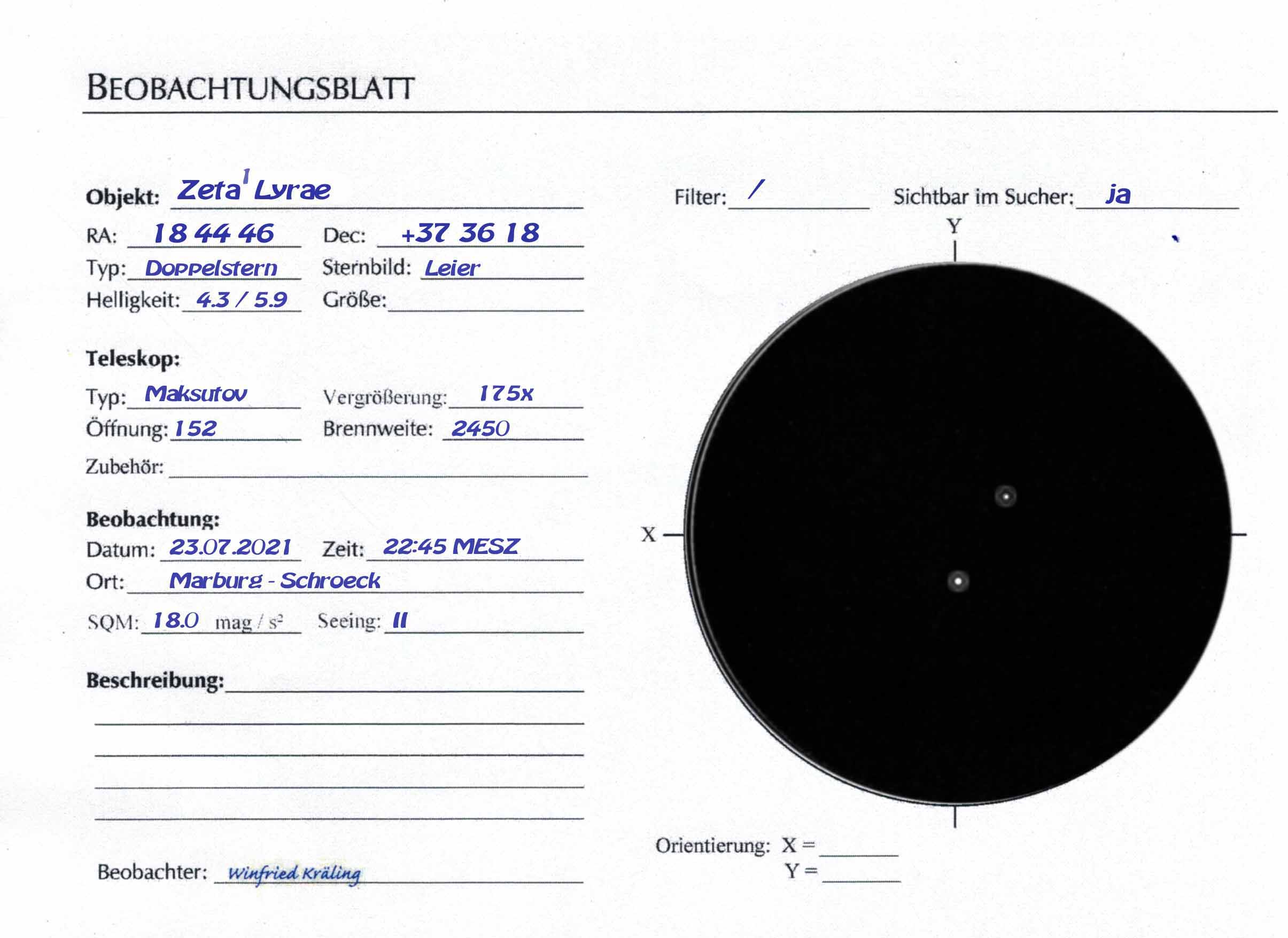
|
Mark McCarthy
Fremont (California/USA) |
152mm (175x) |
Wide, white-yellow stars, one delta |
|
René Merting
Drachhausen (Germany) |
320mm (45x) |
bei 45x ein helles Sternpaar mit leichtem Farbkontrast - die südöstlich stehende B-Komponente wirkt eine halbe Größenklasse schwächer und strahlt zartgelb, A dagegen wirkt weiß |
|
|
Frederik Wanink
Itterbeck (Germany) |
254mm |
|
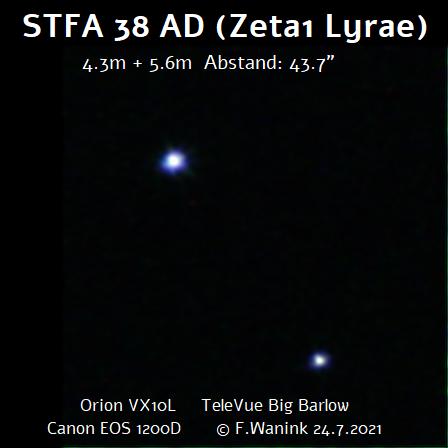
|
|
|
|
STF2391 |
|
AB |
6m.5 |
9m.6 |
37.7" |
332° |
2016 |
Sct |
18h48m39.49s / -06°00'15.50" |
René Merting
Drachhausen (Germany) |
10x50 |
Komponente B ist extrem schwach nordwestlich von A zu erkennen, knapp getrennt - ich vermute, das schafft man mit der Öffnung nur stativgestützt … und mit einem richtig guten Fernglas |
|
René Merting
Drachhausen (Germany) |
15x56 |
das Pärchen präsentiert sich schwächer und enger als das unmittelbar östlich stehende Doppelsternpaar H 6 50 (AC) - Komponente B im Norden ist 2 bis 3 Magnituden schwächer als A |
|
René Merting
Drachhausen (Germany) |
18x70 |
Komponente B ist gut abgesetzt nordwestlich von A zu erkennen - großer Helligkeitsunterschied |
|
René Merting
Drachhausen (Germany) |
100mm (20x) |
bei 20x ist Komponente B im NW von A unheimlich schwach erkennbar, mindestens 2 Größenklassen Helligkeitsunterschied - gewohnter Farbkontrast aufgrund der unterschiedlichen Helligkeiten |
|
|
Berthold Fuchs
Wiesbaden (Germany) |
130mm |
v.easy DS |
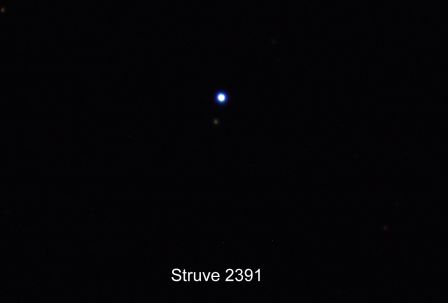
|
|
|
★★
|
STT525 & SHJ282 |
STT525 |
AB |
6m.1 |
9m.1 |
1.8" |
130° |
2015 |
Lyr |
18h54m52.52s / +33°58'06.90" |
|
|
|
SHJ282 |
AC |
6m.1 |
7m.6 |
45.4" |
349° |
2018 |
|
|
|
|
|
SHJ282 |
AD |
6m.1 |
11m.0 |
214.8" |
295° |
2015 |
|
|
Christopher Hay
Seeheim (Germany) |
10x42 |
SHJ282 (AC): Stabilised binoculars, handheld. Wide split, the A component yellowish. Alias South 282. According to Stelledoppie a physical double. |
|
Robert Zebahl
Leipzig (Germany) |
16x70 |
SHJ282 (AC): 2020-07-06: Easy, striking with reasonably apparent color contrast: yellowish to slightly orange & bluish. |
|
Christopher Hay
Seeheim (Germany) |
60mm (15x) |
SHJ282 (AC): Wide split. Blue colour of C component much more striking than the orange colour of the A component. |
|
Robert Zebahl
Leipzig (Germany) |
70mm (22x) |
SHJ282 (AC): Fairly bright and wide pair. The double star was conspicuous, especially in regard to its color: A appeared orange, C rather grey-bluish. It could be observed together with Messier 57 and beta & gamma Lyrae. Very nice. |
|
René Merting
Drachhausen (Germany) |
76mm (18x) |
SHJ282 (AC): bei 18x ist das Pärchen schon sehr auffällig - A ist hellgelb mit schönem Kontrast zur nördlich stehenden, gut getrennten B-Komponente - bei 57x präsentiert sich B in einem zarten stahlblau |
|
Sarah Gebauer
Germany |
100mm (49x) |
SHJ282 (AC): bei 50-fach weit getrennt mit nur geringem Helligkeitsunterschied, dafür aber einem schönen, warmgelb-graublauen Farbeindruck der beiden Komponenten - außerdem zusammen mit dem leicht südöstlich stehenden, deutlich schwächeren STF 2421 zusammen im Bild |
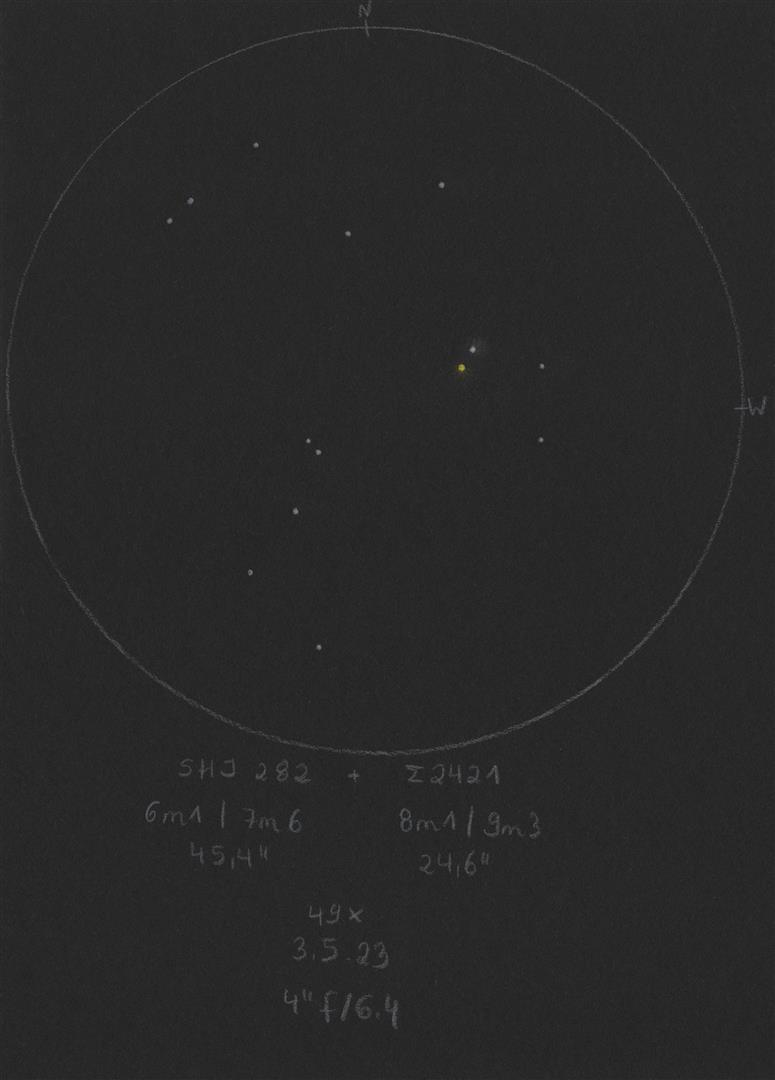
|
Uwe Pilz
Leipzig (Germany) |
105mm (21x) |
SHJ282 (AC): Orange und türkis |
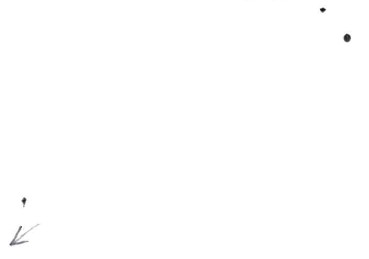
|
Uwe Pilz
Leipzig (Germany) |
105mm (180x) |
STT525 (AB): gelbweiß-blau |
|
Christopher Hay
Seeheim (Germany) |
125mm (23x) |
SHJ282 (AC): Widely split, dominates the field of view, very attractive. A component is tangerine orange, C component ice blue. An echo of Albireo. A true physical pair. |
|
Mark McCarthy
Fremont (California/USA) |
152mm (285x) |
STT525 (AB): Suspected at 175x, best seen 285x. Orange A, subtle elongation to notched with best seeing, unequal. Wide SHJ 282 AC also seen. WDS uncertain but there is a -34% parallax overlap, so it's not possible to be |
|
Mark McCarthy
Fremont (California/USA) |
178mm (205x) |
STT525 (AB): Extremely fine point shows just outside bright white A's first diffraction, only with best seeing and when A is a perfect disk. WDS uncertain, however unfortunately there is -34% parallax overlap, it is not physical |
|
Christopher Hay
Seeheim (Germany) |
180mm (200x) |
SHJ282 (AC): A is very distant from C but the two are still a fine pair. Colour of C is more striking than that of A, in a manner similar to my simultaneous observation with 60mm at 15x, but not quite as pronounced.
C has a companion set off from it by a hair of black. I estimate PA from C at approx. 80°, separation very roughly 2". Surprisingly can't find this companion in the double star catalogues. |
|
Frederik Wanink
Itterbeck (Germany) |
254mm (640x) |
STT525 (AB): 3er System, sehr schwierig wegen Helligkeitsunterschied |
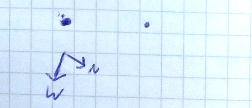
|
Mark McCarthy
Fremont (California/USA) |
317mm (277x) |
SHJ282 (AC): Wide separation orange and blue, 2 delta mag. |
|
|
Frederik Wanink
Itterbeck (Germany) |
254mm |
STT525 (AB) |

|
Claus-Dieter Jahn
Leipzig (Germany) |
|
SHJ282 (AC): TS APQ 65/420mm, ZWO ASI 178mc, Livestack with Sharpcap, Exposure time: 1600x 0.6s |
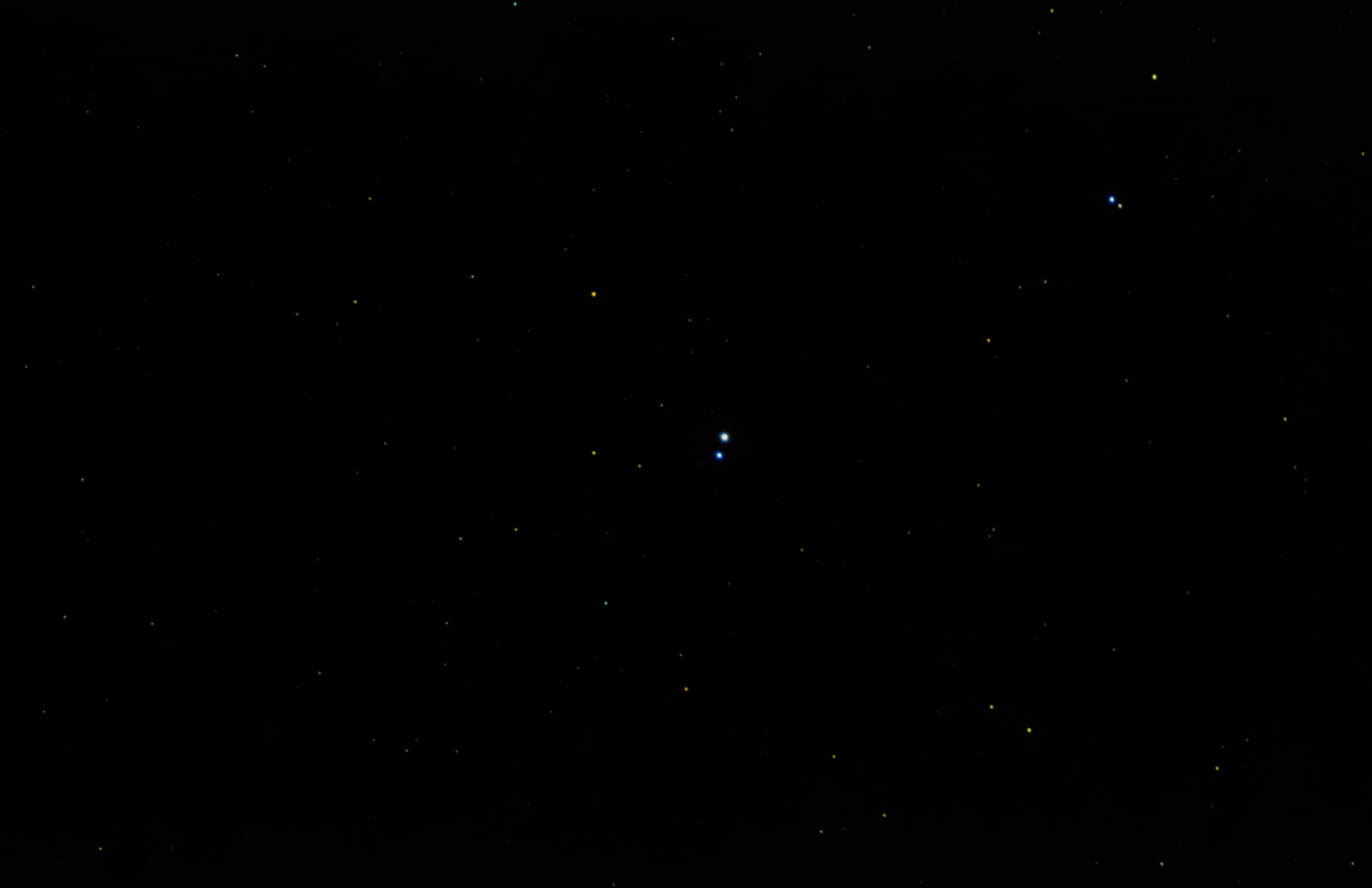
|
|
|
★
|
STF2417, theta Ser, 63 Ser, Alya |
|
AB |
4m.6 |
4m.9 |
22.4" |
106° |
2019 |
Ser |
18h56m13.18s / +04°12'12.90" |
|
|
|
|
AC |
4m.6 |
6m.8 |
421.0" |
58° |
2007 |
|
|
René Merting
Drachhausen (Germany) |
10x35 |
AB: wunderschön für diese Vergrößerung - zwei helle dicht beieinander stehende Sterne, knapp getrennt - die hellsten Sterne im Umfeld |
|
René Merting
Drachhausen (Germany) |
10x50 |
AB: zwei helle schneeweiße Sterne, knapp getrennt - B im Osten ist nur knapp schwächer - ein schönes enges Pärchen |
|
René Merting
Drachhausen (Germany) |
16x70 |
AB: ein gut getrennt zu sehendes Pärchen - beide Sterne stahlen weiß, Komponente B im Osten ist keine halbe Größenklasse schwächer |
|
René Merting
Drachhausen (Germany) |
100mm (20x) |
AB: bei 20x ein auffälliges gut getrenntes Sternpaar - Komponente B östlich ist nur leicht schwächer und strahlt ein wenig warm-weißer |
|
Sarah Gebauer
Germany |
100mm (73x) |
AB: die mit deutlichem Abstand bei 73x getrennten Doppelsterne liegen wie in einem U aus recht gleich hellen Sternen und bilden dabei im Süden den unteren Bereich des Buchstabens |

|
Stefan Loibl
Rosenheim (Germany) |
102mm (102x) |
AB: wide pair, hardly any difference in brightness, wonderful field, double stars looks like an embedded pair of eyes |
|
|
Berthold Fuchs
Wiesbaden (Germany) |
130mm |
AB: easy DS |

|
|
|
|
STF2504 & WAL111 |
STF2504 |
AB |
7m.0 |
9m.0 |
8.7" |
282° |
2016 |
Sge |
19h20m59.85s / +19°08'43.40" |
|
|
|
WAL111 |
AC |
7m.0 |
12m.2 |
91.8" |
101° |
2015 |
|
|
Mark McCarthy
Fremont (California/USA) |
152mm (175x) |
STF2504 (AB): Light yellow A and light blue B, wide 2 delta mag. WDS uncertain, but there is a good chance they are gravitationally bound: 13% parallax range overlap, 542 AU separation, and stellar mass of 1.57/0.97 |
|
Mark McCarthy
Fremont (California/USA) |
203mm (205x) |
STF2504 (AB): Yellow and slight orange, 1.5 delta mag, well separated. |
|
Mark McCarthy
Fremont (California/USA) |
317mm (277x) |
STF2504 (AB): Yellow and slightly red, 2 delta mag, 10". Third star opposite PA, 2x the separation. (AB the first, second is AC, WAL 111) |
|
Mark McCarthy
Fremont (California/USA) |
317mm (277x) |
WAL111 (AC): Yellow and slightly red, 2 delta mag, 10". Third star opposite PA, 2x the separation. (AB the first, second is AC, WAL 111) |
|
|
Berthold Fuchs
Wiesbaden (Germany) |
130mm |
STF2504 (AB): easy DS |
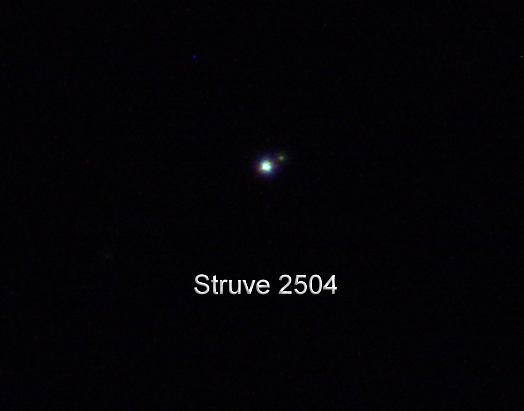
|
|
|
★★★
|
beta Cyg, 6 Cyg, Albireo, STFA43 |
|
AB |
3m.2 |
4m.7 |
34.6" |
54° |
2022 |
Cyg |
19h30m43.29s / +27°57'34.90" |
Sarah Gebauer
Germany |
6x24 |
auf Anhieb schön getrennt, wenn auch sehr, sehr eng - der leichte Orangefarbton der Hauptkomponente ist sofort auszumachen, das Blau des Begleiters noch ganz zart und blass - wirklich entzückend in der Kleinstvergrößerung! |
|
Christopher Hay
Seeheim (Germany) |
7x42 |
Handheld binoculars in reclining chair. Following a surprisingly easy split of Zeta Lyr, I try out whether Albireo may also be splittable. Indeed, the pair is split, difficult but definite. Staring at Altair (Alpha Aql) for a few seconds with the binoculars prior to observing Albireo heigtens my acuity and makes the split more definite. Component A exhibits a mild orange-yellow hue. |
|
Robert Zebahl
Leipzig (Germany) |
8x40 |
Well split, but I didn't recognised any color. |
|
René Merting
Drachhausen (Germany) |
10x50 |
Komponente A ist gleißend hell und stroh-gelb, Komponente B ist deutlich schwächer leicht abgesetzt von A erkennbar und strahlt eigenartig mintgrün |
|
Christopher Hay
Seeheim (Germany) |
12x36 |
Well split. A golden-red, B cold blue. Gorgeous! |
|
René Merting
Drachhausen (Germany) |
12x42 |
ein bisschen mehr als knapp getrenntes Pärchen - A strahlt in einem schönen, hellen Gelb, B wirkt blaugrau - Helligkeitsunterscheid etwas mehr als eine Größenklasse |
|
Sarah Gebauer
Germany |
12x42 |
ein knackscharfes, farbiges, leuchtendes Paar, nach der Saisonpause endlich wieder sichtbar - A strahlt warm, orangegold, kräftig - B glitzert kristalleisblau klein daneben - ein traumhafter Anblick im Fernglas, die Sternumgebung nimmt sich scheinbar bewusst zurück und sprenkelt das Bild mit zahlreichen schwachen Sternen |

|
René Merting
Drachhausen (Germany) |
15x56 |
die Hauptkomponente strahlt in einem schönen buttergelb, die Komponente B zeigt sich westlich und wirkt bim ersten Eindruck mintgrün, der Farbeindruck verliert sich aber, je länger ich dieses schöne Sternpaar bewundere - Helligkeitsunterschied 1.5 bis 2 Größenklassen |
|
Robert Zebahl
Leipzig (Germany) |
16x70 |
2020-07-06: Bright orange & white-bluish. |
|
Robert Zebahl
Leipzig (Germany) |
80mm (25x) |
One of the most beautiful double stars in the northern hemisphere. Differences in brightness and color (orange-blue) are brilliant! Even under urban conditions with small aperture an enjoyment! |
|
René Merting
Drachhausen (Germany) |
100mm (32x) |
bei 32x stehen beide Sterne weit getrennt - Komponente A mit einem satten zitronen-gelb, Komponente B mit einem leichten Stich ins Blaue |
|
René Merting
Drachhausen (Germany) |
107mm (43x) |
bei 43x zeigt die hellere Komponente ein wunderschönes Samtgelb, kurz davor, ein richtig kräftiges Gelb zu sein - die schwächere Komponente wirkt auf den ersten Blick blauweiß |
|
Jörg S. Schlimmer
Germany |
127mm (203x) |
easy to split |
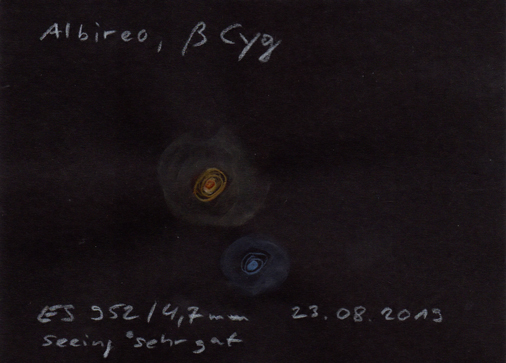
|
Sarah Gebauer
Germany |
150mm (116x) |
Erstbeobachtung August 2019: deutlicher Farbunterschied zwischen blau und sattem Gelb zu sehen |
|
Jörg S. Schlimmer
Germany |
305mm (170x) |
alle Komponenten einfach zu trennen |
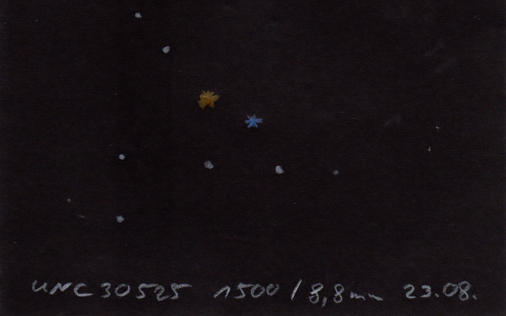
|
René Merting
Drachhausen (Germany) |
320mm (45x) |
|
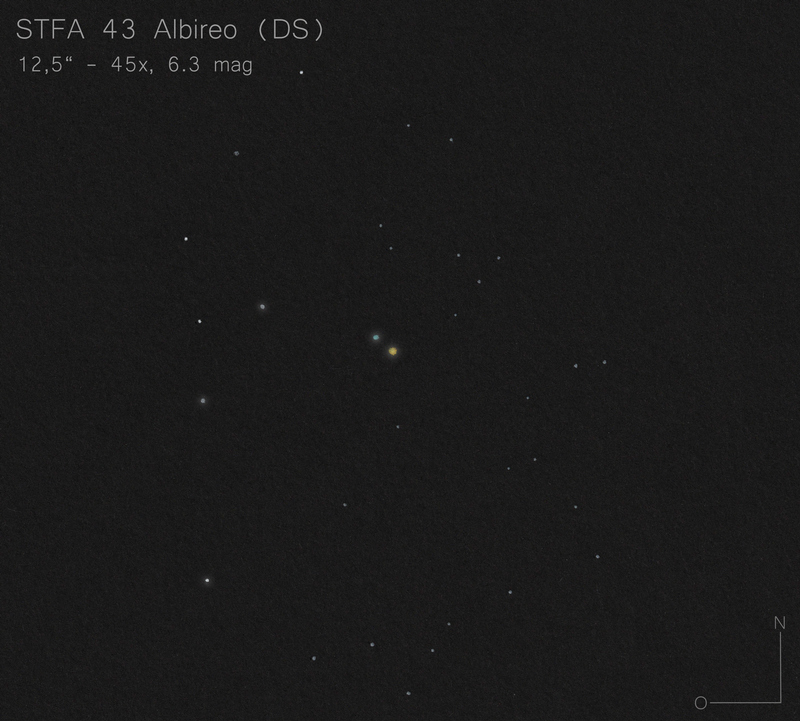
|
|
Frederik Wanink
Itterbeck (Germany) |
254mm |
Doppelsternnatur von MCA 55 nicht zu sehen |

|
Werner E. Celnik
Rheinberg (Germany) |
150mm |
|
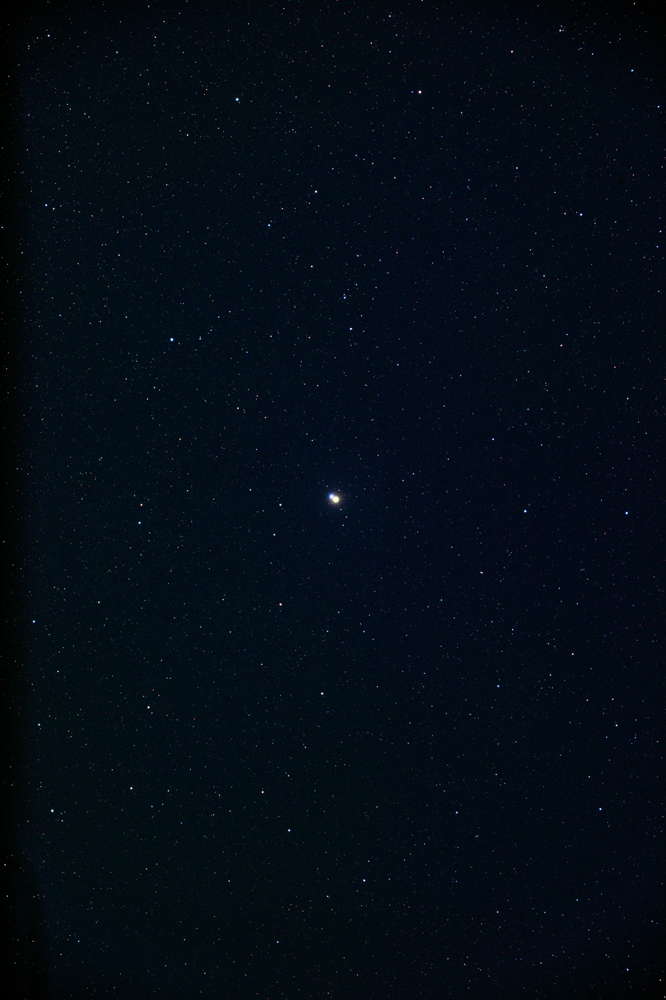

|
Werner E. Celnik
Rheinberg (Germany) |
150mm |
|
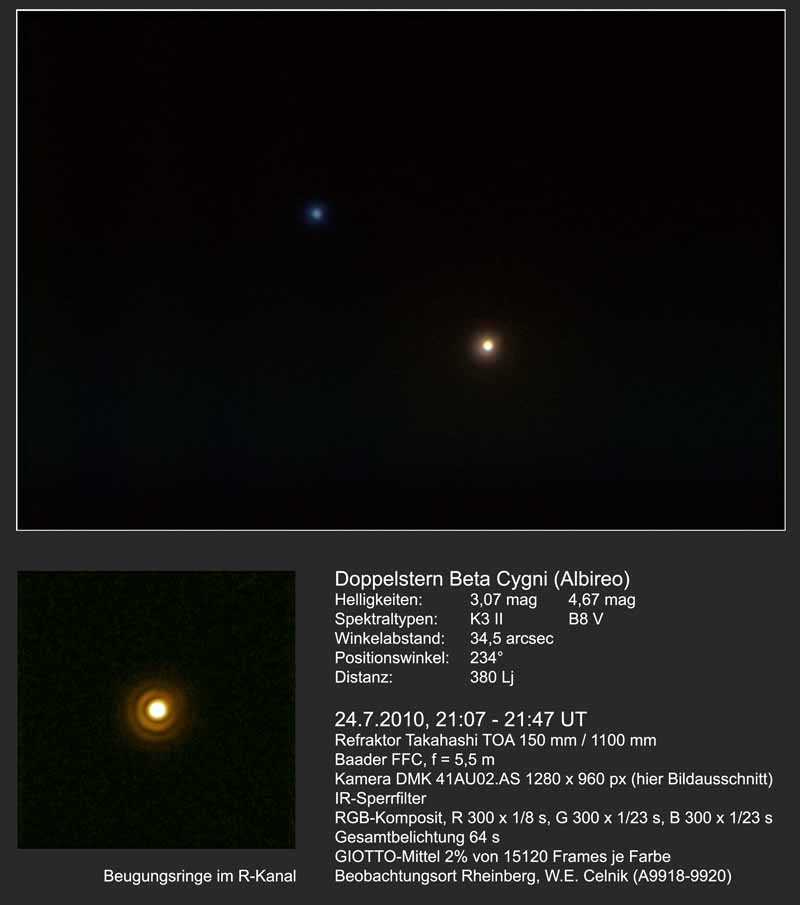
|
|
|
|
KUI94 |
|
|
6m.5 |
7m.8 |
0.5" |
158° |
2014 |
Cyg |
19h41m57.63s / +40°15'14.60" |
|
|
Frederik Wanink
Itterbeck (Germany) |
254mm (640x) |
unsicher, 8förmig |
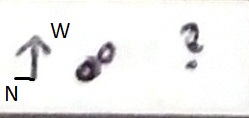
|
|
Frederik Wanink
Itterbeck (Germany) |
254mm |
|
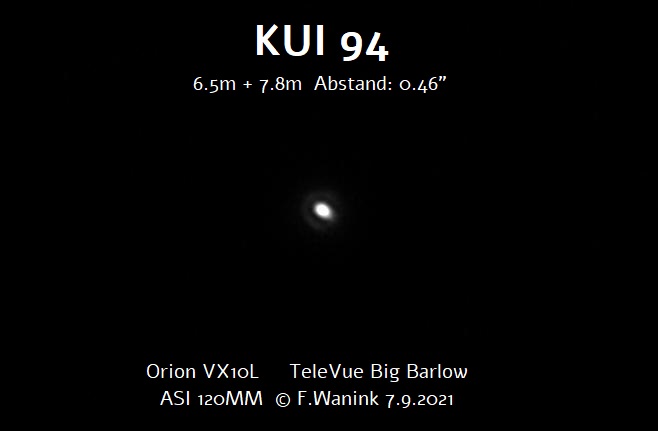
|
|
|
|
STT383 |
|
AB |
7m.0 |
8m.3 |
0.8" |
15° |
2014 |
Cyg |
19h42m56.26s / +40°43'18.30" |
|
|
|
|
AC |
7m.0 |
11m.6 |
45.2" |
99° |
2002 |
|
|
|
|
|
|
AD |
7m.0 |
12m.4 |
68.1" |
43° |
2002 |
|
|
|
|
Robert Zebahl
Leipzig (Germany) |
152mm (240x) |
AB: 2022-08-07: Under these average conditions the double star is well visible as such. The fainter companion appears as a washed out star close to the primary component. In quiet moments the overlapping diffraction disks are well visible. |
|
Frederik Wanink
Itterbeck (Germany) |
254mm (640x) |
AB: getrennt |
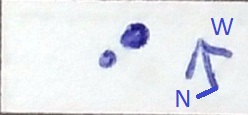
|
|
Frederik Wanink
Itterbeck (Germany) |
254mm |
AB |

|
|
|
|
STT384 |
|
AB |
7m.6 |
8m.2 |
1.0" |
196° |
2018 |
Cyg |
19h43m47.09s / +38°19'20.50" |
|
|
|
|
AC |
7m.6 |
9m.8 |
59.4" |
297° |
2015 |
|
|
|
|
|
|
AD |
7m.6 |
10m.8 |
116.0" |
294° |
2015 |
|
|
René Merting
Drachhausen (Germany) |
100mm (20x) |
AC: bei 20x weit getrenntes Pärchen - Komponente C ist deutlich schwächer als A |
|
Frederik Wanink
Itterbeck (Germany) |
254mm (640x) |
AB: deutliches Paar |
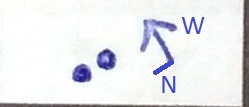
|
Mark McCarthy
Fremont (California/USA) |
317mm (553x) |
AB: Nice near equal ~1", rest of field angular with stars (AB seen, AC and AD in the field.) |
|
|
Frederik Wanink
Itterbeck (Germany) |
254mm |
AB |

|
|
|
★
|
STT387 |
|
|
7m.1 |
7m.9 |
0.5" |
94° |
2020 |
Cyg |
19h48m43.81s / +35°18'41.30" |
|
|
Frederik Wanink
Itterbeck (Germany) |
254mm (640x) |
zeitweise als 8 zu sehen |
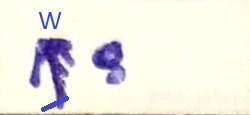
|
Mark McCarthy
Fremont (California/USA) |
317mm (277x) |
Red, very close pair? Seeing not supporting higher magnification. Marginal. |
|
Mark McCarthy
Fremont (California/USA) |
317mm (553x) |
Overlapping disks, to a nearly hairline split with seeing. Half delta mag. |
|
|
Frederik Wanink
Itterbeck (Germany) |
254mm |
|
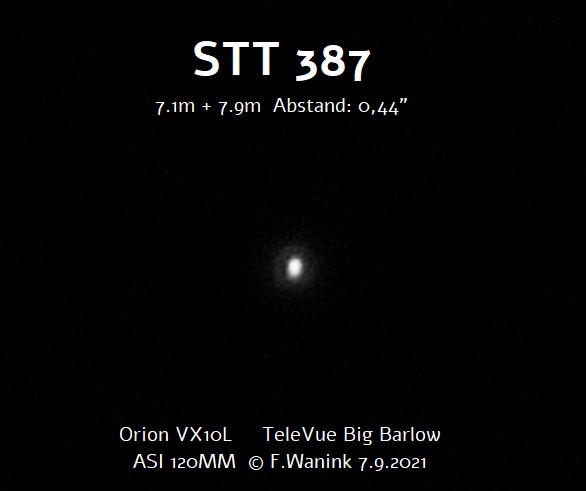
|
|
|
|
STF2594, 57 Aql |
|
AB |
5m.7 |
6m.3 |
36.3" |
171° |
2019 |
Aql |
19h54m37.65s / -08°13'38.30" |
René Merting
Drachhausen (Germany) |
10x50 |
ein einfacher Doppelstern - schön getrennt - Komponente A strahlt etwas weißer |
|
René Merting
Drachhausen (Germany) |
16x70 |
ein ansehnliches gut getrenntes Sternpaar - Komponente B im Süden ist gut eine halbe Größenklasse schwächer - das Weiß von Komponente A wirkt etwas kühler, während B eher in einem wärmeren zarten creme-gelb strahlt |
|
René Merting
Drachhausen (Germany) |
100mm (20x) |
bei 32x ein sehr auffälliges, komfortabel getrenntes Sternpaar - Komponente B im Süden ist eine halbe Magnitude schwächer - zurück auf 20x immernoch eine ordentliche Trennung, B wirkt jetzt etwas schmutziger weiß |
|
Sarah Gebauer
Germany |
100mm (21x) |
02.10.23: bei 21-fach ein gut getrenntes, helles, weißes Pärchen, die nördliche Komponente strahlt etwas warmweißer, die südliche etwas kaltweißer - bei 49-fach ändert sich zumindest am Farbeindruck nichts - schön mit im Bild ist weiter südlich der roségoldene 56 Aql |
|
Uwe Pilz
Leipzig (Germany) |
105mm (22x) |
orange-blau |
|
Uwe Pilz
Leipzig (Germany) |
320mm (36x) |
|
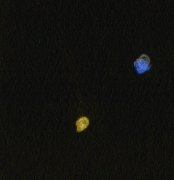
|
René Merting
Drachhausen (Germany) |
320mm (45x) |
der DS ist bei 45x schon sehr gut getrennt zu sehen, A ist leicht gelblich, B blauweiß, ein schönes Farbkontrastpaar mit weitem Abstand und etwa einer dreiviertel Größenklasse Helligkeitsunterschied |
|
|
Berthold Fuchs
Wiesbaden (Germany) |
130mm |
easy DS |

|
|
|
|
13 Sge |
H4 100 |
AB |
10m.0 |
10m.1 |
23.9" |
265° |
2013 |
Sge |
20h00m10.43s / +17°30'09.10" |
|
|
|
H4 100 |
AC |
10m.0 |
5m.6 |
112.6" |
297° |
2013 |
|
|
|
|
|
BU1477 |
CD |
5m.6 |
13m.4 |
27.0" |
208° |
2013 |
|
|
|
|
|
BU1477 |
CE |
5m.6 |
13m.0 |
45.9" |
114° |
2020 |
|
|
John Raymond
Richmond (Virginia/USA) |
|
|

|
|
|
|
STT395, 16 Vul |
|
|
5m.8 |
6m.2 |
0.7" |
129° |
2020 |
Vul |
20h02m01.45s / +24°56'16.80" |
|
|
Mark McCarthy
Fremont (California/USA) |
152mm (456x) |
Slightly unequal snowman at all powers. Notching increases in strength with increasing power. Physical with 1201-year period |
|
Mark McCarthy
Fremont (California/USA) |
203mm (667x) |
16 Vul. Hairline split at 8" 333x. At 667x I see a more definite split. It appears only half delta mag, rather than the 1 delta mag in Sky Tools. Nice star. |
|
Frederik Wanink
Itterbeck (Germany) |
254mm (640x) |
fast getrennt, eher 8, ähnlich hell |

|
|
Frederik Wanink
Itterbeck (Germany) |
254mm |
|

|
|
|
|
15 Sge |
STT592 |
AB |
5m.9 |
9m.5 |
163.2" |
291° |
2015 |
Sge |
20h04m06.22s / +17°04'12.60" |
|
|
|
STT592 |
AC |
5m.9 |
6m.9 |
217.0" |
335° |
2015 |
|
|
|
|
|
BUP202 |
AD |
5m.9 |
11m.3 |
89.1" |
3° |
2015 |
|
|
|
|
|
BUP202 |
AE |
5m.9 |
11m.8 |
175.0" |
51° |
2013 |
|
|
|
|
|
BUP202 |
AF |
5m.9 |
12m.3 |
142.4" |
315° |
2015 |
|
|
|
|
|
SMR20 |
AI |
5m.9 |
11m.1 |
132.1" |
129° |
2015 |
|
|
|
|
|
TNN14 |
AJ |
4m.4 |
13m.5 |
3.3" |
283° |
2004 |
|
|
|
|
|
TNN14 |
AK |
4m.4 |
12m.4 |
6.2" |
162° |
2004 |
|
|
|
|
|
TNN14 |
AL |
4m.4 |
13m.0 |
9.3" |
140° |
2004 |
|
|
|
|
|
STTA202 |
BG |
9m.5 |
9m.0 |
181.4" |
230° |
2015 |
|
|
|
|
|
BUP202 |
CH |
6m.9 |
12m.3 |
95.6" |
185° |
2015 |
|
|
John Raymond
Richmond (Virginia/USA) |
|
|
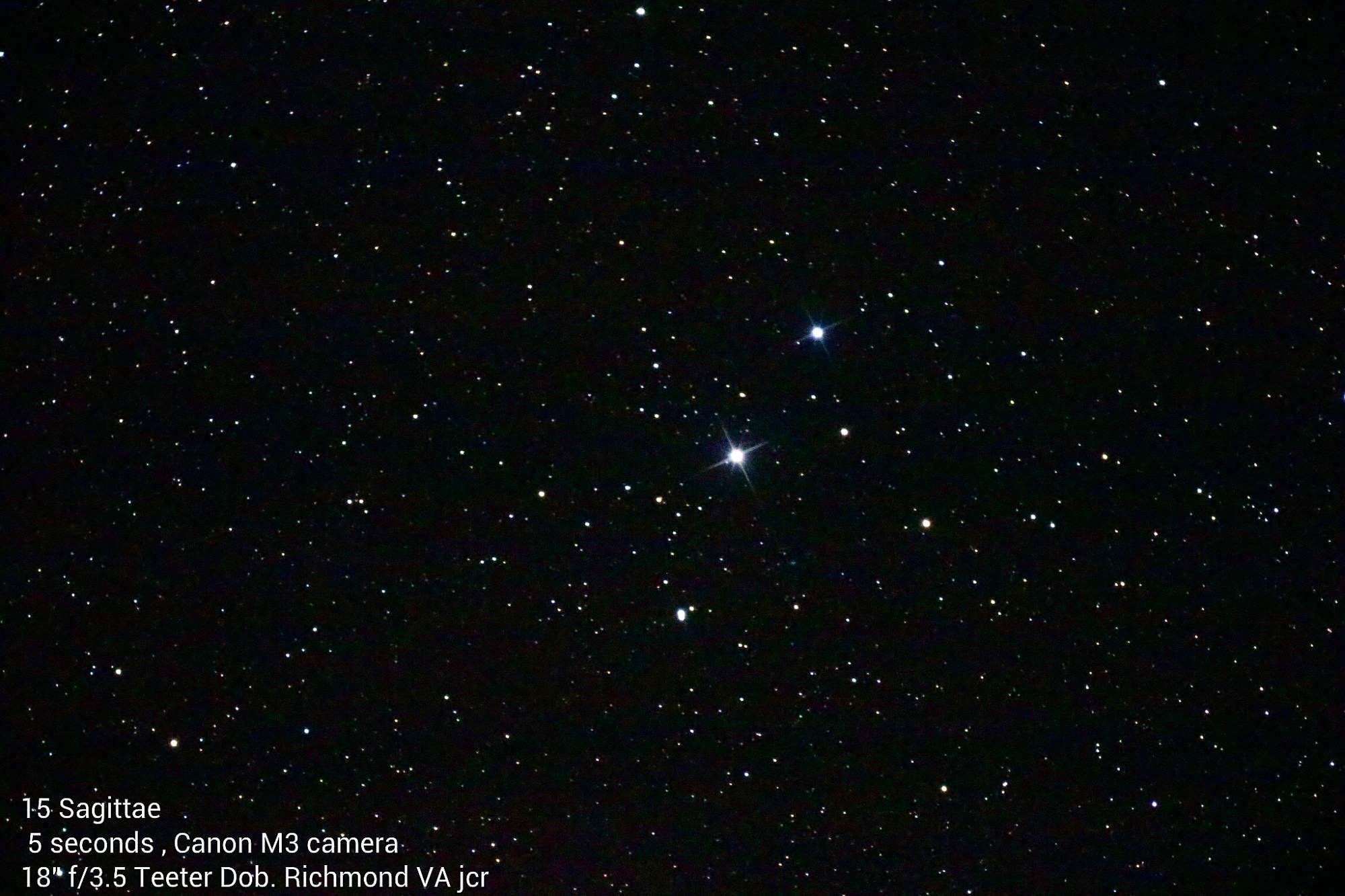
|
|
|
|
STF2637, theta Sge, 17 Sge |
|
AB |
6m.6 |
8m.8 |
11.6" |
331° |
2020 |
Sge |
20h09m56.61s / +20°54'53.20" |
|
|
|
|
AC |
6m.6 |
7m.5 |
91.9" |
222° |
2020 |
|
|
|
|
|
|
AD |
6m.6 |
11m.9 |
172.8" |
226° |
2016 |
|
|
René Merting
Drachhausen (Germany) |
100mm (32x) |
AB: bei 32x ist nördlich von A ein schwacher Begleiter erkennbar, gut getrennt - Helligkeitsunterschied gut 2 Größenklassen, B wirkt dadurch grau-braun
AC: bei 32x ist südwestlich von Komponente A in einigem Abstand Komponente C (siebenfache Entfernung AB) erkennbar - die Helligkeit von C liegt zwischen A und B |
|
Sarah Gebauer
Germany |
100mm (49x) |
20.09.23: ich sehe keine Farbe - eine helle, recht weiße A-Komponente bei 49-fach und nordwestlich davon eine etwas grauere, schwächere B-Komponente - bei 80-fach sieht der DS etwas interessanter aus, nun zeigt sich an der Hauptkomponente A sowie am Begleiter C ein ganz zartes Strohgelb |
|
Mark McCarthy
Fremont (California/USA) |
203mm (333x) |
AB: Theta Sge. White star and slightly red B, wide separation, about 3 delta mag [Several other pairs, not observed] |
|
|
John Raymond
Richmond (Virginia/USA) |
|
|
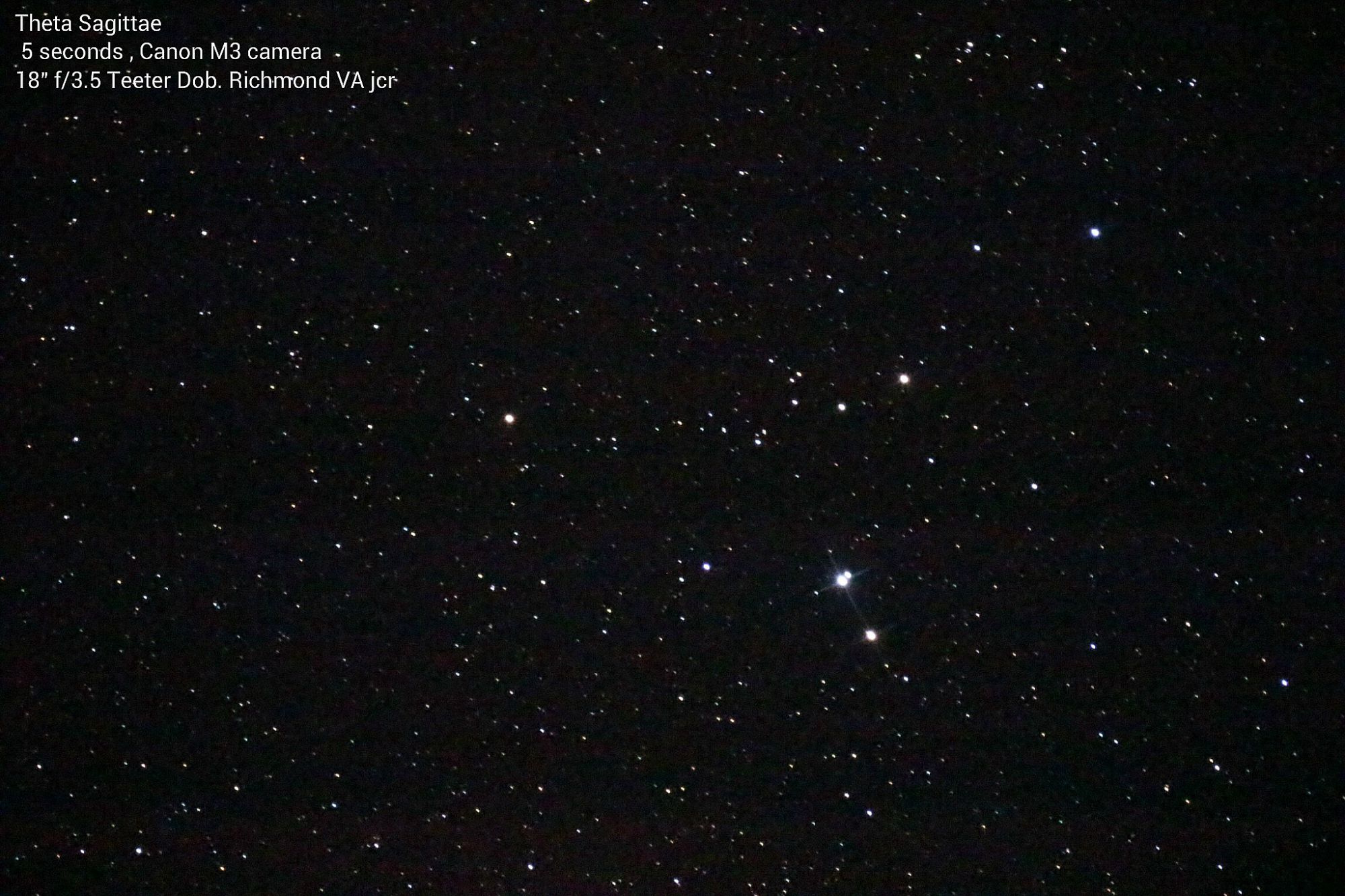
|
|
|
★
|
STT403 & STF2657 |
STT403 |
AB |
7m.3 |
7m.6 |
0.9" |
170° |
2019 |
Cyg |
20h14m21.53s / +42°06'15.60" |
|
|
|
STF2657 |
AC |
7m.3 |
9m.8 |
11.6" |
32° |
2015 |
|
|
René Merting
Drachhausen (Germany) |
100mm (64x) |
STF2657 (AC): bei 64x zeigt sich C ganz schwach nordöstlich von A - mindestens 2 Größenklassen Helligkeitsunterschied - A ist reinweiß, bei C bin ich froh, dass ich C überhaupt erkennen kann |
|
Uwe Pilz
Leipzig (Germany) |
105mm (288x) |
STT403 (AB): schwierig |
|
Mark McCarthy
Fremont (California/USA) |
152mm (175x) |
STT403 (AB): Near equal hairline split, white, 2 delta mag. Fainter C (STF 2657 AC) well split nearby. WDS uncertain but there is 26% parallax range overlap, 372 AU weighted separation, and high 3.54/3.29 solar mass, so very likely gravitational |
|
Robert Zebahl
Leipzig (Germany) |
152mm (270x) |
STT403 (AB): At 129x clearly elongated, notched. At 270x clearly split, but very tight with almost touching diffraction disks. Visible, but very small difference in brightness. Inconspicuous color. |
|
Frederik Wanink
Itterbeck (Germany) |
254mm (640x) |
STT403 (AB): schwaches 3er System, getrennt |

|
Mark McCarthy
Fremont (California/USA) |
317mm (553x) |
STT403 (AB): Dramatic near equal white, just split, ~1", with a third in the system 2x fainter and wide separation (Indeed a triple, as described.) |
|
Mark McCarthy
Fremont (California/USA) |
317mm (553x) |
STT403 (AB): Dramatic near equal white, just split, ~1", with a third in the system 2x fainter and wide separation (Indeed a triple, as described.) |
|
|
Frederik Wanink
Itterbeck (Germany) |
254mm |
STT403 (AB) |
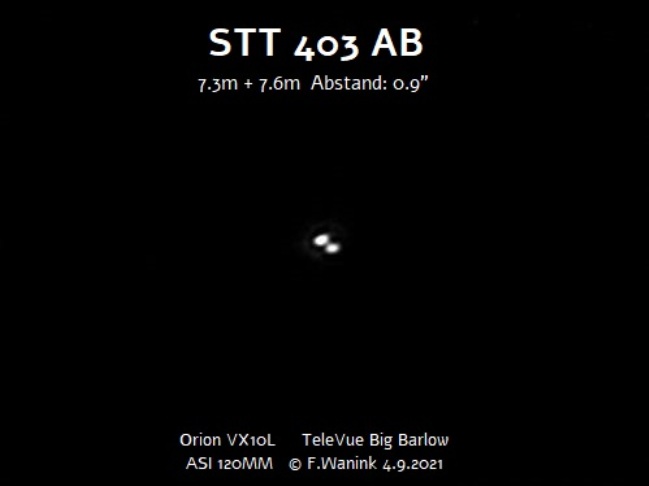
|
|
|
★★
|
STF2703 |
|
AB |
8m.3 |
8m.4 |
25.1" |
290° |
2019 |
Del |
20h36m49.41s / +14°43'42.40" |
|
|
|
|
AC |
8m.3 |
8m.8 |
77.8" |
234° |
2016 |
|
|
|
|
|
|
AD |
8m.3 |
12m.8 |
84.7" |
347° |
2016 |
|
|
|
|
|
|
BC |
8m.4 |
8m.8 |
67.0" |
215° |
2016 |
|
|
René Merting
Drachhausen (Germany) |
12x42 |
AB: flüchtig betrachtet erst übersehen (C im Südwesten hat etwas abgelenkt), aber bei genauem Hinschauen ist zu erkennen, dass die nordöstliche Komponente aus zwei gleich hellen Sternen besteht
AC: die südwestliche Komponente hat dreifachen Abstand wie AB |
|
Robert Zebahl
Leipzig (Germany) |
16x70 |
2020-08-19: Immediately eye-catching multiple star located between beta and zeta Delphini. Components A, B & C are very easily seen as a triple system forming a striking triangle. A very slight difference in brightness between A & B is perceptible, as well as a color difference, though I cannot name any colors. Very nice. |
|
Uwe Pilz
Leipzig (Germany) |
16x70 |
AB |
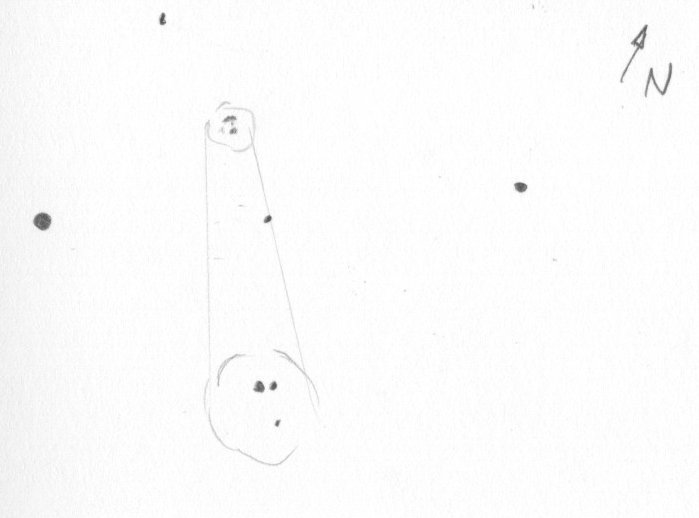
|
René Merting
Drachhausen (Germany) |
100mm (20x) |
AB: bei 20x einfach - Komponente B im Westen ist nur minimal schwächer
BC: bei 20x ist Komponente C südwestlich von B in mehr als dem doppeltem Abstand von A zu B erkennbar, Helligkeitsunterschied gut eine halbe Größenklasse |
|
Uwe Pilz
Leipzig (Germany) |
105mm (144x) |
AB |
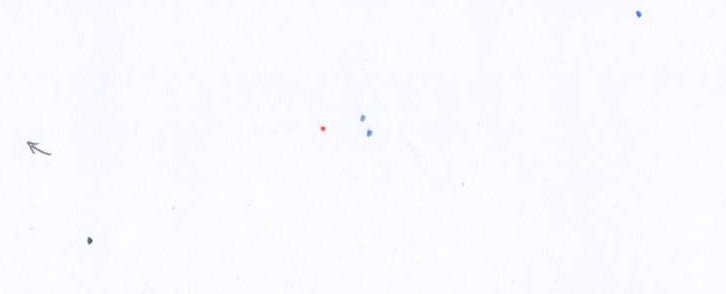
|
Karsten Kopp
Köln (Germany) |
600mm (180x) |
Sehr schönes Mehrfachsternsystem. AB mit fast identische Helligkeit, wobei Komponente C mit 0,5 mag etwas schwächer ist. Ansonsten sind AB,AC und BC als auffälliges Dreieck leicht zu trennen. AD: Hier ist die Komponente D eine sehr große Herausforderung, die ich nur mit indirektem aus der Stadt heraus sichten konnte. |


|
|
Karsten Kopp
Köln (Germany) |
140mm |
Image taken with TEC 140, Canon 700Da, 4 seconds exposure time |
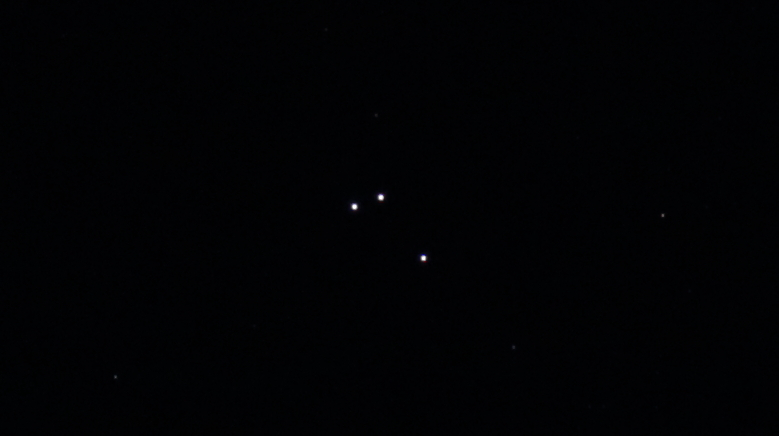
|
|
|
|
52 Cyg, STF2726 |
|
|
4m.3 |
9m.5 |
5.8" |
74° |
2021 |
Cyg |
20h45m39.76s / +30°43'10.80" |
Sarah Gebauer
Germany |
100mm (80x) |
01.10.23: ein sehr ungleiches Paar, das sich erst bei 80-fach getrennt zeigt - A strahlt sehr warmgelb mit einem hellen, zitronengelben Zentrum, B steht als dumpfes, graues Mäuschen ganz dicht und beinahe versteckt daneben |
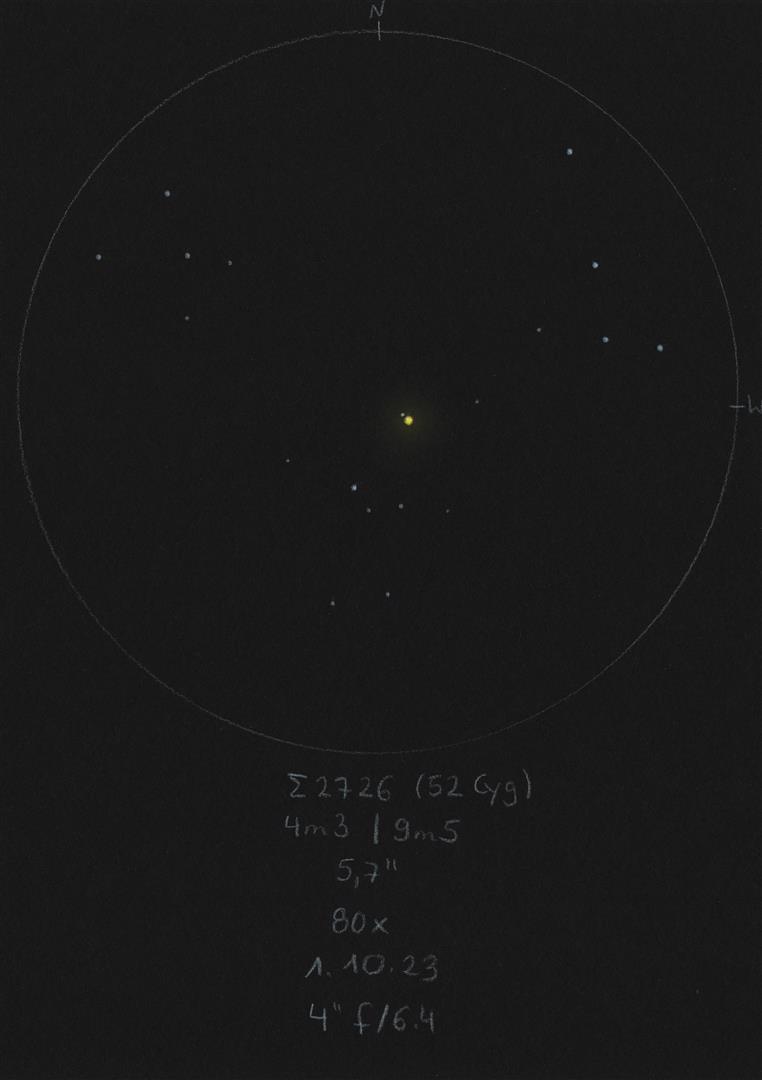
|
René Merting
Drachhausen (Germany) |
100mm (107x) |
bei 107x strahlt A gleißend und hellgelb, Komponente B ist östlich von A schön abgesetzt sehr schwach erkennbar - Helligkeitsunterschied riesig, bestimmt mehr als 4 Größenklassen (5.2 mag laut Stelle Doppie) - zurück auf 64x ist Komponente B nur in ruhigen Momenten zu erhaschen, der Stern klebt förmlich am hellen Strahlenkranz von A |
|
Mark McCarthy
Fremont (California/USA) |
317mm (277x) |
52 Cygni: I sight this one by eye to find the Western Veil in the Telrad. Bright orange and 3 delta mag blue B, ~7" |
|
Mark McCarthy
Fremont (California/USA) |
508mm (205x) |
52 Cyg. Very bright light yellow-orange A and much fainter, obvious B, well split, same color. WDS uncertain, however there is no overlap in their parallax ranges, so not gravitational |
|
|
Frederik Wanink
Itterbeck (Germany) |
254mm |
|
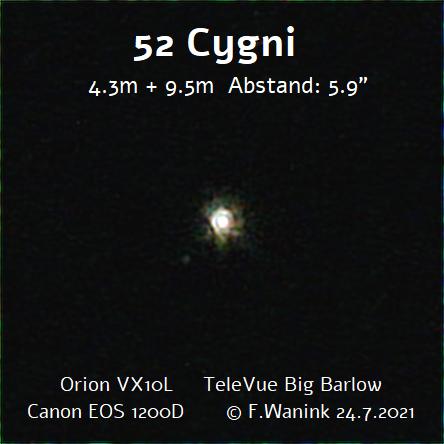
|
|
|
★★
|
STF2725 |
|
AB |
7m.5 |
8m.2 |
6.2" |
12° |
2019 |
Del |
20h46m13.31s / +15°54'26.40" |
|
|
Robert Zebahl
Leipzig (Germany) |
16x70 |
2021-09-02: The double star appears clearly elongated at the correct position angle, but nothing more. |
|
René Merting
Drachhausen (Germany) |
100mm (32x) |
bei 32x ein schöner Kontrast zum 15' nördlich stehenden viel helleren Sternpaar STF2727 - hier bei dem wesentlich schwächeren Sternpaar zeigt sich bei 32x die Komponente B knapp getrennt nördlich von A - Helligkeitsunterschied etwas mehr als eine halbe Magnitude, aber Komponente A ist noch deutlich schwächer als die Komponente B von STF2727 |
|
Sarah Gebauer
Germany |
100mm (45x) |
das Doppel lässt sich bei 45x sauber trennen und bildet mit Gamma2 Delphini ein optisches Doppel-Doppel, da beide Doppelsterne sehr gut in ein Gesichtsfeld passen |

|
Sarah Gebauer
Germany |
100mm (80x) |
01.10.23: südwestlich versetzt von Gamma2 Del zeigt STF 2725 eine dunkelgelb, matt schimmernde A-Komponente und eine dicht stehende, sauber getrennte B-Komponente, die silbrig wirkt |
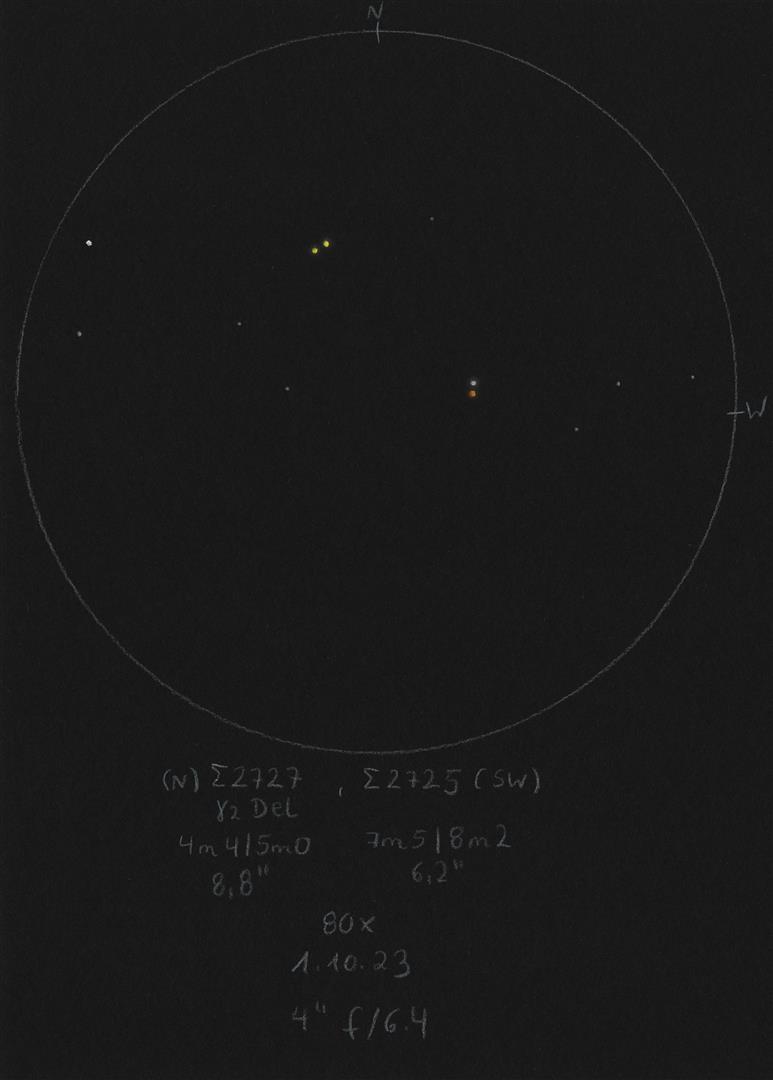
|
Uwe Pilz
Leipzig (Germany) |
105mm (66x) |
im selben Feld mit gamma Del |
|
Uwe Pilz
Leipzig (Germany) |
105mm (88x) |
|
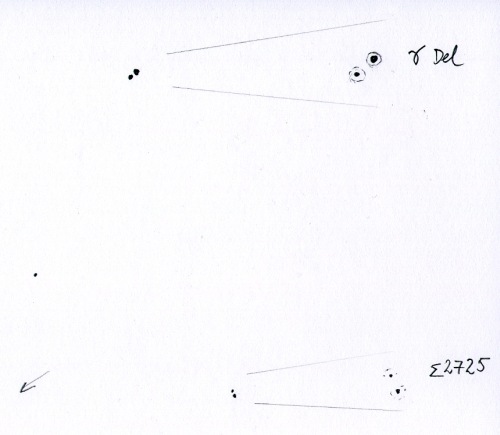
|
René Merting
Drachhausen (Germany) |
107mm (60x) |
bei 60x knapp getrennt, gut zusammen im Gesichtsfeld mit dem helleren, farbigen Sternpaar STF 2727 |

|
Robert Zebahl
Leipzig (Germany) |
152mm (30x) |
2021-09-11: Separated but still very close components with moderate brightness difference. |
|
Mark McCarthy
Fremont (California/USA) |
203mm (205x) |
OR Del. Light yellow stars, half delta mag, wide. Physical pair with a 2945.18 year period. In same field with bright pair STF 2727 |
|
Mark McCarthy
Fremont (California/USA) |
317mm (553x) |
Super wide, 1 magnitude difference, both faint yellow-white. |
|
Mark McCarthy
Fremont (California/USA) |
508mm (333x) |
Easy, half delta mag and wide. I was after the super close WSI 110 Aa-Ab 0.1" but had no hope of seeing it. |
|
Karsten Kopp
Köln (Germany) |
600mm (180x) |
Leicht zu trennender Doppelstern mit leichtem Helligkeitsunterschied von ca. 0,5 mag. Komponente A leuchtet weißlich und die Komponente B b gelblich. |
|
|
Berthold Fuchs
Wiesbaden (Germany) |
130mm |
close DS |
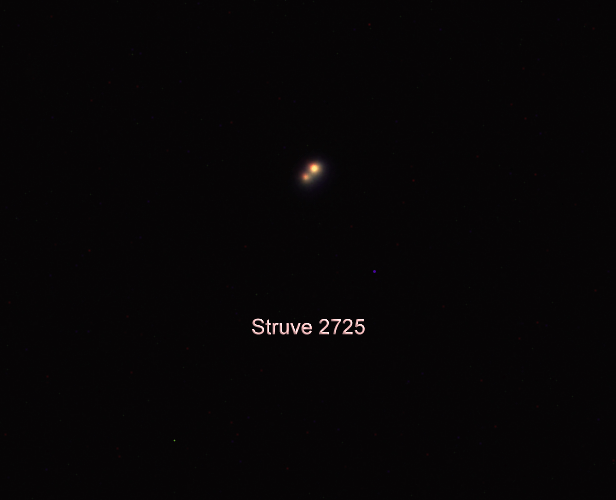
|
|
|
|
STT417 |
|
AB |
8m.2 |
8m.4 |
0.9" |
27° |
2018 |
Vul |
20h53m04.23s / +29°08'43.70" |
Frederik Wanink
Itterbeck (Germany) |
254mm (640x) |
einfach |
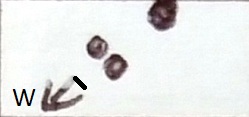
|
|
Frederik Wanink
Itterbeck (Germany) |
254mm |
|
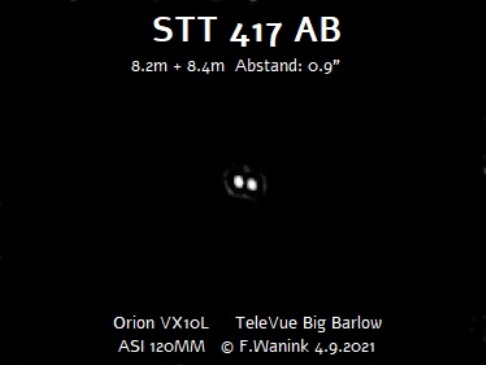
|
|
|
|
STT418 |
|
|
8m.2 |
8m.3 |
0.9" |
283° |
2018 |
Cyg |
20h54m49.84s / +32°42'23.20" |
|
|
Mark McCarthy
Fremont (California/USA) |
152mm (285x) |
Incredibly fine split, near equal. Suspected at 175x. Physical with a 709-year period |
|
Frederik Wanink
Itterbeck (Germany) |
254mm (640x) |
getrennt, gleich hell |
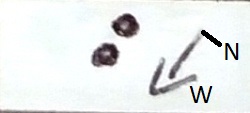
|
Mark McCarthy
Fremont (California/USA) |
317mm (553x) |
Near equal 1" split, white. |
|
|
Frederik Wanink
Itterbeck (Germany) |
254mm |
|

|
|
|
★
|
STF2737, epsilon Equ, 1 Equ |
|
AB |
6m.0 |
6m.3 |
0.0" |
125° |
2021 |
Equ |
20h59m04.54s / +04°17'37.80" |
|
|
|
|
AB-C |
5m.3 |
7m.0 |
10.6" |
67° |
2019 |
|
|
|
|
|
|
AD |
6m.0 |
13m.1 |
69.3" |
293° |
2013 |
|
|
|
|
René Merting
Drachhausen (Germany) |
12x50 |
AB-C: in ruhigen Momenten präsentieren sich beide Sterne länglich mit Einschnürung, dann sieht das System aus wie eine kleine Ameise |
|
Robert Zebahl
Leipzig (Germany) |
70mm (22x) |
AB-C: At 22x well separated, but still relatively close together with a clear difference in brightness. At 44x AB looked rather white. The color of C was not apparent. |
|
Christopher Hay
Seeheim (Germany) |
80mm (30x) |
AB-C: Well split, C bluish, AB no definite colour, a nice pair at this power. According to Stelledoppie B and C are a physical pair with a period of 5200 years, and A and B are again a physical pair with a period of 104 years. |
|
René Merting
Drachhausen (Germany) |
100mm (32x) |
AB-C: bei 32x knapp getrennt - Komponente AB mit einem schönen cremegelb, C steht nordöstlich und ist gut 1.5 Größenklassen schwächer |
|
Sarah Gebauer
Germany |
100mm (45x) |
AB-C: bei 45x ganz eng, aber sauber getrennt, die hellere Komponente AB ist gelbstichig und die nordöstliche, schwächere Komponente C hat phasenweise einen Blaustich, wie ein ganz enger, ganz kleiner und schwächerer Albireo |
|
Sarah Gebauer
Germany |
100mm (49x) |
AB-C: 24.09.23: mit 49x sind AB und C schmal, aber sauber getrennt - A zeigt sich auf den ersten Blick richtig hell zitronengelb, B eher kühlweiß bis grau im Nordosten - mit 80x verändert sich der Farbton von AB in Richtung Orange - das übrige Sternumfeld ist bis auf wenige schwache Sternen und einen etwas helleren im Südwesten sehr leer |
|
Mark McCarthy
Fremont (California/USA) |
317mm (553x) |
AB-C: Easy yellow stars, very wide, 1 delta mag. |
|
Mark McCarthy
Fremont (California/USA) |
317mm (553x) |
AB: 1 Equ / Epsilon Equ / Strongly feel an oval AB pairing, marginal |
|
René Merting
Drachhausen (Germany) |
320mm (45x) |
AB-C: bei 45x schon getrennt - bei 72x ordentlich getrennt - AB zeigt sich in einem schönen, strahlenden Hellgelb und mit einem großen Halo bis über den Begleiter hinaus, die etwa 2 Größenklassen schwächere B-Komponente strahlt weißgelblich bis weiß |
|
|
Berthold Fuchs
Wiesbaden (Germany) |
130mm |
AB-C: close DS |
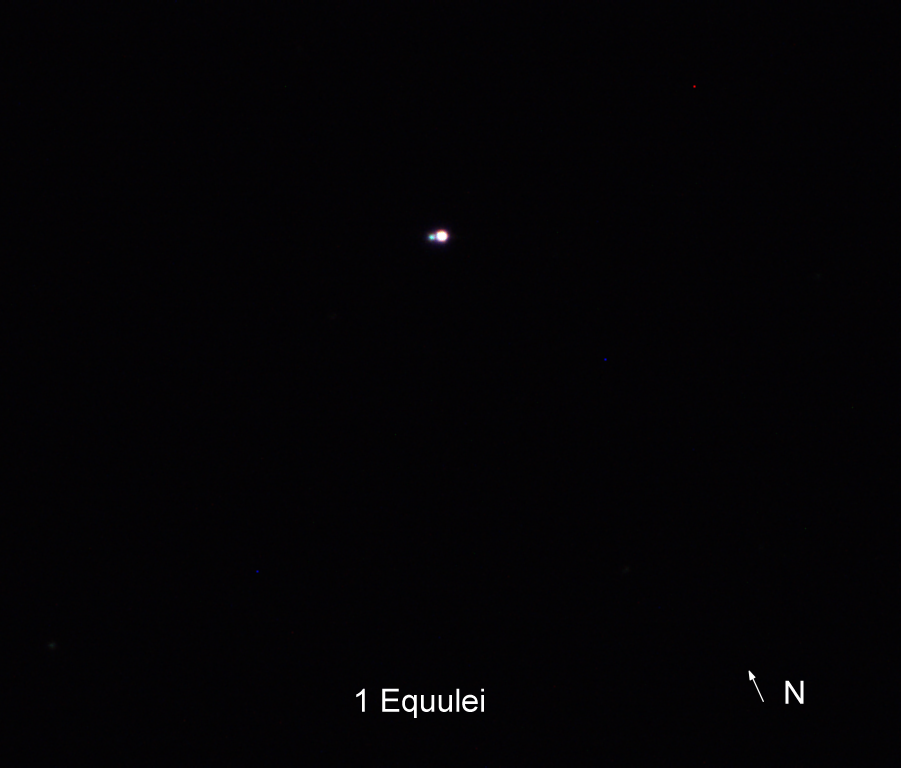
|
|
|
★★★
|
STF2758, 61 Cyg |
|
AB |
5m.2 |
6m.0 |
31.9" |
154° |
2021 |
Cyg |
21h06m53.95s / +38°44'57.90" |
|
|
Christopher Hay
Seeheim (Germany) |
8x42 |
On tripod. Clearly split, northern component A substantially brighter than B. Both orange, whereby A is distinctly more yellowish than B (sky quality similar to that of earlier 15x45 and 10x42 observations). Also seems to be split using the 8x42 handheld, but hand tremor makes this uncertain. |
|
Christopher Hay
Seeheim (Germany) |
15x45 |
Clear to wide separation. Both components of orange hue. Brighter northern component seemed to go slightly into yellow. In 10x42 also clearly split, northern component of orange hue, southern component of indeterminate colour (sky not quite dark enough at the time to see 61 Cyg naked-eye). Piazzi’s Flying Star, flying more than 5” per year to the northeast, and a true physical double with a period of 678 years. |
|
Robert Zebahl
Leipzig (Germany) |
16x70 |
2021-06-14: Beautiful sight. Bright orange & orange. |
|
Sarah Gebauer
Germany |
100mm (21x) |
20.09.23: der DS hebt sich bei 20-fach sehr stark vom Umfeld ab, das typisch für das Sternbild Schwan fein und üppig funkelnd wirkt - absolut mittig, wie auf dem Präsentierteller, zeigt sich der DS kupferbraun leuchtend mit einem geringen Helligkeitsunterschied, ein fantastischer Anblick - bei 49-fach ist der Farbeindruck leicht abgeschwächt, auch der Gesamteindruck leidet aufgrund geringeren Gesichtsfeldes |
|
René Merting
Drachhausen (Germany) |
100mm (32x) |
bei 32x sind beide Sterne gut getrennt, Komponente A strahlt in einem schmutzig dunklem gelb, schwächere Komponente B leicht orange |
|
Uwe Pilz
Leipzig (Germany) |
105mm (200x) |
gelb und orange. Der weitere Stern im Bild ist TYC 3168-6781 |
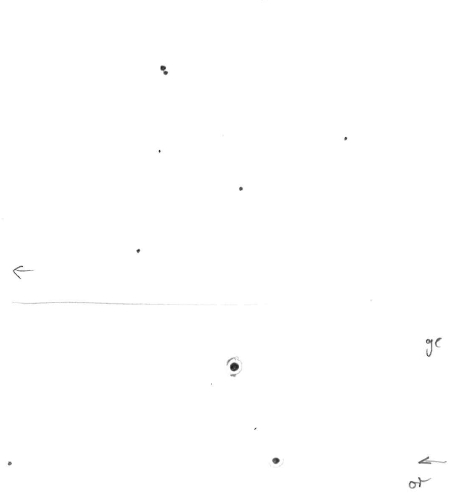
|
Uwe Pilz
Leipzig (Germany) |
105mm (200x) |
TYC 3168-5901 kann dazu dienen, den sich ändernden Positionswinkel abzuschätzen. |
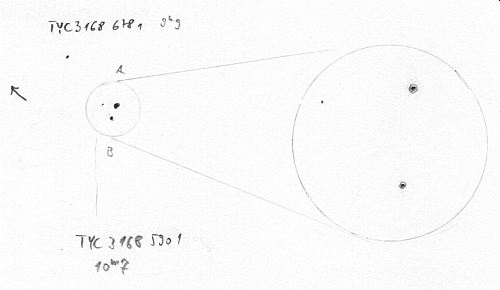
|
Jörg S. Schlimmer
Germany |
127mm (203x) |
Intensive Farbe |
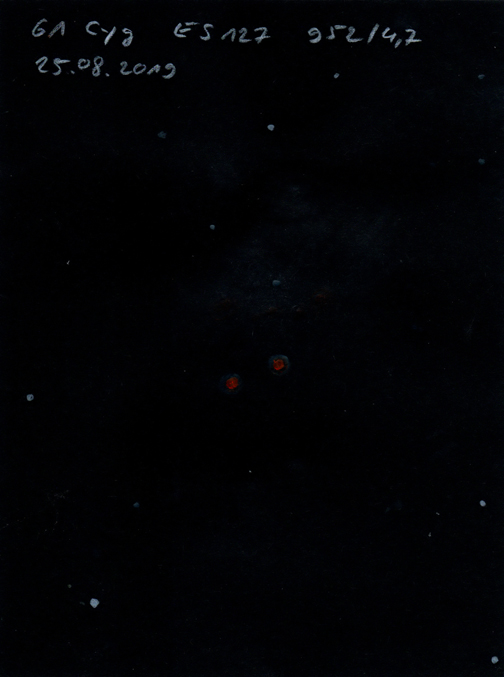
|
Robert Zebahl
Leipzig (Germany) |
152mm (22x) |
2020-06-24: Beautifully separated, bright, striking, especially the colors: bright orange and orange. |
|
Mark McCarthy
Fremont (California/USA) |
152mm (175x) |
61 Cyg. Stunning pair, yellow A and orange B, half delta mag, wide. Spectral class K5V+K7V (yellow-orange/yellow-orange). Only 11.38 light years away! Physical with a 618.6911-year period, it is now at apastron. There are 18 stars in the system but none of the visible ones are, and those only detected in K-band are uncertain |
|
Mark McCarthy
Fremont (California/USA) |
203mm (121x) |
61 Cyg. Nice near equal wide orange pair, bright [18 stars in system -- if so should be an OC] |
|
René Merting
Drachhausen (Germany) |
320mm (45x) |
bei 32x sind beide Sterne gut getrennt, Komponente A strahlt in einem schmutzig dunklem gelb, schwächere Komponente B leicht orange |
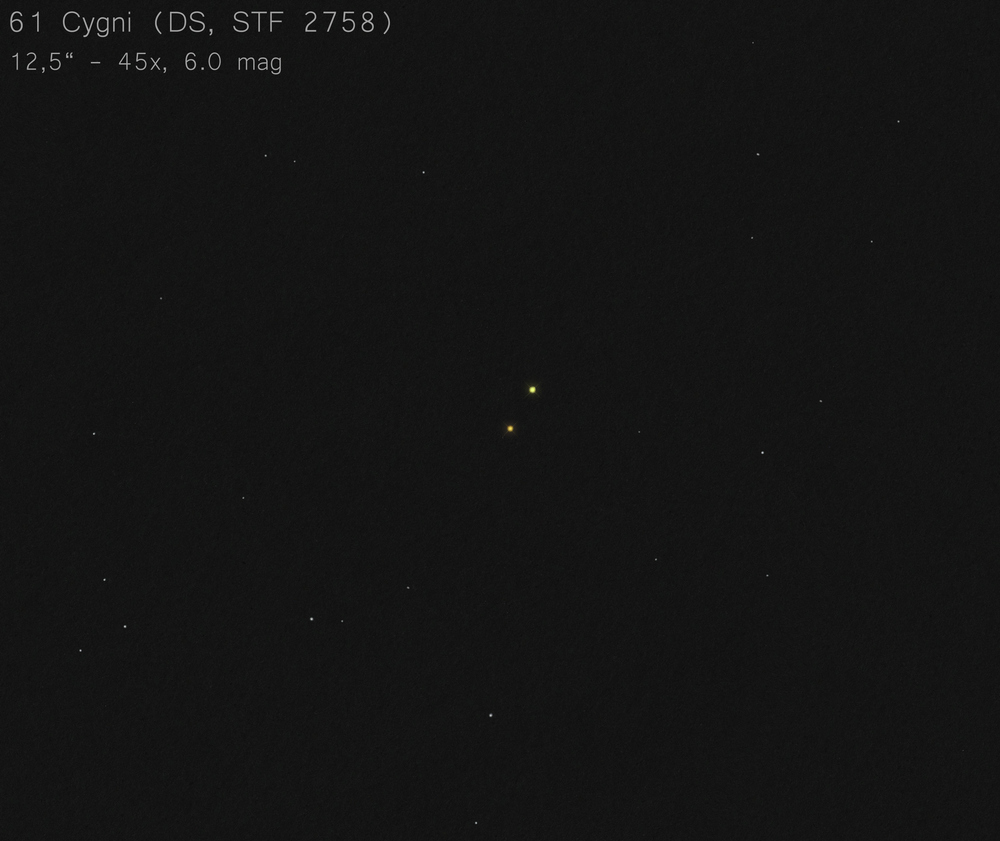
|
Uwe Pilz
Leipzig (Germany) |
320mm (121x) |
Der Doppelstern bildet 2021 mit dem 11-mag-Stern ein fast gleichschenkliges Dreieck |

|
|
Berthold Fuchs
Wiesbaden (Germany) |
130mm |
easy DS |
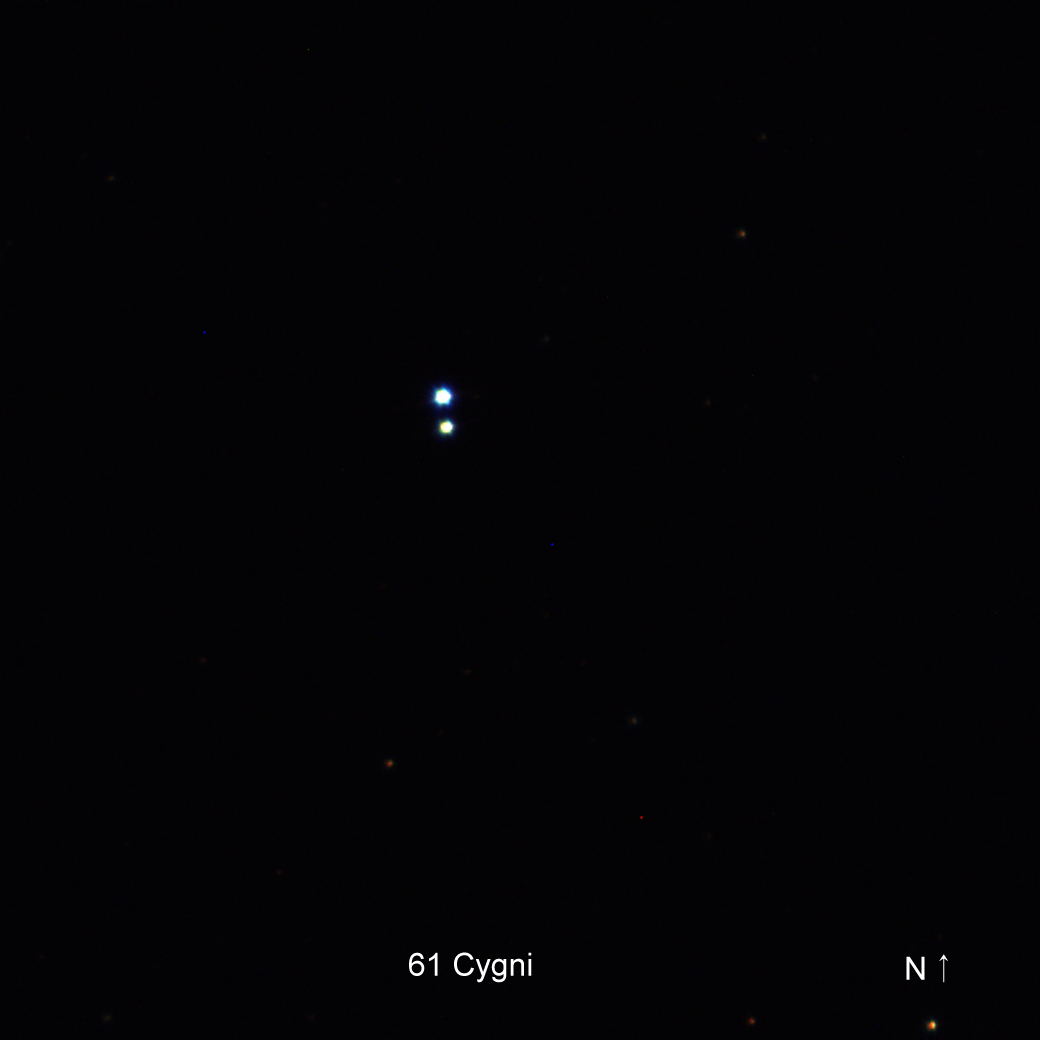
|
|
|
|
STF2797, KP Peg |
|
|
7m.4 |
8m.8 |
3.5" |
218° |
2016 |
Peg |
21h26m41.14s / +13°41'17.80" |
Robert Zebahl
Leipzig (Germany) |
70mm (57x) |
Split at 57x, but very tight with clear difference in brightness. At 100x well split. The faint B component was slightly outside the first diffraction ring of the primary component. |
|
Uwe Pilz
Leipzig (Germany) |
105mm (144x) |
|

|
Mark McCarthy
Fremont (California/USA) |
203mm (533x) |
KP Peg. Light yellow A and ~4", 1.5 delta mag orange B |
|
|
Berthold Fuchs
Wiesbaden (Germany) |
130mm |
v.close DS |
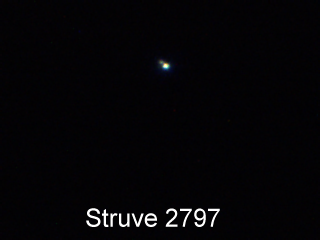
|
|
|
★
|
STF2806, 8 Cep, beta Cep, Alfirk |
|
AB |
3m.2 |
8m.6 |
13.6" |
250° |
2020 |
Cep |
21h28m39.58s / +70°33'38.50" |
Sarah Gebauer
Germany |
100mm (45x) |
bei 45x haarscharf getrennt, die zweite Komponente fällt erst auf den zweiten Blick auf, da sie viel schwächer und kleiner ist und beinahe vom Lichtschein der Hauptkomponente überstrahlt wird |
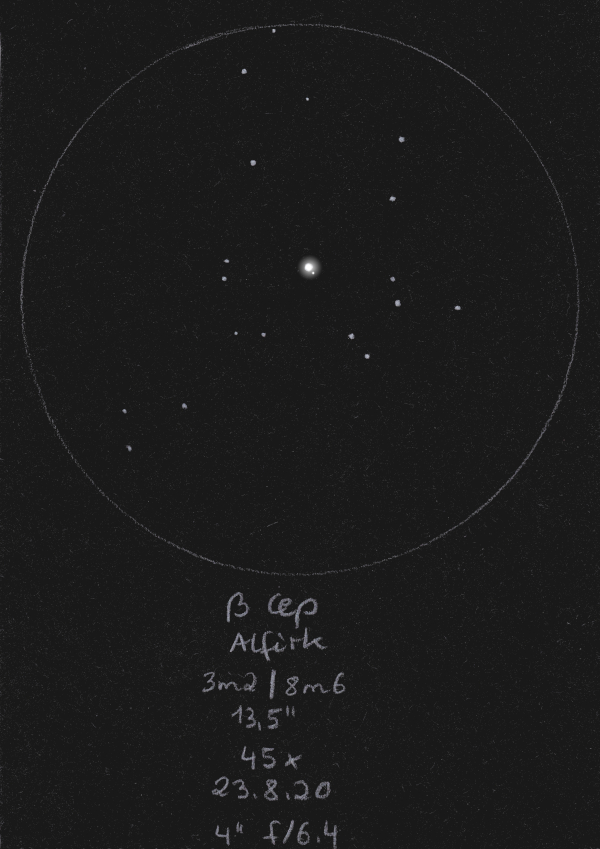
|
Sarah Gebauer
Germany |
100mm (49x) |
01.10.23: der DS ist bei 21-fach nur ein greller, weißer Stern - bei 49-fach zeigt sich plötzlich ein bedeutend schwächerer, schmutzig grauer Begleitstern im Westsüdwesten, A strahlt nach wie vor alpina-reinweiß |
|
Mark McCarthy
Fremont (California/USA) |
152mm (175x) |
Alfirk. Bright yellow-green and 3 delta mag, bluish b, wide. WDS uncertain, no Gaia data on the primary |
|
|
Frederik Wanink
Itterbeck (Germany) |
254mm |
|
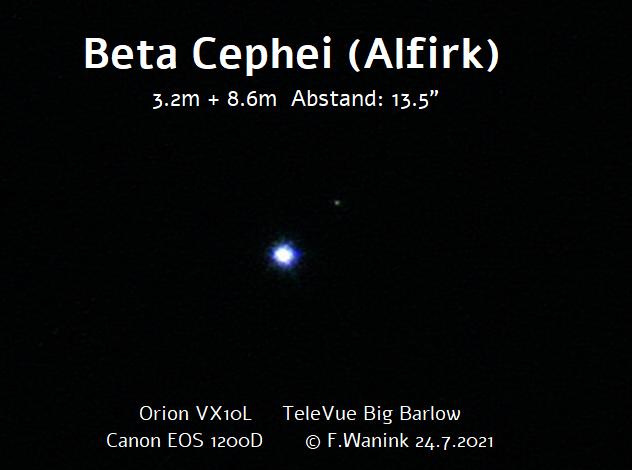
|
|
|
|
STF3112 |
|
AB |
8m.0 |
10m.3 |
6.7" |
241° |
2020 |
Peg |
21h34m29.74s / +09°29'58.90" |
Mark McCarthy
Fremont (California/USA) |
203mm (205x) |
Light yellow-orange A and deeper dull orange B, wide, ~2 delta mag. Physical |
|
|
Berthold Fuchs
Wiesbaden (Germany) |
130mm |
easy DS |
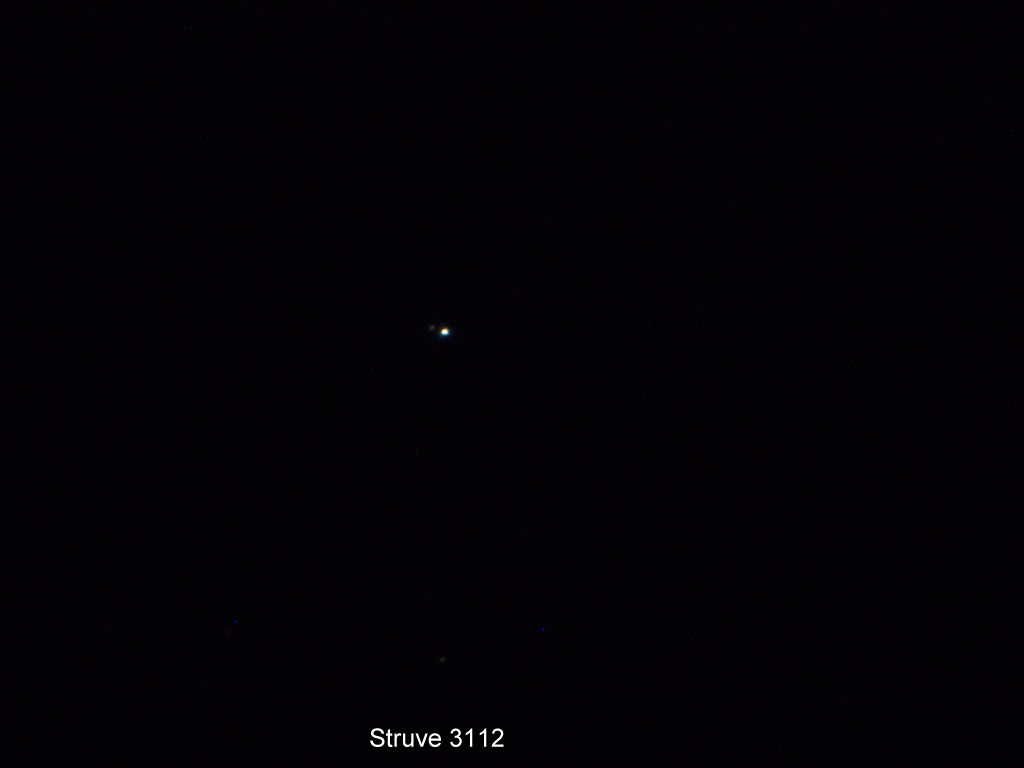
|
|
|
|
STT444 |
|
|
8m.1 |
11m.2 |
8.0" |
277° |
2016 |
Peg |
21h39m04.16s / +20°36'05.70" |
Mark McCarthy
Fremont (California/USA) |
508mm (205x) |
Easy pair, bright white A and three delta mag wide B |
|
|
Berthold Fuchs
Wiesbaden (Germany) |
130mm |
easy DS |

|
|
|
|
STF2829 |
|
|
8m.9 |
9m.7 |
17.1" |
15° |
2015 |
Cyg |
21h49m23.85s / +30°45'14.10" |
Mark McCarthy
Fremont (California/USA) |
152mm (175x) |
Near equal, faint, and wide separation. Double-double with STF 2816 at the center of open cluster IC 1396 |
|
|
Berthold Fuchs
Wiesbaden (Germany) |
130mm |
easy DS |
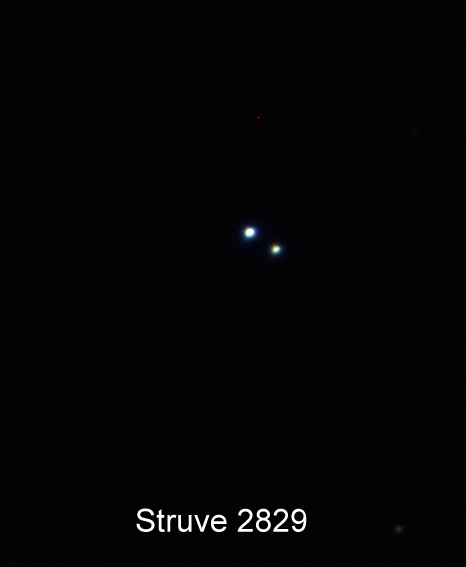
|
|
|
|
STF2828 |
|
AB |
9m.5 |
10m.0 |
33.7" |
140° |
2017 |
Peg |
21h49m30.63s / +03°23'45.30" |
|
|
|
|
AC |
9m.5 |
10m.0 |
33.1" |
134° |
2017 |
|
|
|
|
|
|
AD |
9m.5 |
15m.5 |
10.7" |
73° |
2015 |
|
|
Berthold Fuchs
Wiesbaden (Germany) |
130mm |
easy DS |
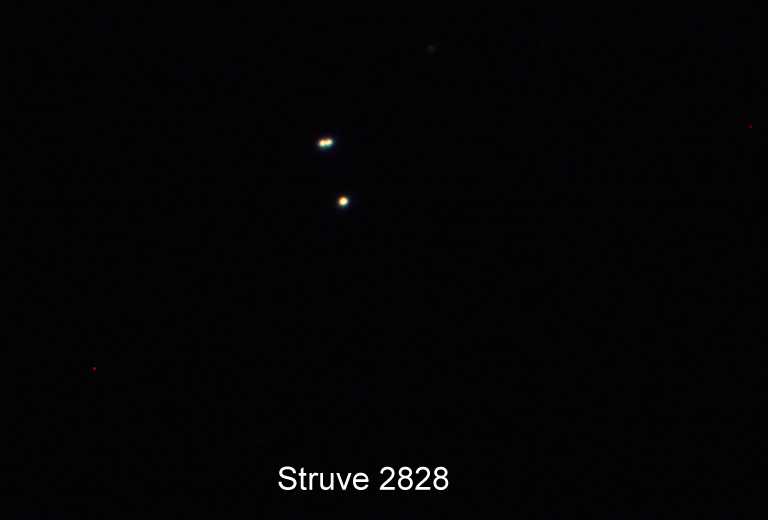
|
|
|
★★
|
STF2841 |
|
A-BC |
6m.5 |
8m.0 |
22.4" |
110° |
2018 |
Peg |
21h54m17.44s / +19°43'05.30" |
Robert Zebahl
Leipzig (Germany) |
70mm (22x) |
At 22x easy to separate with considerable difference in brightness. The primary component appeared slightly yellowish-orange, the fainter component greyish-blue. The slight color contrast was especially visible at 44x. |
|
Sarah Gebauer
Germany |
100mm (49x) |
01.10.23: ein ganz klassisches Farbkontrastpaar von Gelbgold zu Leinblütenblau, bei 49-fach schön getrennt |

|
Uwe Pilz
Leipzig (Germany) |
105mm (88x) |
|
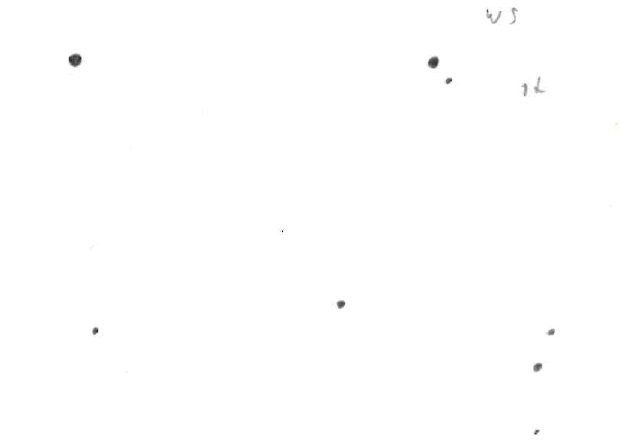
|
Mark McCarthy
Fremont (California/USA) |
203mm (533x) |
Very wide 2 delta mag pair, white and light blue [COU 432 is the AB, 0.1" near equal, was 0.2" at discovery!] |
|
Mark McCarthy
Fremont (California/USA) |
317mm (553x) |
Orange & blue, very wide separation, ~2 magnitude difference. |
|
|
Berthold Fuchs
Wiesbaden (Germany) |
130mm |
easy DS |
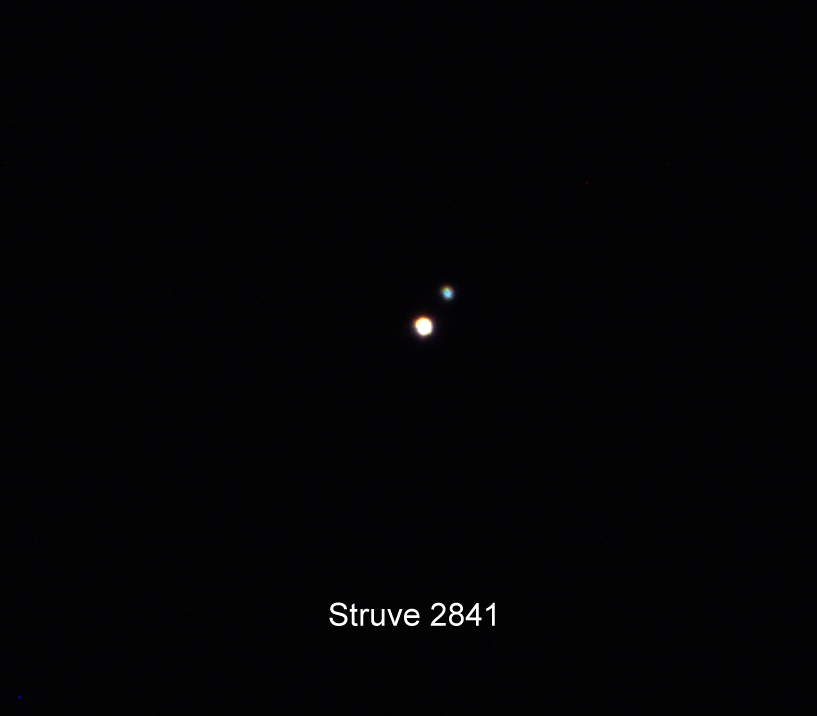
|
|
|
|
STF2848 |
|
|
7m.2 |
7m.7 |
10.9" |
56° |
2016 |
Peg |
21h58m01.45s / +05°56'25.30" |
Robert Zebahl
Leipzig (Germany) |
70mm (22x) |
At 22x nicely separated, but still relatively close together with a small difference in brightness. The brighter component appeared cooler in color (white-bluish), the fainter one warmer (slightly orange). At 44x the color impression was similar. |
|
Mark McCarthy
Fremont (California/USA) |
508mm (533x) |
Wide, bright white stars, half delta mag, ~10" |
|
|
Berthold Fuchs
Wiesbaden (Germany) |
130mm |
easy DS |

|
|
|
|
STF2861 |
|
|
8m.1 |
8m.6 |
7.1" |
220° |
2016 |
Peg |
22h06m01.25s / +20°48'12.40" |
Robert Zebahl
Leipzig (Germany) |
70mm (22x) |
At 22x almost separable and quite faint overall. A difference in brightness was visible. At 44x easily separable with little difference in brightness and still relatively tight. |
|
Mark McCarthy
Fremont (California/USA) |
203mm (533x) |
Pretty wide, magnitude is about half delta mag |
|
|
Berthold Fuchs
Wiesbaden (Germany) |
130mm |
close DS |
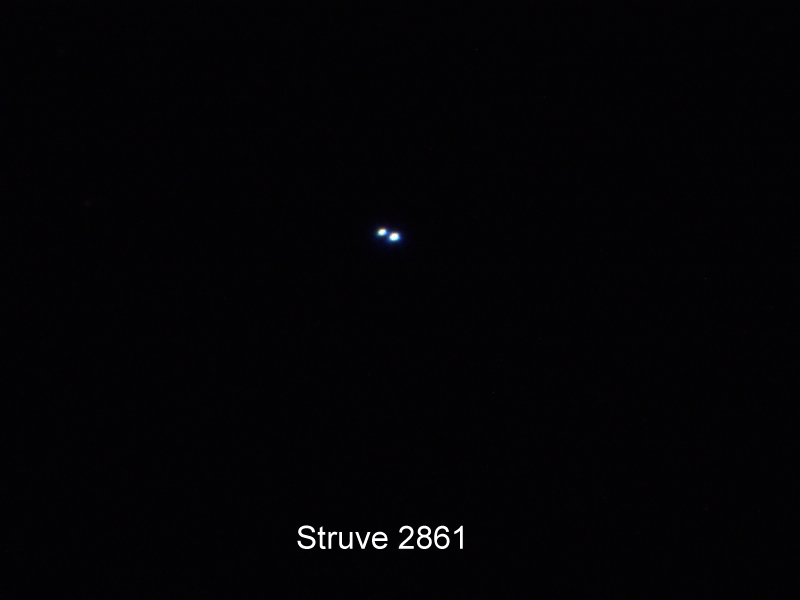
|
|
|
|
STF2857 |
|
|
7m.1 |
9m.8 |
19.9" |
113° |
2016 |
Peg |
22h06m10.58s / +10°05'36.40" |
René Merting
Drachhausen (Germany) |
15x56 |
Komponente B ist mit etwas Geduld extrem schwach und knapp getrennt östlich von A erkennbar - großer Helligkeitsunterschied von 2 bis 2.5 Magnituden |
|
Uwe Pilz
Leipzig (Germany) |
105mm (144x) |
|

|
Mark McCarthy
Fremont (California/USA) |
317mm (553x) |
Around 3 magnitudes difference, very wide separation, PA to the east. |
|
René Merting
Drachhausen (Germany) |
320mm (45x) |
bei 45x ist das Paar getrennt erkennbar, B steht ordentlich abgesetzt im Südosten von A und ist gut 2 Größenklassen schwächer, was folgt? na klar, B wirkt grau gegen die weiß blühende A-Komponente |
|
|
Berthold Fuchs
Wiesbaden (Germany) |
130mm |
easy DS |
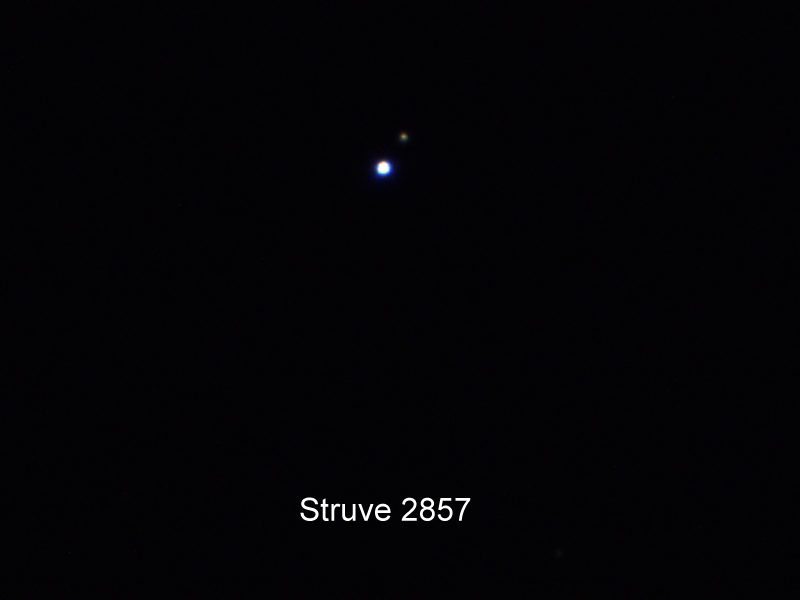
|
|
|
|
STF2867 & ABH159 |
STF2867 |
AB |
8m.3 |
9m.3 |
10.5" |
208° |
2016 |
Peg |
22h10m02.85s / +07°57'13.10" |
|
|
|
ABH159 |
AD |
8m.3 |
12m.3 |
95.5" |
219° |
2015 |
|
|
|
|
|
STF2867 |
BC |
9m.3 |
13m.8 |
6.3" |
247° |
2015 |
|
|
René Merting
Drachhausen (Germany) |
15x56 |
STF2867 (AB): der Stern wirkt nicht wirklich rund, mehr ist aber auch nicht zu erkennen |
|
Uwe Pilz
Leipzig (Germany) |
105mm (144x) |
STF2867 (AB) |

|
|
Berthold Fuchs
Wiesbaden (Germany) |
130mm |
STF2867 (AB): easy DS |
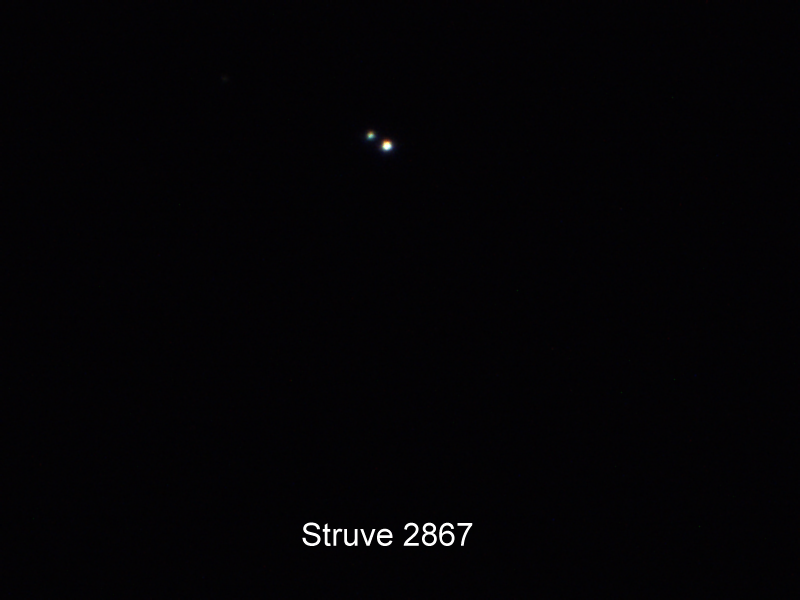
|
|
|
★
|
STF2877 |
|
AB |
6m.7 |
9m.2 |
24.0" |
24° |
2018 |
Peg |
22h14m18.40s / +17°11'21.60" |
|
|
|
|
AC |
6m.7 |
12m.4 |
97.3" |
44° |
2016 |
|
|
|
|
|
|
AD |
6m.7 |
11m.3 |
101.2" |
309° |
2016 |
|
|
|
|
|
|
BC |
9m.2 |
12m.4 |
75.5" |
50° |
2016 |
|
|
|
|
|
|
BD |
9m.2 |
11m.3 |
97.9" |
296° |
2016 |
|
|
René Merting
Drachhausen (Germany) |
15x56 |
AB: Komponente B ist knapp abgesetzt nordöstlich von A erkennbar |
|
Sarah Gebauer
Germany |
100mm (21x) |
AB: 25.09.23: mit 21-fach schon getrennt zu sehen, im Südwesten strahlt eine zart goldfarbene A-Komponente und dicht daran im Nordosten steht ein ganz graues Lichtpünktchen mit einem Hauch eines metallischen Farbglanzes |

|
Uwe Pilz
Leipzig (Germany) |
105mm (37x) |
AB |

|
René Merting
Drachhausen (Germany) |
320mm (45x) |
AB: bei 45x zeigt B sich gut abgesetzt nordwestlich von A - A wirkt Maisgelb, aber eher wie junger, frischer Mais, B ist 2 bis 3 Größenklassen schwächer und einen grauen Kittel an - bei 144x ist das Paar ansehnlicher, A ist sattgelb, B weißgrau |
|
|
Berthold Fuchs
Wiesbaden (Germany) |
130mm |
AB: easy DS |
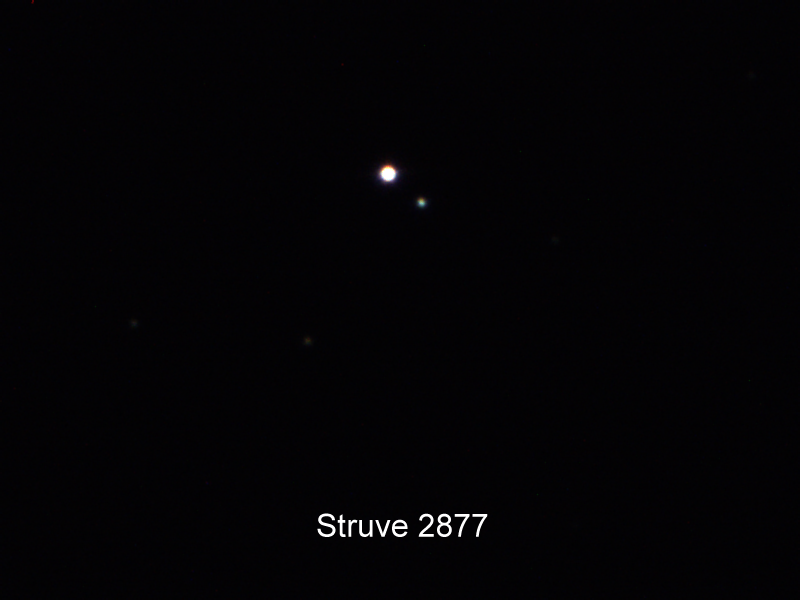
|
|
|
|
STT469 |
|
AB |
7m.5 |
9m.7 |
26.9" |
293° |
2015 |
Peg |
22h20m31.21s / +35°06'53.40" |
|
|
|
|
AC |
7m.5 |
13m.3 |
57.2" |
51° |
2015 |
|
|
Robert Zebahl
Leipzig (Germany) |
16x70 |
AB: 2021-09-14: Easy to split at moderate separation and clear difference in brightness. The primary component appeared yellowish, the faint companion was only visible with averted vision. |
|
René Merting
Drachhausen (Germany) |
100mm (20x) |
AB: bei 32x ein ordentlich getrenntes Pärchen - Helligkeitsunterschied 1.5 Größenklassen (2.2 mag laut Stelle Doppie) - Komponente A im SO schön weiß, B eher grau - bei 20x stehen beide Sterne eng zusammen |
|
|
Berthold Fuchs
Wiesbaden (Germany) |
130mm |
AB: easy DS |
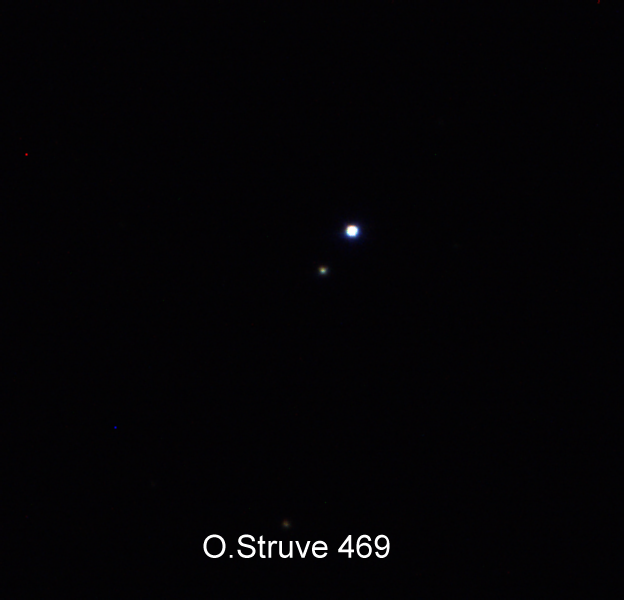
|
|
|
|
STF2910 |
|
|
9m.1 |
9m.7 |
5.8" |
332° |
2019 |
Peg |
22h28m13.25s / +23°31'57.20" |
Mark McCarthy
Fremont (California/USA) |
508mm (533x) |
White stars, one tinged with yellow the other orange, 1 delta mag, wide. |
|
|
Berthold Fuchs
Wiesbaden (Germany) |
130mm |
close DS |

|
|
|
★★
|
delta Cep, 27 Cep |
BU702 |
AB |
4m.2 |
13m.0 |
21.5" |
282° |
2015 |
Cep |
22h29m10.25s / +58°24'54.70" |
|
|
|
STFA58 |
AC |
4m.2 |
6m.1 |
41.0" |
191° |
2018 |
|
|
|
|
|
DAL45 |
AD |
4m.2 |
13m.9 |
109.0" |
39° |
2015 |
|
|
|
|
|
DAL45 |
DE |
13m.9 |
14m.0 |
1.4" |
23° |
2008 |
|
|
Christopher Hay
Seeheim (Germany) |
7x45 |
AC: Hand tremor hampers splitting A and C at this low magnification, as the apparent separation is small. Nonetheless, a grey-blue C dances next to the luminous-orange A.
Component A is the prototype of the Cepheid class of variable stars, with a brightness variation of a full magnitude over 5 days. To assess a somewhat difficult handheld binocular split like this it would really be necessary to know the momentary brightness of A, but I didn’t have a telescope at hand. |
|
René Merting
Drachhausen (Germany) |
15x56 |
AC: ein wunderschönes Paar - A strahlt satt gelb, C zeigt sich gut getrennt und tendiert mehr ins weißgraue - dadurch ein schöner Farbkontrast |
|
Robert Zebahl
Leipzig (Germany) |
16x70 |
AC: 2020-09-20: Nice separation with noticeable difference in brightness. Slightly yellowish & white-bluish. |
|
Robert Zebahl
Leipzig (Germany) |
55mm (27x) |
AC: At 27x easy to separate, rather wide apart with clear difference in brightness. At 38x the colors are slightly better visible: A shines in bright orange, C appears rather grey-bluish. |
|
Robert Zebahl
Leipzig (Germany) |
80mm (25x) |
AC: Obvious difference in brightness and color. Brighter component slightly orange, weaker bluish. Could be Albireo's little brother ;) |
|
René Merting
Drachhausen (Germany) |
107mm (30x) |
AC: bei 30x ein sehr auffälliges Sternpaar mit einem auffälligen Farbkontrast - auch wenn C deutlich schwächer ist, so strahlen doch beide Sterne um die Wette - Komponente A zeigt sich Siennagelb, C wirkt Blauweiß - ordentliche Trennung - bei 6x ändert C ein wenig seine Farbe, ich habe mitunter den Eindruck, Grünblau zu sehen |
|
Sarah Gebauer
Germany |
150mm (85x) |
AC: die hellere Komponente ist sehr intensiv und richtig schön goldgelb und die zweite, deutlich schwächere Komponente hat einen sichtbar bläulichen Farbstich, insgesamt schon ab 21x sehr schön anzuschauen |

|
Mark McCarthy
Fremont (California/USA) |
508mm (667x) |
DE: Slight brightening in the diffraction ring |
|
|
Frederik Wanink
Itterbeck (Germany) |
254mm |
AC |
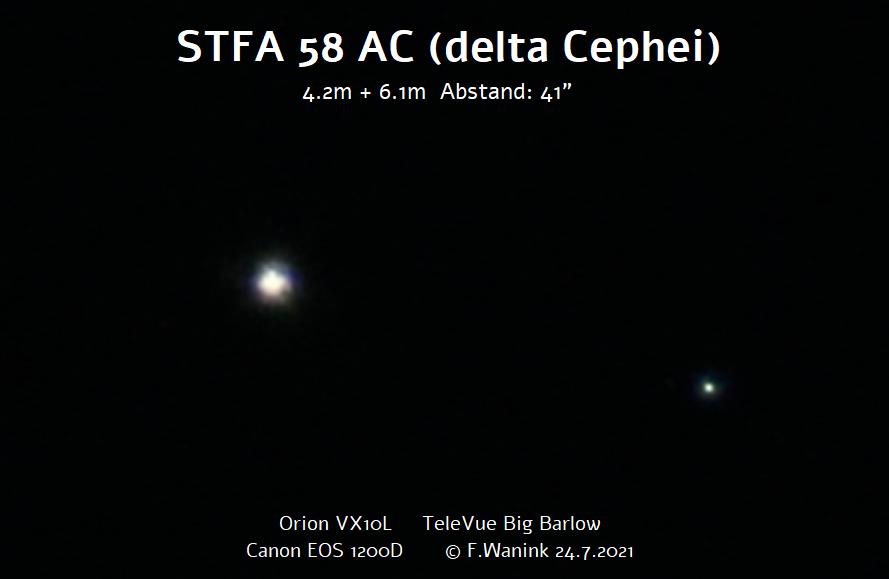
|
|
|
|
STF2915 |
|
AB |
9m.5 |
9m.5 |
15.2" |
125° |
2017 |
Peg |
22h32m33.93s / +07°25'05.50" |
Mark McCarthy
Fremont (California/USA) |
203mm (533x) |
Easy wide slightly unequal pair |
|
|
Berthold Fuchs
Wiesbaden (Germany) |
130mm |
easy DS |
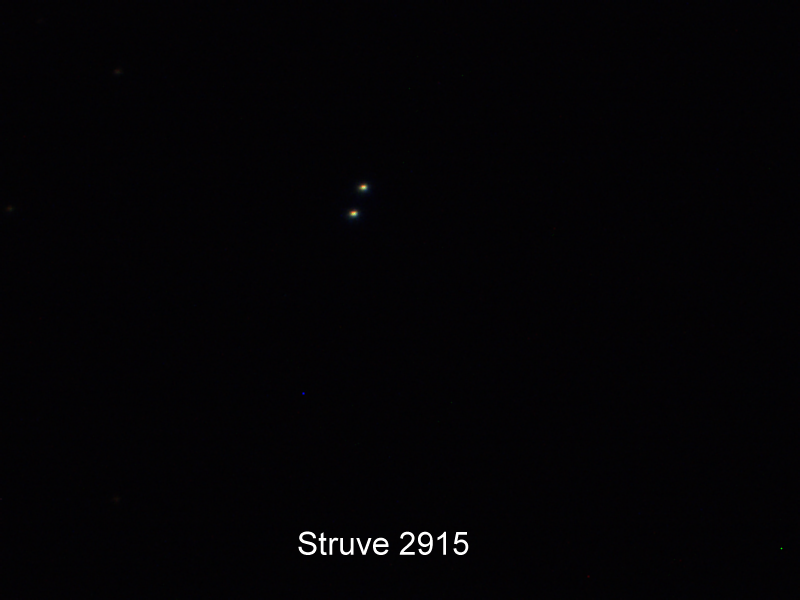
|
|
|
|
STF2920 |
|
AB |
7m.5 |
8m.8 |
13.7" |
144° |
2016 |
Peg |
22h34m31.58s / +04°13'20.60" |
Mark McCarthy
Fremont (California/USA) |
203mm (533x) |
Easy, wide, about 2 delta mag, blue-white stars |
|
Mark McCarthy
Fremont (California/USA) |
317mm (553x) |
Blue-white stars, very wide, 1 delta mag. |
|
|
Berthold Fuchs
Wiesbaden (Germany) |
130mm |
easy DS |
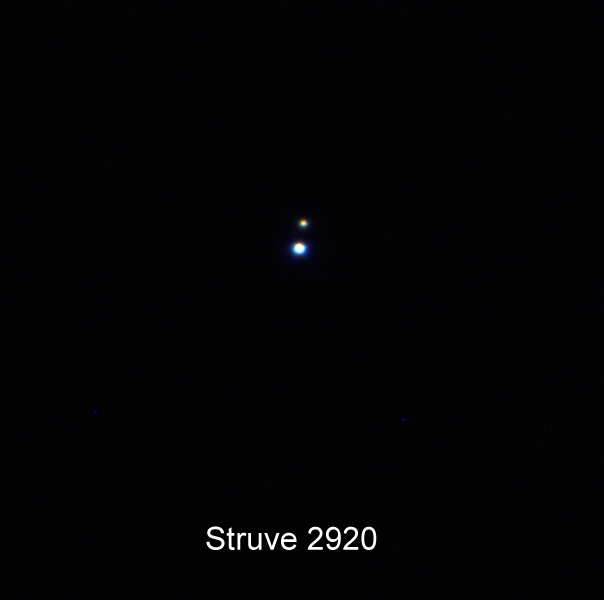
|
|
|
|
STF2952 |
|
AB |
7m.7 |
10m.5 |
17.6" |
139° |
2018 |
Peg |
22h54m11.41s / +28°00'59.80" |
|
|
|
|
AC |
7m.7 |
10m.4 |
164.8" |
244° |
2018 |
|
|
Mark McCarthy
Fremont (California/USA) |
152mm (175x) |
AB: Wide light yellow A and blue B, 2 delta mag. WDS says physical, but there is no overlap in parallax range (-17%). Otherwise, there is a moderate 1,191 AU weighted separation and 1.38/0.73 solar mass, and the radial velocity difference (0.39) is less than the escape velocity (1.77) -- only time will tell if this resolves into an orbit |
|
|
Berthold Fuchs
Wiesbaden (Germany) |
130mm |
easy DS |
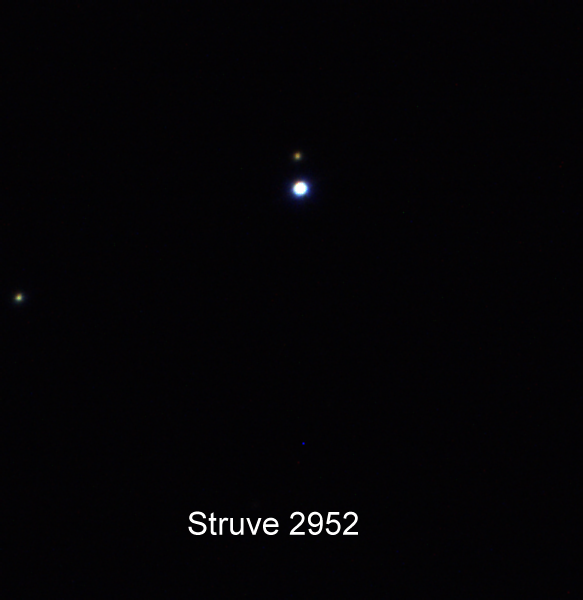
|
|
|
|
STF2978 |
|
|
6m.3 |
7m.5 |
8.3" |
145° |
2018 |
Peg |
23h07m27.73s / +32°49'31.30" |
Robert Zebahl
Leipzig (Germany) |
70mm (22x) |
Well separated at 22x, but relatively close together with a noticeable difference in brightness. At 57x the primary component looked slightly yellowish, the companion rather grey-bluish. |
|
Mark McCarthy
Fremont (California/USA) |
152mm (175x) |
Ice blue A and ruddy, 2 delta mag, wide B. WDS says physical, and there is 10% parallax overlap, 1,156 AU weighted separation, and stellar mass 2.63/1.85 |
|
Mark McCarthy
Fremont (California/USA) |
317mm (277x) |
Bright and easy, yellow-white A and orange B, ~1 delta mag. |
|
René Merting
Drachhausen (Germany) |
320mm (45x) |
ein schicker Doppelstern, bei 45x bereits trennbar - Komponente B im Südosten ist eine knappe Größenklasse schwächer - das Pärchen zeigt einen Farbkontrast, den ich aber nicht wirklich festmachen kann, A wirkt mitunter weißgelblich und B ab und an orange, dann wieder grau |
|
|
Berthold Fuchs
Wiesbaden (Germany) |
130mm |
easy DS |

|
|
|
|
STF2986 |
|
|
6m.6 |
8m.9 |
31.4" |
269° |
2018 |
Peg |
23h09m57.10s / +14°25'35.60" |
René Merting
Drachhausen (Germany) |
100mm (20x) |
bei 32x ist Komponente B weit getrennt westlich von A zu erkennen - B ist sehr schwach (kommt mir schwächer vor als 8.88 mag laut Stelle Doppie), Helligkeitsunterschied gut 3 Größenklassen (2,27 mag laut Stelle Doppie) - zurück auf 20x ist B noch immer gerade so erkennbar - beide sind allerdings nur noch als Doppelstern mit dem Wissen darüber erkennbar |
|
Uwe Pilz
Leipzig (Germany) |
105mm (144x) |
|

|
Uwe Pilz
Leipzig (Germany) |
105mm (200x) |
orange |
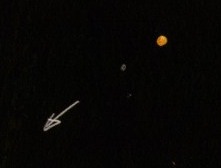
|
Mark McCarthy
Fremont (California/USA) |
152mm (175x) |
Red A and around 3 delta mag B, no other stars in the field. CDSA notes say "Local solar type double; very dark field. AB: ps = 1,070 AU." WDS notes say "Proper motion indicates physical, parallax indicates non-physical." In reality there is 46% parallax range overlap, it's only 789 AU weighted separation, and 1.10/0.52 solar mass. BUT there difference in radial velocity (16.02) far exceeds the escape velocity of the system (1.91) -- and this is the reason they are not gravitational |
|
Mark McCarthy
Fremont (California/USA) |
317mm (277x) |
Red A, bluish B, wide separation ~2 delta magnitude |
|
René Merting
Drachhausen (Germany) |
320mm (45x) |
bei 45x zeigt sich B bereits weit abgesetzt im Westen von A - Komponente A ist weißgelblich, B dagegen ist 1.5 bis 2 Größenklassen schwächer und strahlt braun-grau |
|
|
Berthold Fuchs
Wiesbaden (Germany) |
130mm |
easy DS |

|
|
|
★★
|
STF3021 |
|
AB |
8m.1 |
9m.3 |
8.7" |
308° |
2017 |
Peg |
23h31m24.65s / +16°13'07.60" |
|
|
|
|
AC |
8m.1 |
10m.8 |
118.2" |
23° |
2015 |
|
|
René Merting
Drachhausen (Germany) |
100mm (32x) |
AB: bei 32x zeigt sich B ganz knapp getrennt nordwestlich von A - Helligkeitsunterschied gut 2 Größenklassen - der Doppelstern bildet mit drei helleren Sternen eine flache Drachenraute |
|
Mark McCarthy
Fremont (California/USA) |
317mm (553x) |
AB: ~3.5" and ~1 delta mag. Double double with STF 3012 |
|
|
Berthold Fuchs
Wiesbaden (Germany) |
130mm |
AB: easy DS |

|
|
|
|
STT504 |
|
|
7m.4 |
10m.3 |
7.7" |
176° |
2016 |
Peg |
23h42m31.33s / +18°39'59.30" |
Mark McCarthy
Fremont (California/USA) |
317mm (553x) |
Orange star with very faint 9-10th mag bluish B widely separated to the south. |
|
Mark McCarthy
Fremont (California/USA) |
508mm (533x) |
Yellow and blue stars, nicely wide separated, pretty |
|
|
Berthold Fuchs
Wiesbaden (Germany) |
130mm |
close DS |

|
|
|
|
STF3048 |
|
AB |
7m.9 |
10m.2 |
8.6" |
313° |
2016 |
Peg |
23h58m03.87s / +24°20'27.50" |
Berthold Fuchs
Wiesbaden (Germany) |
130mm |
easy DS |
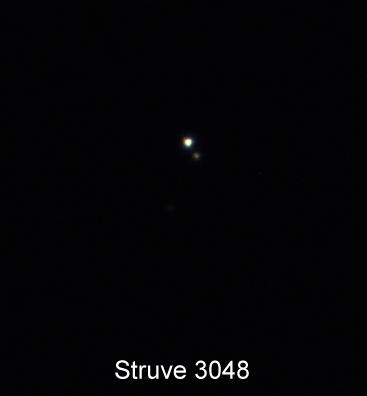
|
|






